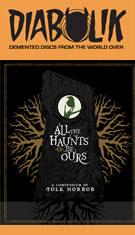
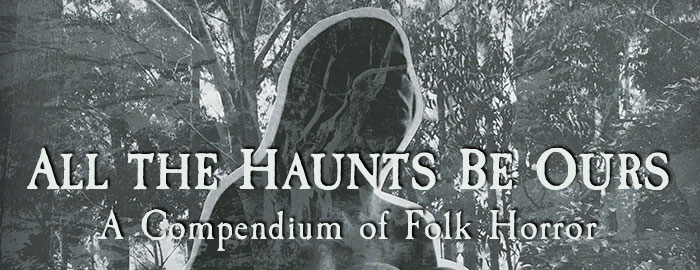
WOODLANDS DARK AND DAYS BEWITCHED
Color, 2021, 192 mins. 22 secs.
Directed by Kier-La Janisse
Severin Films (Blu-ray) (US R0 HD) / WS (1.78:1) (16:9)
EYES OF FIRE
Color, 1983, 86 mins. 9 secs. / 108 mins. 30 secs.
Directed by Avery Crounse
Starring
Dennis Lipscomb, Guy Boyd, Rebecca Stanley, Sally Klein
Severin Films (Blu-ray) (US R0 HD) / WS (1.85:1) (16:9)
LEPTIRICA
Color, 1973, 64 mins. 49 secs.
Directed by Đorđe Kadijević
Starring Mirjana Nikolić, Petar Božović, Slobodan Perović, Vasja Stanković
Severin Films (Blu-ray) (US R0 HD), Ostalgica (Blu-ray) (Germany R0 HD)
WITCHHAMMER
B&W, 1970, 106 mins. 48 secs.
Directed by Otakar Vávra
Starring Vladimír Smeral, Elo Romancik, Josef Kemr, Sona Valentová, Blanka Waleská
Severin Films (Blu-ray) (US R0 HD), Second Run (Blu-ray & DVD) (UK R0 HD/PAL) / WS (2.35:1) (16:9), Facets (DVD) (US R1 NTSC) / WS (2.35:1)
VIY
Color, 1967, 76 mins. 35 secs.
Directed by Georgi Kropachyov & Konstantin Yershov
Starring Leonid Kuralev, Natalya Varley, Aleksei Glazyrin
Severin Films (Blu-ray & DVD) (US R0 HD/NTSC), IVC (Blu-ray & DVD) (Japan R0 HD/NTSC), Ruscico (DVD) (Russia R0 NTSC), HB Films (DVD) (UK R0 PAL)
LAKE OF THE DEAD
B&W, 1958, 76 mins. 55 secs.
Directed by Kåre Bergstrøm
Starring Henki Kolstad, Bjørg Engh, Henny Moan, André Bjerke, Per Lillo-Stenberg, Øyvind Øyen, Georg Richter,
Severin Films (Blu-ray) (US R0 HD), Norsk Filmstudio (DVD) (Norway R2 PAL) / WS (2.35:1) (16:9)
TILBURY
Color, 1987, 56 mins. 53 secs.
Directed by Viðar Víkingsson
Starring Róbert Arnfinnsson, Helga Bernhard, Kristján Franklin Magnúss, Karl Ágúst Úlfsson
Severin Films (Blu-ray) (US R0 HD)
THE DREAMING
Color, 1988, 90 mins. 18 secs.
Directed by Mario Andreacchio
Starring Arthur Dignam, Penny Cook, Gary Sweet, Laurence Clifford, John Noble
Severin Films (Blu-ray) (US R0 HD) / WS (1.85:1) (16:9), Scorpion Releasing (US R0 NTSC) / WS (1.78:1) (16:9), Elite (US R0 NTSC) / WS (1.78:1)
KADAICHA
Color, 1988, 90 mins. 22 secs.
Directed by James Bogle
Starring Zoe Carides, Tom Jennings, Eric Oldfield, Kerry McKay
Severin Films (Blu-ray) (US R0 NTSC), Umbrella (DVD) (Australia R0 NTSC)
CELIA
Color, 1989, 103 mins. 19 secs.
Directed by Ann Turner
Starring Rebecca Smart, Nicholas Eadie, Victoria Longley, Mary-Anne Fahey
Severin Films (Blu-ray) (US R0 HD), Second Run (Blu-ray & DVD) (UK R0 PAL) / WS (1.85:1) (16:9), Scorpion Releasing (DVD) (US R0 NTSC), Umbrella (Australia R0 PAL), Jam (Germany R2 PAL) / WS (1.75:1) (16:9)
ALISON'S BIRTHDAY
Color, 1981, 98 mins. 24 secs.
Directed by Ian Coughlan
Starring Joanne Samuel, Lou Brown, Bunney Brooke, John Bluthal, VIncent Ball
Severin Films (Blu-ray) (US R0 HD) / WS (1.85:1) (16:9), Umbrella (DVD) (Australia R0 NTSC)
WILCZYCA
Color, 1983, 103 mins. 22 secs.
Directed by Marek Piestrak
Starring Krzysztof Jasinski, Iwona Bielska, Stanislaw Brejdygant, Olgierd Lukaszewicz, Henryk Machalica
Severin Films (Blu-ray) (US R0 HD), KinoPolska (DVD) (Poland R0 PAL)
LOKIS: A MANUSCRIPT OF PROFESSOR WITTEMBACH
Color, 1970, 99 mins. 31 secs.
Directed by Janusz Majewski
Starring Józef Duriasz, Edmund Fetting, Gustaw Lutkiewicz, Malgorzata Braunek
Severin Films (Blu-ray) (US R0 HD) / WS (1.66:1) (16:9), KinoPolska (DVD) (Poland R0 PAL) / WS (1.66:1)
CLEARCUT
Color, 1991, 97 mins. 56 secs.
Directed by Ryszard Bugajski
Starring Ron Lea, Graham Greene, Michael Hogan, Floyd Red Crow Westerman, Tia Smith, Rebecca Jenkins
Severin Films (Blu-ray) (US R0 HD) / WS (2.35:1) (16:9)
IL DEMONIO
B&W, 1963, 99 mins. 53 secs.
Directed by Brunello Rondi
Starring Daliah Lavi, Frank Wolf, Anna Maria Aveta
Severin Films (Blu-ray) (US R0 HD), Medusa (DVD) (Italy R2 PAL) / WS (1.85:1) (16:9)
DARK WATERS
Color, 1993, 92 mins. 7 secs.
Directed by Mariano Baino
Starring Louise Salter, Mariya Kapnist, Venera Simmons
Severin Films (Blu-ray & DVD) (US R0 HD/NTSC), NoShame (US R1 NTSC) / WS (1.85:1) (16:9)
A FIELD IN ENGLAND
B&W, 2012, 90 mins. 24 secs.
Directed by Ben Wheatley
Starring Reece Shearsmith, Michael Smiley, Peter Ferdinando, Ryan Pope, Julian Barratt,
Severin Films (Blu-ray) (US RA HD), 4 Films (Blu-ray & DVD) (UK RB/R2 HD/PAL), Drafthouse (Blu-ray & DVD) (US RA/R1 NTSC) / WS (2.35:1) (16:9)
ANCHORESS
B&W, 1993, 108 mins. 40 secs.
Directed by Chris Newby
Starring Natalie Morse, Gene Bervoets, Toyah Willcox
Severin Films (Blu-ray) (US RA NTSC), BFI (DVD) (UK R2 PAL) / WS (1.66:1) (16:9),Vanguard (US R1 NTSC) / WS (1.66:1)
PENDA'S FEN
Color, 1974, 92 mins. 18 secs.
Directed by Alan Clarke
Starring Spencer Banks, John Atkinson, Georgine Anderson, Ron Smerczak, Ian Hogg
Severin Films (Blu-ray) (US RA HD), BFI (Blu-ray & DVD) (UK RB/R2 HD/PAL)
ROBIN REDBREAST
B&W, 1970, 79 mins. 41 secs.
Directed by James MacTaggart
Starring Anna Cropper, Amanda Walker, Andy Bradford, Julian Holloway, Freda Bamford, Bernard Hepton
Severin Films (Blu-ray) (US RA HD), BFI (DVD) (UK R2 PAL)
The term "folk horror" has been percolating in the horror film and literary communities for a long time, with debate continuing as to exactly what it even means. Is it any supernatural or vaguely uncanny story taking place in the countryside? Does it need to have pagan or ancient mythology elements? Should witchcraft be involved? Great Britain 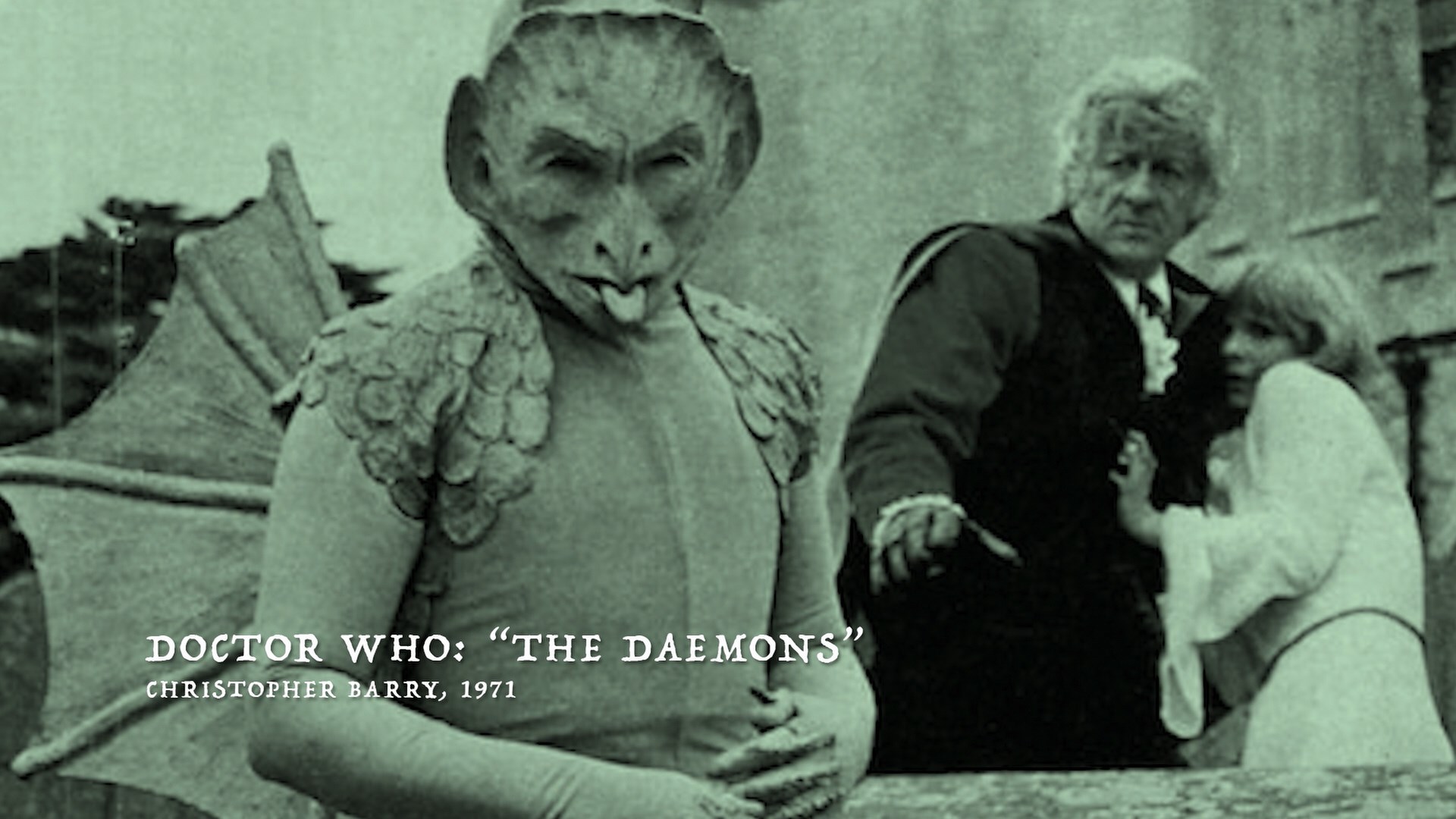 has long been seen as the epicenter of this category thanks
has long been seen as the epicenter of this category thanks 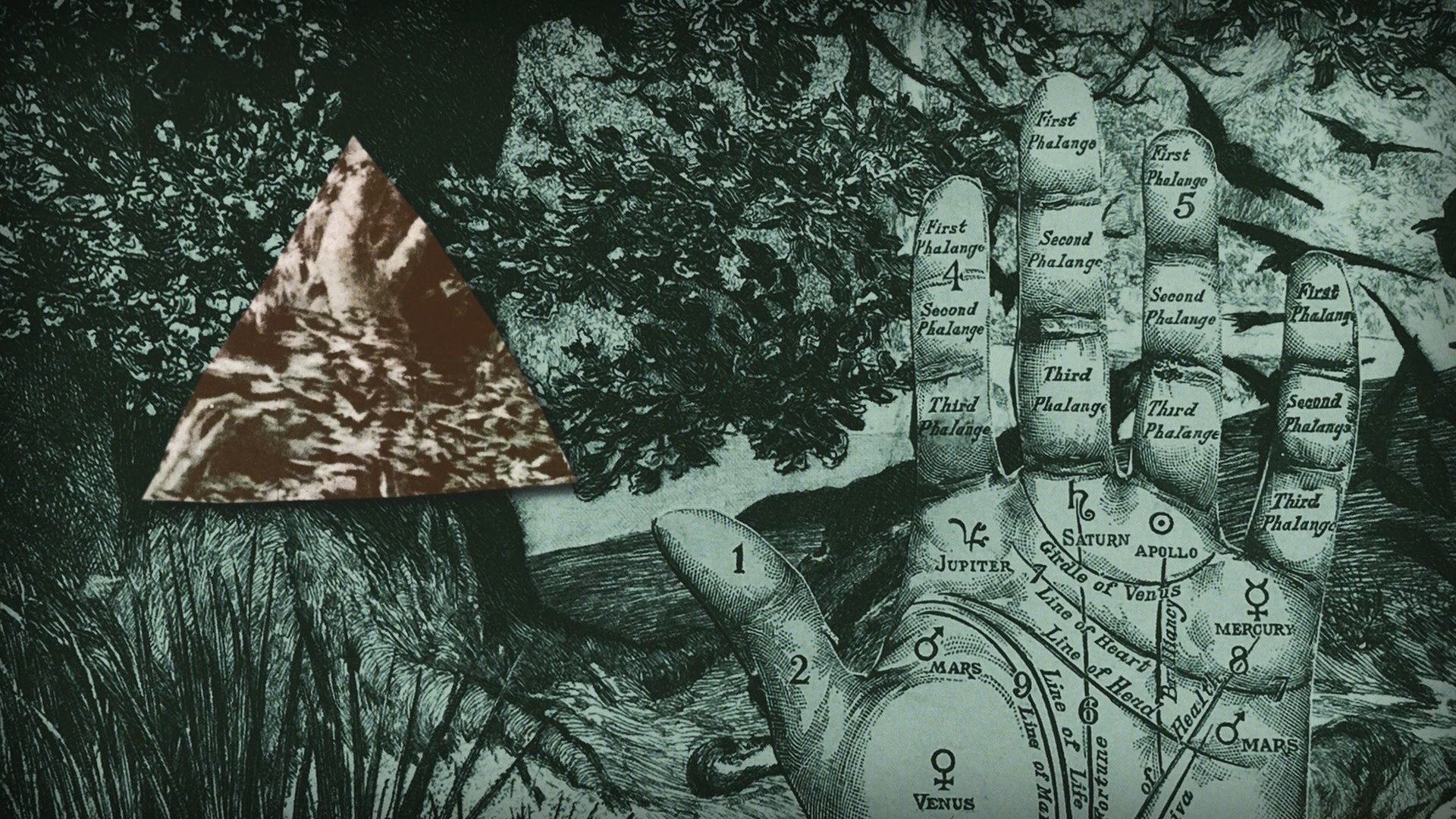 to its history (encompassing landmarks like Stonehenge and its many pre-Christian traditions) as well as its essential trilogy of pastoral cinematic horror with The Wicker Man, Blood on Satan's Claw, and Witchfinder General. British television has long been a breeding ground for folk horror tales as well, ranging from the beloved A Ghost Story for Christmas cycle to countless episodes of anthology series since the 1970s. However, folk horror can really extend all over the globe with Europe as a whole turning out many vital (and sometimes shamefully overlooked) contributions, while the U.S. and other countries have made their contributions as well. Thanks to more recent films like The Witch, Midsommar, The Ritual, and Hereditary, the wave shows no sign of slowing down, so it was inevitable that a documentary would come along to take a look at how it all ties together. What we got was a genuine epic of pop culture dissection, Woodlands Dark and Days Bewitched, an in-depth plunge from writer-director Kier-la Janisse, the founder of the international Miskatonic Institute of Horror Studies and author of the watershed horror analysis meets autobiography, House of Psychotic Women. That documentary (also available as a standalone Blu-ray or DVD) is the centerpiece of the most elaborate set to date from Severin Films, All the Haunts Be Ours: A Compendium of Folk Horror, which also features 19 additional feature films, some making their worldwide Blu-ray debuts and packed with bonus features. Buckle up, folks -- it's a hefty one, and there's a lot to cover!
to its history (encompassing landmarks like Stonehenge and its many pre-Christian traditions) as well as its essential trilogy of pastoral cinematic horror with The Wicker Man, Blood on Satan's Claw, and Witchfinder General. British television has long been a breeding ground for folk horror tales as well, ranging from the beloved A Ghost Story for Christmas cycle to countless episodes of anthology series since the 1970s. However, folk horror can really extend all over the globe with Europe as a whole turning out many vital (and sometimes shamefully overlooked) contributions, while the U.S. and other countries have made their contributions as well. Thanks to more recent films like The Witch, Midsommar, The Ritual, and Hereditary, the wave shows no sign of slowing down, so it was inevitable that a documentary would come along to take a look at how it all ties together. What we got was a genuine epic of pop culture dissection, Woodlands Dark and Days Bewitched, an in-depth plunge from writer-director Kier-la Janisse, the founder of the international Miskatonic Institute of Horror Studies and author of the watershed horror analysis meets autobiography, House of Psychotic Women. That documentary (also available as a standalone Blu-ray or DVD) is the centerpiece of the most elaborate set to date from Severin Films, All the Haunts Be Ours: A Compendium of Folk Horror, which also features 19 additional feature films, some making their worldwide Blu-ray debuts and packed with bonus features. Buckle up, folks -- it's a hefty one, and there's a lot to cover!
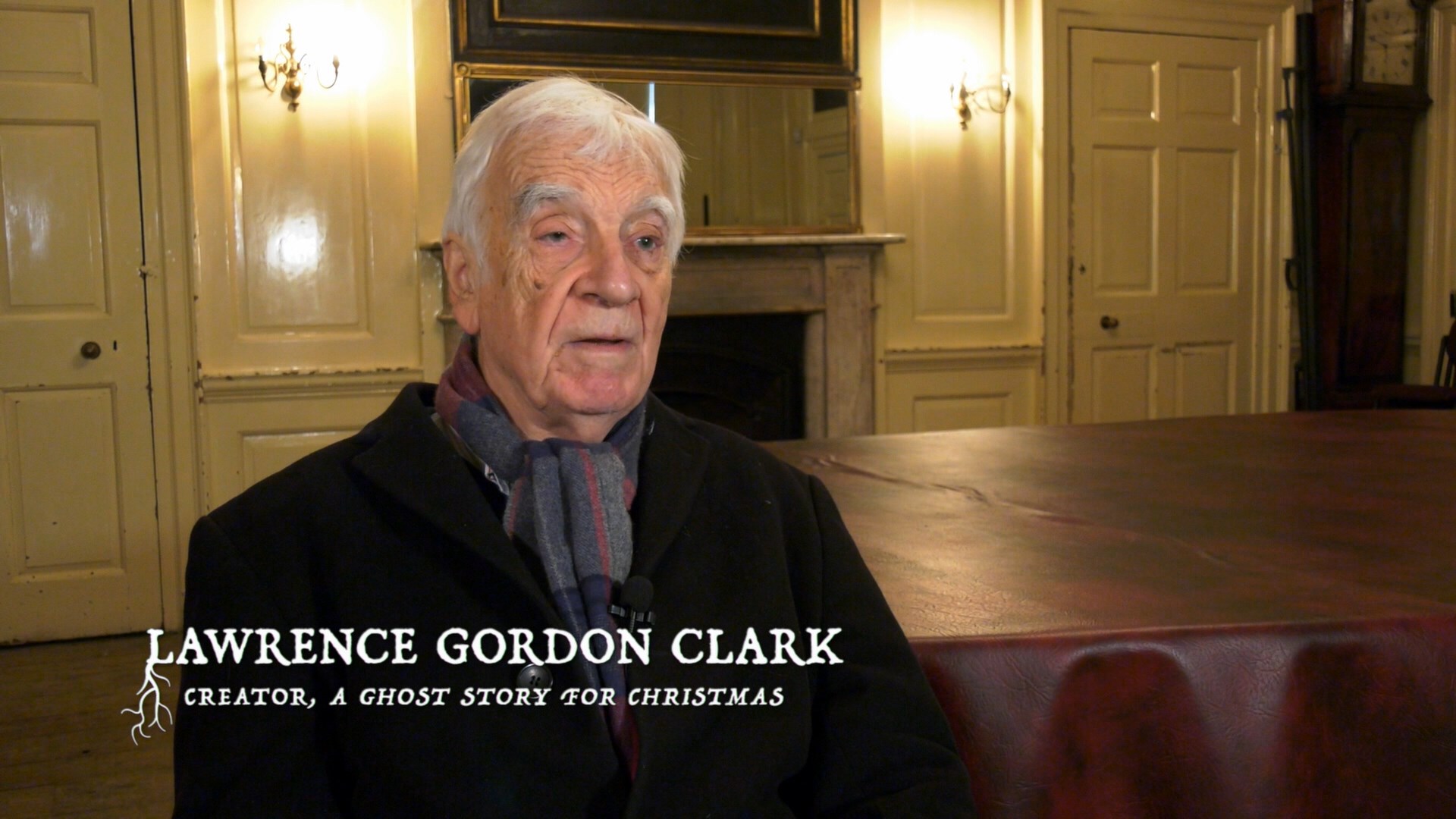 Clocking in at over three hours, Woodlands is about as comprehensive as you can imagine
Clocking in at over three hours, Woodlands is about as comprehensive as you can imagine 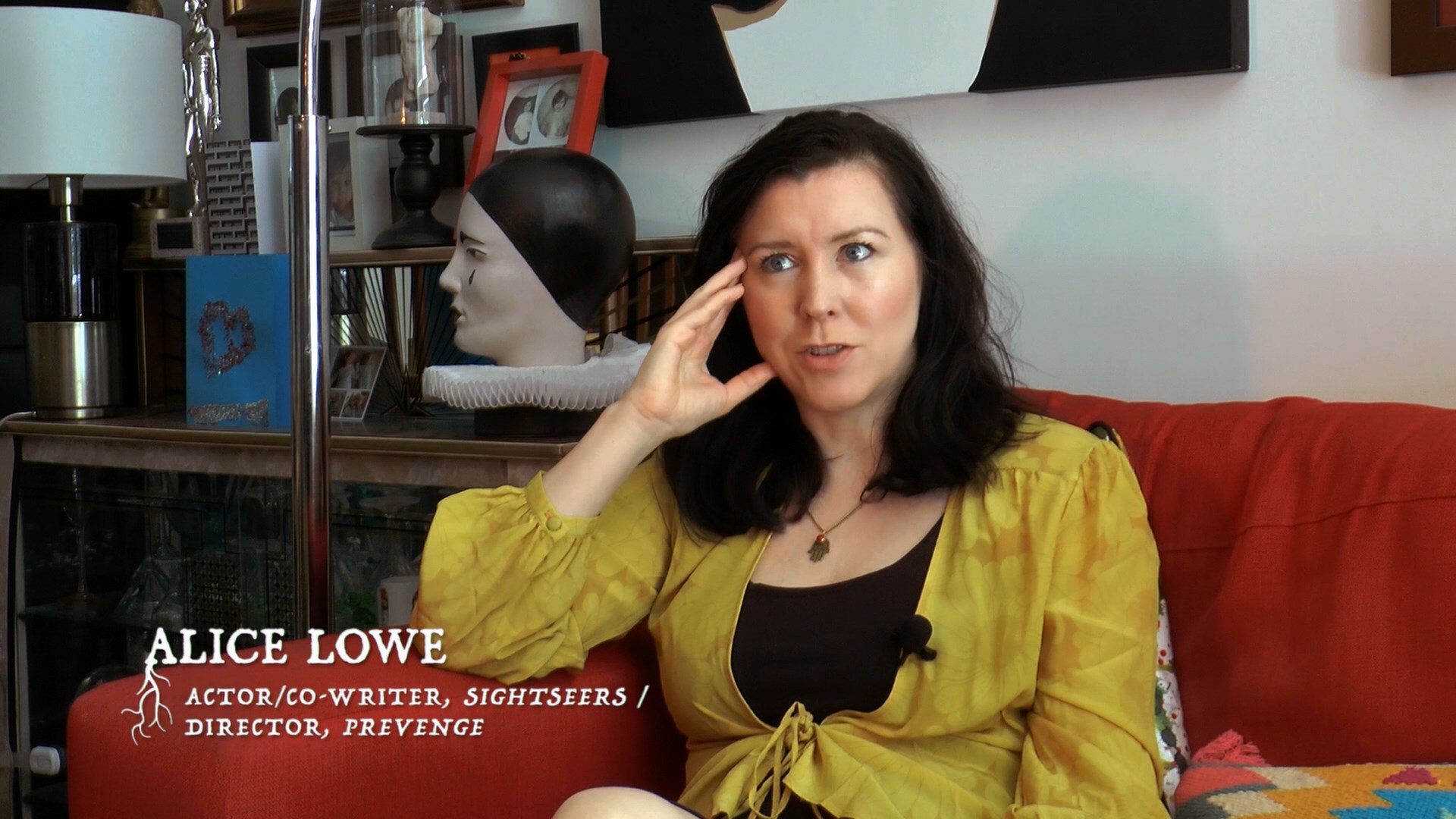 with a thorough overview of the roots of folk horror going all the way back to early works of literature and silent films, with a wealth of participants providing context along the way. Also included are poem readings by Linda Hayden and Ian Ogilvy, paper collage sequences by Guy Maddin, and a slew of new and archival interviews featuring Jonathan Rigby, Anthony Schaffer, Robin Hardy, Robert Eggers, Lawrence Gordon Clark, Amanda Reyes, Richard Blackburn, Sam Dunn, Alice Lowe, Sean Hogan, Piers Haggard, Mark Pilkington, Gail-Nina Anderson, Jeremy Dyson, Geraldine Beskin, Vic Pratt, William Fowler, Samm Deighan, Maisha Wester, Lindsay Hallam, Howard David Ingham, Adam Scovell, John Cussans, Bernice M. Murphy, Kali Simmons, Jesse Wente, Mariano Baino, Mitch Horowitz, Emma Tammi, Teresa Sutherland, Kat Ellinger, Briony Kidd, Chad Crawford Kinkle, John Leman Riley, Alexandra Heller-Nicholas, Mikel Koven, and Janisse herself.
with a thorough overview of the roots of folk horror going all the way back to early works of literature and silent films, with a wealth of participants providing context along the way. Also included are poem readings by Linda Hayden and Ian Ogilvy, paper collage sequences by Guy Maddin, and a slew of new and archival interviews featuring Jonathan Rigby, Anthony Schaffer, Robin Hardy, Robert Eggers, Lawrence Gordon Clark, Amanda Reyes, Richard Blackburn, Sam Dunn, Alice Lowe, Sean Hogan, Piers Haggard, Mark Pilkington, Gail-Nina Anderson, Jeremy Dyson, Geraldine Beskin, Vic Pratt, William Fowler, Samm Deighan, Maisha Wester, Lindsay Hallam, Howard David Ingham, Adam Scovell, John Cussans, Bernice M. Murphy, Kali Simmons, Jesse Wente, Mariano Baino, Mitch Horowitz, Emma Tammi, Teresa Sutherland, Kat Ellinger, Briony Kidd, Chad Crawford Kinkle, John Leman Riley, Alexandra Heller-Nicholas, Mikel Koven, and Janisse herself.
After a primer on the basics of folk horror, the first hour or so is mostly devoted to the British strain including the evolution from writers like M.R. James and Algernon Blackwood through the heavy hitters of folk horror (including '80s variants like The Company of Wolves and Lair of the White Worm) along with often overlooked related titles like Requiem for a Village and oddball entries like Psychomania. There's also quite a bit about British TV contributions including The Owl Service, The Stone Tape, Doctor Who, Children of the Stones, and more, as well as the whole Quatermass cycle. Then it's off to America for a history from Washington Irving through H.P. Lovecraft, Shirley Jackson, and Stephen King, touching on the prevalence of Native American history and the roles of evangelical Christianity and folk music along the way. Finally the last hour-plus focuses on horror around the rest of the world including Australia, Eastern Europe, and Japan, touching on films like Picnic at Hanging Rock, Viy, Valerie and Her Week of Wonders, Zeder, Kwaidan, The Living Head, Wake in Fright, the Coffin Joe films, and more. Quite engrossing throughout and a treat for fans of both the horror genre and world folklore, the  doc will have you scribbling down notes about books and films to explore throughout
doc will have you scribbling down notes about books and films to explore throughout 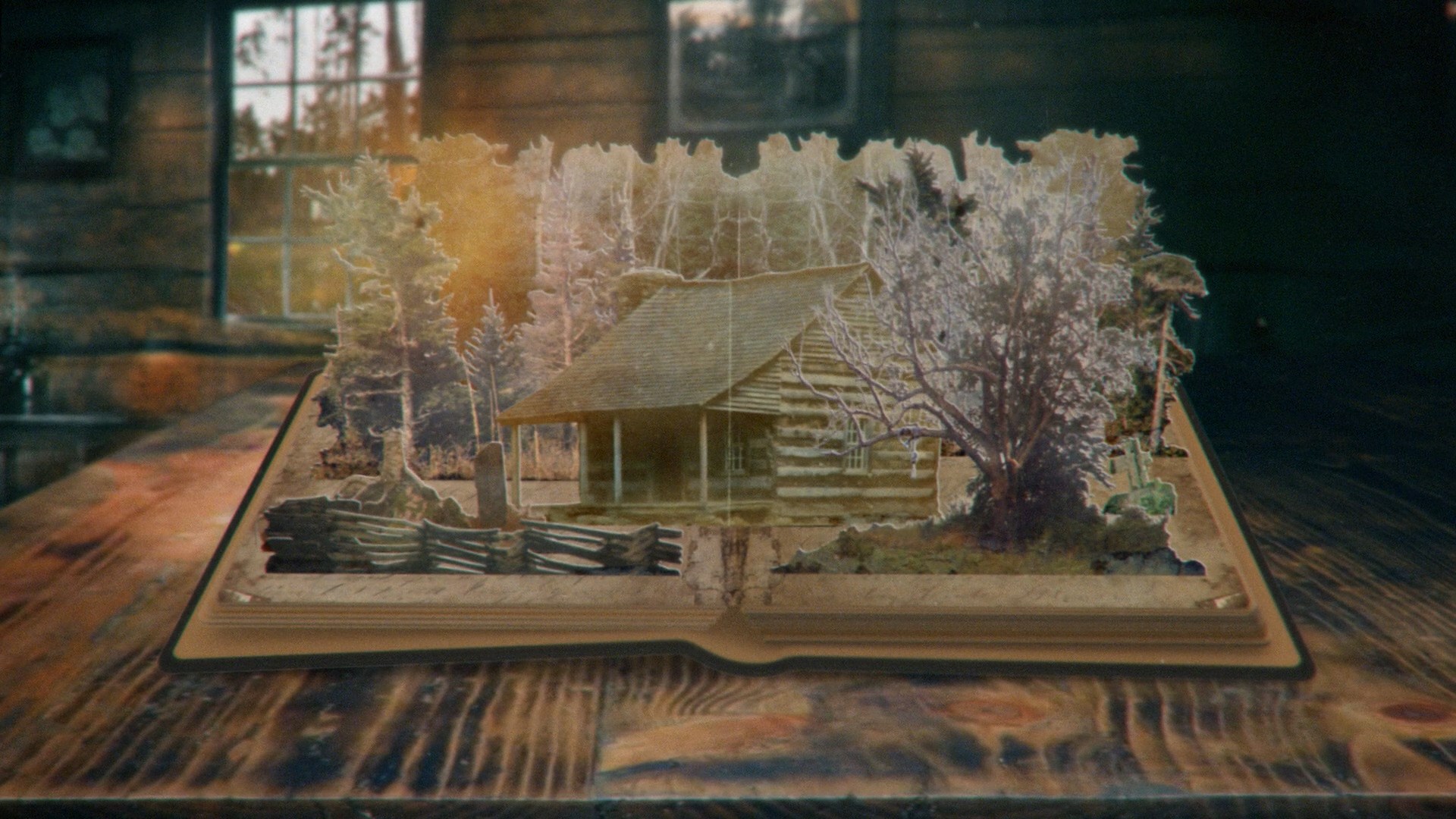 even if you're quite familiar with the subject matter. It's a phenomenal achievement any way you look at it and one that bears repeated viewings as well.
even if you're quite familiar with the subject matter. It's a phenomenal achievement any way you look at it and one that bears repeated viewings as well.
For its home video debut after extensive festival play, the film looks as immaculate as you'd expect with crisp video quality and a nicely enveloping DTS-HD MA 2.0 stereo track. The extras kick off with a new video Intro by Janisse (8m59s) who explains how the three-year process of the production came about and evolved from a core group of interviews as she became aware of the truly expansive nature of the subject and what it would require. In "Animating Folk Horror" (12m26s), Devon-based animator Ashley Thorpe (Borley Rectory) demonstrates how he created the '70s British TV-style credits and animated sequences as well as commenting on the mood they were aiming for in the film and some of the creative inspirations. Three extra "outtake" sections from the film begin with "What is Folk Horror?" (2m18s), which is exactly what it sounds like, followed by "Harvest Hymns: The Sounds and Signals of Folk Horror" (21m7s) with Marc Wilkinson, John Cameron, Jim Williams, Pentagram Home Video, Sam Waymon, and more exploring the evolution of folk horror music including significant achievements for The Wicker Man, Psychomania, The Stone Tape, and a pretty incredible bit about Ganja and Hess, plus electronic innovations and some non-film keystones. "Terra Assombrada: Expressions of Folk Horror in Brazil" (6m54s) expands on one of the more tantalizing bits from the world section in the main film with filmmaker Dennison Ramalho and scholars Carlos Primati and Laura Loguercio Cánepa covering how folk literature and songs played a role in Brazilian folk horror. Also included are "Folk Poetry" (5m11), an extra helping of folk poems read by Ogilvy and Hayden accompanied by atmospheric woodsy Super 8 footage, and the original trailer.
_________________________________________________________________________________________________________________
Disc two features one of the big selling points for the set and probably the biggest MIA holy 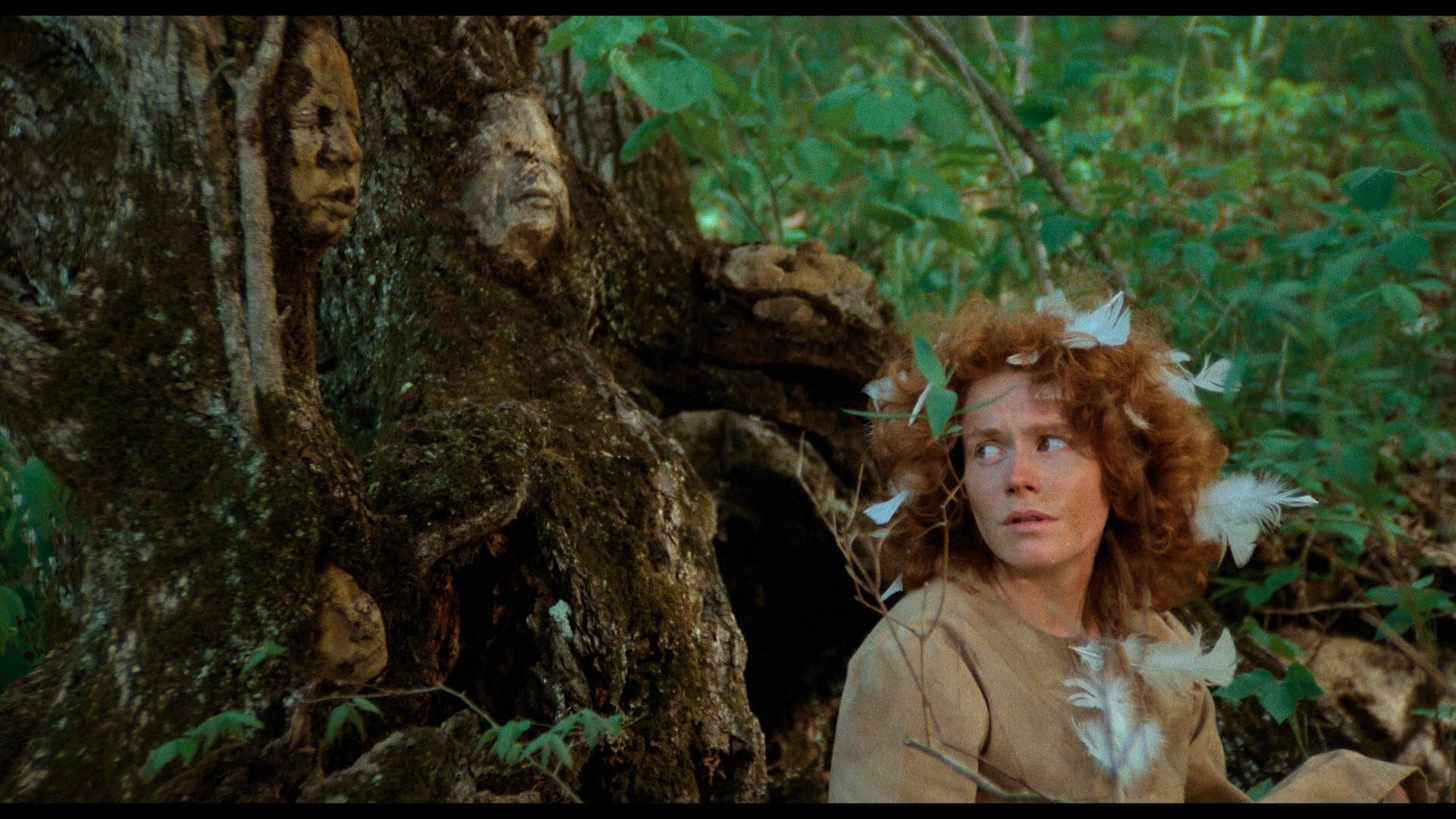 grail of all folk horror films, Eyes of Fire,
grail of all folk horror films, Eyes of Fire, 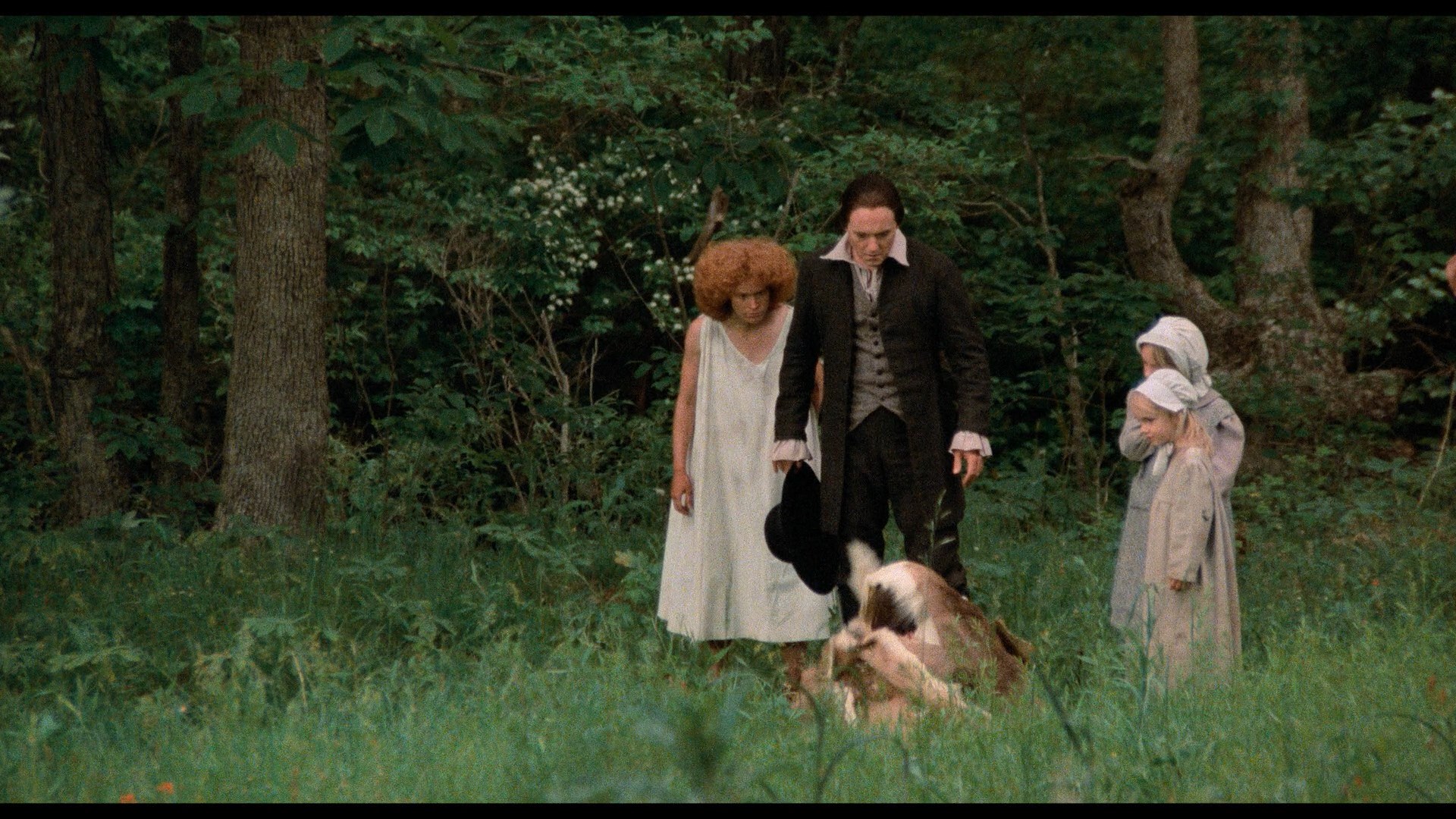 which hasn't had an official home video release since its Vestron VHS back in the mid-'80s. The first feature by onetime still photographer Avery Crounse, this fascinating slice of macabre Americana during the early settler days has earned a substantial cult following over the years with its very sparse theatrical revivals drawing big crowds. No wonder, as it's extremely adventurous and hallucinatory with a unique atmosphere unlike anything else out there from the '80s or otherwise.
which hasn't had an official home video release since its Vestron VHS back in the mid-'80s. The first feature by onetime still photographer Avery Crounse, this fascinating slice of macabre Americana during the early settler days has earned a substantial cult following over the years with its very sparse theatrical revivals drawing big crowds. No wonder, as it's extremely adventurous and hallucinatory with a unique atmosphere unlike anything else out there from the '80s or otherwise.
Led by a manipulative, polygamist preacher, Will Smythe (Lipscomb), a group of settlers fleeing persecution end up going downriver with several near-death encounters averted thanks to the intervention of the seemingly unhinged Leah (Crockett), who's actually a witch. Potential ambushes by tribes in the area seem to be the biggest threat, but a supernatural surprise awaiting them will test their faith and their lives more than they could have imagined. Wildly inventive and featuring some breathtakingly composed shots peppered throughout, this is definitely a horror film on the artier side but one that yields considerable rewards if you just sit back and go along for the ride. The fact that it starts off like a fairly traditional, Last of the Mohicans-style tale of unsettled American is particularly bold considering the wild and eventually psychedelic direction everything takes by the end, with a free-flowing narrative that doesn't necessarily tie everything up in a nice little bow. Also of interest is the experimental score by Brad Fiedel, who was fresh off 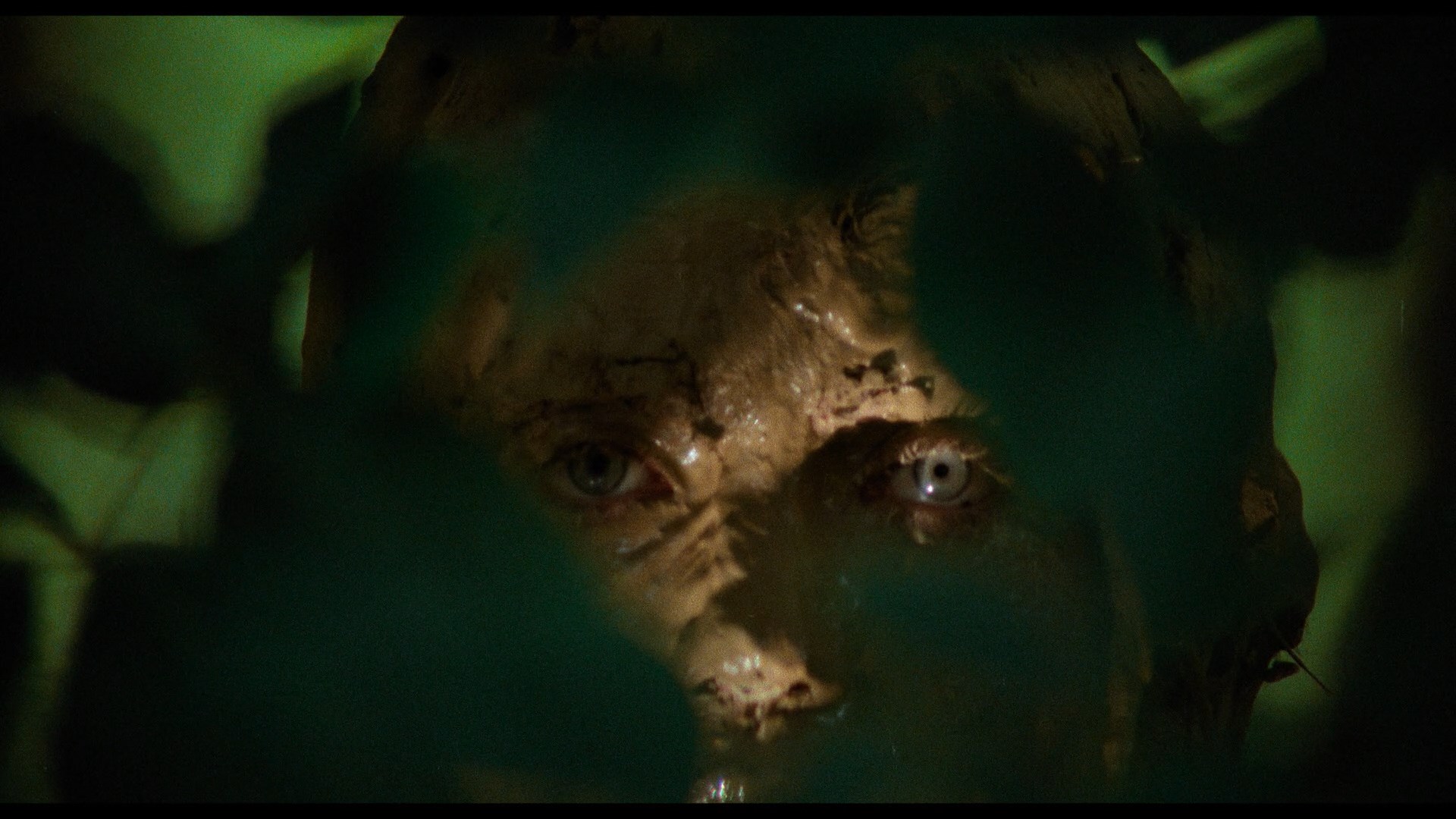 of Just Before Dawn and would
of Just Before Dawn and would 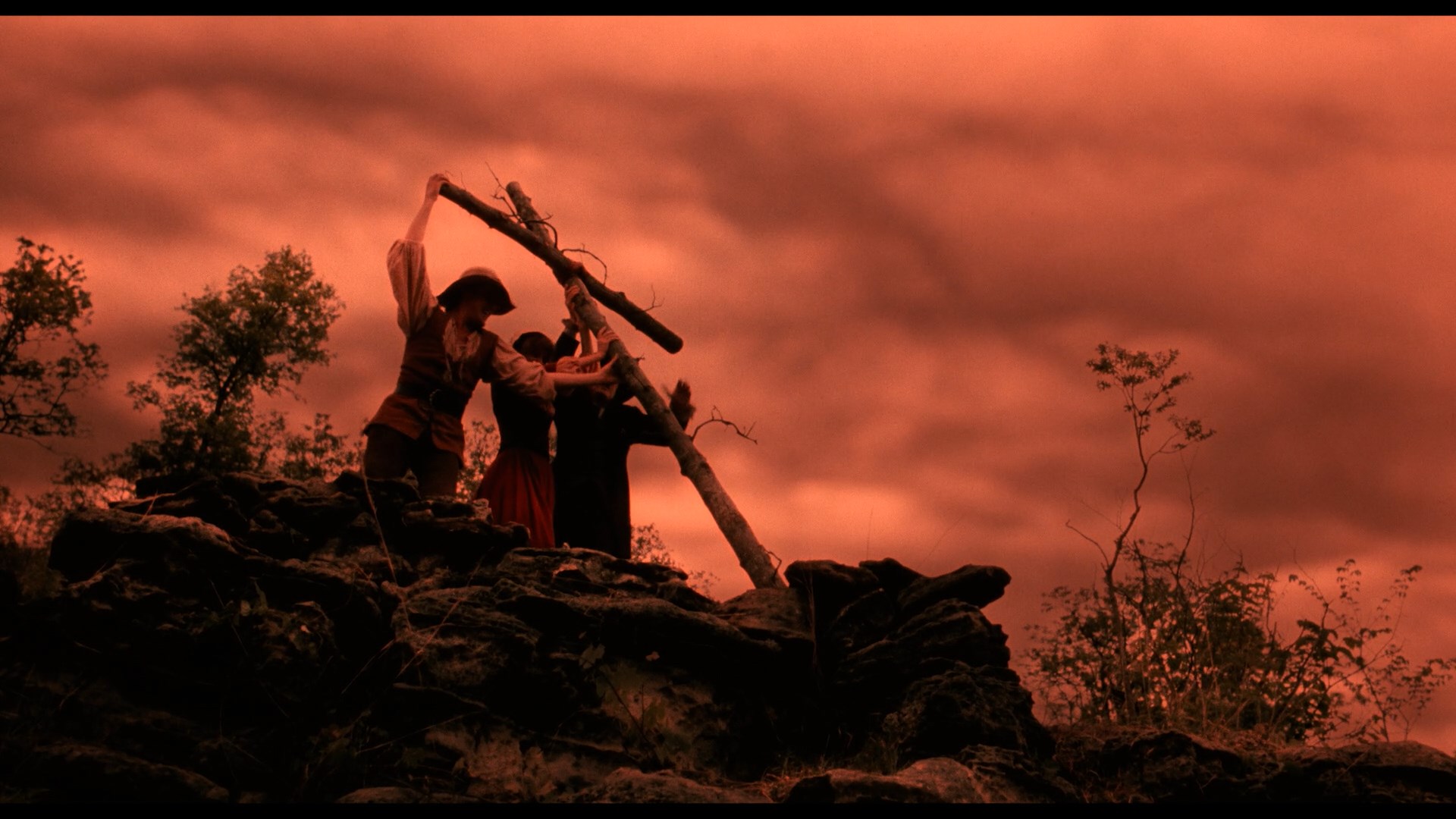 go on to Fright Night soon after.
go on to Fright Night soon after.
Anyone waiting for a decent home video release of this film after the fuzzy and very desaturated VHS will be delighted by the presentation here, with the familiar theatrical version looking gorgeous thanks to a new 4K restoration from the original negative. The DTS-HD MA English 2.0 mono track (with optional English SDH subtitles) is also much, much better than before, allowing you to savor the bizarre sound design to its full potential. The film also comes with a new audio commentary by Ghostland: An American History In Haunted Places author Colin Dickey, who's critical of some aspects of the film but very enthusiastic about most of it as he dissects it from the perspective of haunted American history. Anyone who's read up on this film may have also come across mentions of its unreleased longer earlier cut, Crying Blue Sky, which was tweaked by the director after some preview screenings that left him dissatisfied. Well, you finally get to see it here from his own 35mm answer print; running over 20 minutes longer, it features a very different opening and ending, a unique main title sequence, some alternate music choices, and more character development. The thrust of the story is the same, but the execution is obviously altered by the slower pacing and dreamier feel that borders on Herzog-style at times.
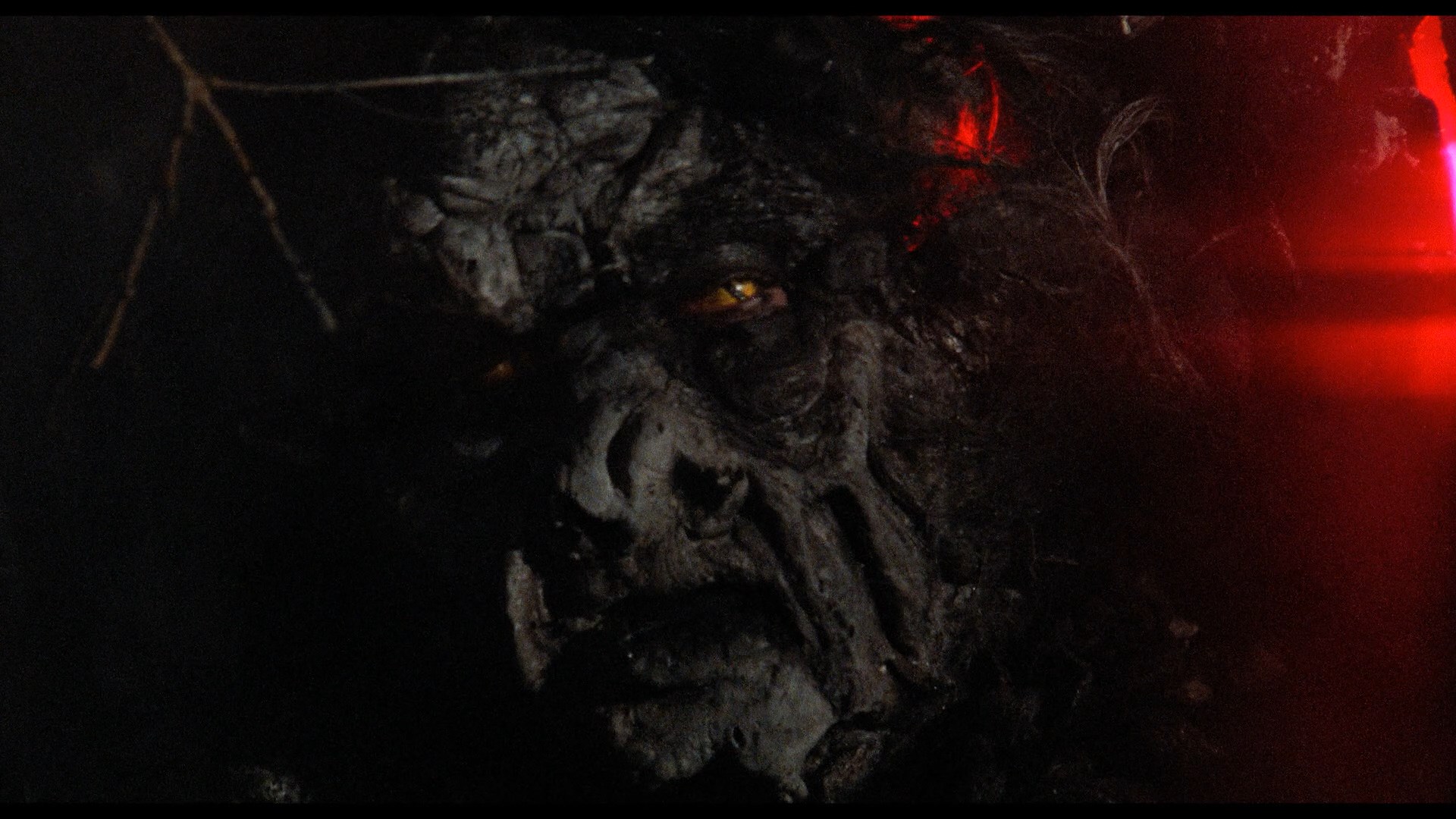 In "The Secret Is In The Trees" (27m39s), Nightmare USA author Stephen Thrower chats via Zoom
In "The Secret Is In The Trees" (27m39s), Nightmare USA author Stephen Thrower chats via Zoom 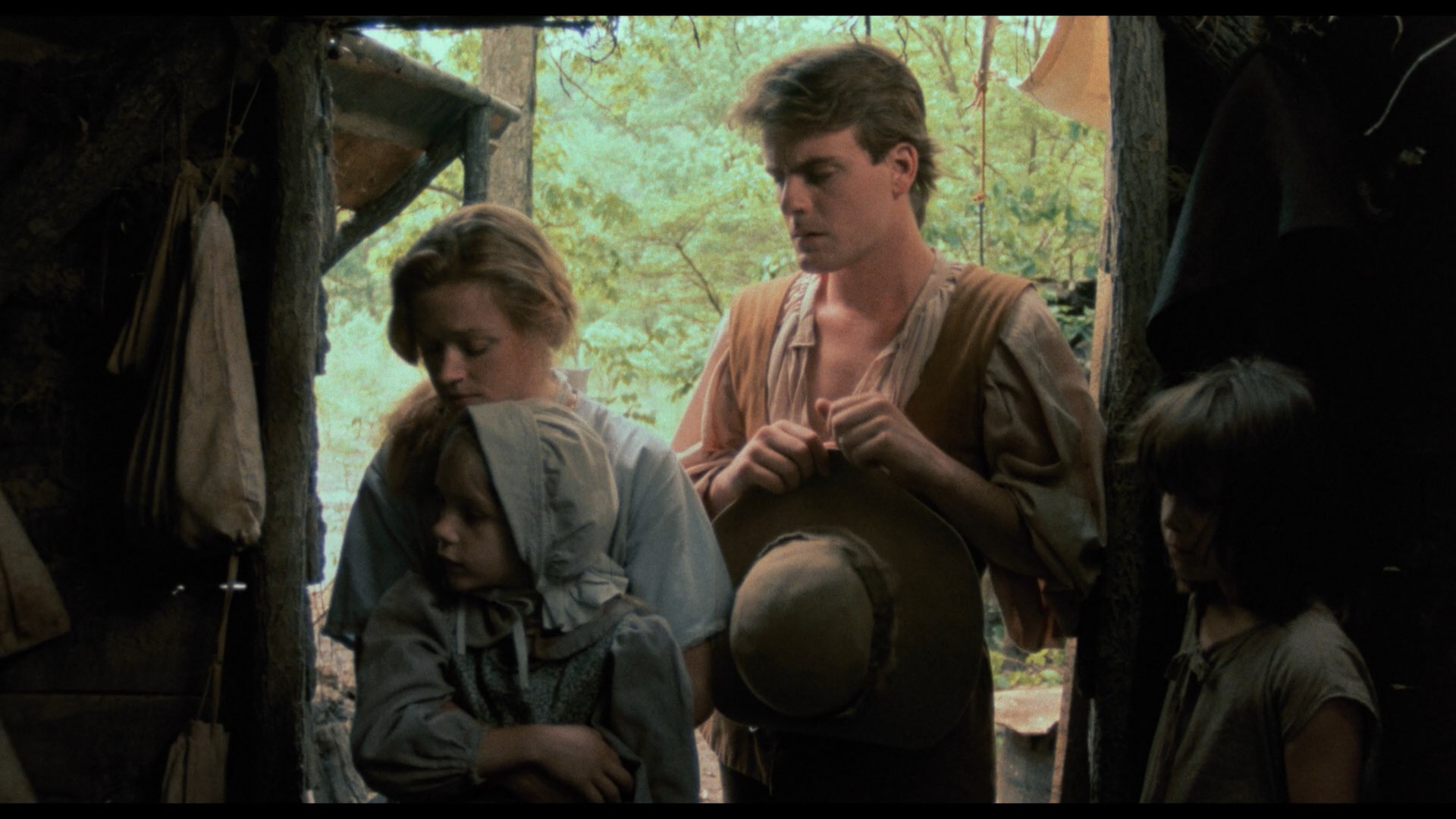 with Crounse about his career before the film, the reason for his unorthodox choice of subject matter, the story behind the reediting into the theatrical cut, the first theatrical rollout in Alabama, and the flack he got from fans for his unexpected follow-up feature, The Invisible Kid. Also included are three short films starting with 1972's The Legend of Sleepy Hollow (13m12s) from animator Sam Weiss, featuring narration by none other than John Carradine. It's a very faithful adaptation of the Washington Irving perennial done in a Schoolhouse Rock style, and while the horror content here is pretty low (the Headless Horseman segment doesn't even last a minute), it's a fun bit of kid-friendly spookery perfect for Halloween viewing. The transfer here looks pretty solid as well thanks to a new scan from the 16mm material by AV Geeks. The same year's Transformations (8m34s) by Barbara Hirschfeld is a very atmospheric little black-and-white occult piece about a group of women who quietly leave their homes in the dead of night to perform a coven ritual in the woods; this one also looks quite good and comes from the Vermont Archive Movie Project. Finally 2018's Backwoods (15m25s) from Ryan Mackfall is a slick and eerie H.P. Lovecraft adaptation (from "The Picture in the House") set in 1907 Massachusetts about a young student whose exploration of an empty house goes in a very dark direction. Previously available on the H.P. Lovecraft Film Festival Best of 2019 Short Film Collection Blu-ray and DVD, this one's always worth a look.
with Crounse about his career before the film, the reason for his unorthodox choice of subject matter, the story behind the reediting into the theatrical cut, the first theatrical rollout in Alabama, and the flack he got from fans for his unexpected follow-up feature, The Invisible Kid. Also included are three short films starting with 1972's The Legend of Sleepy Hollow (13m12s) from animator Sam Weiss, featuring narration by none other than John Carradine. It's a very faithful adaptation of the Washington Irving perennial done in a Schoolhouse Rock style, and while the horror content here is pretty low (the Headless Horseman segment doesn't even last a minute), it's a fun bit of kid-friendly spookery perfect for Halloween viewing. The transfer here looks pretty solid as well thanks to a new scan from the 16mm material by AV Geeks. The same year's Transformations (8m34s) by Barbara Hirschfeld is a very atmospheric little black-and-white occult piece about a group of women who quietly leave their homes in the dead of night to perform a coven ritual in the woods; this one also looks quite good and comes from the Vermont Archive Movie Project. Finally 2018's Backwoods (15m25s) from Ryan Mackfall is a slick and eerie H.P. Lovecraft adaptation (from "The Picture in the House") set in 1907 Massachusetts about a young student whose exploration of an empty house goes in a very dark direction. Previously available on the H.P. Lovecraft Film Festival Best of 2019 Short Film Collection Blu-ray and DVD, this one's always worth a look.
Though not normally thought of as a hotbed of cinematic folk horror, 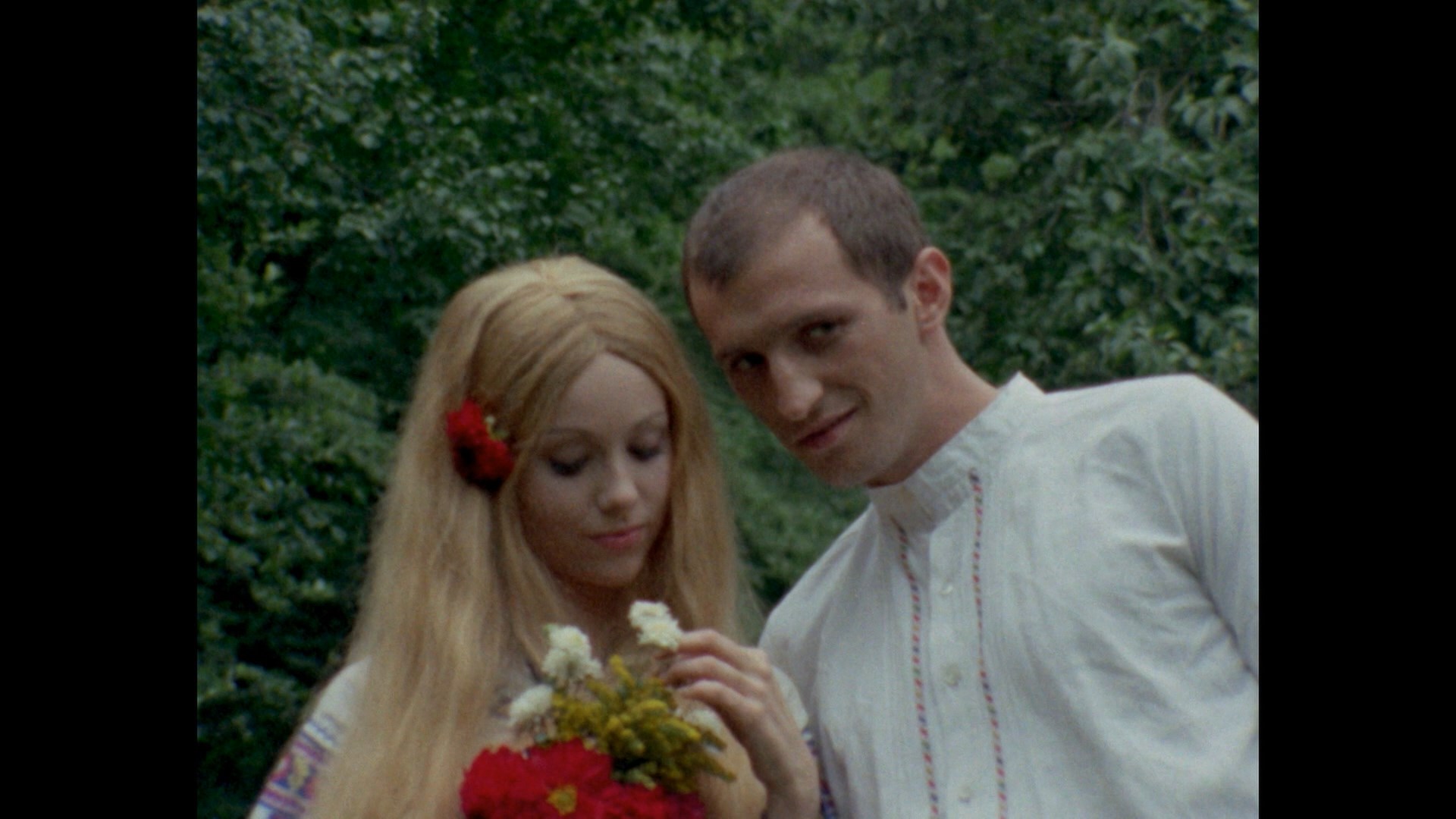
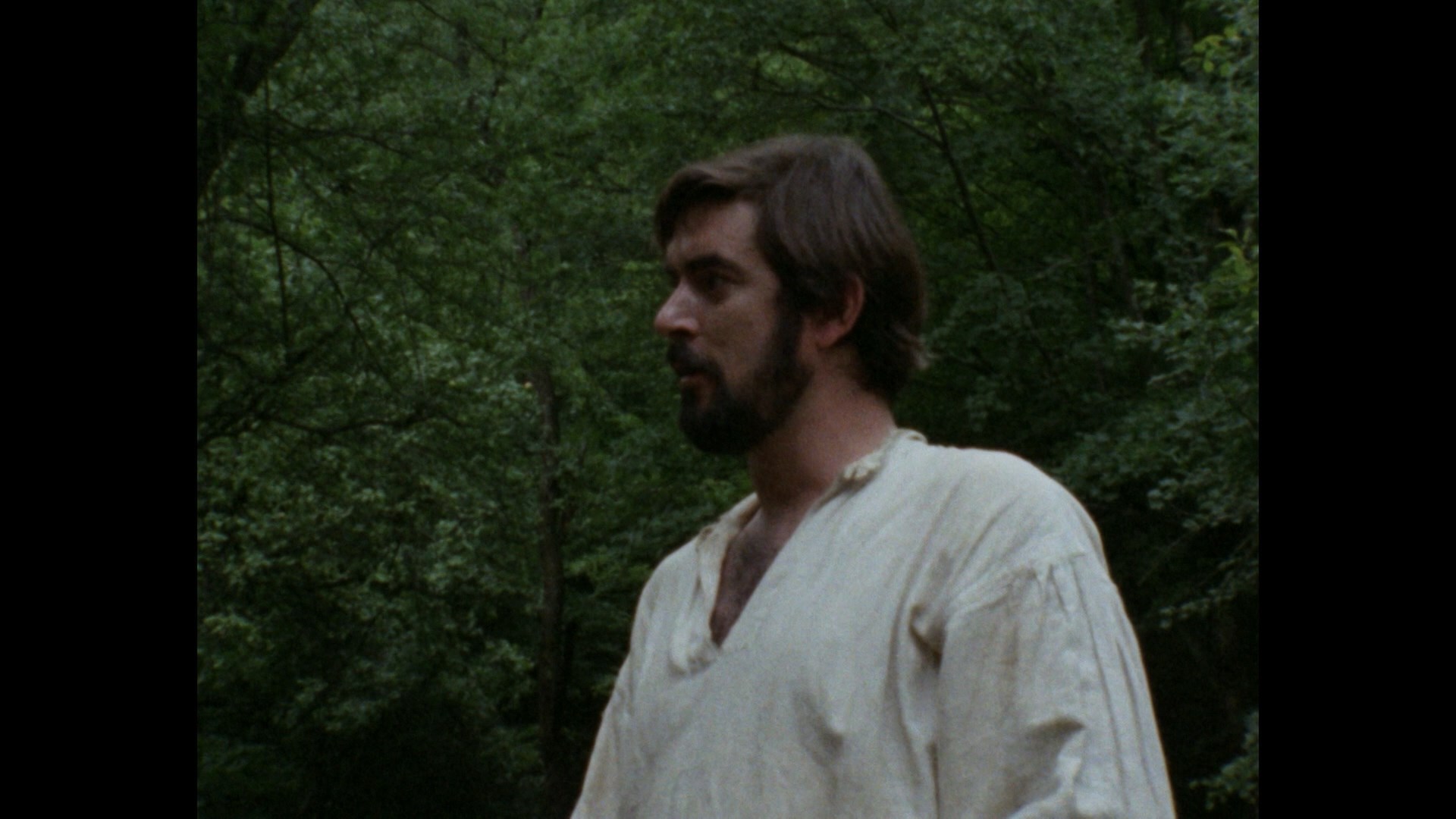 the former Yugoslavia delivered one heck of an entry in 1973 with Leptirica, a fascinating variation on vampire conventions. Occupying disc three, the Serbian-shot period supernatural yarn from director Đorđe Kadijević was originally shot for television but has since been revived on the big screen in international horror spotlights over the years. Based on an 1880 Slavic novel, it's a very sinister love story about the impoverished Strahinja (Božović) and his forbidden romance with the beautiful Radojka (Nikolić), whose father forbids their union. Nearby a supposedly cursed mill is the epicenter for slayings at the hands of a fanged beast with long talon-like fingernails, and after he survives an attack himself, Strahinja becomes entangled in a local mystery involving a vampiric creature that may be able to transform into a butterfly.
the former Yugoslavia delivered one heck of an entry in 1973 with Leptirica, a fascinating variation on vampire conventions. Occupying disc three, the Serbian-shot period supernatural yarn from director Đorđe Kadijević was originally shot for television but has since been revived on the big screen in international horror spotlights over the years. Based on an 1880 Slavic novel, it's a very sinister love story about the impoverished Strahinja (Božović) and his forbidden romance with the beautiful Radojka (Nikolić), whose father forbids their union. Nearby a supposedly cursed mill is the epicenter for slayings at the hands of a fanged beast with long talon-like fingernails, and after he survives an attack himself, Strahinja becomes entangled in a local mystery involving a vampiric creature that may be able to transform into a butterfly.
Complete with a memorable monster (seen clearly only at the end) and an unsettling choral-type score, Leptirica is a short and sweet monster tale that feels like a particularly nasty fairy tale sprung to life on film. Kadijevic shows a real knack for this kind of countryside material, something he would continue to explore in his worthwhile 1990 horror film A Holy Place (one of many variations on Viy, but more on that later). In fact, this one reportedly traumatized more than a few impressionable young viewers when it first aired, largely due to the intense finale that goes quite a bit further than you'd expect from an Eastern European TV movie. Since then it's become something 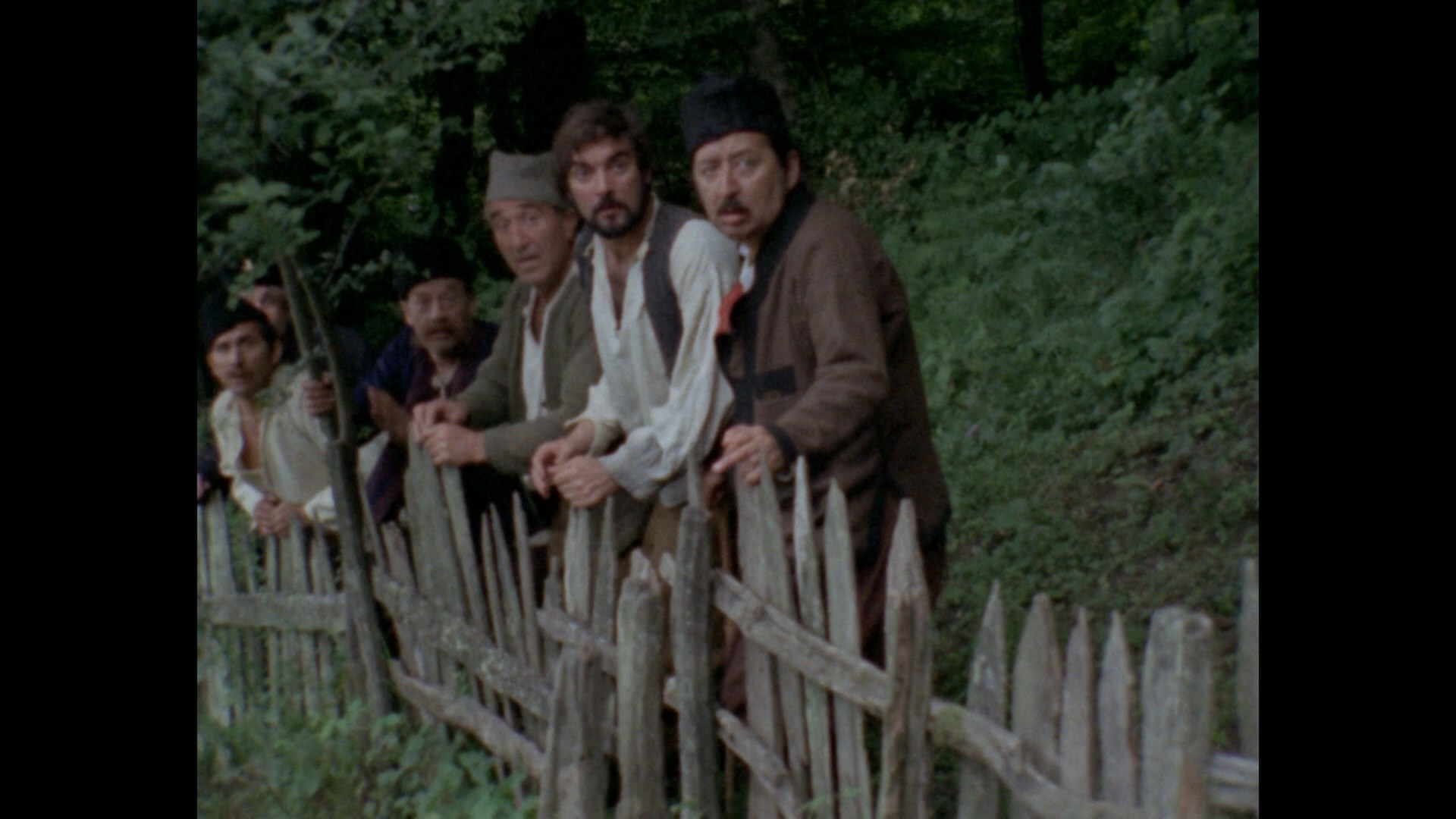 of a covert cult favorite, largely passed around for years on the bootleg circuit but now much
of a covert cult favorite, largely passed around for years on the bootleg circuit but now much 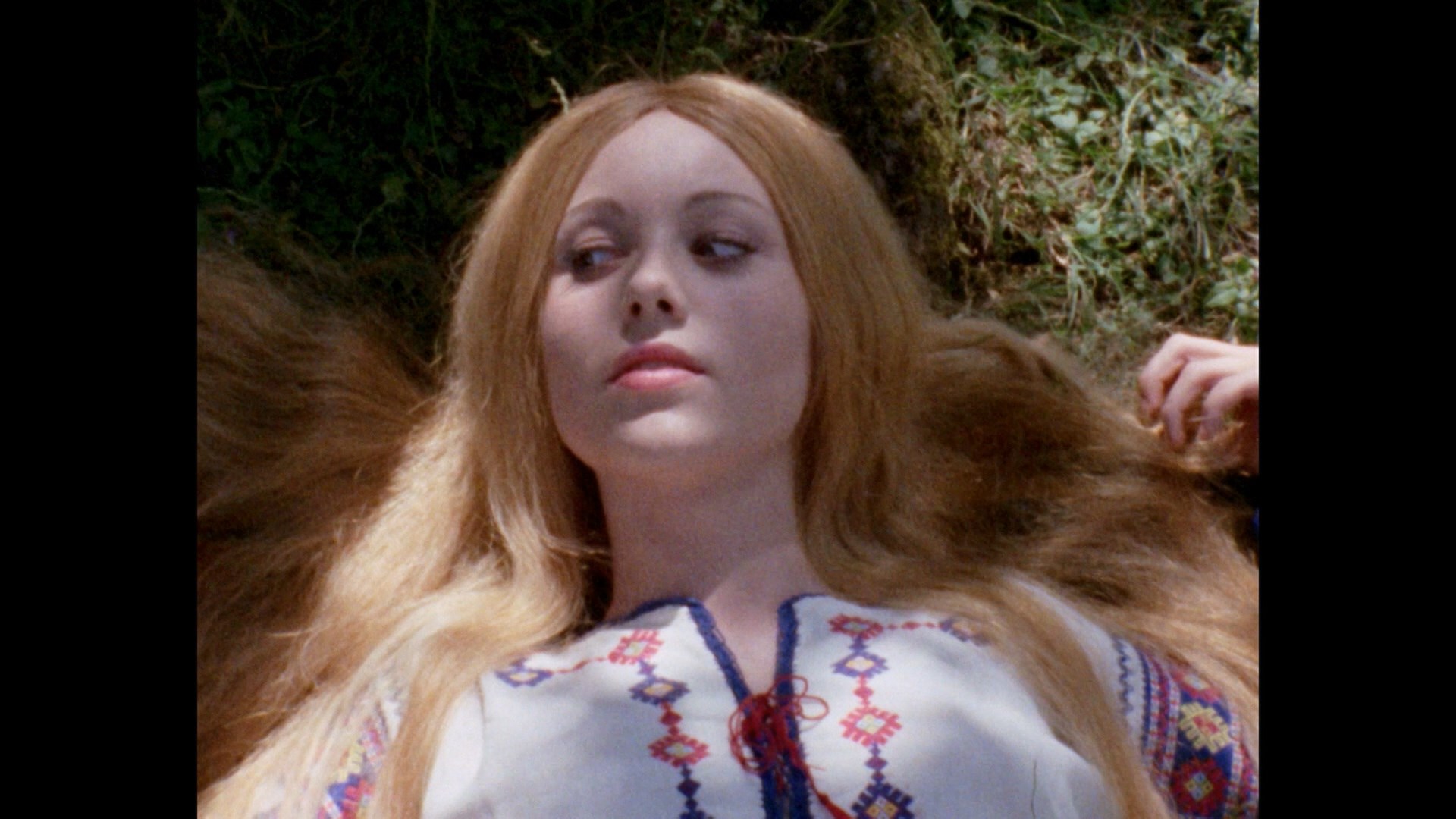 easier to find and enjoy in prime condition.
easier to find and enjoy in prime condition.
The first Blu-ray came from Germany complete with the original Slavic track, two German dubs (one new, the other "retro"), and German or English subtitles; the default viewing option is the 1.33:1 version as originally shot, but in the extras you can see an alternate 16:9 option as well. Other extras include a German audio commentary by Lars Dreyer-Winkelmann, a trailer, and a 1m56s gallery. The exact same HD master from Public Service Media Radio Television of Serbia is used for the Severin release, which also looks great; there's some inherent damage in the source here and there including some scuffs and a couple of bumpy edits, but overall the quality is excellent with vivid colors throughout. The rest of the disc is a real treat for anyone interested in Kadijevic as well, starting with In "Radical Fairy Tales" (31m21s) in which the director talks about his approach to the fantastique and his interest in human nature that informs all of his work.
You also get two of his short films (virtually features given their length), both also newly remastered in HD, starting with 1973's Štićenik (44m35s) in which a young man (Milan Mihailovic) is chased through the snow by an unknown attacker in black. He ends up finding refuge at a mental institution and ends up checking himself him in for safety, but that turns into an even more disorienting nightmare during the course of his stay. Enigmatic and beautifully shot, this is a great little chamber piece and a fine 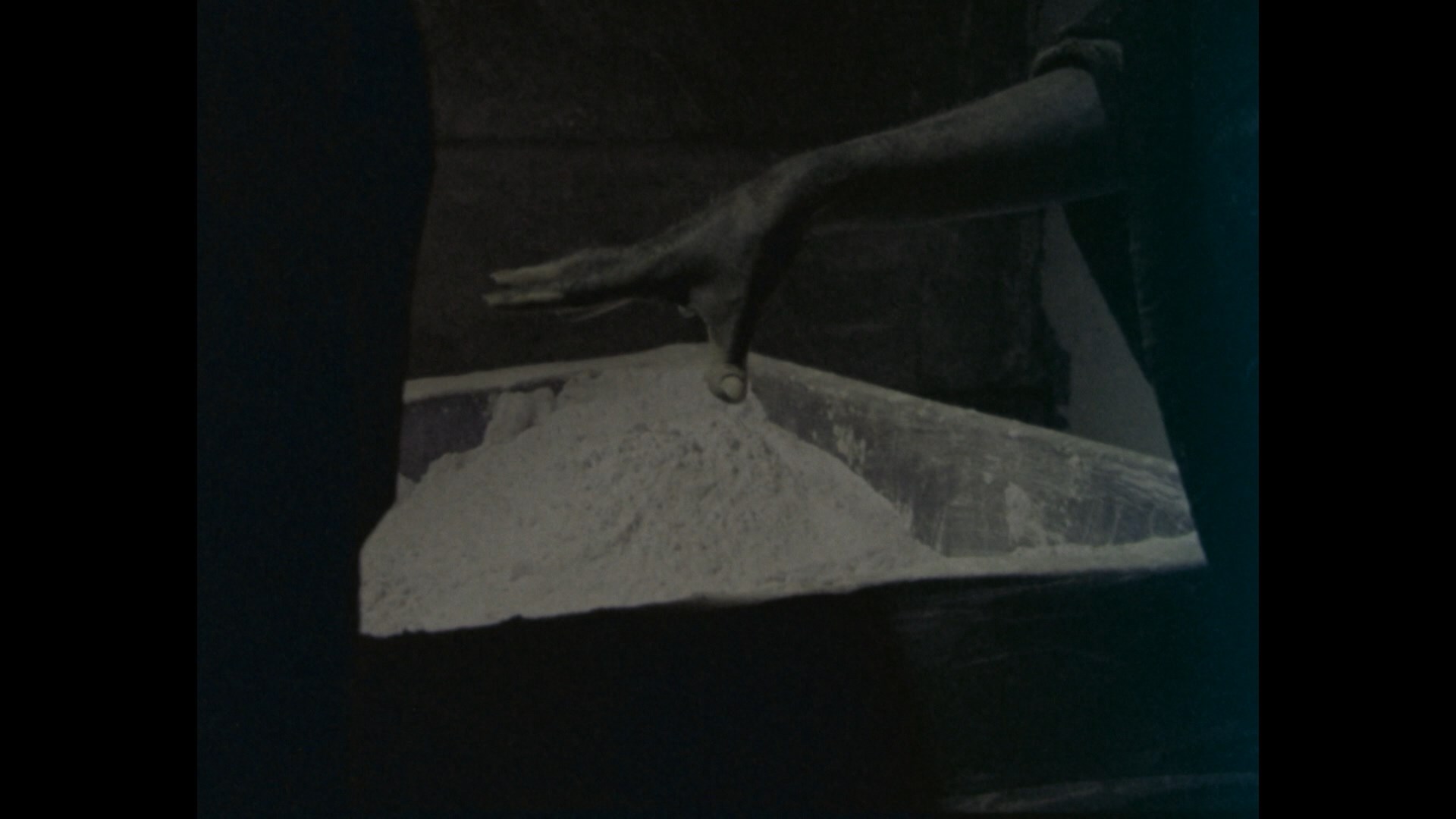 showcase for the filmmaker's skill. Mihailovic also turns up for a new interview, "Diary of an Inmate" (10m10s), about his own status as a student at the time, the lack of
showcase for the filmmaker's skill. Mihailovic also turns up for a new interview, "Diary of an Inmate" (10m10s), about his own status as a student at the time, the lack of 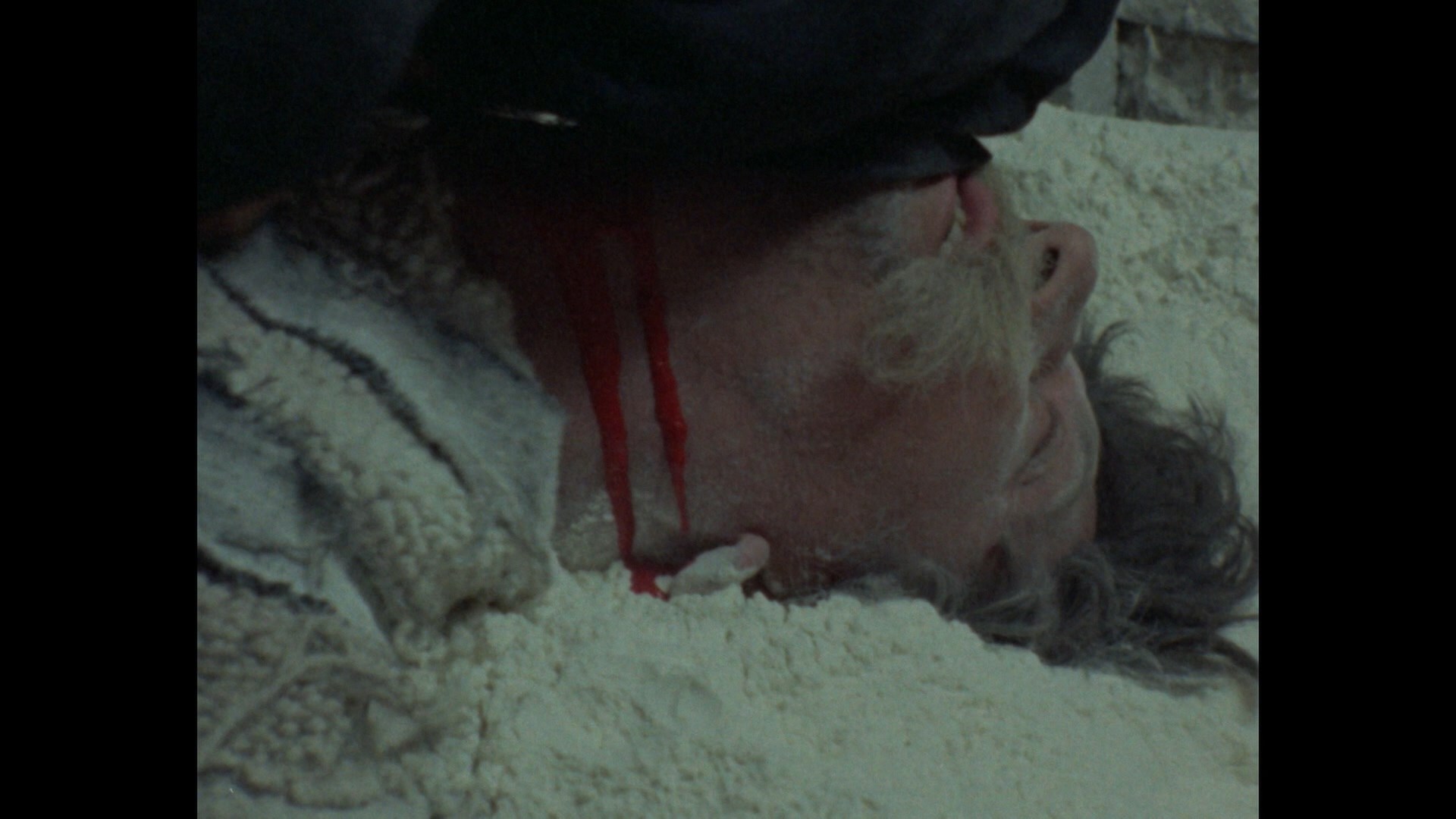 any auditions, the shoot at an old castle in Croatia, and the "true intellectual" nature of his director. The second short from the same year, Devičanska Svirka (59m27s), starts on a similar note with traveler Ivan (Goran Sultanovic) lured by the siren call of eerie music emanating from a castle. Despite warnings from a young boy who's promptly run over by a coach, he accepts an invitation to visit it by the owner, Sibila (Olivera Katarina), which turns into a night of romantic banter and eventually physical passion. More of a traditional Gothic horror tale with a spectacular macabre turn in the last ten minutes, this one is also very effective and serves as a master class in how to use sound editing and mixing for maximum effect with that shuddering music running up and down the spine of almost the entire film. Katarina really owns this one with a terrific performance that becomes more unsettling and hypnotic as the film gradually wraps its protagonist and the viewer up in its weird spell. In "Prisoner of Song" (13m29s), Sultanovic remembers his own experiences on the film as a beginning actor, Katarina's local star status, the scarcity of Serbian genre films at the time, and his other projects around the same time.
any auditions, the shoot at an old castle in Croatia, and the "true intellectual" nature of his director. The second short from the same year, Devičanska Svirka (59m27s), starts on a similar note with traveler Ivan (Goran Sultanovic) lured by the siren call of eerie music emanating from a castle. Despite warnings from a young boy who's promptly run over by a coach, he accepts an invitation to visit it by the owner, Sibila (Olivera Katarina), which turns into a night of romantic banter and eventually physical passion. More of a traditional Gothic horror tale with a spectacular macabre turn in the last ten minutes, this one is also very effective and serves as a master class in how to use sound editing and mixing for maximum effect with that shuddering music running up and down the spine of almost the entire film. Katarina really owns this one with a terrific performance that becomes more unsettling and hypnotic as the film gradually wraps its protagonist and the viewer up in its weird spell. In "Prisoner of Song" (13m29s), Sultanovic remembers his own experiences on the film as a beginning actor, Katarina's local star status, the scarcity of Serbian genre films at the time, and his other projects around the same time.
Severin (Blu-ray)
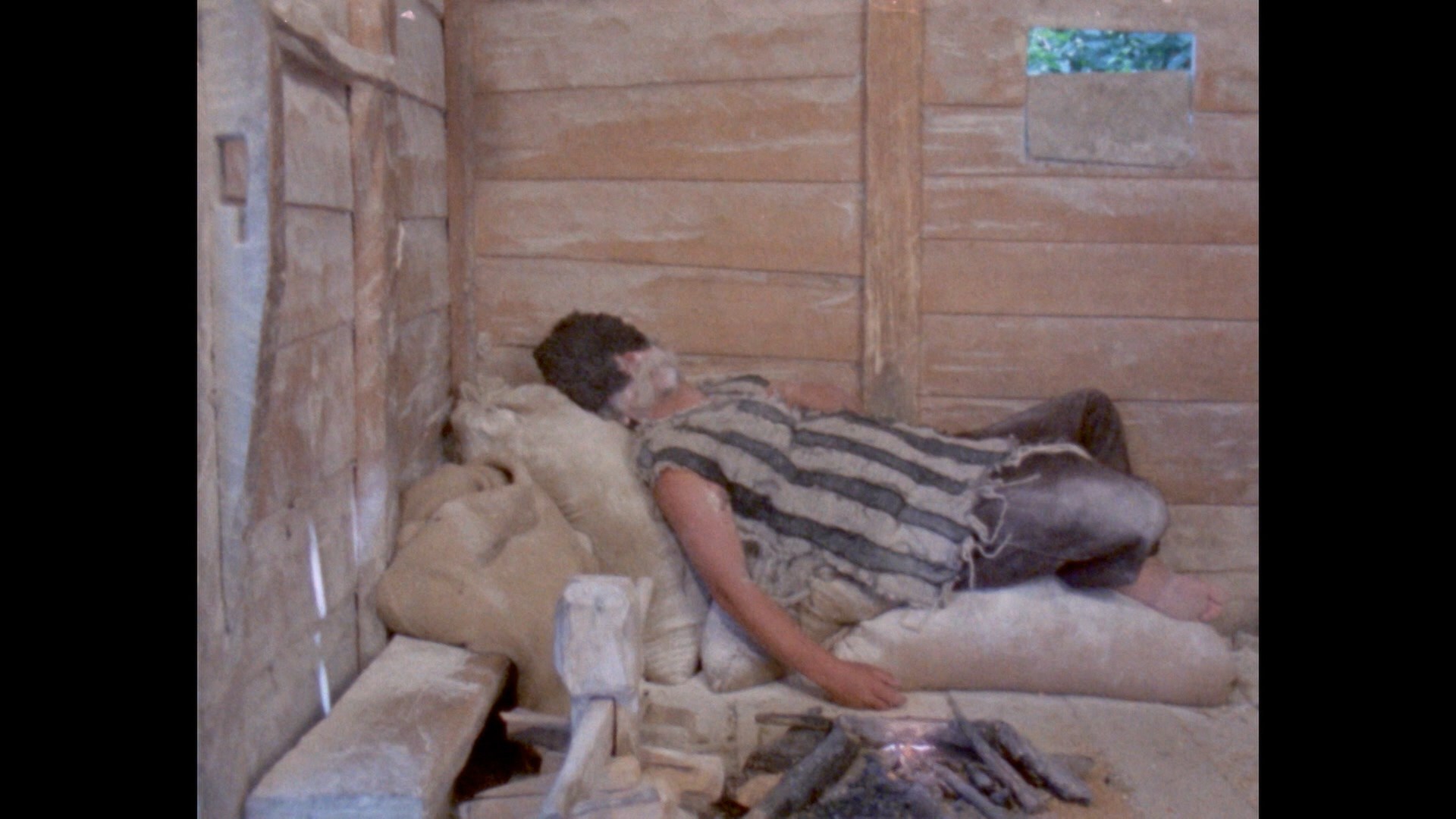
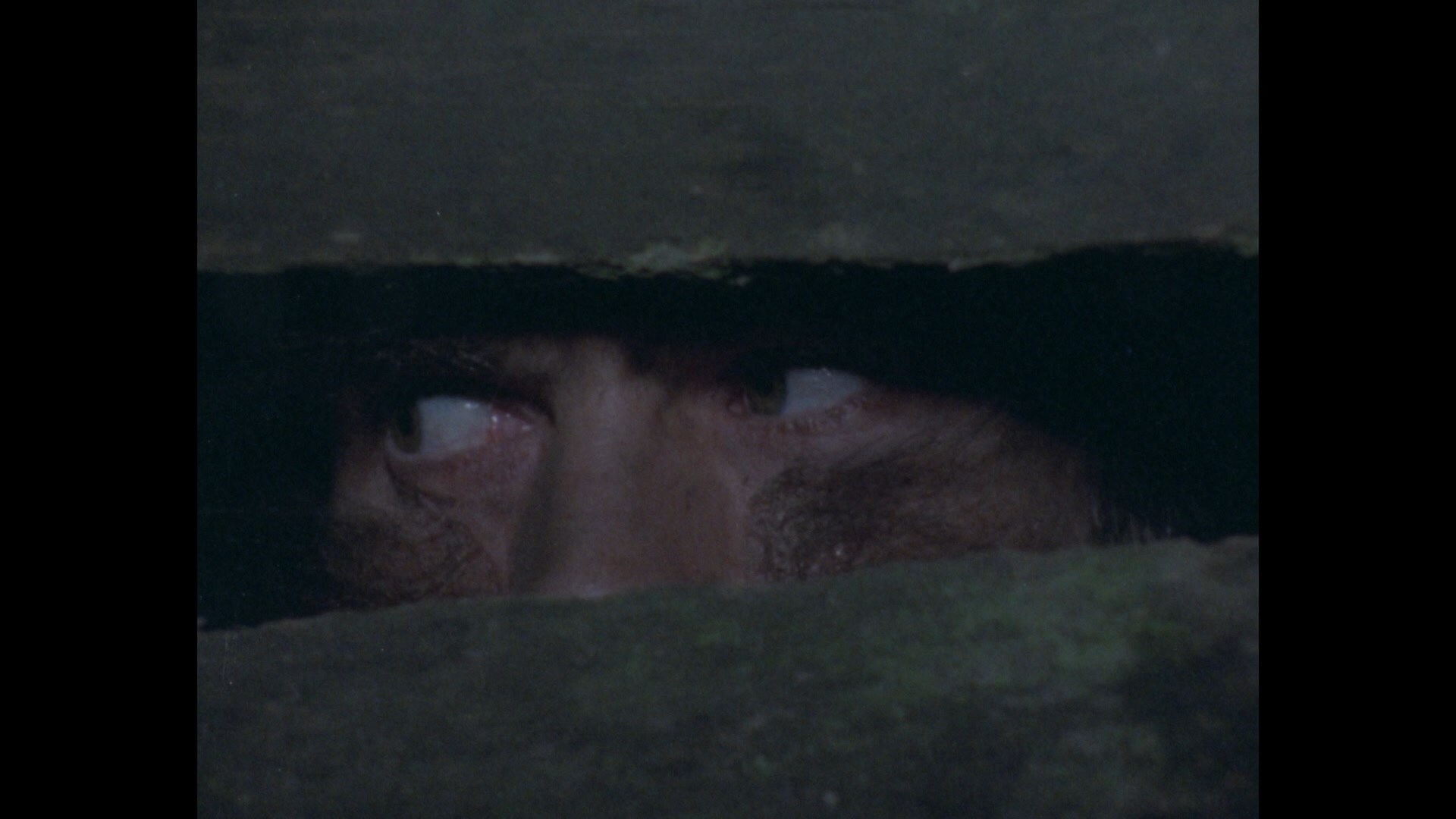
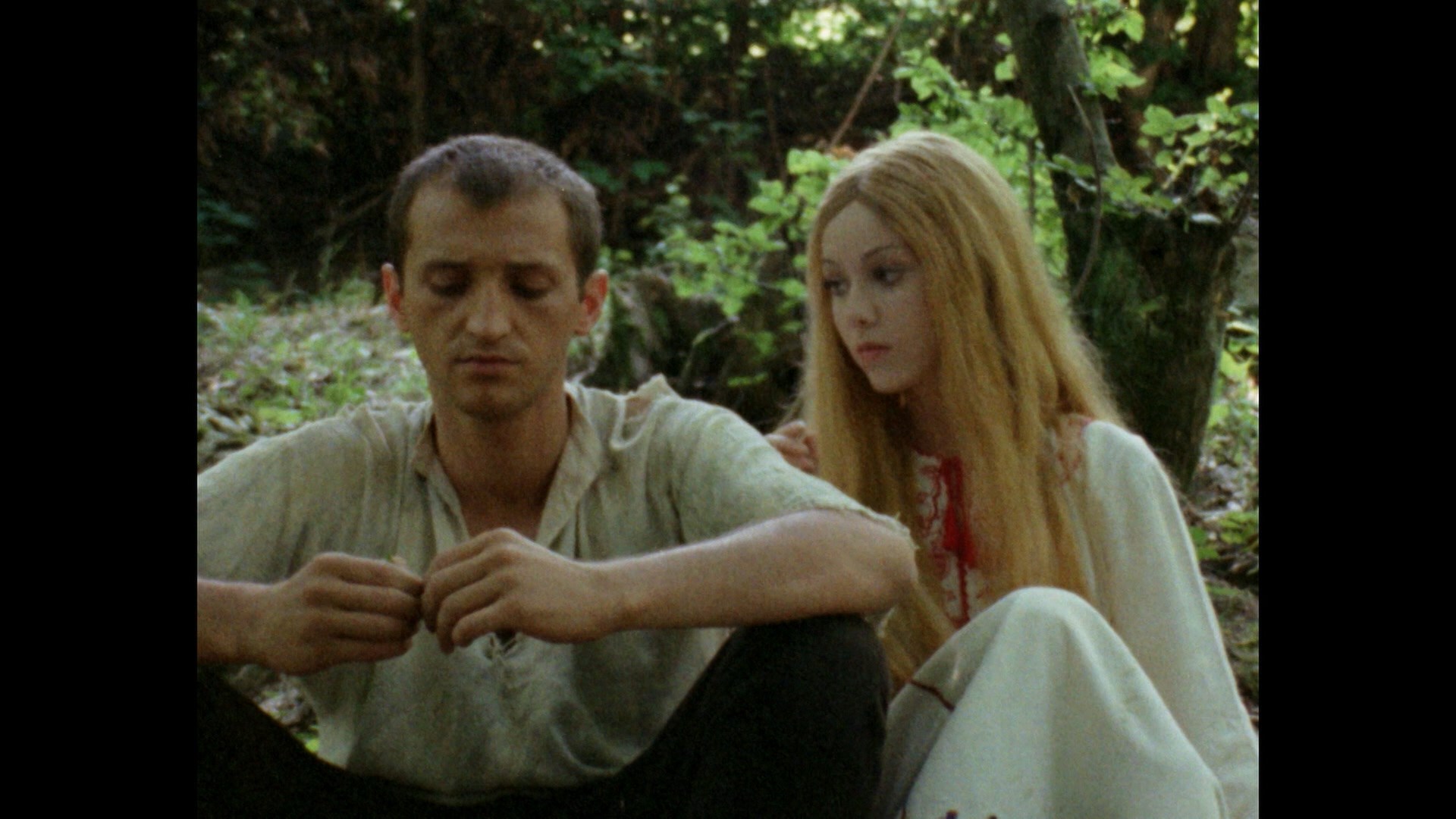
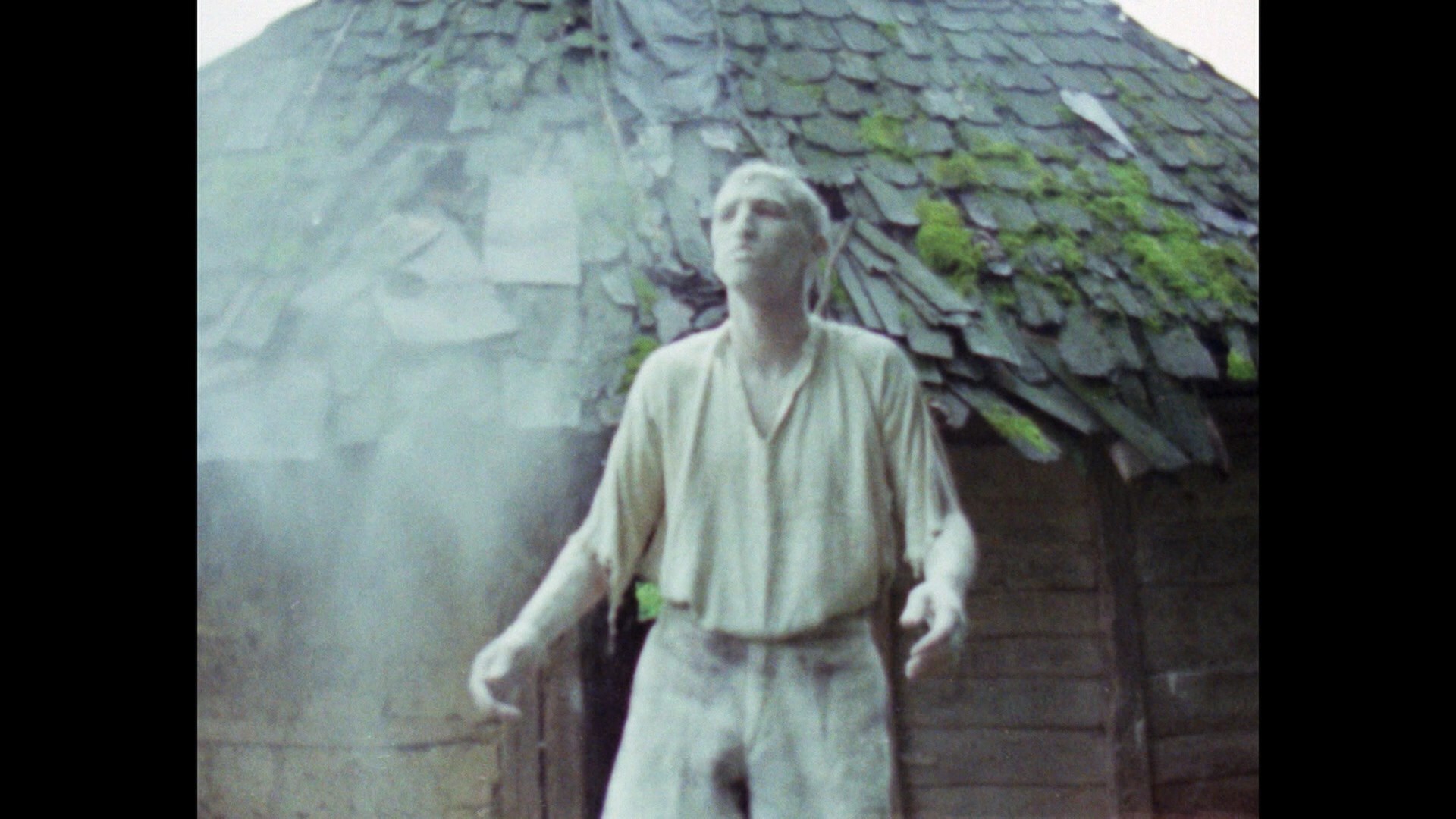
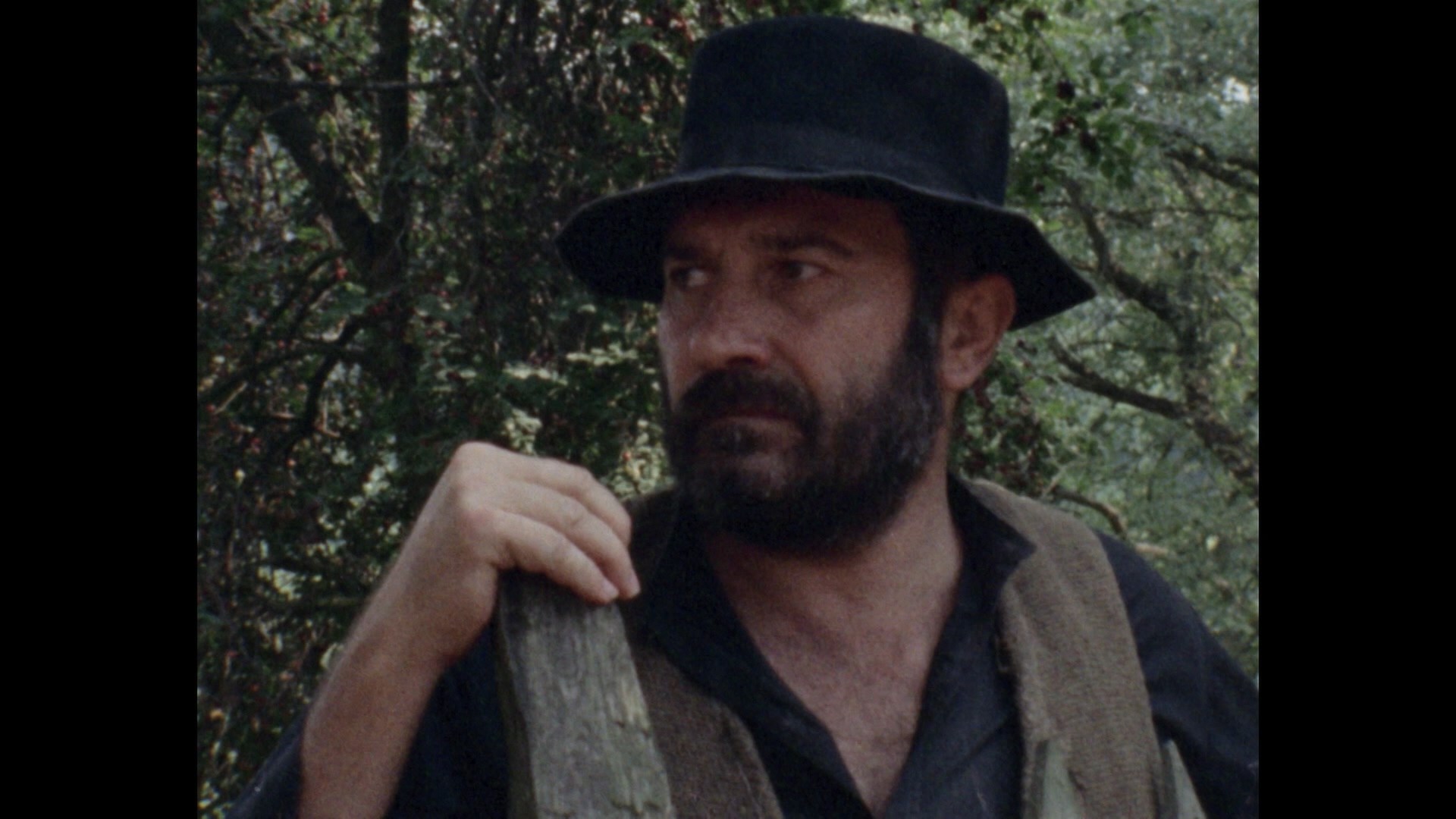
Ostalgica (Blu-ray)
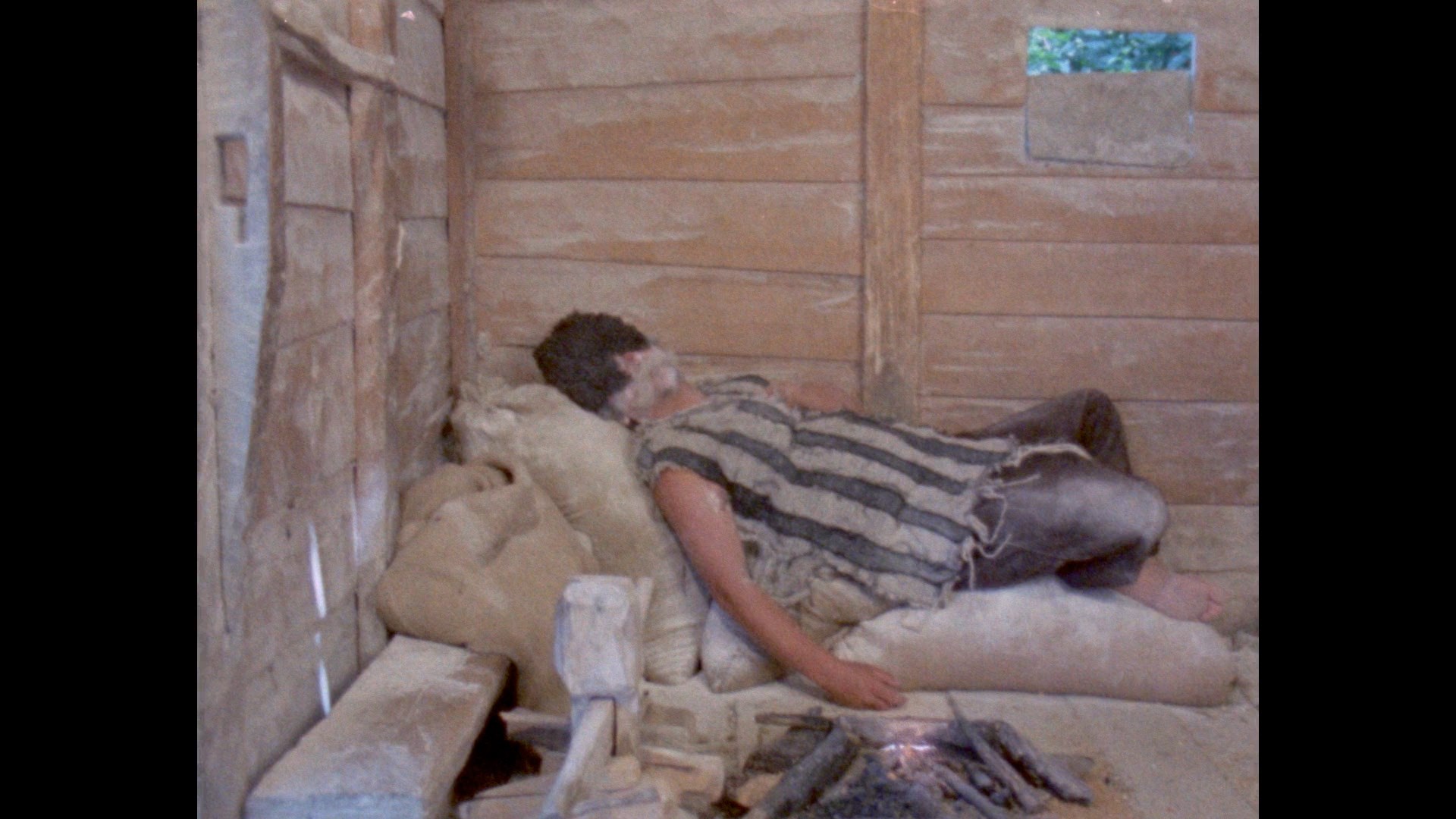
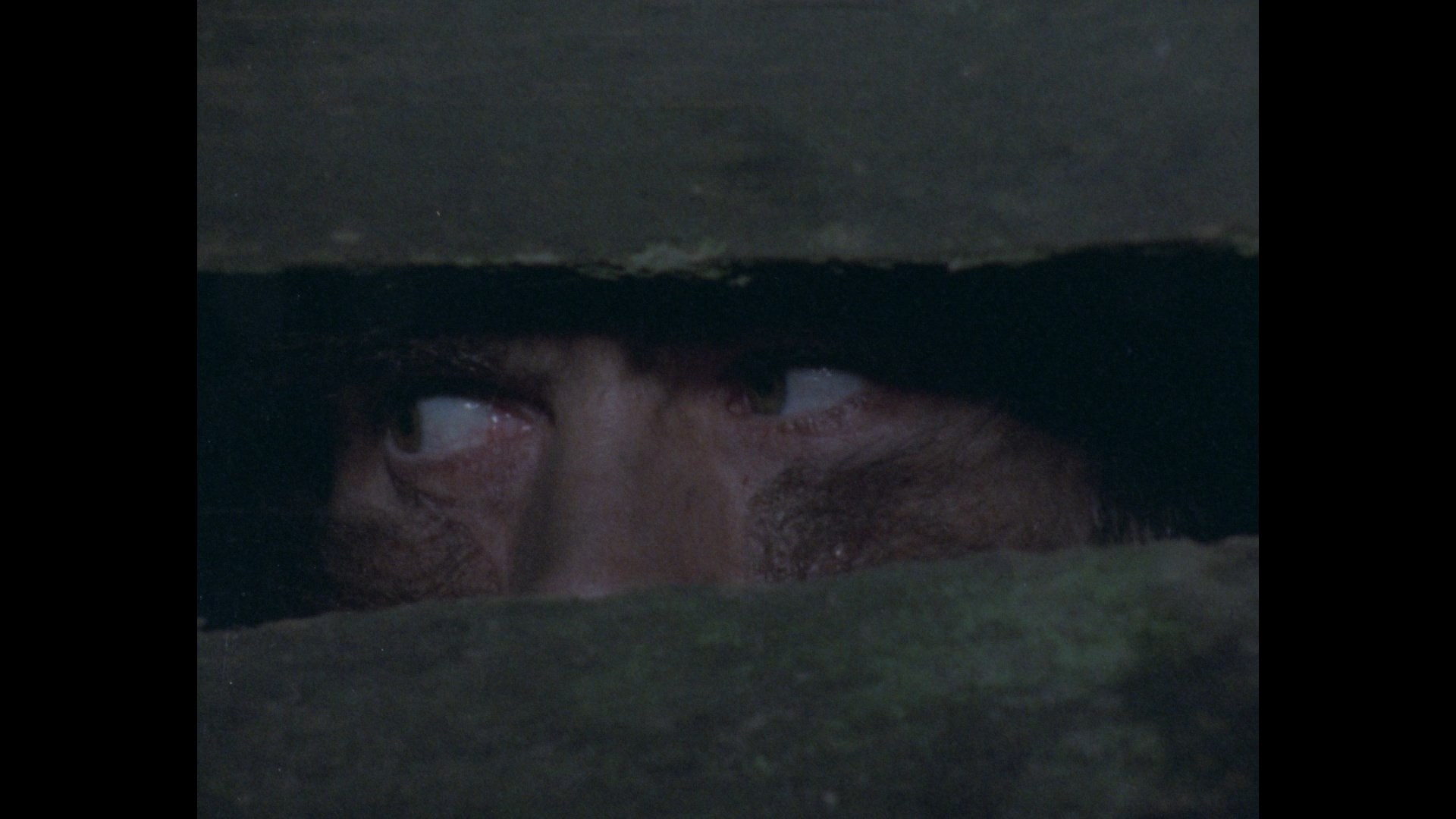
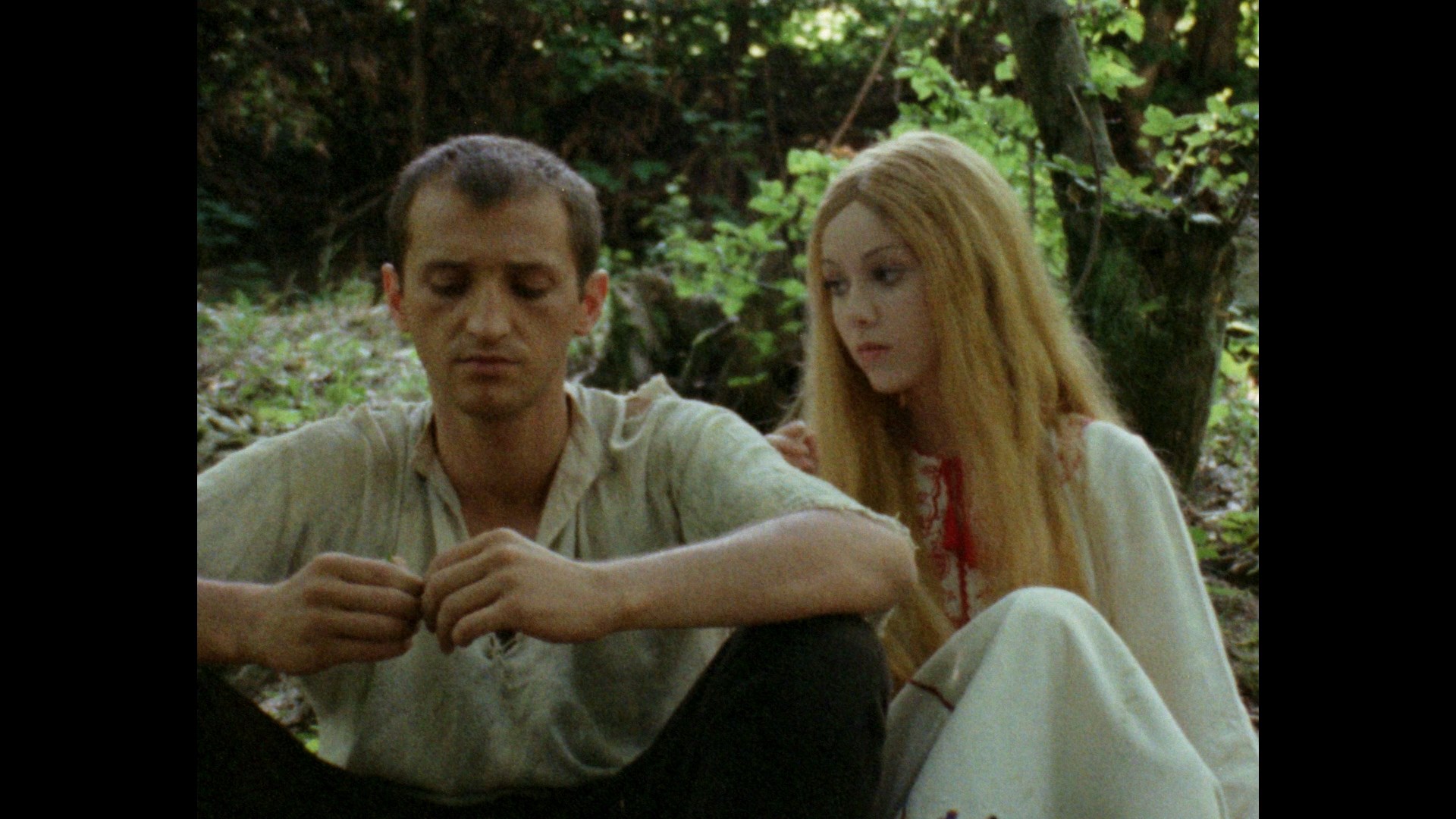
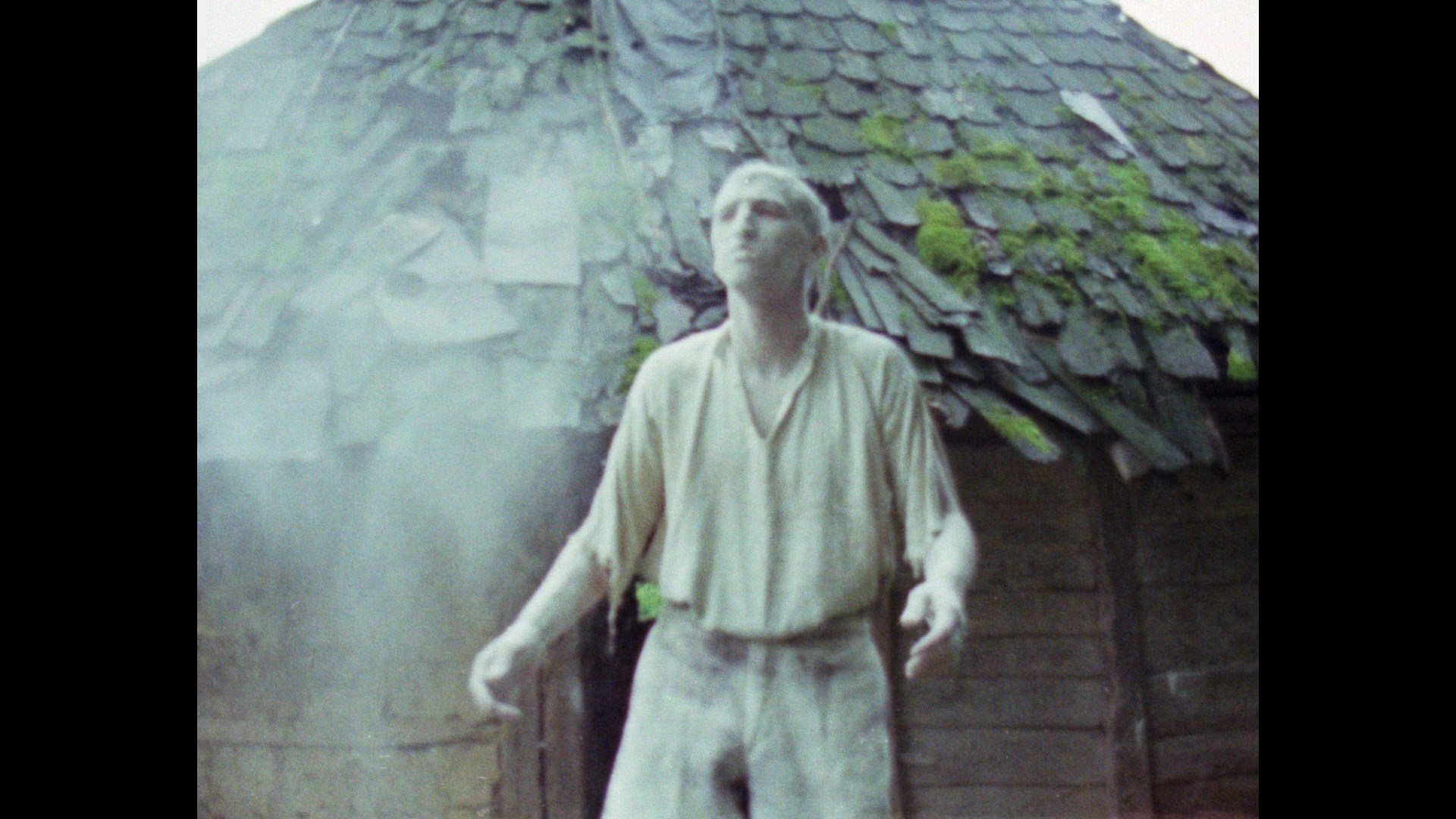
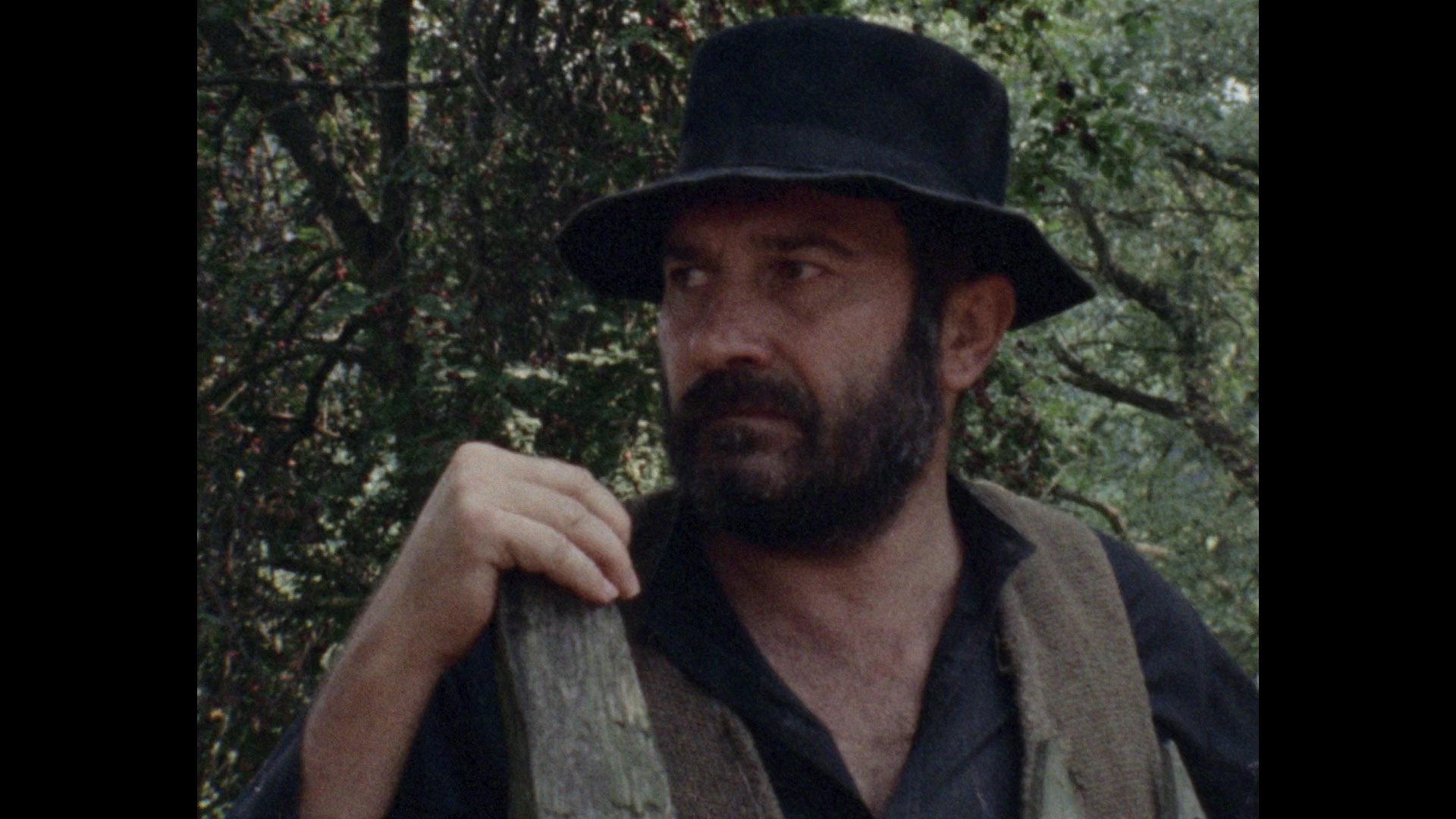
One 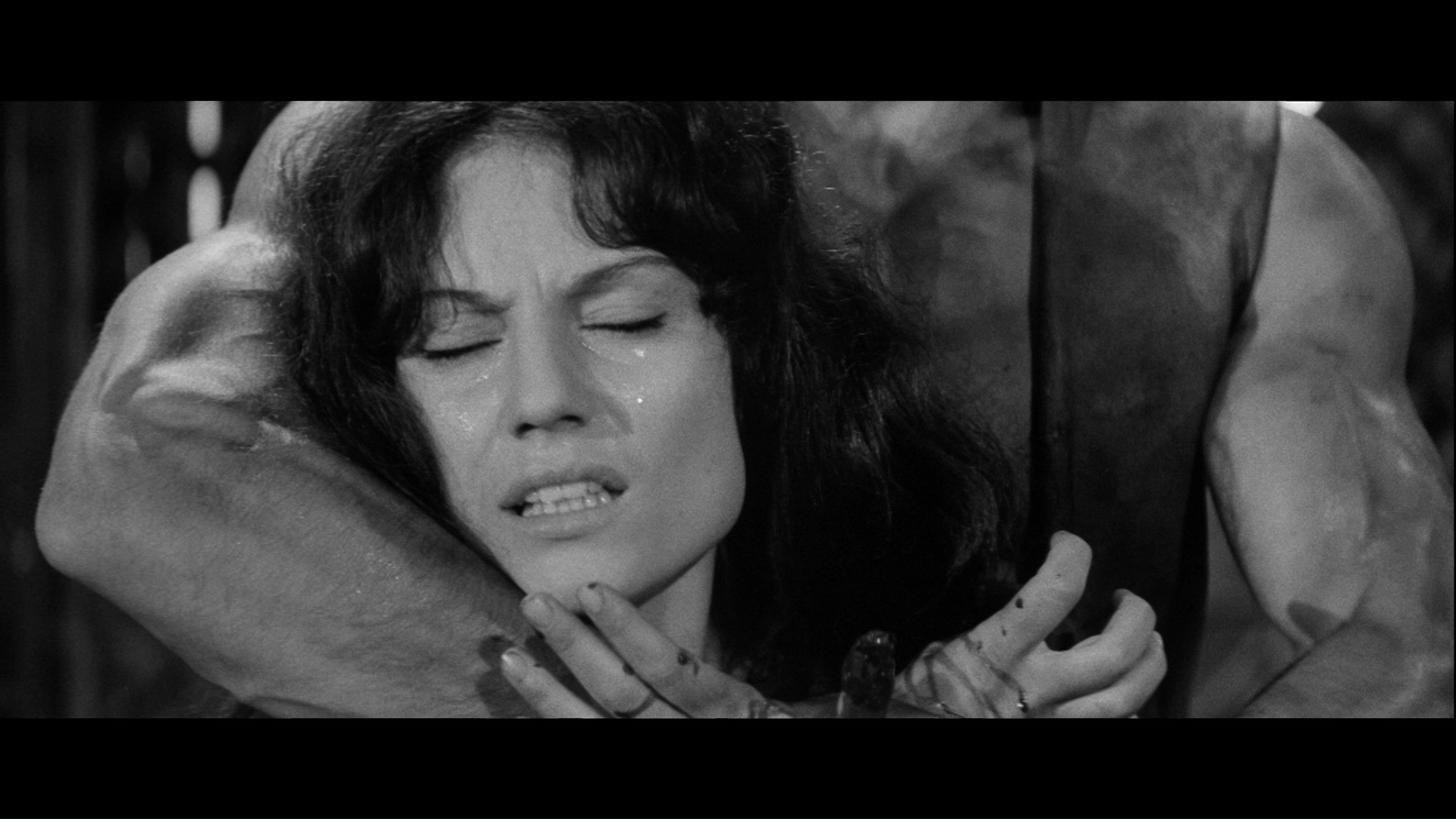 of the more notorious
of the more notorious 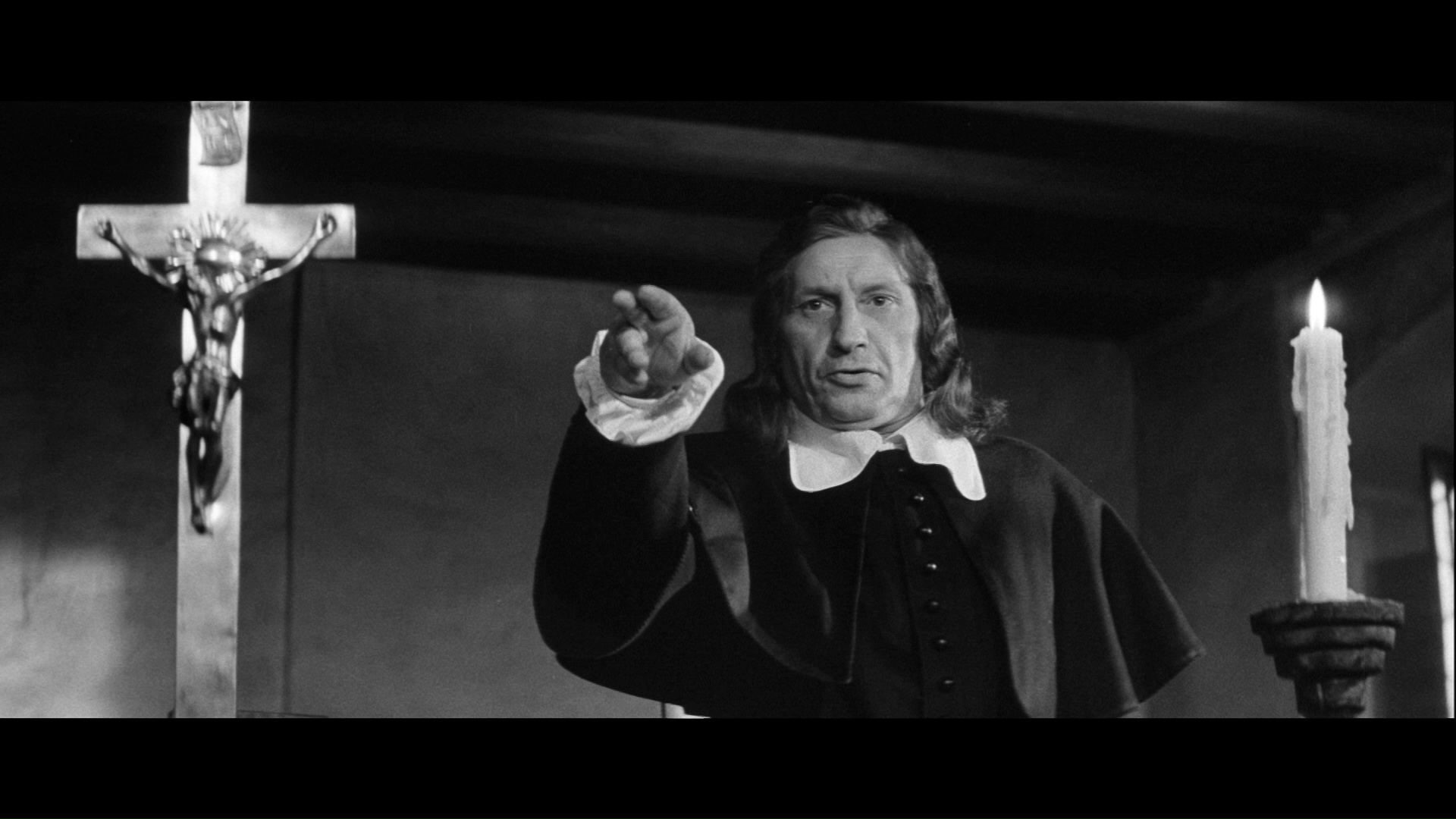 Czech films made in the wake of the Prague Spring, disc four's Witchhammer (also known as Witch's Hammer) opened during a spate of European films about witch persecution ranging from the blistering masterpiece Witchfinder General to the exploitation favorite, Mark of the Devil. Anyone expecting more of the same here will be caught off guard to find a dark political allegory more in keeping with the Arthur Miller classic The Crucible, though you do get staples here like thumb torture, piercing of body moles, burnings at the stake, and a surprising amount of nudity. This is no sleaze film, however; it's an artfully made dramatization of inquisition records and would play well as a sobering double feature with Ken Russell's The Devils.
Czech films made in the wake of the Prague Spring, disc four's Witchhammer (also known as Witch's Hammer) opened during a spate of European films about witch persecution ranging from the blistering masterpiece Witchfinder General to the exploitation favorite, Mark of the Devil. Anyone expecting more of the same here will be caught off guard to find a dark political allegory more in keeping with the Arthur Miller classic The Crucible, though you do get staples here like thumb torture, piercing of body moles, burnings at the stake, and a surprising amount of nudity. This is no sleaze film, however; it's an artfully made dramatization of inquisition records and would play well as a sobering double feature with Ken Russell's The Devils.
In 1670s Moravia, an elderly impoverished woman is spied trying to smuggle a communion wafer out during a church service rather than consuming it at the altar. Both the clergy and aristocracy grill her about claims that she was offered a supply of peas to bring the wafter out to the local female herbalist as a way to replenish a non-milking cow, which sets off a rapidly escalating witch trial at the hands of inquisitor Boblig von Edelstadt (Smeral) and his infamous book, Malleus Maleficarum 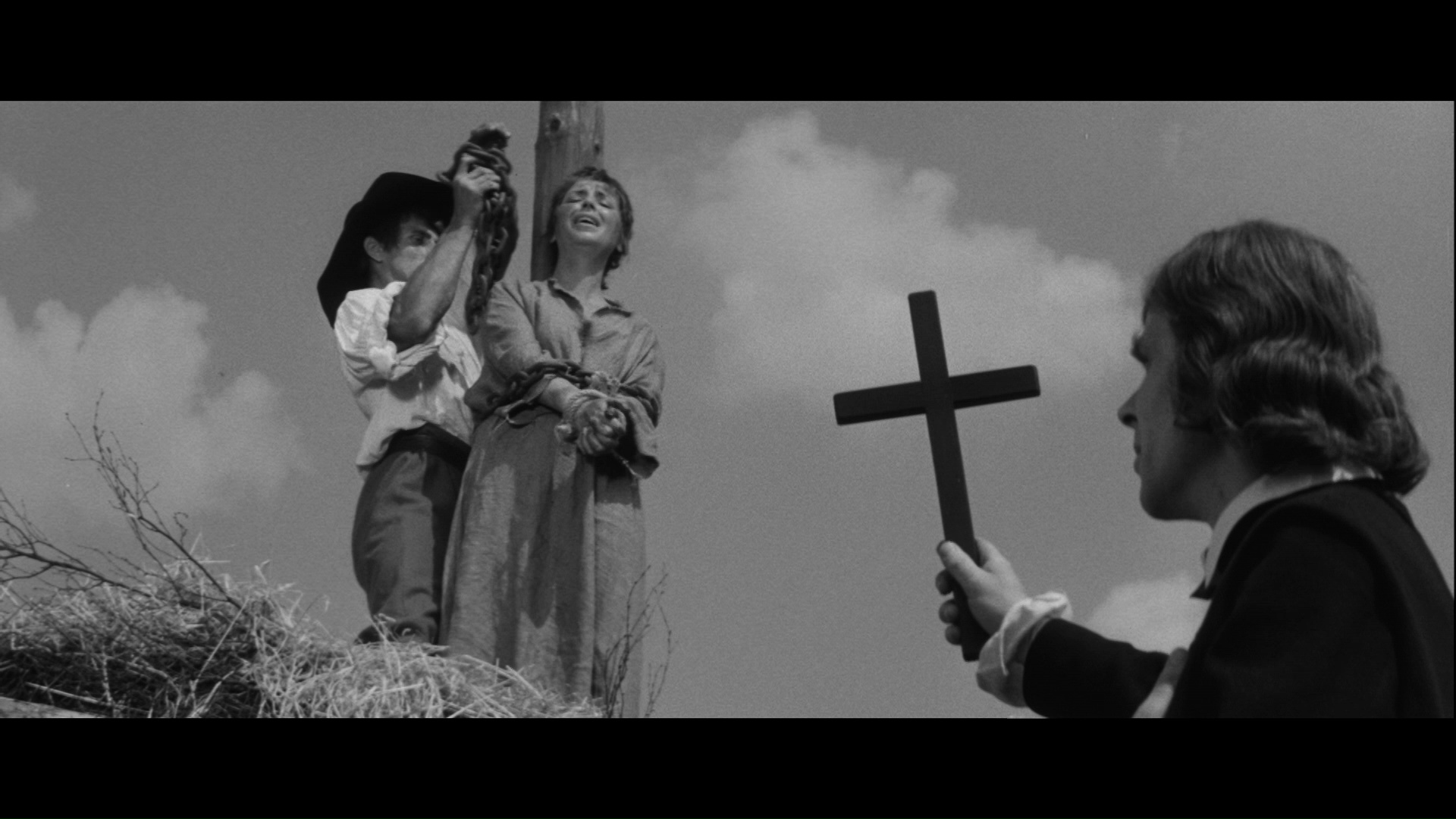 (or the "Witchhammer"). Local priest Lautner (Romancik) comes to criticize these tactics and finds himself in the cross-hairs of Boblig as the village hysteria continues to
(or the "Witchhammer"). Local priest Lautner (Romancik) comes to criticize these tactics and finds himself in the cross-hairs of Boblig as the village hysteria continues to  escalate against multiple women in the area.
escalate against multiple women in the area.
Beautifully lensed in scope and highly provocative in its approach, Witchhammer grabs your attention right away by intercutting sinister shots of a hooded man uttering hateful, misogynist religious diatribes with the female population enjoying a warm, friendly public bath, which is soon mitigated by their suffocating attendance at male-dominated church. It's a powerful statement that continues to run through the rest of the film, with the lower classes and especially women kept under the thumb of those in power with little recourse. The film's much-noted metaphorical value as a statement against the oppressive Soviet occupation still holds water, of course, but it's the tension between genders here that really gives the film its fire with a powerful interrogation scene in the second half standing out in particular for its depiction of a woman holding her ground under extremely tortuous circumstances.
Despite its pedigree, this film wasn't terribly well served by the American non-anamorphic DVD from Facets, with burned-in English subtitles tucked in the lower letterbox bar. Much, much better is the 2017 UK version from Second Run, issued as separate Blu-ray and DVD editions. The new HD transfer from the Czech National Film Archive hasn't undergone an immaculate restoration (you can see some flecks and specks here and there, plus one-frame splice marks at the top of most of the edits), but it really looks gorgeous with far more depth and detail than past video versions even began to convey. The LPCM 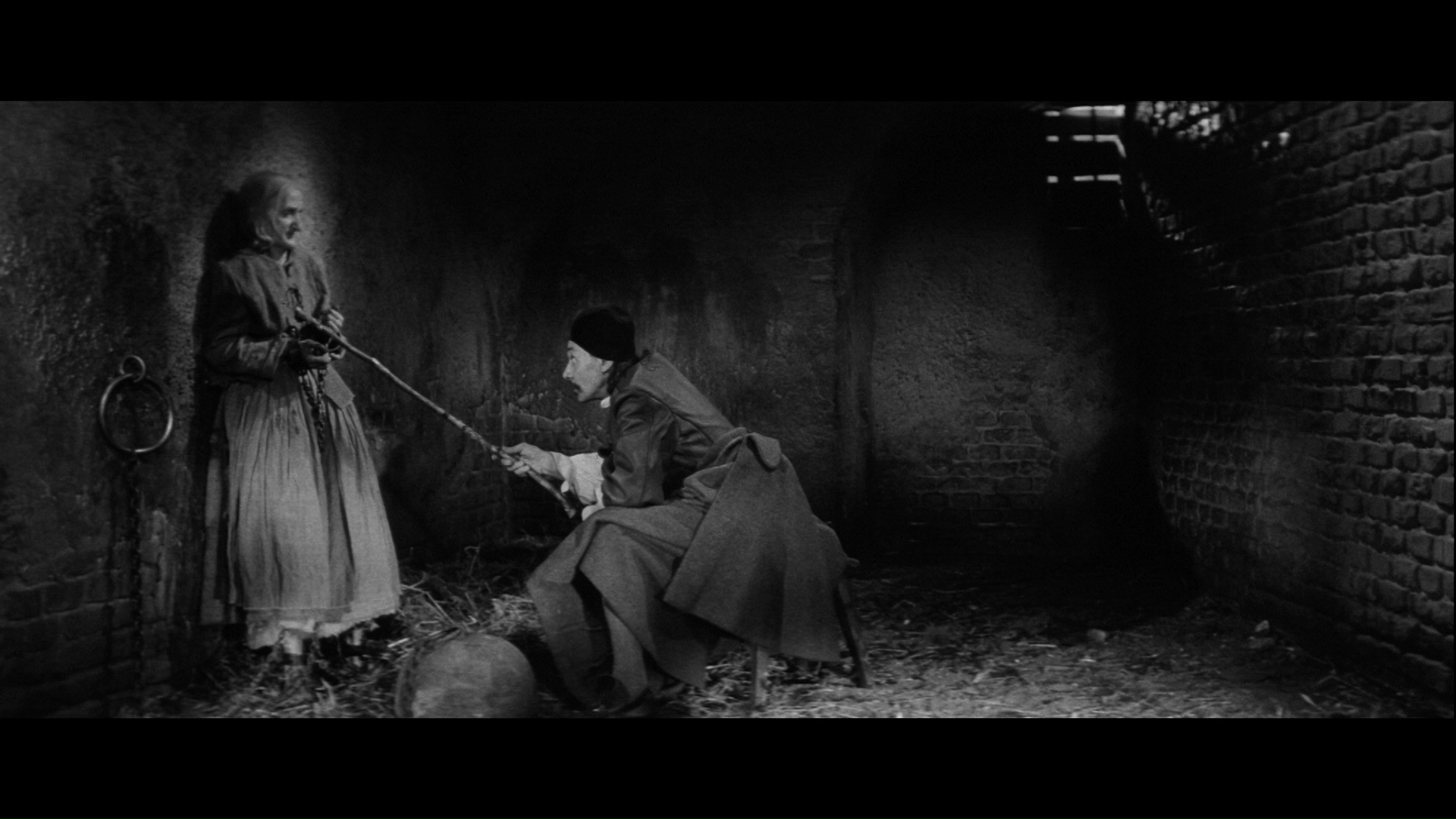 Czech mono track (with optional English subtitles) also
Czech mono track (with optional English subtitles) also 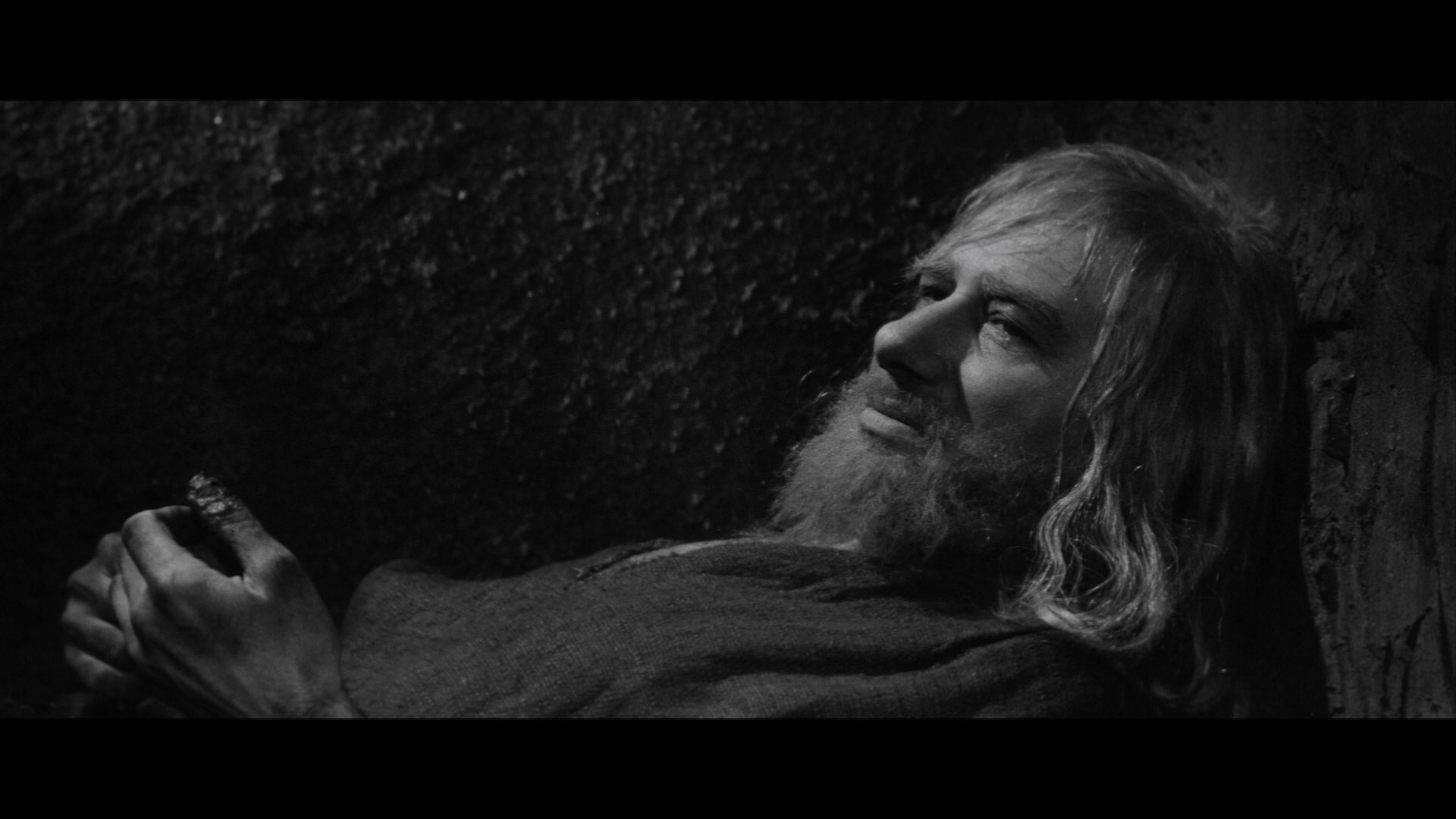 sounds excellent.
sounds excellent.
The big video extra here is the solid and fascinating "The Womb of Woman Is the Gateway to Hell" (22m21s), a dissection of the film by Kat Ellinger produced and edited by Michael Brooke. The focus here alternates between Vávra's career (which was largely seen as towing the party line before this film became perceived as a harsh critique of the current political regime) and placement of the film in context with other pagan and witch persecution films ranging from Dreyer's Day of Wrath and Tarkovsky's Andrei Rublev to the more infamous late '60s and early '70s films, especially Witchfinder General. Particularly interesting is the segment on the film's female co-writer, Ester Krumbachová, whose work on such other films as Daisies and Valerie and Her Week of Wonders helps draw some tantalizing connections. Also included is an early 1931 experimental short by Vávra, "The Light Penetrates the Dark" (4m46s), and Samm Deighan contributes a lengthy, dense liner notes essay about the historical influences, the source novel by Václav Kaplický, and its relationship to other films themed around witchcraft and religious persecution. The Severin release features the Ellinger and Brooke video essay but also adds an audio commentary with Czech film historian and curator Irena Kovarova (who covers the local religious customs, the use of scope, her own intro to the film in the '90s, and the director's background), plus a 62-minute Projection Booth podcast episode devoted to the film with Mike White, Samm Deighan, and Rahne Alexander enthusing about Czech cinema, the connections between persecution of women and witch hunting media, and the somewhat false expectations set up by the title.
Sharing space on the same disc, the 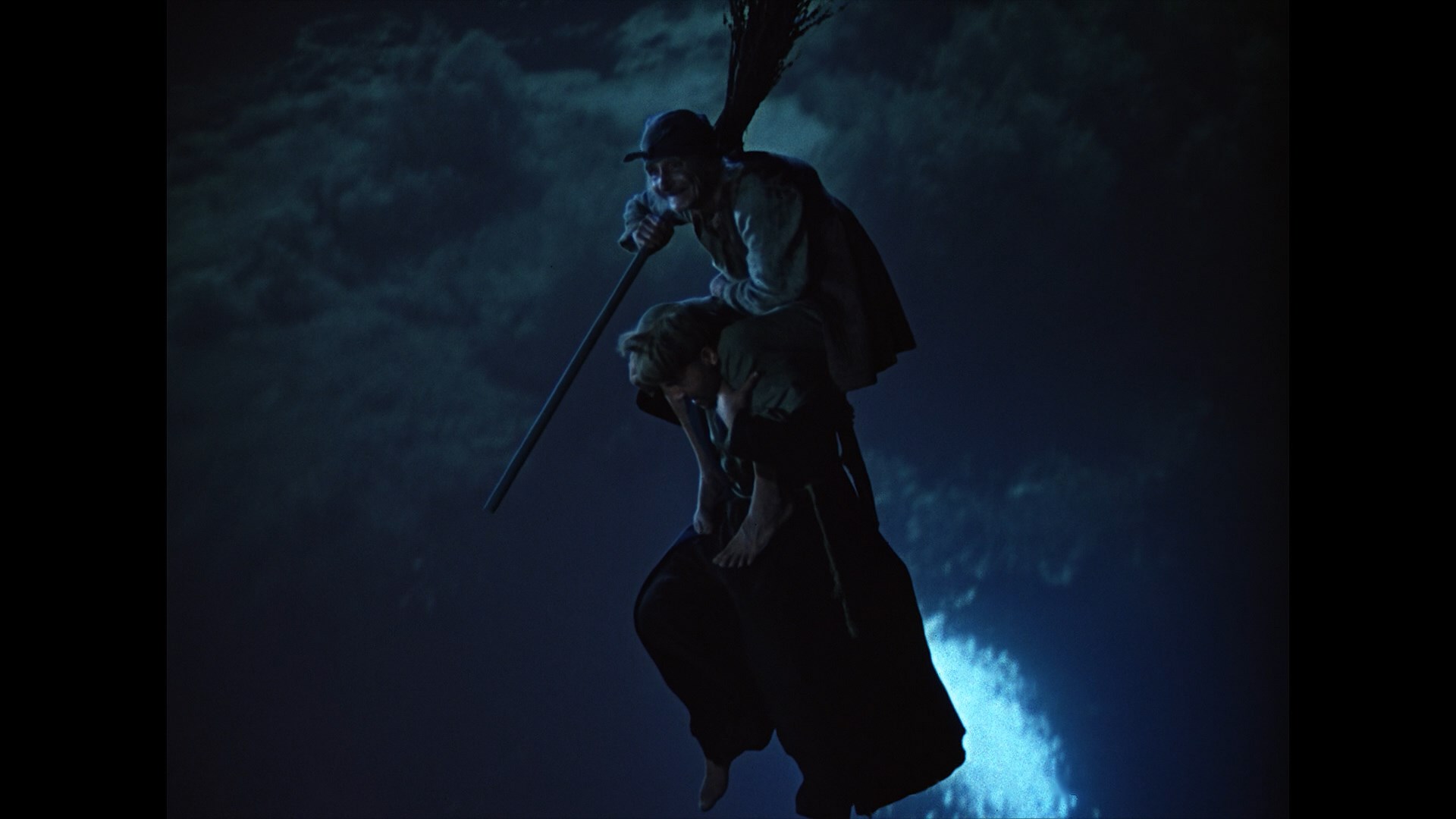
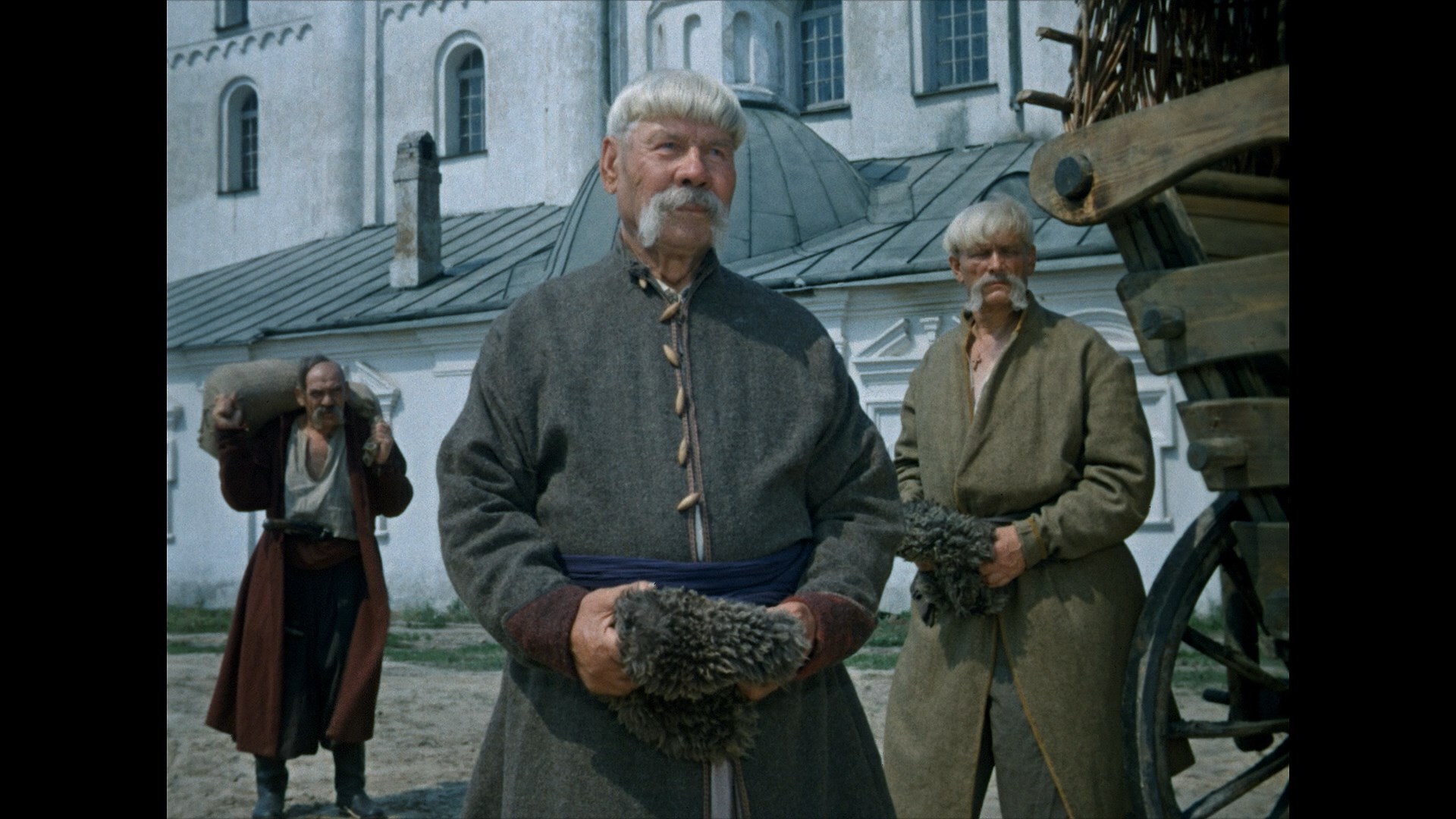 unique, haunting fusion of provincial fantasy and full-blooded horror of Viy has won over more than a handful admirers in the West-- even without acceptable English language versions available for decades, thanks to its striking special effects sequences engineered by the great Aleksandr Ptushko (The Day the Earth Froze). His famous fairy tale aesthetics come into much darker play here, as he tackles the fantastic fiends of Nikolai Gogol's popular short story, "The Vij" (adapted much more loosely in Mario Bava's Black Sunday).
unique, haunting fusion of provincial fantasy and full-blooded horror of Viy has won over more than a handful admirers in the West-- even without acceptable English language versions available for decades, thanks to its striking special effects sequences engineered by the great Aleksandr Ptushko (The Day the Earth Froze). His famous fairy tale aesthetics come into much darker play here, as he tackles the fantastic fiends of Nikolai Gogol's popular short story, "The Vij" (adapted much more loosely in Mario Bava's Black Sunday).
The simple storyline concerns a young, cocky lad named Khoma Brut (Leonid Kuralev), a seminary student in training for the priesthood, who loses his way into a dark forest and separates from his companions on the road. There he encounters a witch who carries him aloft for a dark moonlit adventure from which he barely escapes with his life. At a nearby village, the novice is asked by the locals to stay in their eerie wooden church for three nights to recite holy verses over the body of the wealthiest citizen's daughter (Natalya Varley); unfortunately, as he discovers while trapped for the first night in the church, the dead girl is also the witch... who rises from her coffin, stopped only by a holy circle of chalk drawn around the frightened seminarian. The villagers refuse to believe him the next day and force him to return for two more nights of unbridled horror, during which the sorceress unleashes all of the powers of the underworld to break the magic circle.
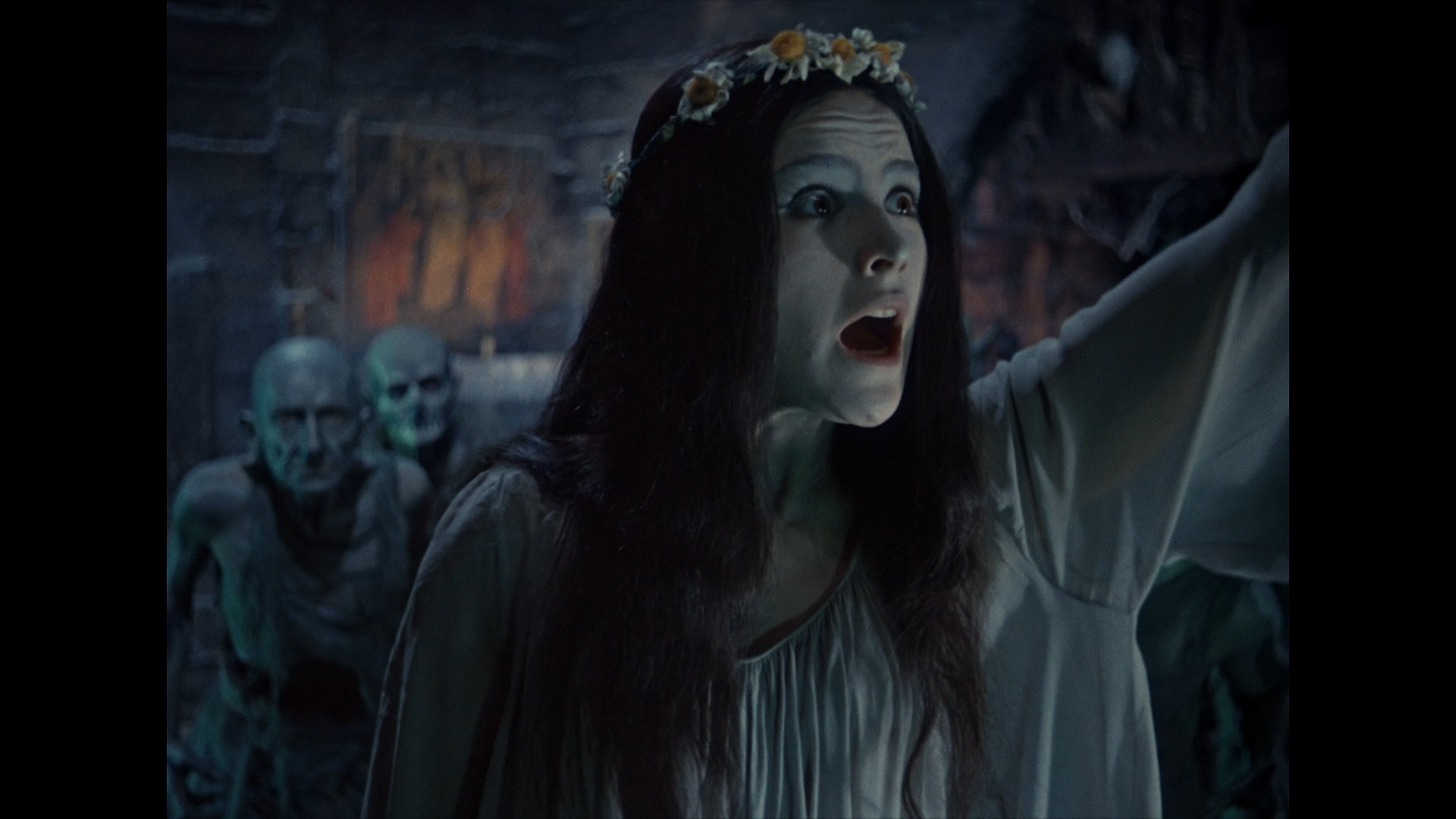 With its compact running time, this film never overstays its welcome and wisely leaves the viewer wanting more.
With its compact running time, this film never overstays its welcome and wisely leaves the viewer wanting more. 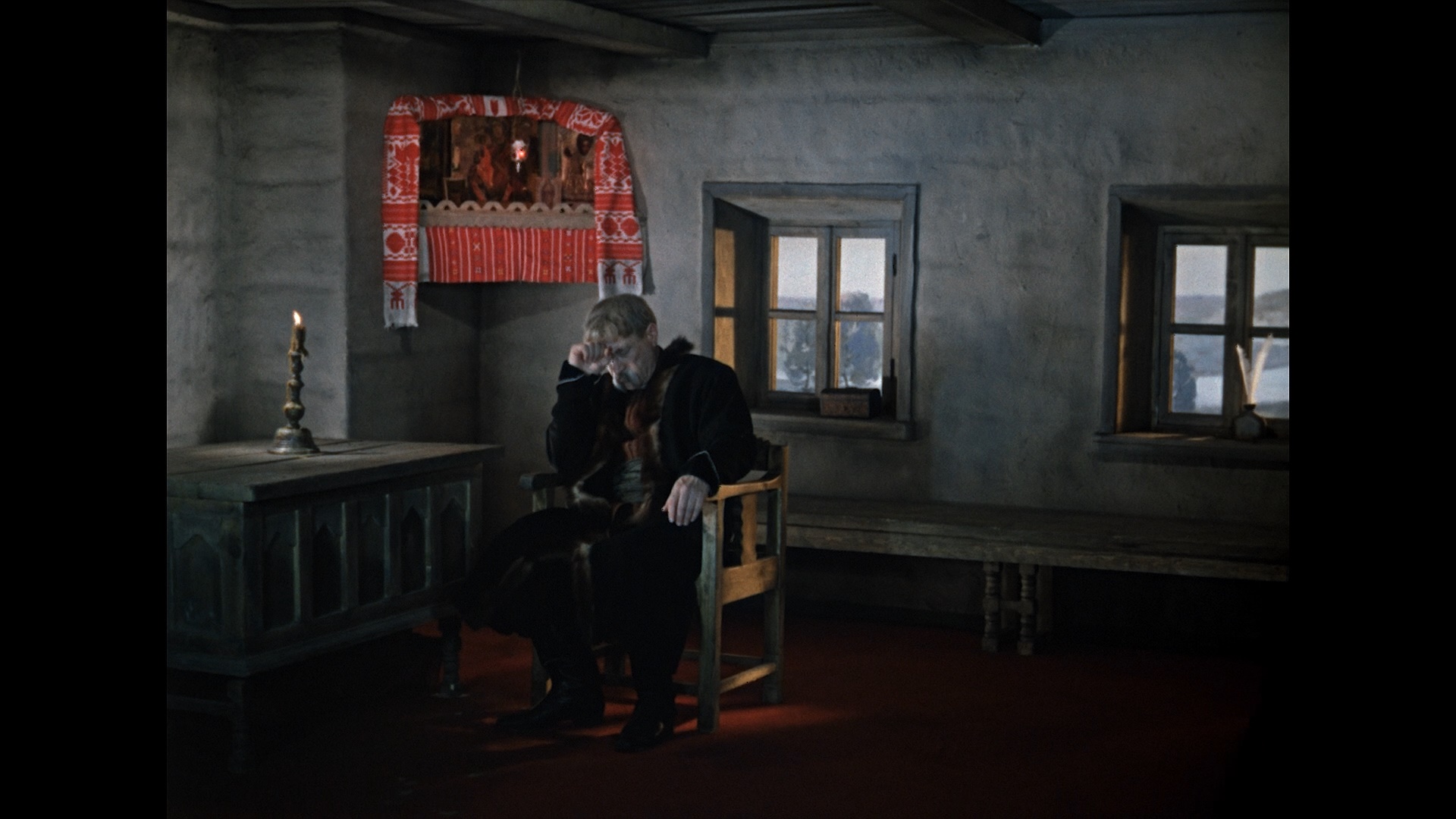 The second and third witch attacks are among Ptushko's most effective work as the witch rides her coffin in circles through the air, monsters pour from the walls, giant hands erupt from the floor, and the lumbering Viy himself makes an appearance for the grand finale. The rest of the film is a skillful example of the balance between wonder and dread, with religion playing a prominent role from the opening moments to the final, ironic closing lines.
The second and third witch attacks are among Ptushko's most effective work as the witch rides her coffin in circles through the air, monsters pour from the walls, giant hands erupt from the floor, and the lumbering Viy himself makes an appearance for the grand finale. The rest of the film is a skillful example of the balance between wonder and dread, with religion playing a prominent role from the opening moments to the final, ironic closing lines.
Thanks to Japanese laserdisc, Viy (or The Vij, depending on the print) became something of a gray market video staple, but the Ruscico DVD from 2001 (imported for a while in a limited edition from Image Entertainment in the U.S.) brought it to a much wider audience thanks to a restored video presentation as well as multiple language options including soundtracks in Russian, English, and French (all remixed into 5.1, with passable if unnecessary results) and subtitles in English, French, Dutch, Japanese, German, Russian, and so on. The atmospheric animated menus begin in Russian but can be changed into English by clicking to the left.
The package is decked out with a nice array of extras including the theatrical trailer (in English, oddly enough) and a half hour documentary (in Russian with optional subtitles) about Gogol leading the pack, followed by three marvelous silent horror short films: "Satan Exultant" (19m30s), "The Queen of Spades" (16m30s), and the jarring "The Portrait" (7m53s), which is nearly worth the price tag by itself.
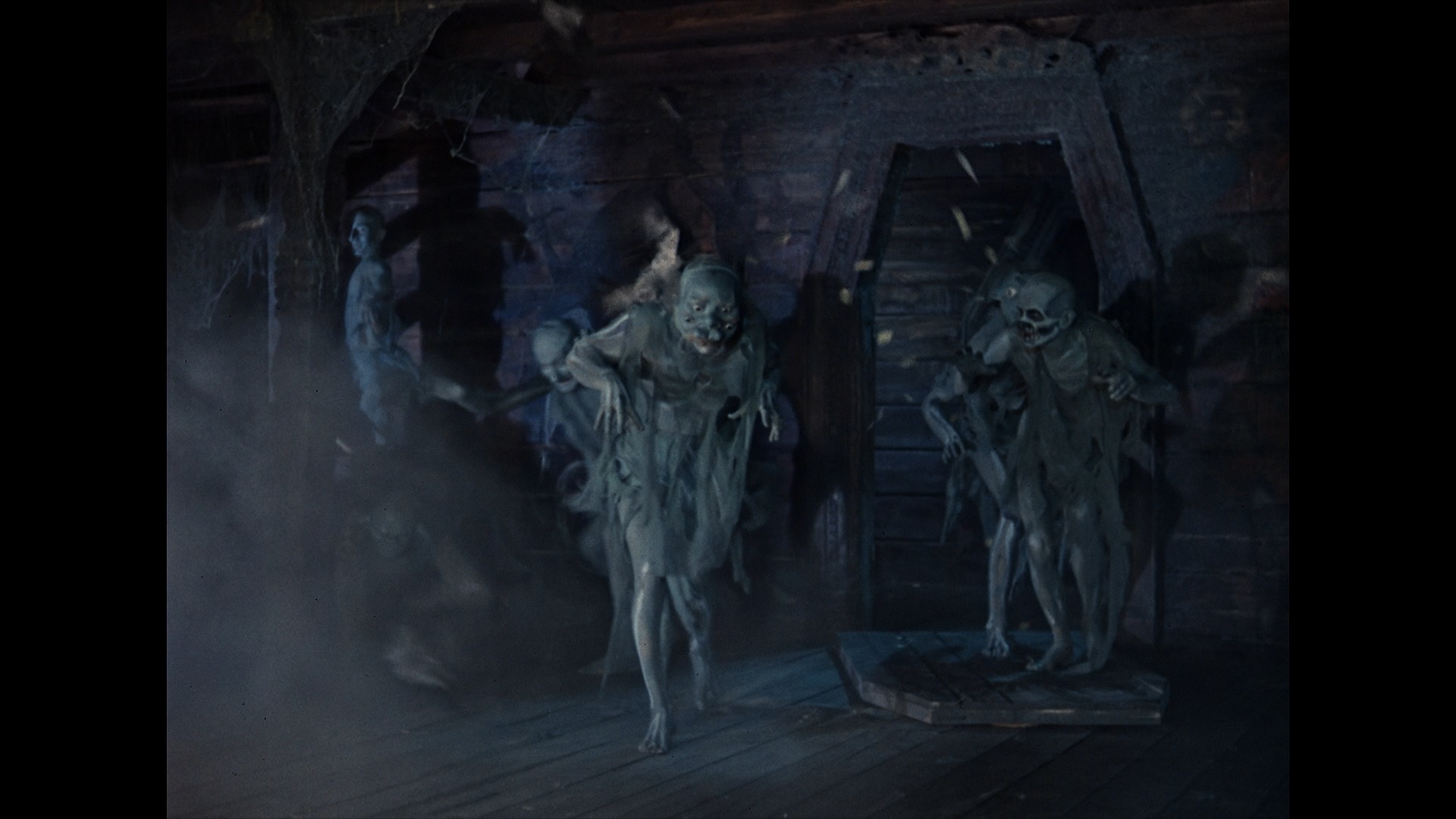 The first Blu-ray edition of this film appeared in Japan in 2016, albeit in Russian with optional Japanese
The first Blu-ray edition of this film appeared in Japan in 2016, albeit in Russian with optional Japanese 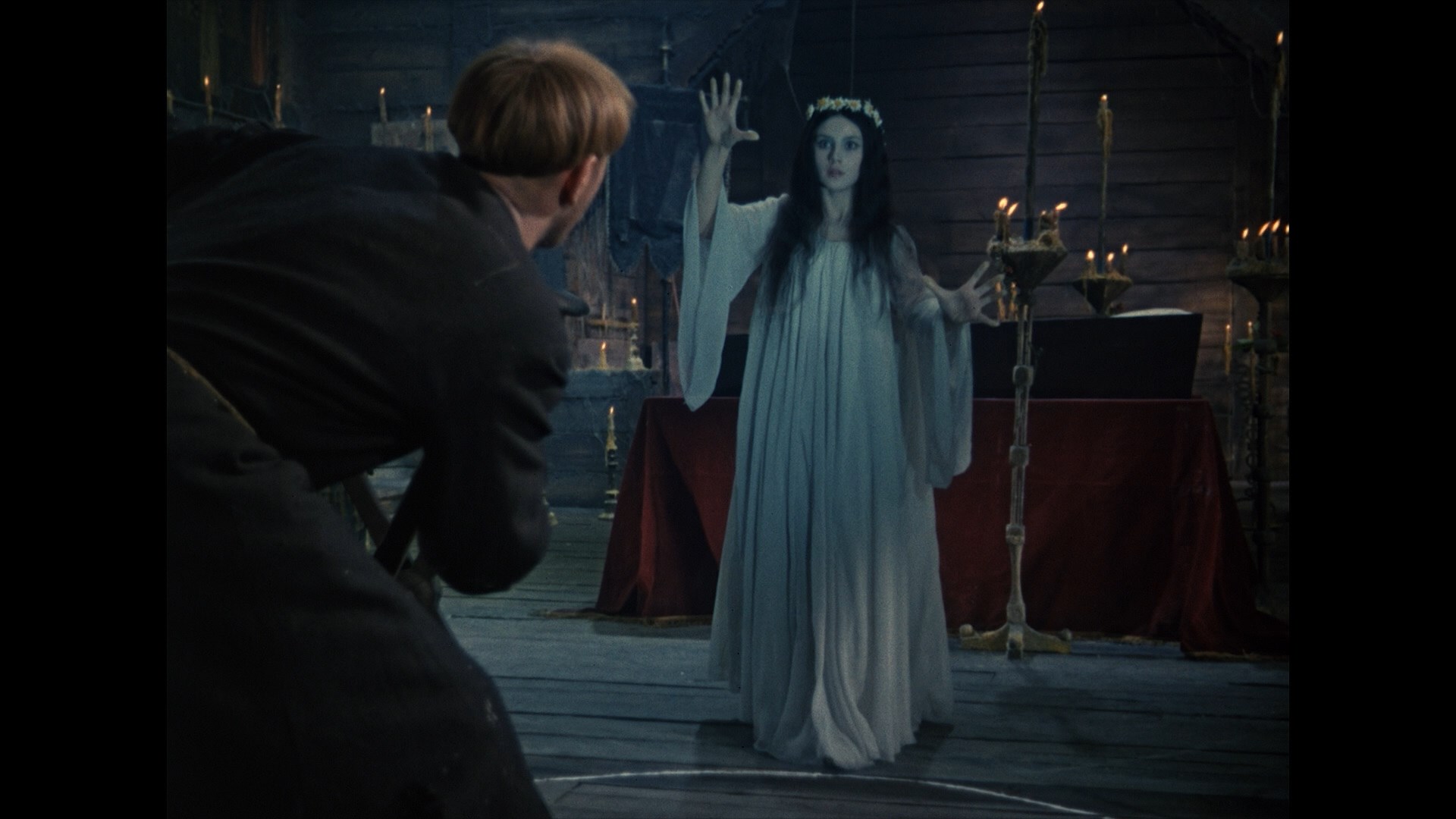 subtitles and no extras. In 2019, Severin Films brought it to the U.S. as separate Blu-ray and DVD editions. The image quality is excellent and reflects the steely, unearthly color scheme nicely with some startling bursts of primary colors where it counts, along with delicate shades of ashy gray and blue throughout. (Given the fact that the earlier DVD was color timed so almost everything appeared to be happening in broad daylight even for the night scenes, presumably the Blu-ray is more accurate.) The Russian and English tracks are included, this time in a more authentic DTS-HD MA mono presentation, both sounding perfectly fine; optional English subtitles are provided (either translated or, for the dub track, SDH). It's also worth noting that the HD transfer runs 76 minutes versus the 72 of the DVD, which came from an uncorrected PAL source and thus ran a bit faster. The three short films have been ported over here along with the trailer, while the new "Viy the Vampire" (22m57s) featured director Richard Stanley (Hardware) delivering a dissertation on the history of vampirism and the Cossack folklore that informed Gogol's story, though the vampire angle only ties in with this witch and demon-themed film in the loosest sense. He also dissects the title in welcome detail, pointing out its status as a respectful term rather than a proper name in the traditional sense, and mentions his own attempt to make a modern Bosnia-set version of the tale that sounds pretty wild. In "From the Woods to the Cosmos" (34m43s), Soviet film historian John Leman Riley takes a broader look at the history of supernatural tales from page to screen including the works of Gogol and early silent efforts through the impact of technology on filmmaking that could depict more ambitious portrayals of everything from monsters to outer space adventures via directors like Alexander Rou. Soon afterward, Eureka issued the film on U.K. Blu-ray, initially as a limited two-disc set (featuring the aforementioned A Holy Place on the second disc) and then as a standard single disc one with extras including a fine audio commentary by Michael Brooke, a new audio essay (15m5s) on Gogol and the source story by Samuel Goff, an archival "Remembering Gogol" (19m6s) newsreel-style doc, the silent shorts, the trailer, and liner notes by Tim Lucas. For the box set, Severin has ported over all of its own extras apart from the Stanley featurette (for reasons that should be obvious to anyone paying attention in the horror community for the past year or so).
subtitles and no extras. In 2019, Severin Films brought it to the U.S. as separate Blu-ray and DVD editions. The image quality is excellent and reflects the steely, unearthly color scheme nicely with some startling bursts of primary colors where it counts, along with delicate shades of ashy gray and blue throughout. (Given the fact that the earlier DVD was color timed so almost everything appeared to be happening in broad daylight even for the night scenes, presumably the Blu-ray is more accurate.) The Russian and English tracks are included, this time in a more authentic DTS-HD MA mono presentation, both sounding perfectly fine; optional English subtitles are provided (either translated or, for the dub track, SDH). It's also worth noting that the HD transfer runs 76 minutes versus the 72 of the DVD, which came from an uncorrected PAL source and thus ran a bit faster. The three short films have been ported over here along with the trailer, while the new "Viy the Vampire" (22m57s) featured director Richard Stanley (Hardware) delivering a dissertation on the history of vampirism and the Cossack folklore that informed Gogol's story, though the vampire angle only ties in with this witch and demon-themed film in the loosest sense. He also dissects the title in welcome detail, pointing out its status as a respectful term rather than a proper name in the traditional sense, and mentions his own attempt to make a modern Bosnia-set version of the tale that sounds pretty wild. In "From the Woods to the Cosmos" (34m43s), Soviet film historian John Leman Riley takes a broader look at the history of supernatural tales from page to screen including the works of Gogol and early silent efforts through the impact of technology on filmmaking that could depict more ambitious portrayals of everything from monsters to outer space adventures via directors like Alexander Rou. Soon afterward, Eureka issued the film on U.K. Blu-ray, initially as a limited two-disc set (featuring the aforementioned A Holy Place on the second disc) and then as a standard single disc one with extras including a fine audio commentary by Michael Brooke, a new audio essay (15m5s) on Gogol and the source story by Samuel Goff, an archival "Remembering Gogol" (19m6s) newsreel-style doc, the silent shorts, the trailer, and liner notes by Tim Lucas. For the box set, Severin has ported over all of its own extras apart from the Stanley featurette (for reasons that should be obvious to anyone paying attention in the horror community for the past year or so).
WITCHHAMMER: Severin (Blu-ray)
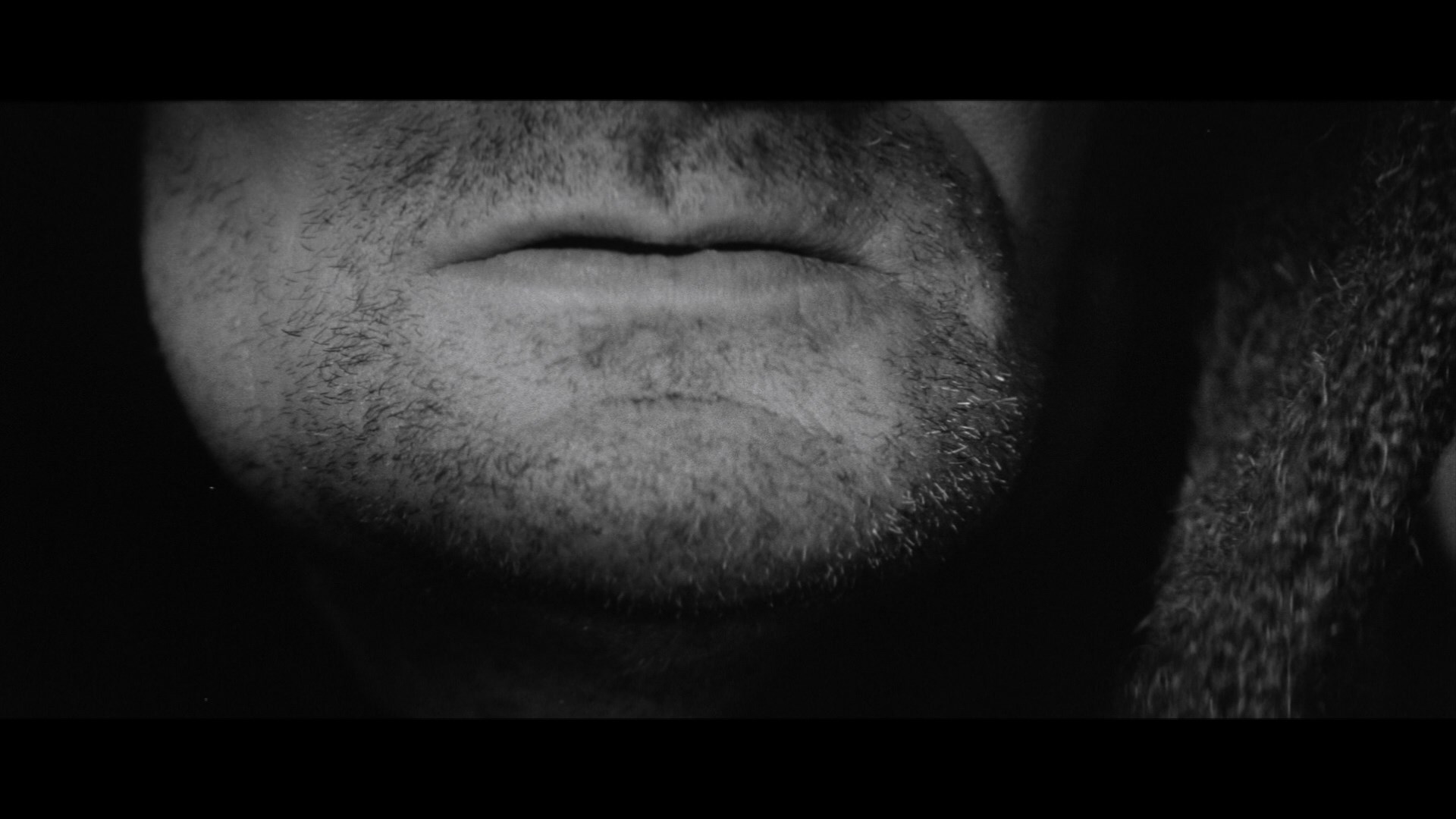
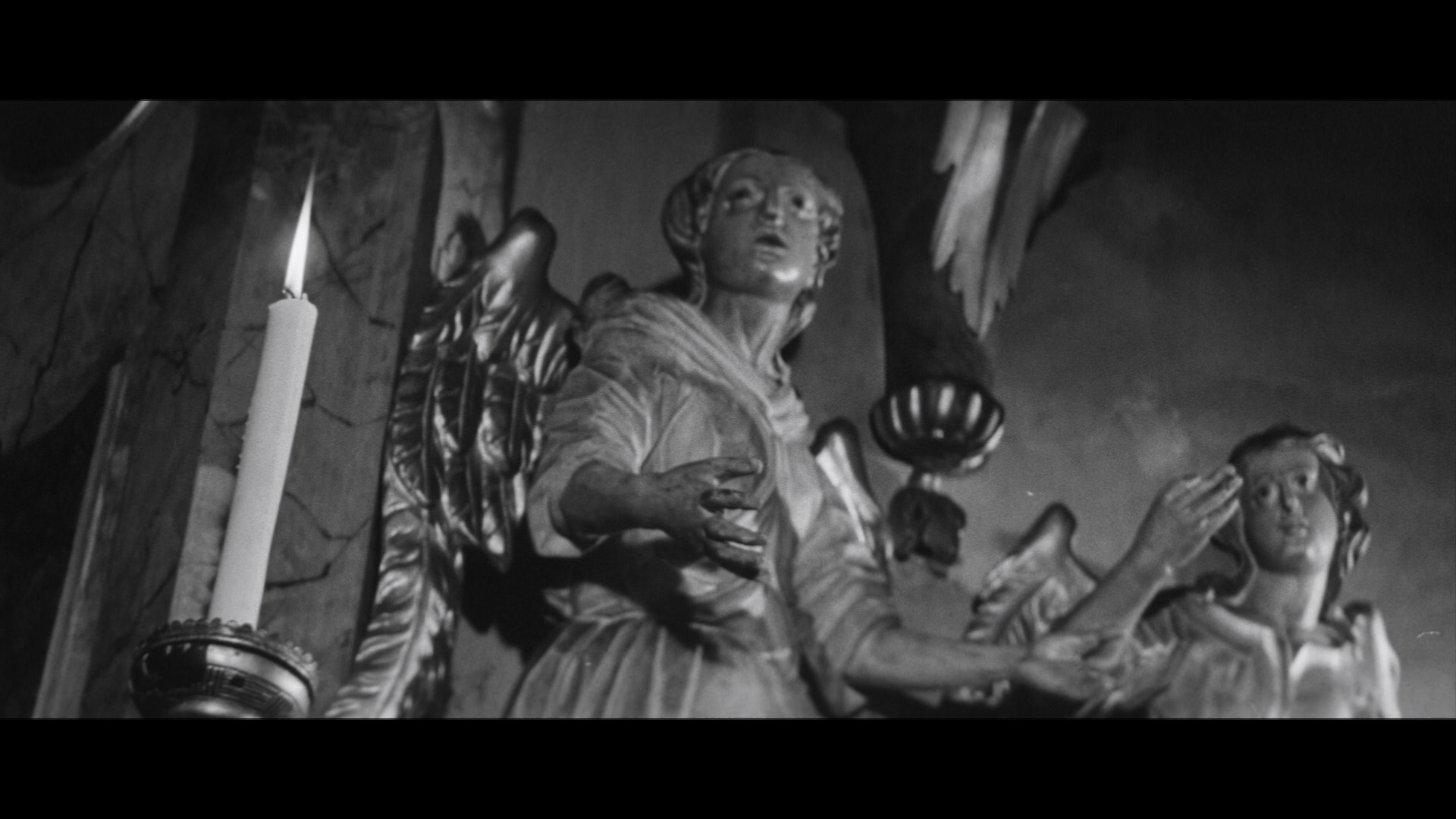
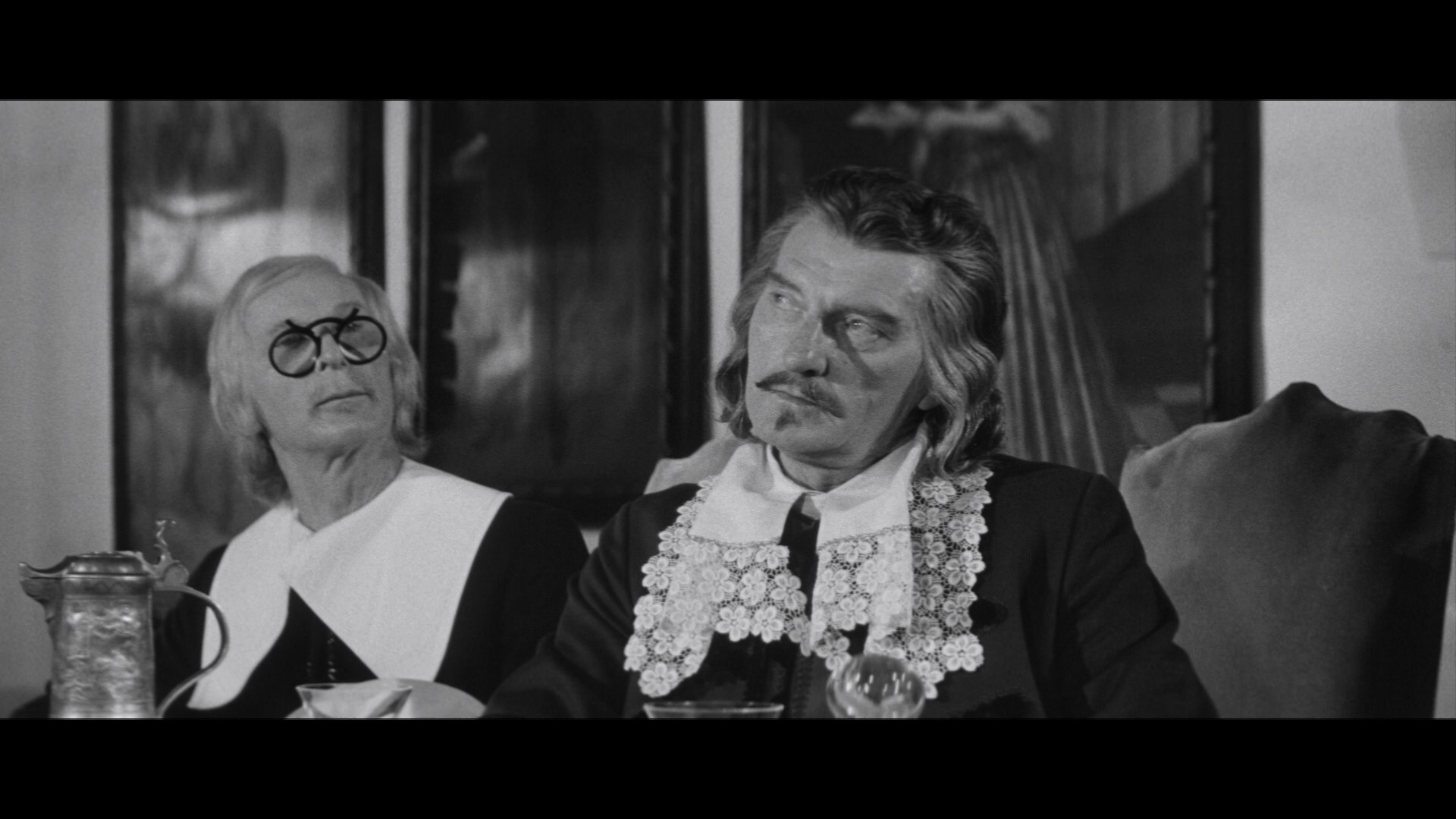
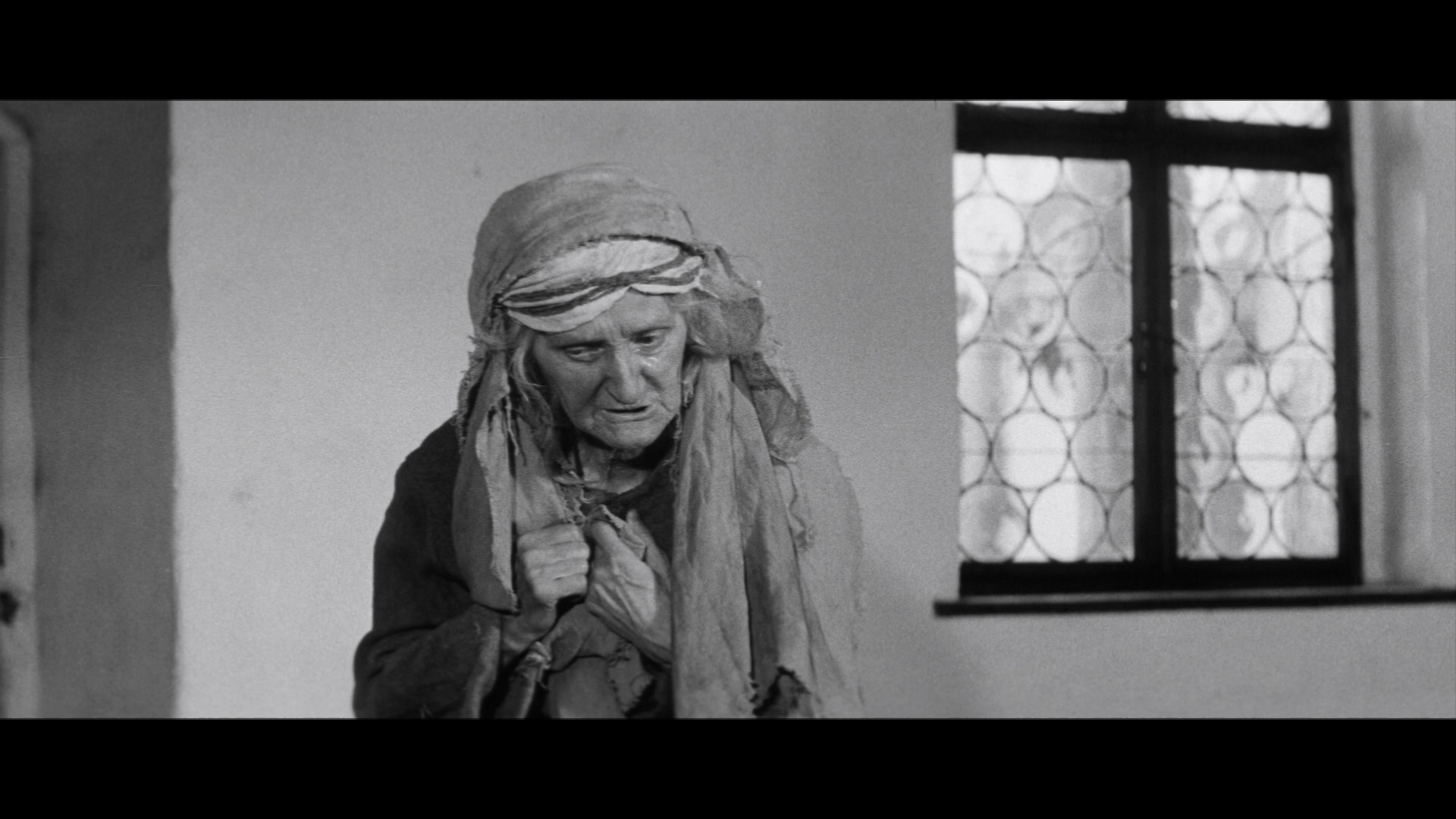
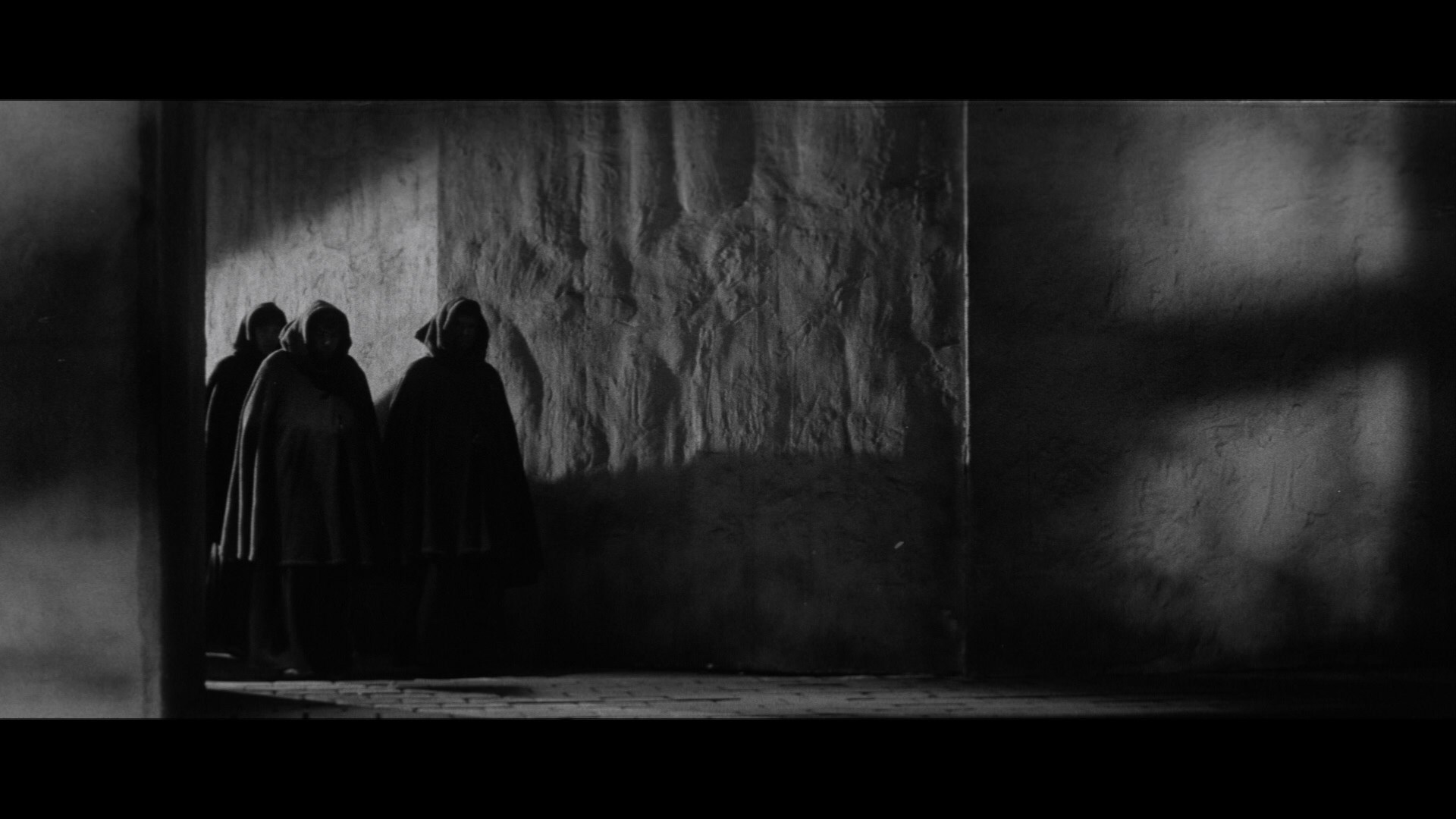
WITCHHAMMER: Second Run (Blu-ray)
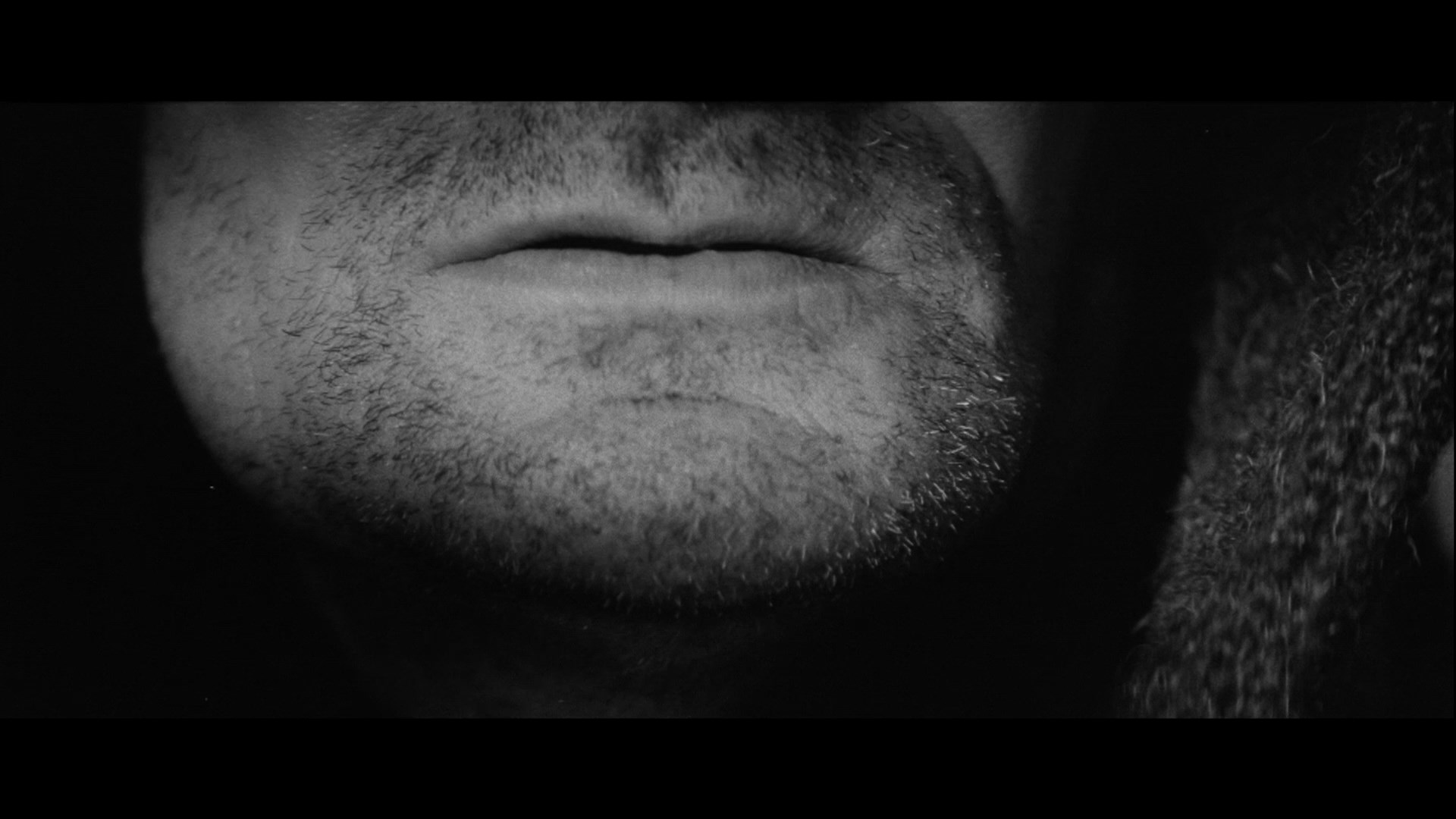
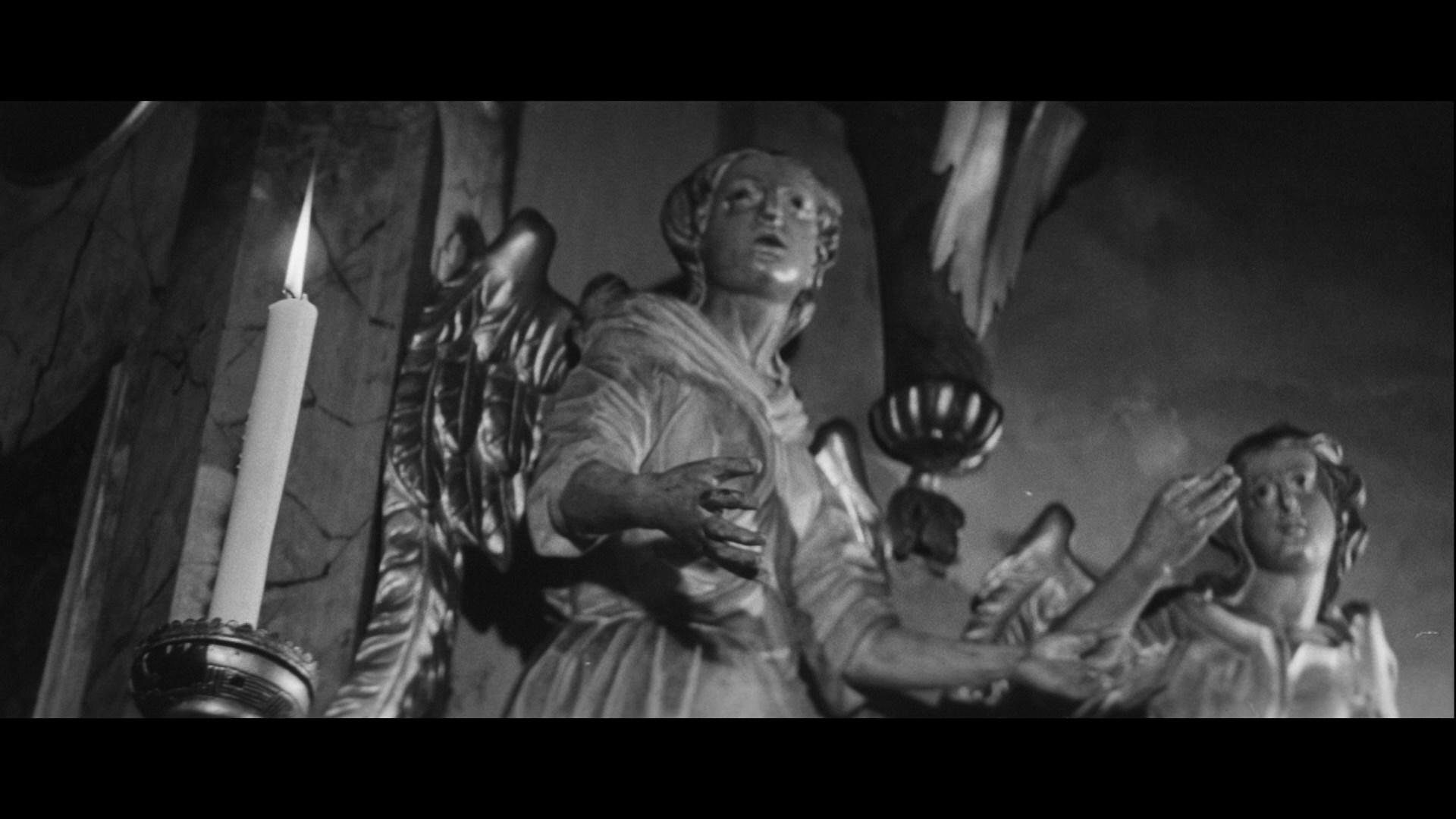
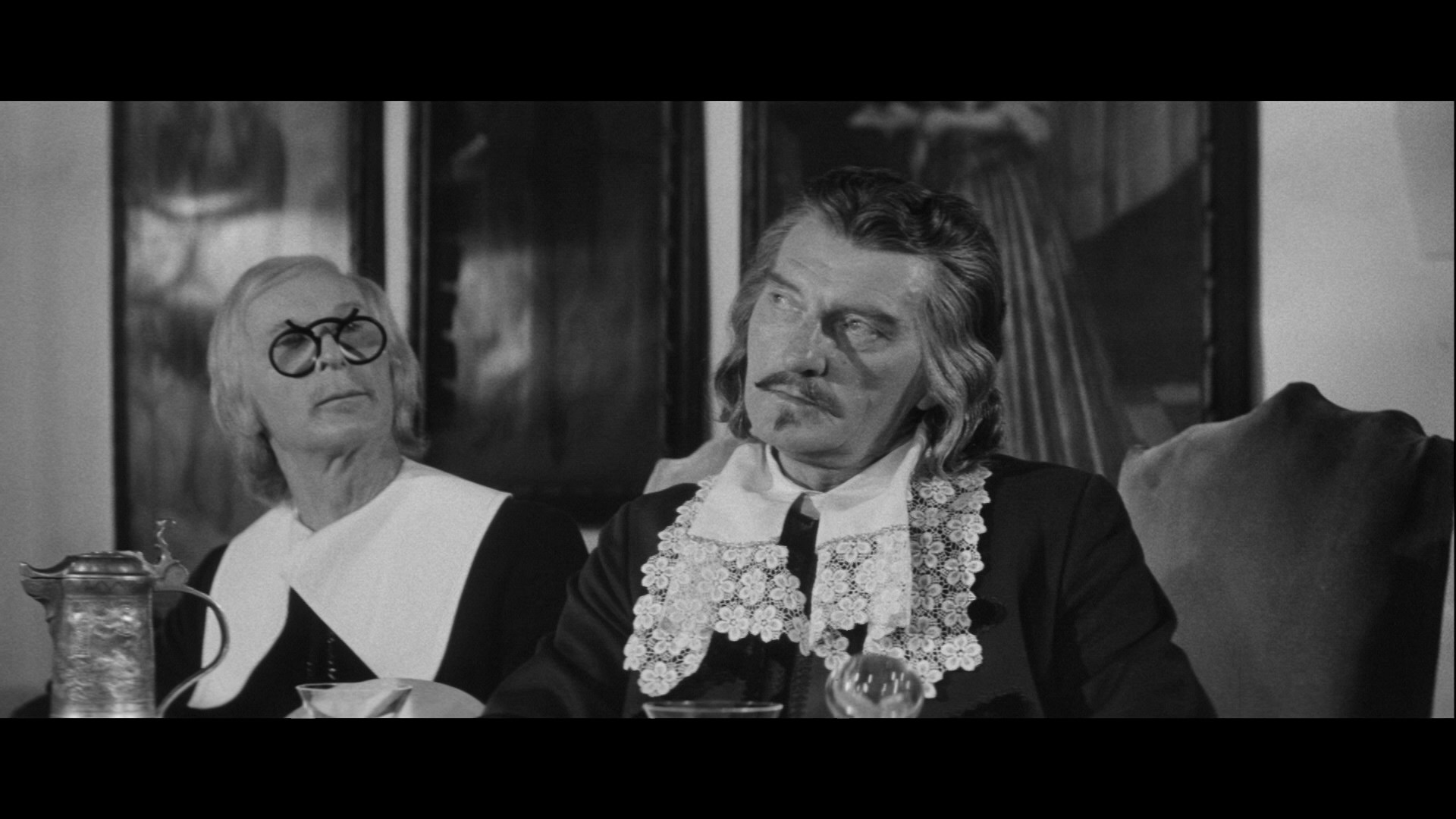
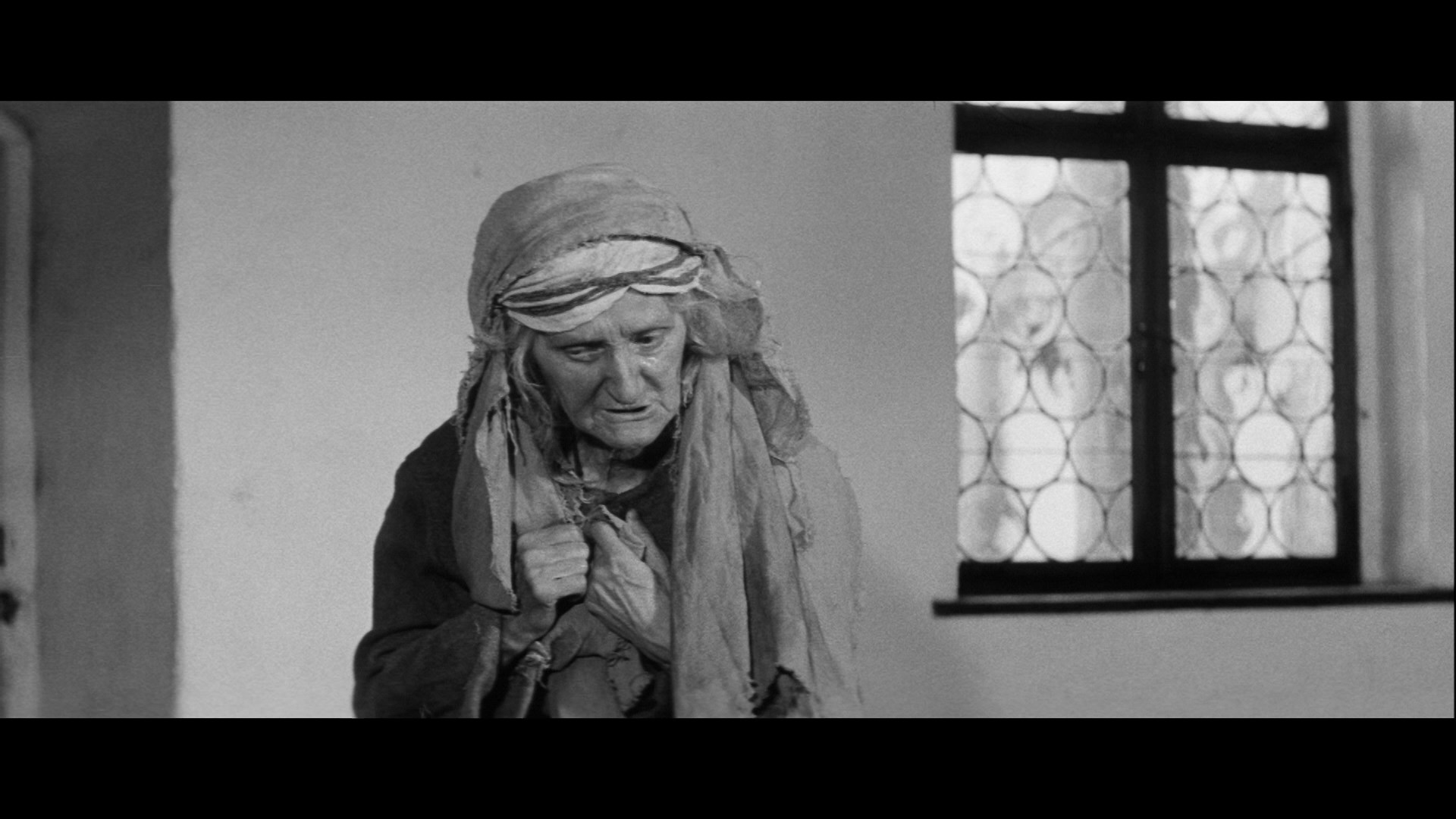
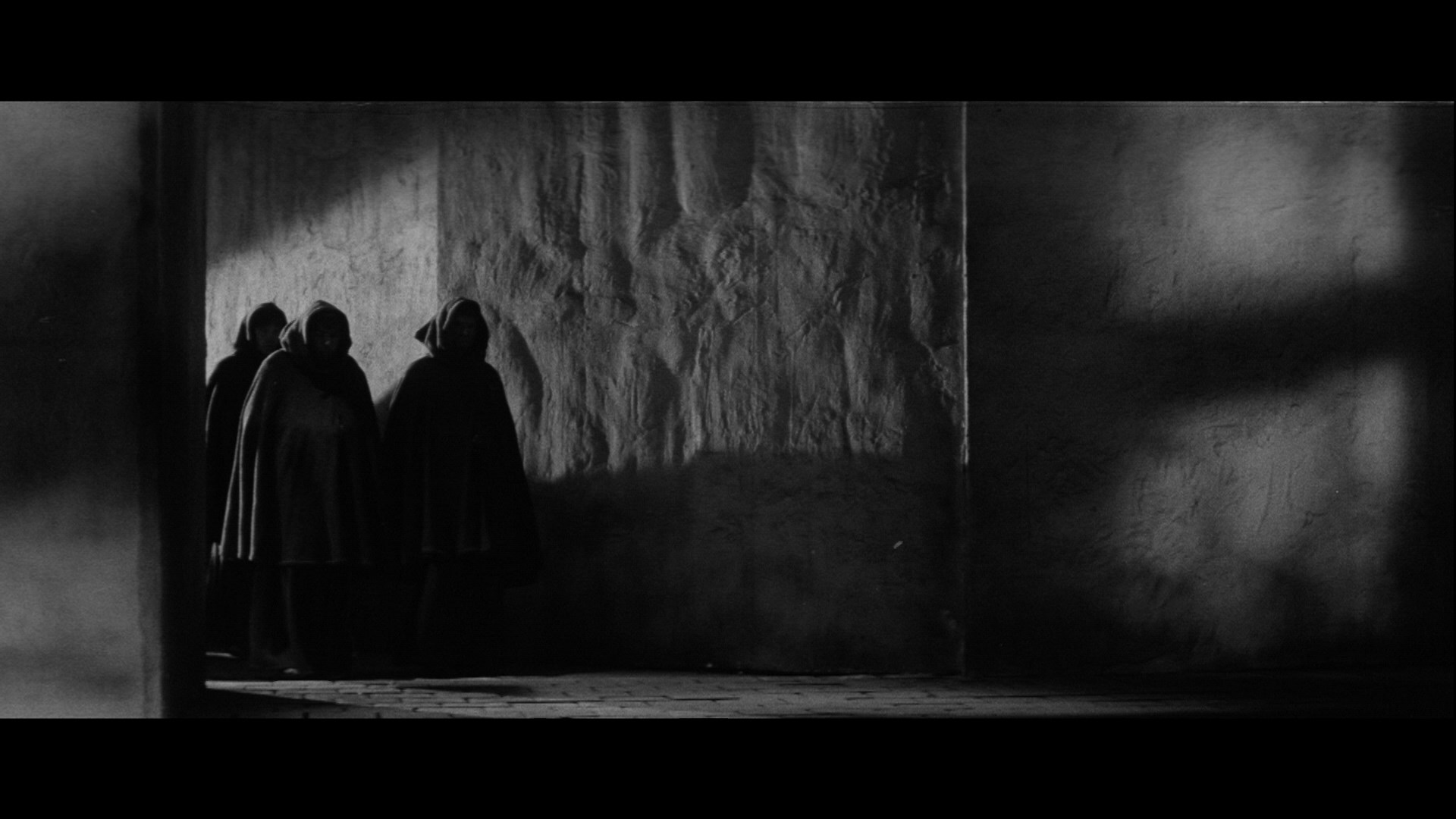
VIY: Severin (Blu-ray)
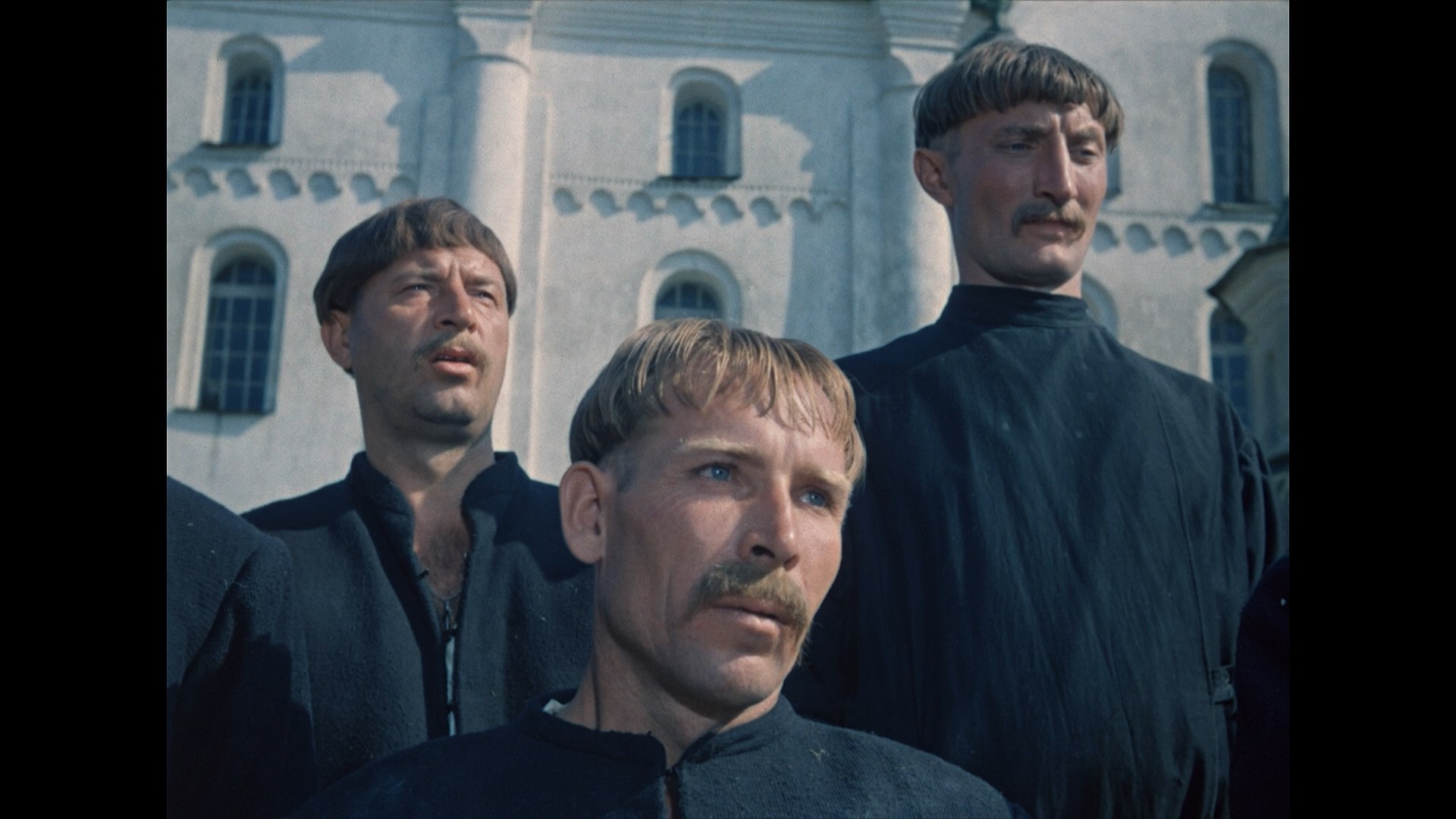
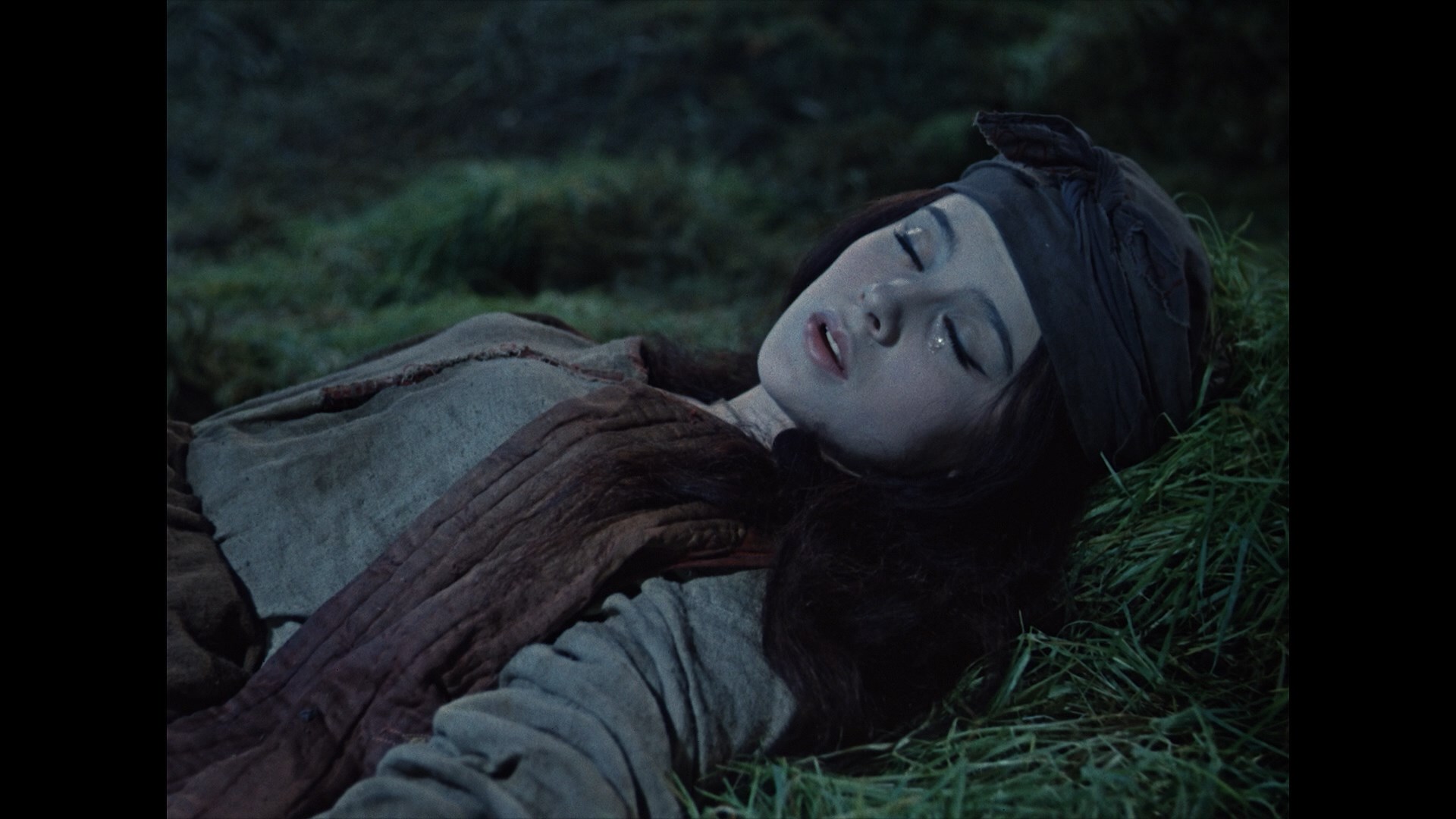
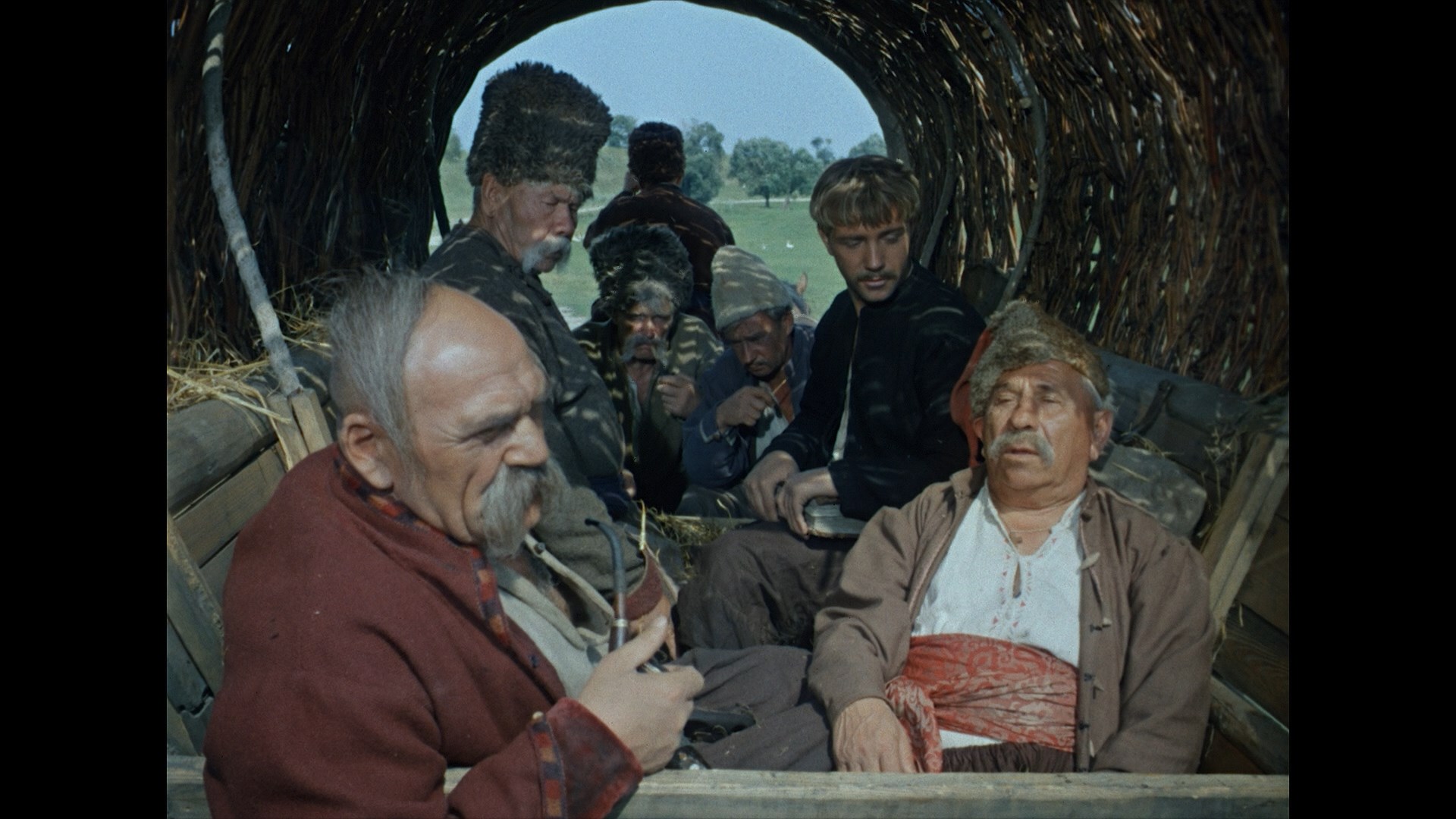

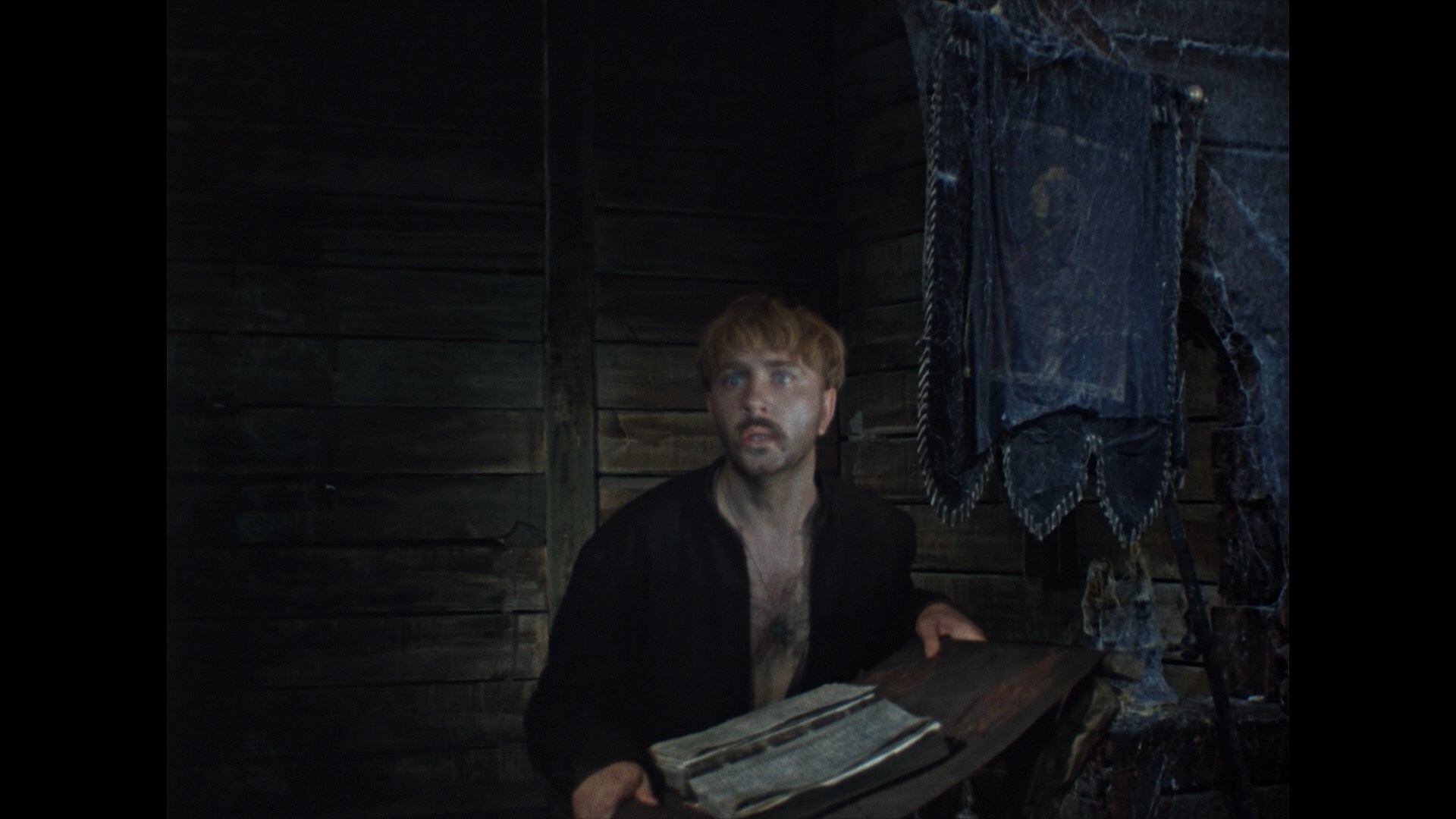
VIY: Ruscico (DVD)
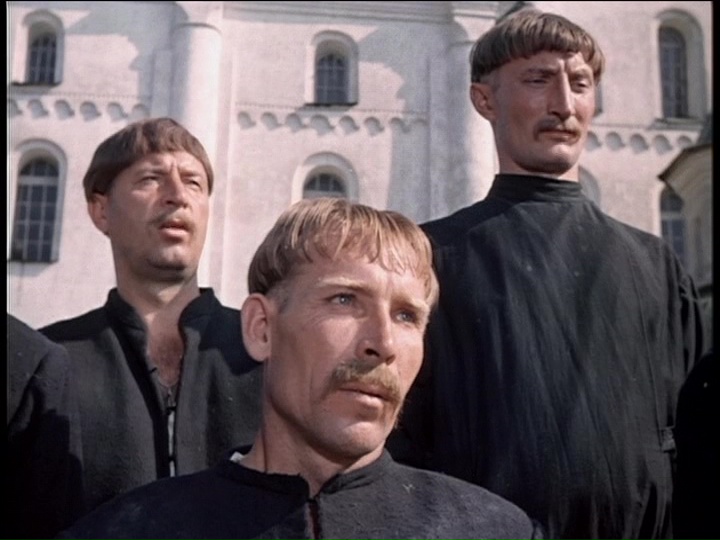
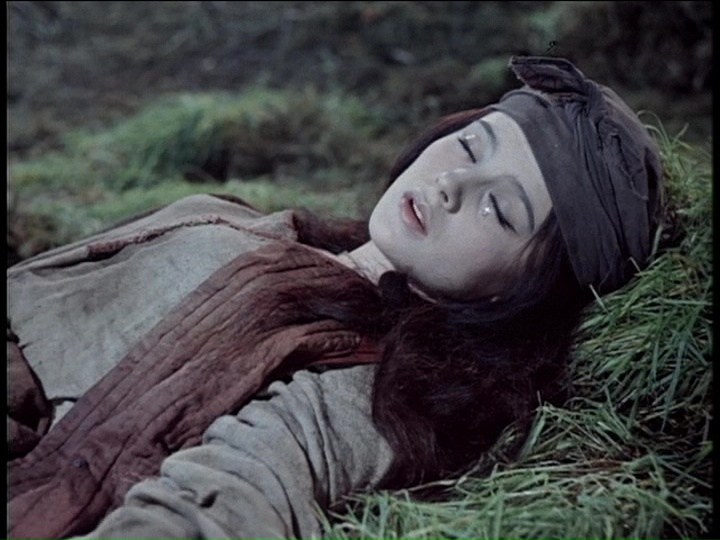
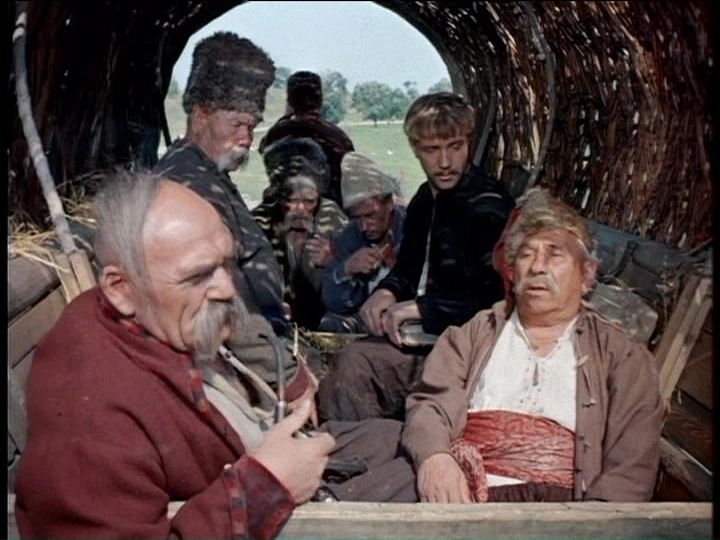
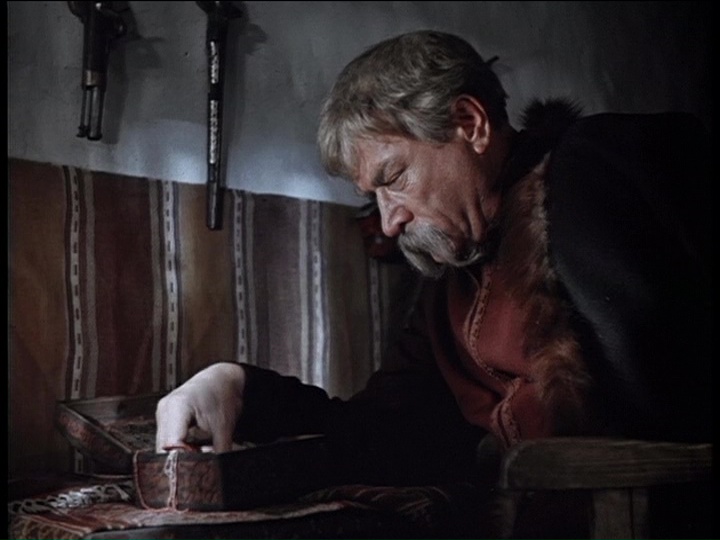
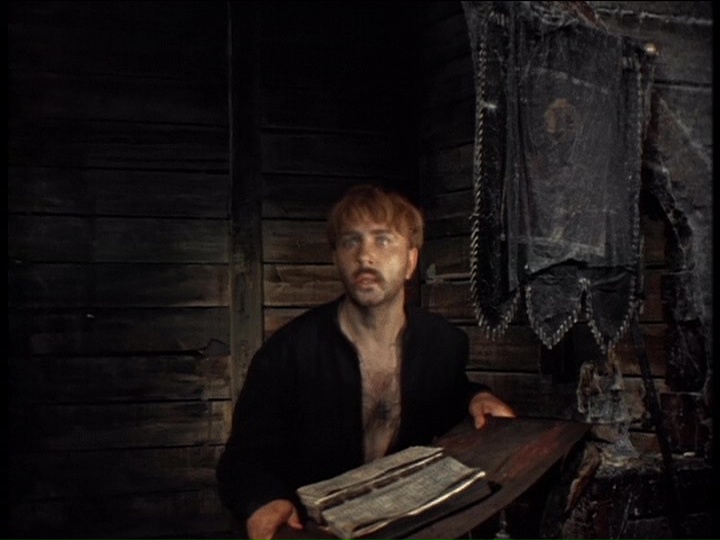
______________________________________________________________________________________________________
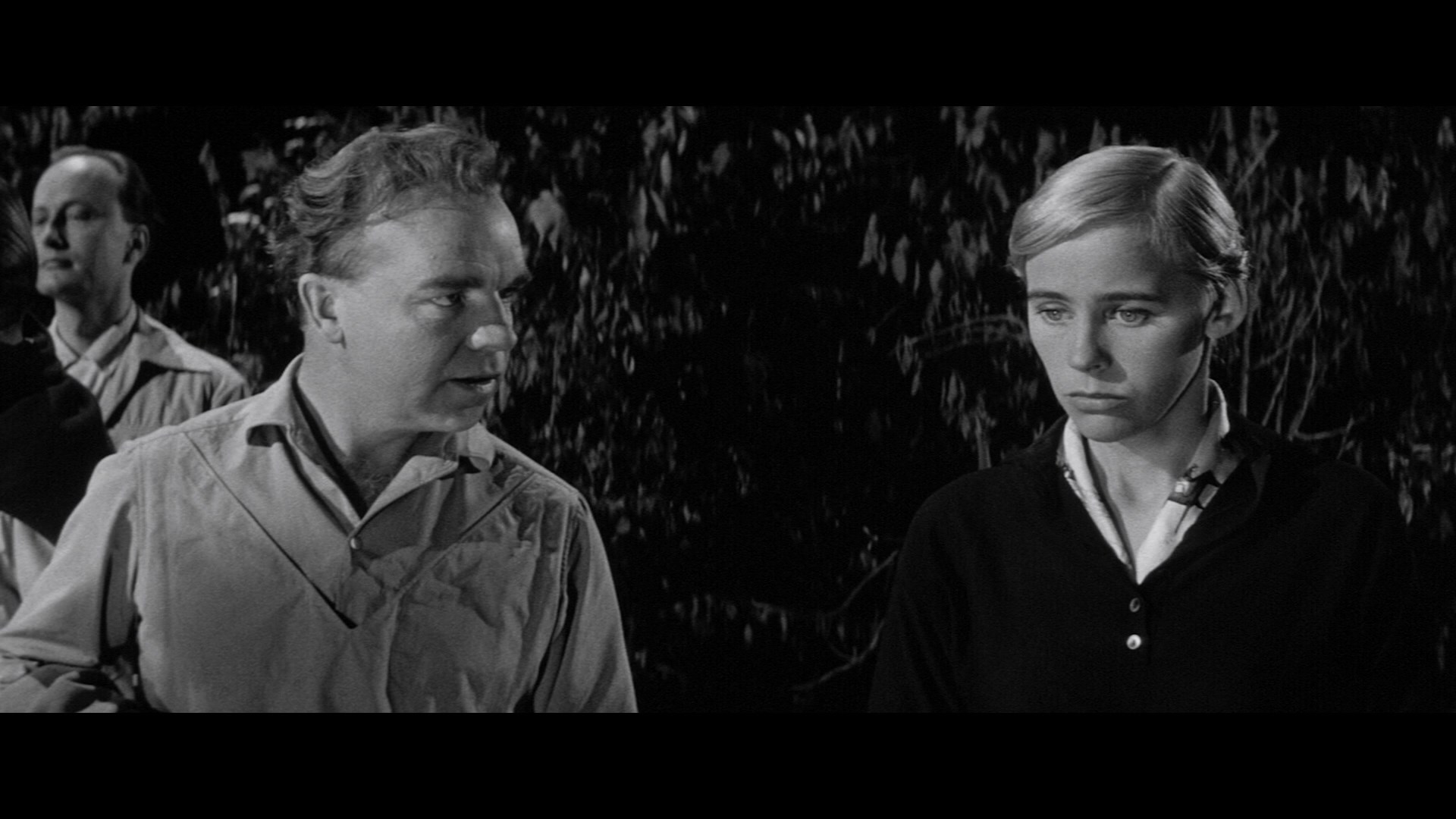 Anyone
Anyone 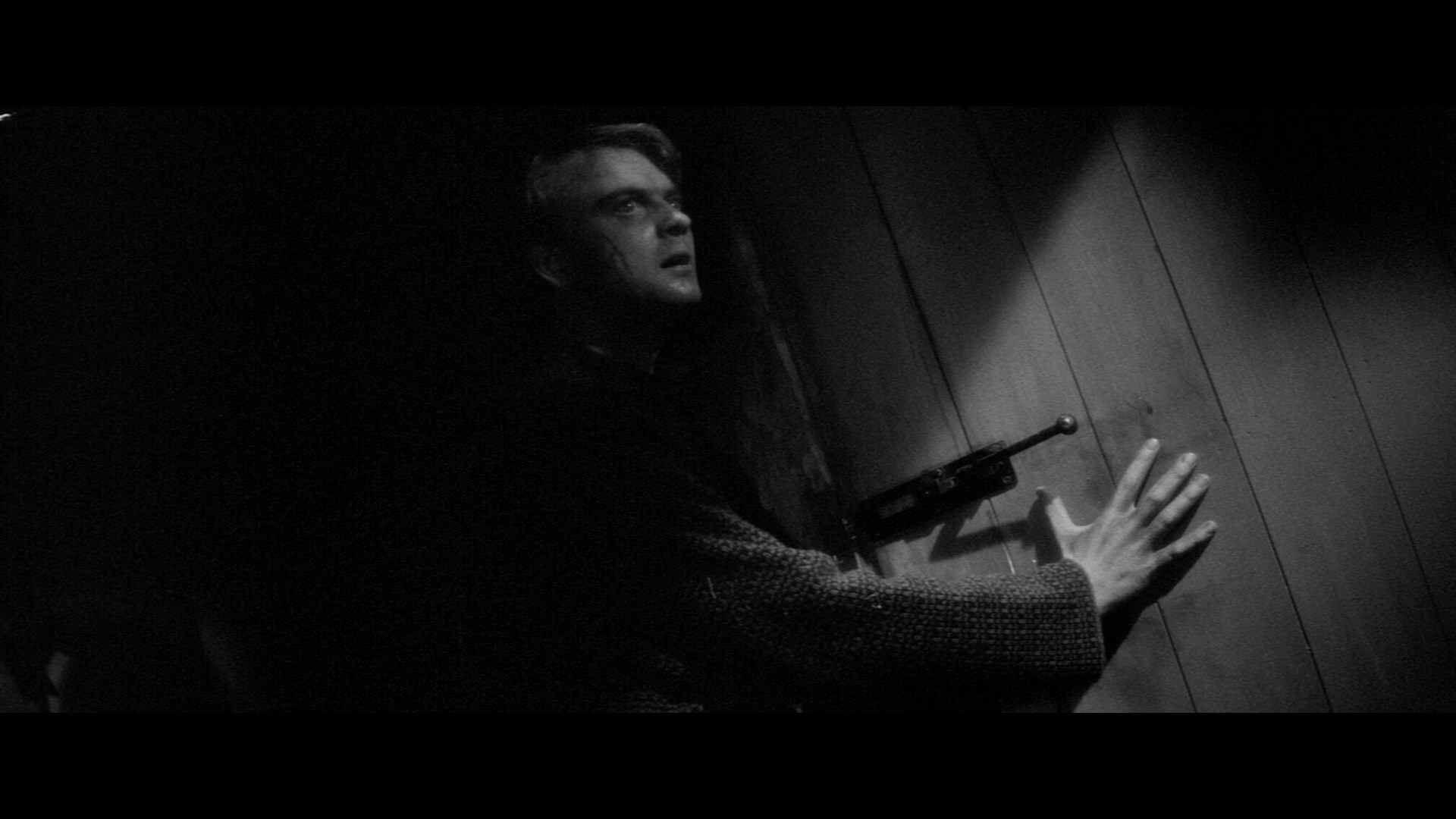 who's a sucker for black-and-white scope horror will get a real treat on disc five with one of Norway's finest spooky films, 1958's Lake of the Dead, an eerie treat that marked the country's first significant genre hit despite its relative lack of attention elsewhere. Based on a 1942 novel by André Bjerke (who acts in the film as well), it walks a fine balancing act between murder mystery thriller and supernatural excursion with a fascinating resolution that ends up falling somewhere in between the two. It's also very well shot and makes for perfect viewing late on a chilly evening, especially if you have a body of water nearby.
who's a sucker for black-and-white scope horror will get a real treat on disc five with one of Norway's finest spooky films, 1958's Lake of the Dead, an eerie treat that marked the country's first significant genre hit despite its relative lack of attention elsewhere. Based on a 1942 novel by André Bjerke (who acts in the film as well), it walks a fine balancing act between murder mystery thriller and supernatural excursion with a fascinating resolution that ends up falling somewhere in between the two. It's also very well shot and makes for perfect viewing late on a chilly evening, especially if you have a body of water nearby.
Mystery author Bernhard (Kolstad) and his wife, Sonja (Engh), are talking about his latest book idea (which might be the film we're watching) before jumping on a train to join four friends on a trip to the countryside. Of course, they're going to a secluded cabin in the woods next to a lake where they plan to visit a friend, Bjørn, who's nowhere to be found but left behind a perplexing diary. The place has a very dark history involving a one-legged man named Gråvik whose incestuous impulses drove him to become an axe murderer, and legend has it the long-dead murderer haunts the area and can possess the living at will. This story has a particularly strong pull on 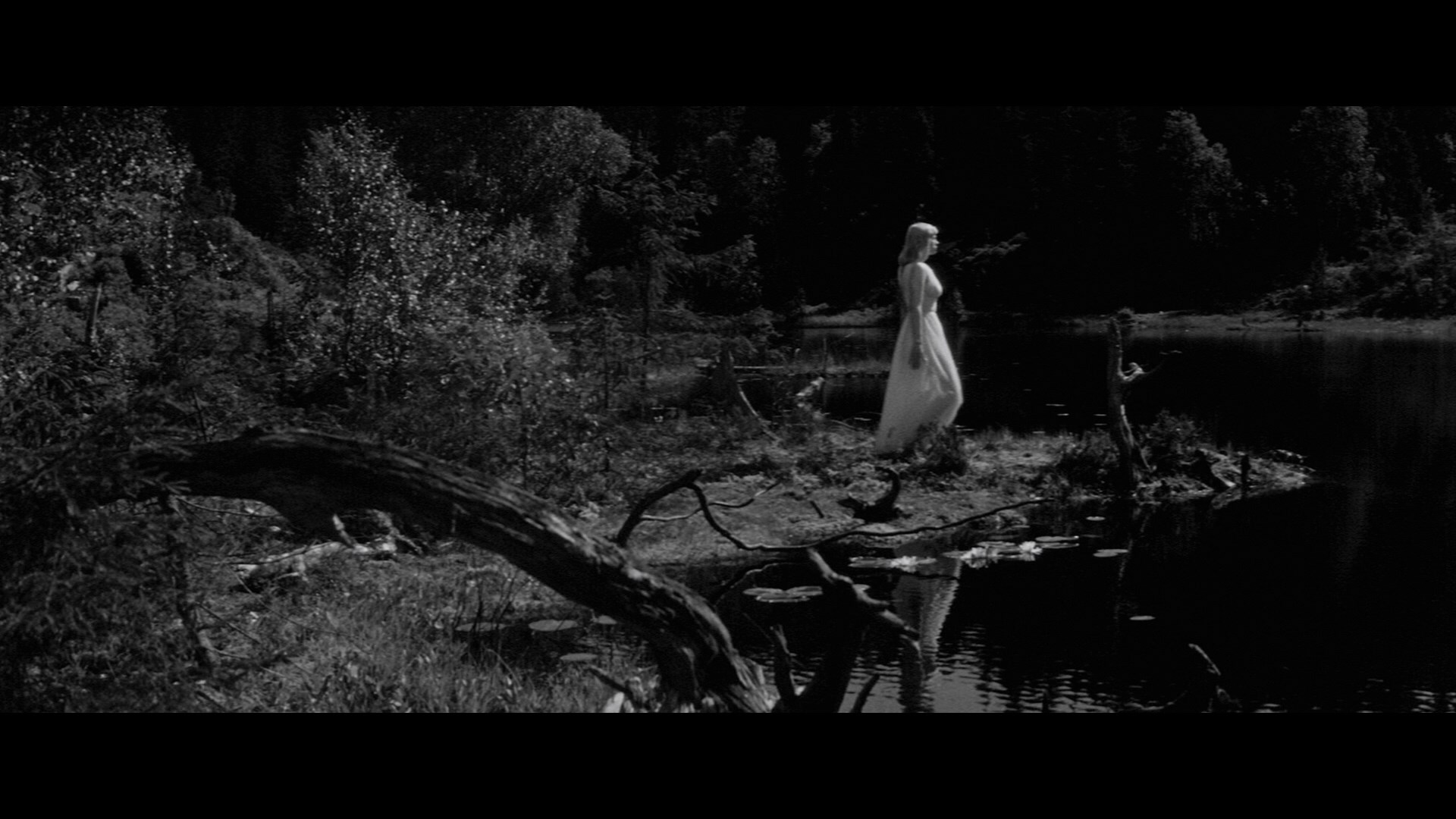 Bjørn's sister, Lillian (Moan), who seems to be at the epicenter of an uncanny
Bjørn's sister, Lillian (Moan), who seems to be at the epicenter of an uncanny 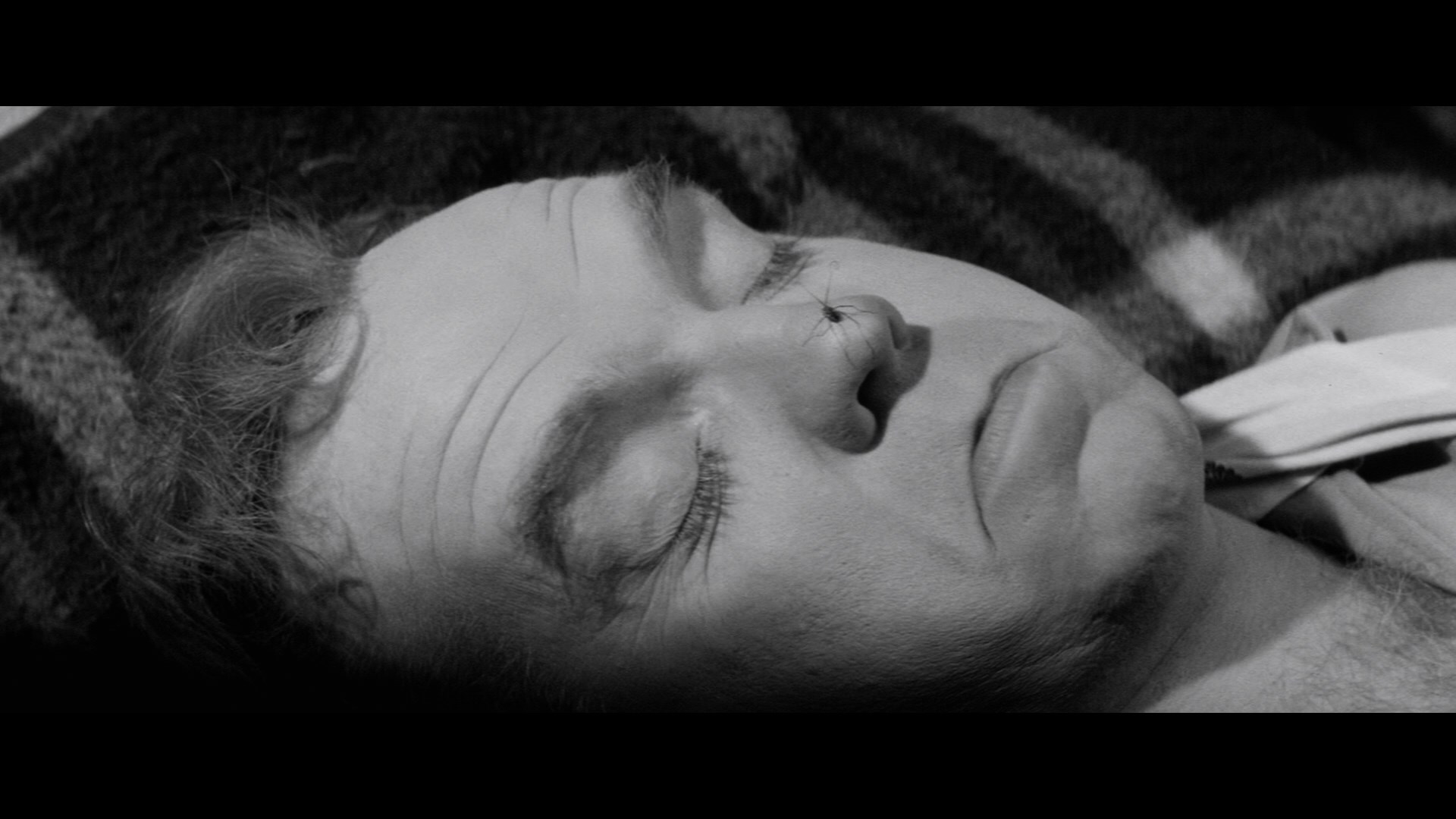 puzzle.
puzzle.
Making excellent use of the shimmering lake, in-camera optical effects, and unsettling use of the isolated location, Lake of the Dead transcends its potentially talky structure thanks to its likable, well-acted characters and a fascinating story that takes a few very peculiar turns. If there's a fault it's the fact that the scariest moment in the film comes during an extended flashback at the half-hour mark, a really potent mini-ghost story on its own that simply can't be topped by the relatively subdued climax. Apart from an English-subtitled but bare bones Norwegian DVD release ages ago, this one's been very difficult to see outside its native country without resorting to gray market options. Thankfully the Severin release fixes that with the first official U.S. edition of any kind, featuring new 2K restoration from the original negative (apart from the scruffier main titles, which appear to be pulled from a print). The detail is much stronger than the DVD, and blacks look far richer and deeper as well; the only odd point is the fact that 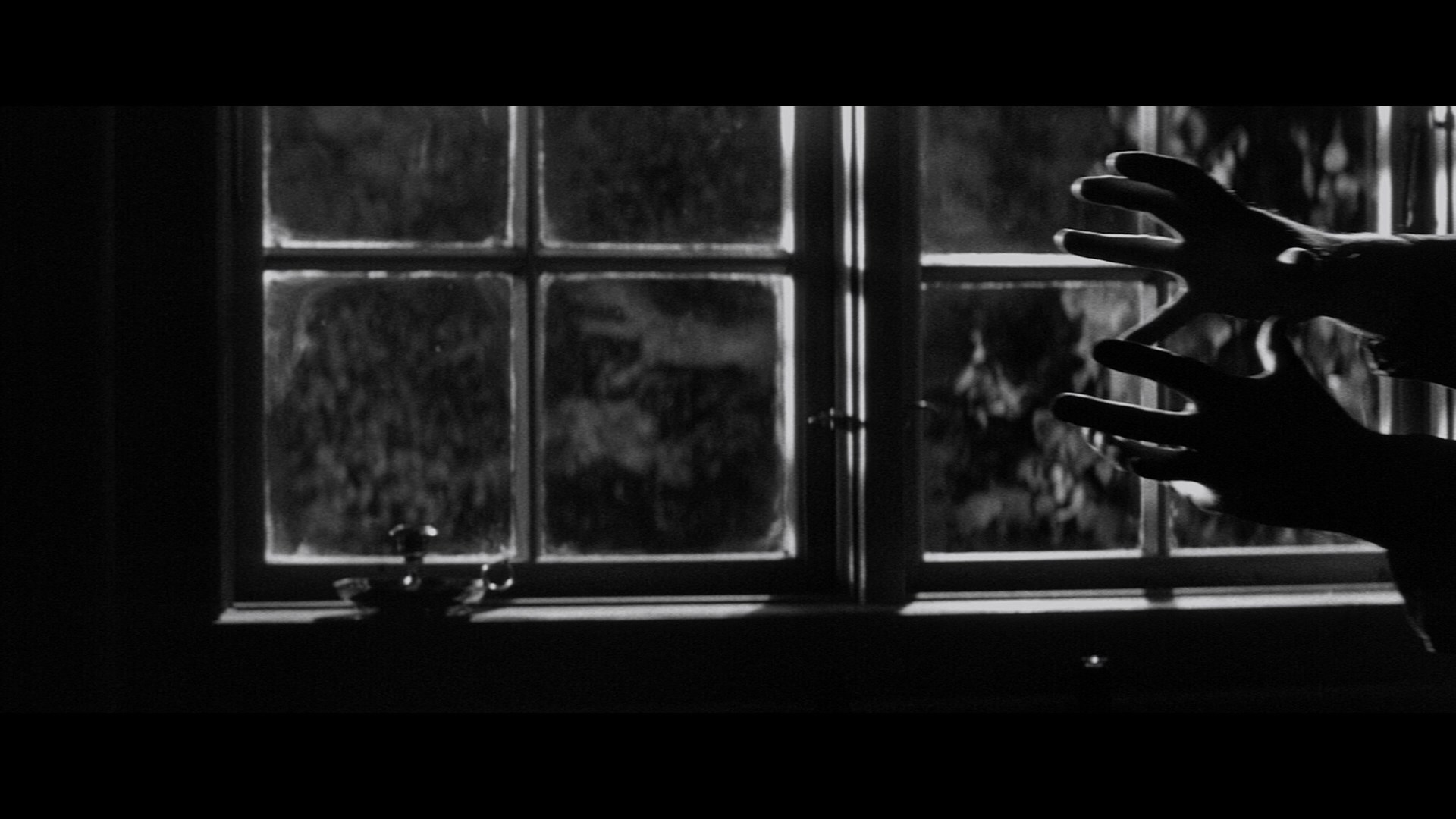 this is
this is 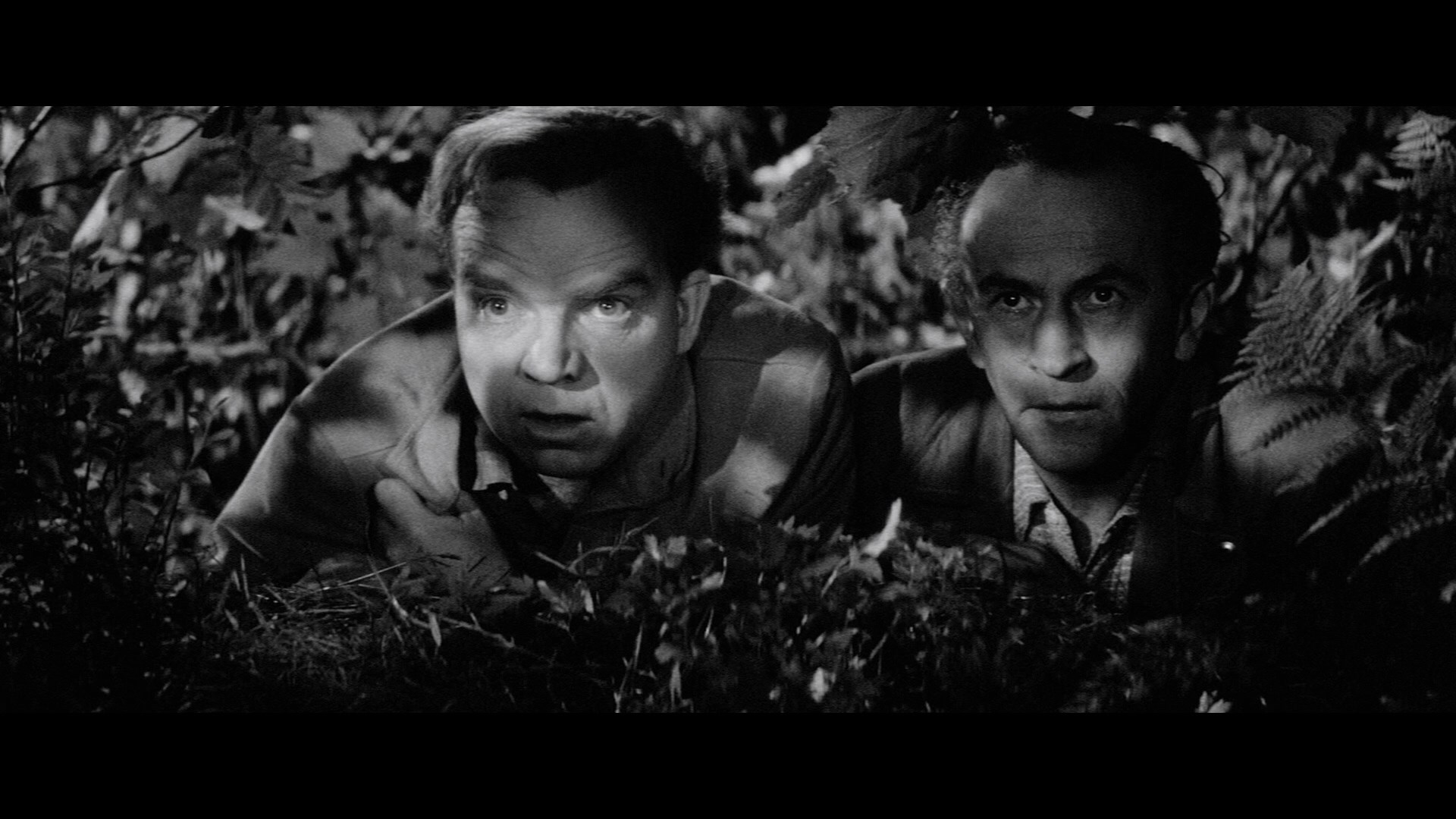 considerably zoomed in by comparison (especially on the left side), though the compositions don't really appear to be affected one way or the other. Given the fact that the compositions are actually more centered here, presumably this is due to the left side normally reserved for optical audio wasn't meant to be seen anyway. The sole extra is a new audio commentary with the well-informed Jonathan Rigby And Kevin Lyons, who get to have fun chatting about Norwegian cinema, classic horror tropes, murder mysteries, and lots more.
considerably zoomed in by comparison (especially on the left side), though the compositions don't really appear to be affected one way or the other. Given the fact that the compositions are actually more centered here, presumably this is due to the left side normally reserved for optical audio wasn't meant to be seen anyway. The sole extra is a new audio commentary with the well-informed Jonathan Rigby And Kevin Lyons, who get to have fun chatting about Norwegian cinema, classic horror tropes, murder mysteries, and lots more.
Also on the disc is a made-for-TV supernatural oddity from Iceland made in 1987, Tilbury, a combination of folklore grotesqueries and anxiety about the sudden influx of British and American military in the area during World War II. (As such, it's presented in a combination of Icelandic and English throughout.) The opening introduces us to the background of the titular "tilberi," a monstrous 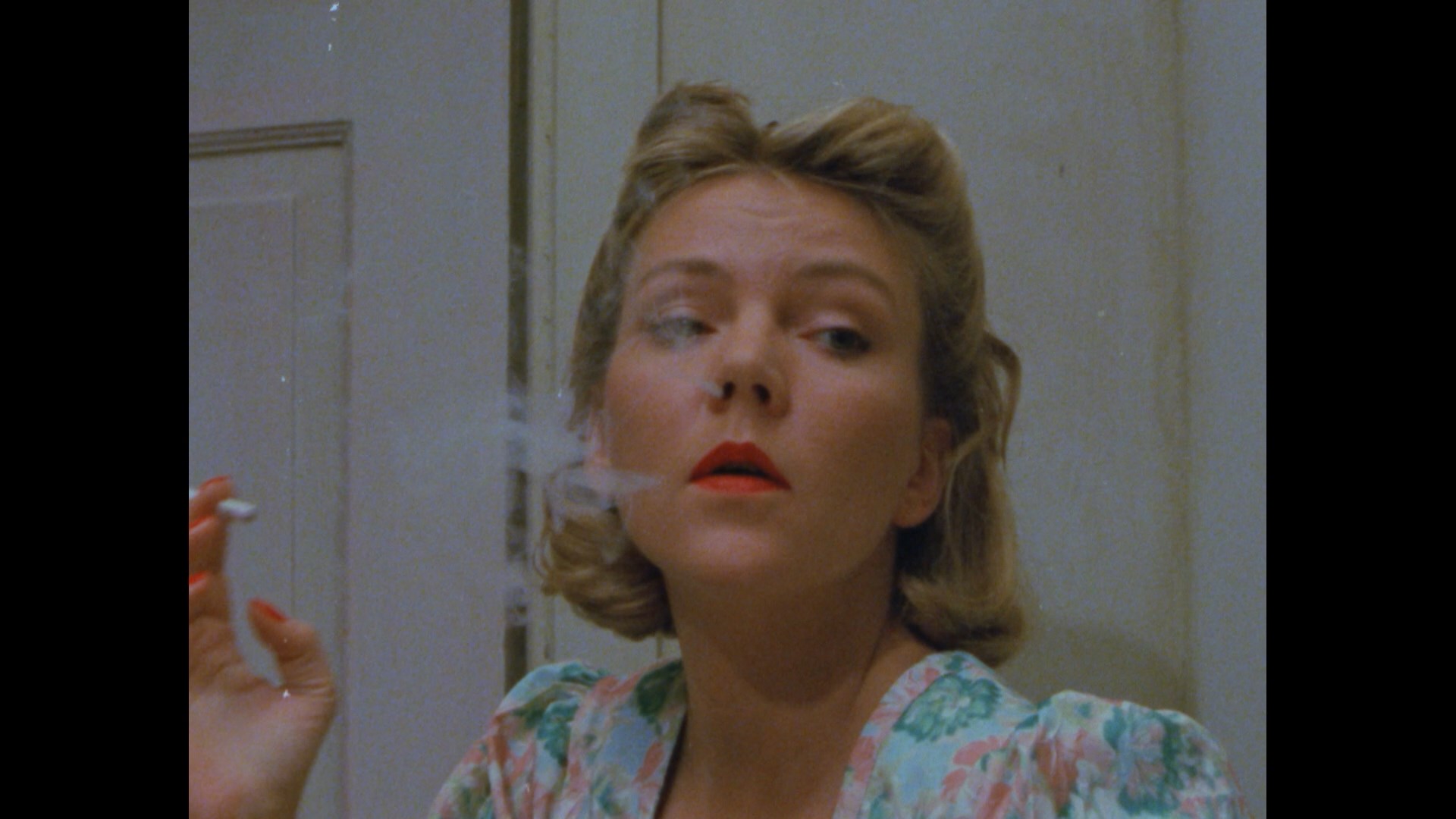 being conjured up by witches during a dairy shortage to
being conjured up by witches during a dairy shortage to 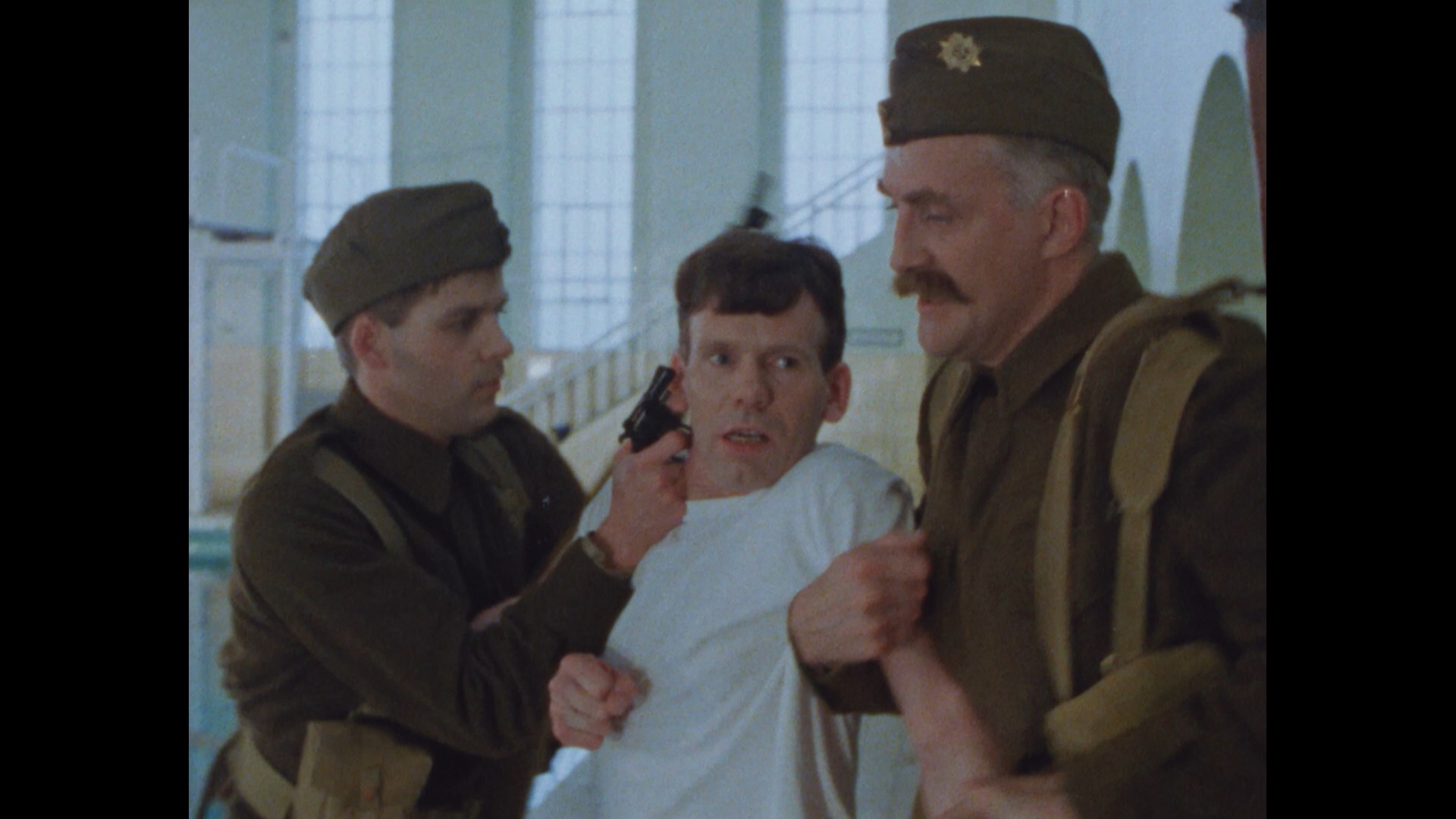 siphon away milk to create butter. The monsters are created from human ribs wrapped in wool and doused in communion wine between the women's breasts, and they feed off an extra nipple grown on the woman's thigh. How that figures into our main story isn't obvious right away as we're introduced to swimmer Audrun (Magnúss), who goes off to Reykjavík to serve under the British and is asked to check up on his childhood crush, Gudrun (Bernhard). Upon arrival he finds she's involved with a strange British officer, Tilbury (Ulfsson), who has an oversized nose and tends to puke up a bright green substance at night. What ensues is a twisted look at jealousy, xenophobia, and and madness, not to mention a crazed dance sequence involving the monster and a truly surreal finale.
siphon away milk to create butter. The monsters are created from human ribs wrapped in wool and doused in communion wine between the women's breasts, and they feed off an extra nipple grown on the woman's thigh. How that figures into our main story isn't obvious right away as we're introduced to swimmer Audrun (Magnúss), who goes off to Reykjavík to serve under the British and is asked to check up on his childhood crush, Gudrun (Bernhard). Upon arrival he finds she's involved with a strange British officer, Tilbury (Ulfsson), who has an oversized nose and tends to puke up a bright green substance at night. What ensues is a twisted look at jealousy, xenophobia, and and madness, not to mention a crazed dance sequence involving the monster and a truly surreal finale.
Restored in 2K from the negative at the Film Museum of Iceland, Tilbury looks great here and will be quite the first-time viewing experience for a lot of folks. It isn't really "scary" so much as bizarre, though a very bloody third act scene and some kinky visuals are much stronger than what you'd expect from anything on '80s television. (Apparently this was quite controversial at the time and only 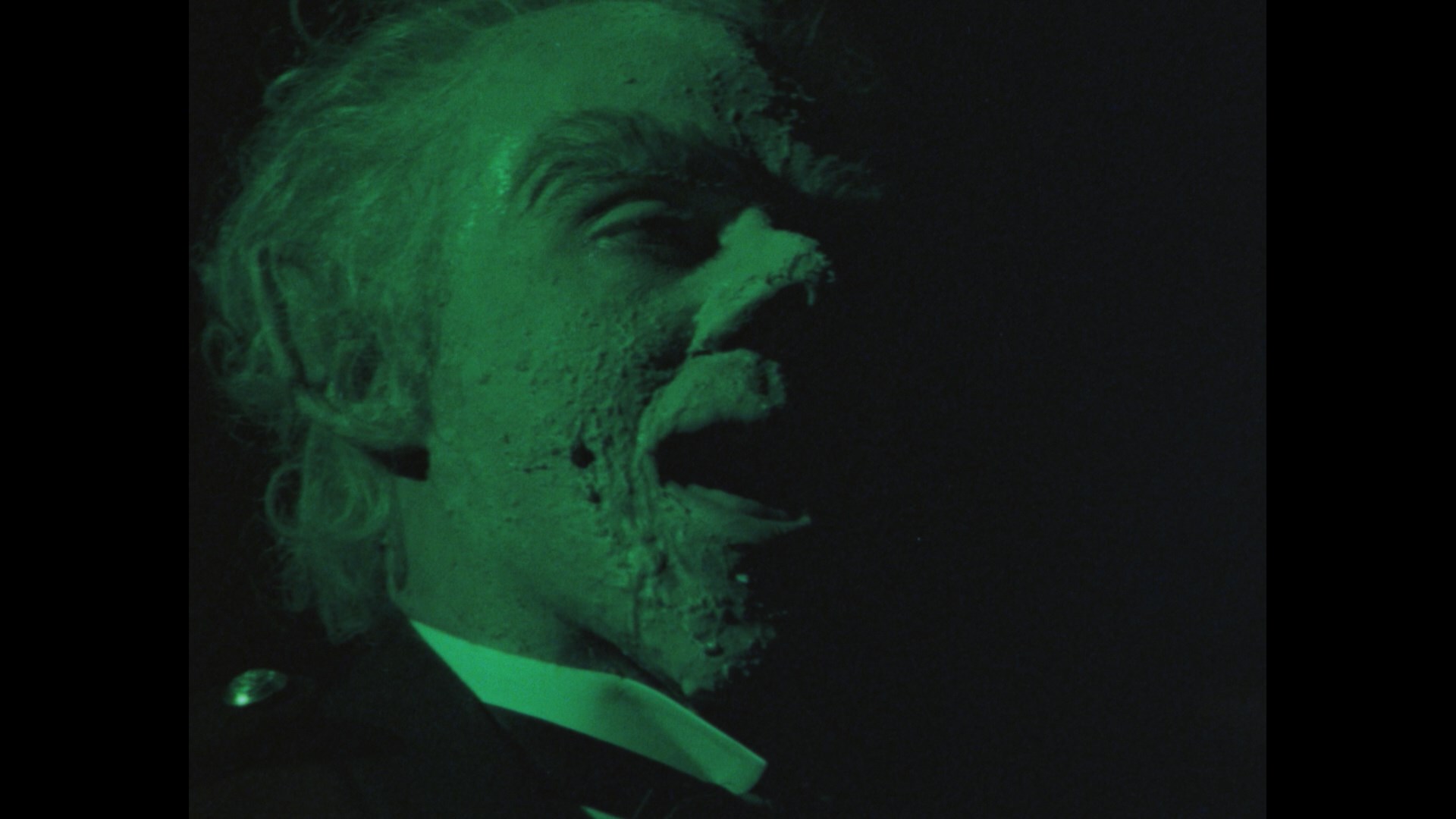 skated through on the basis of
skated through on the basis of 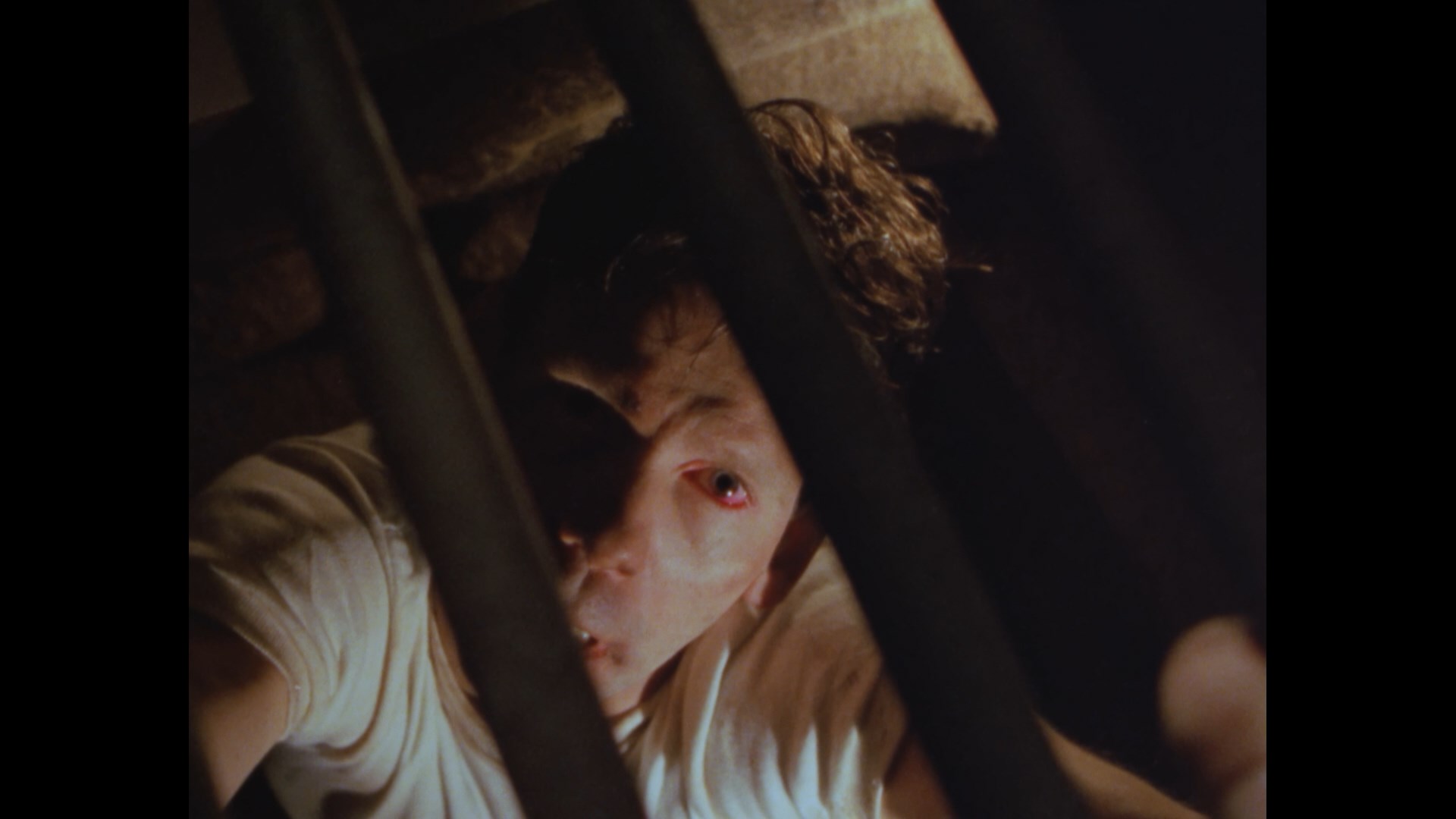 its folklore origins.) Director Viðar Víkingsson is all over this release including a new commentary with screenwriter Þórarinn Eldjárn moderated by the appropriately named Gudrun D. Whitehead, his fairly inscrutable French-language 1979 student short White Spot In The Back Of The Head (34m22s), and a video interview, "The Moon Fades, Death Rides" (4m51s), about the short's creation and folklore influences. He's obviously very well-versed in Icelandic history and folk stories, and it's interesting hearing him and his writer in particular talk about how the story of the feature evolved and what they were going for with the decision to set it at the height of World War II during a particularly uneasy moment in Icelandic history. Two of the actors are also on hand for short interviews, with Úlfsson in "With Enough Tilbury Butter, Anything Is Good" (6m6s) chatting about how the project came about and his own upbringing watching Hammer horror films, and Magnúss in "A Boy From The Country" (2m56s) briefly explaining how he got the role and his memories of his director.
its folklore origins.) Director Viðar Víkingsson is all over this release including a new commentary with screenwriter Þórarinn Eldjárn moderated by the appropriately named Gudrun D. Whitehead, his fairly inscrutable French-language 1979 student short White Spot In The Back Of The Head (34m22s), and a video interview, "The Moon Fades, Death Rides" (4m51s), about the short's creation and folklore influences. He's obviously very well-versed in Icelandic history and folk stories, and it's interesting hearing him and his writer in particular talk about how the story of the feature evolved and what they were going for with the decision to set it at the height of World War II during a particularly uneasy moment in Icelandic history. Two of the actors are also on hand for short interviews, with Úlfsson in "With Enough Tilbury Butter, Anything Is Good" (6m6s) chatting about how the project came about and his own upbringing watching Hammer horror films, and Magnúss in "A Boy From The Country" (2m56s) briefly explaining how he got the role and his memories of his director.
LAKE OF THE DEAD: Severin (Blu-ray)
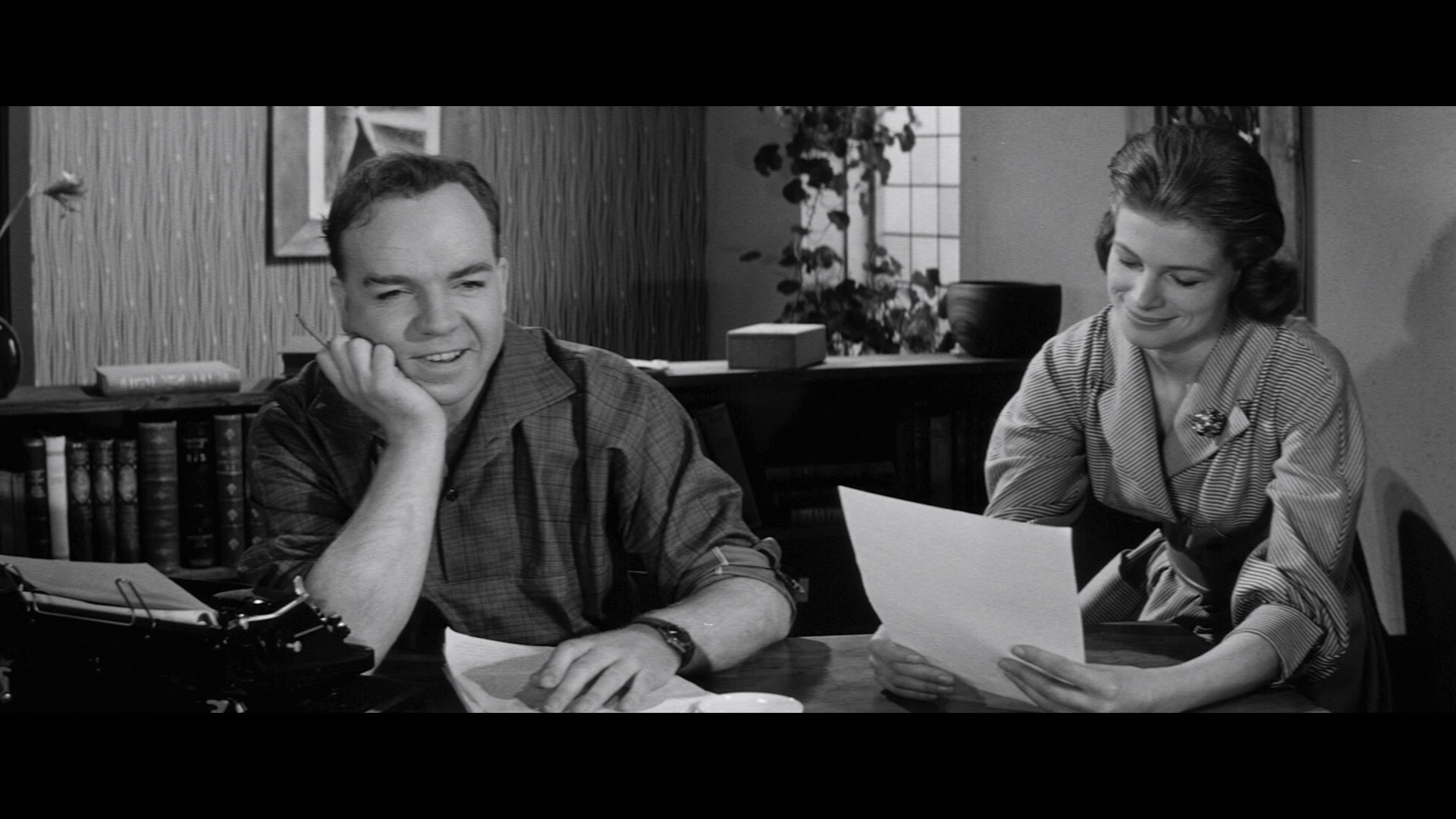
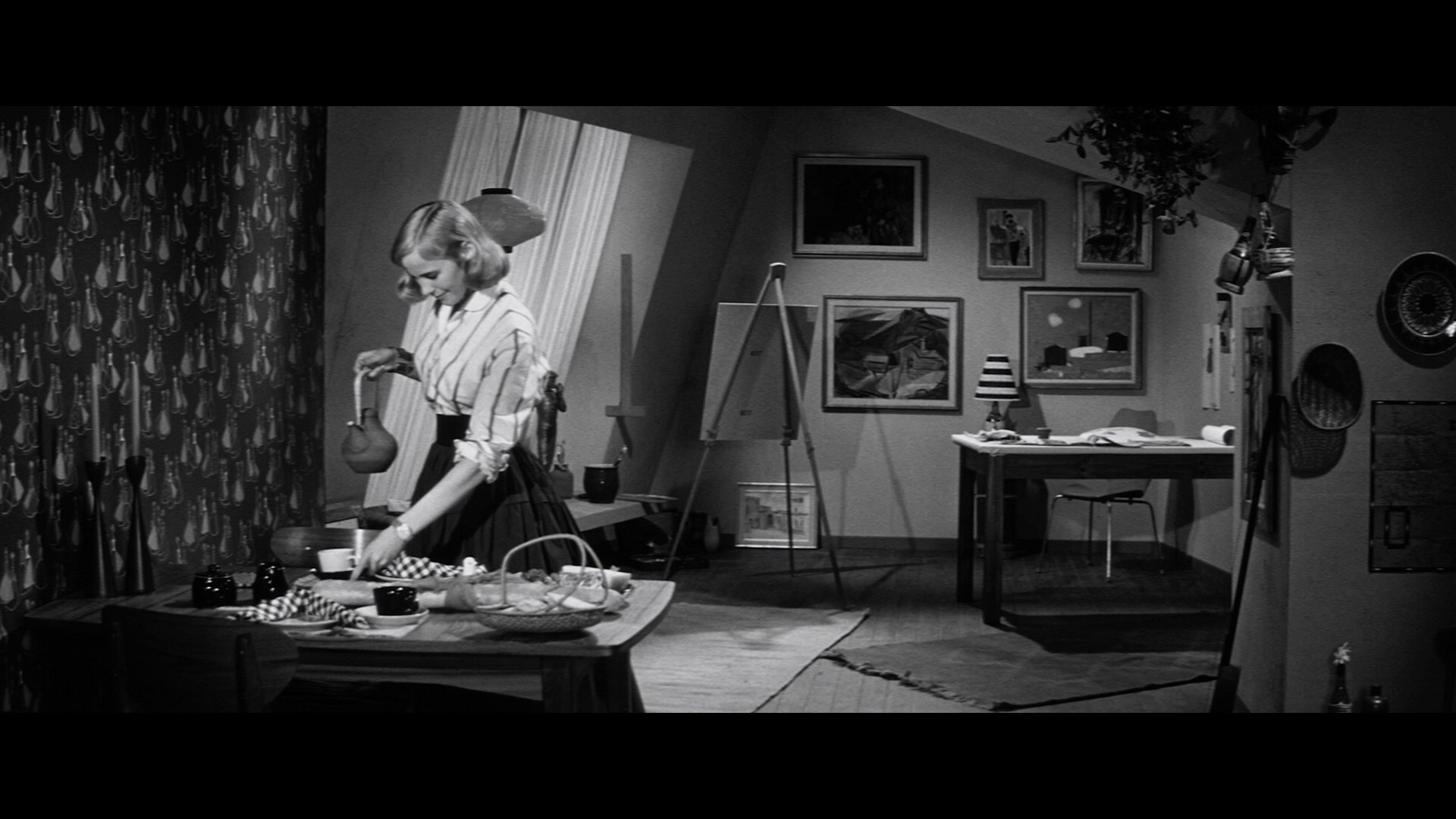
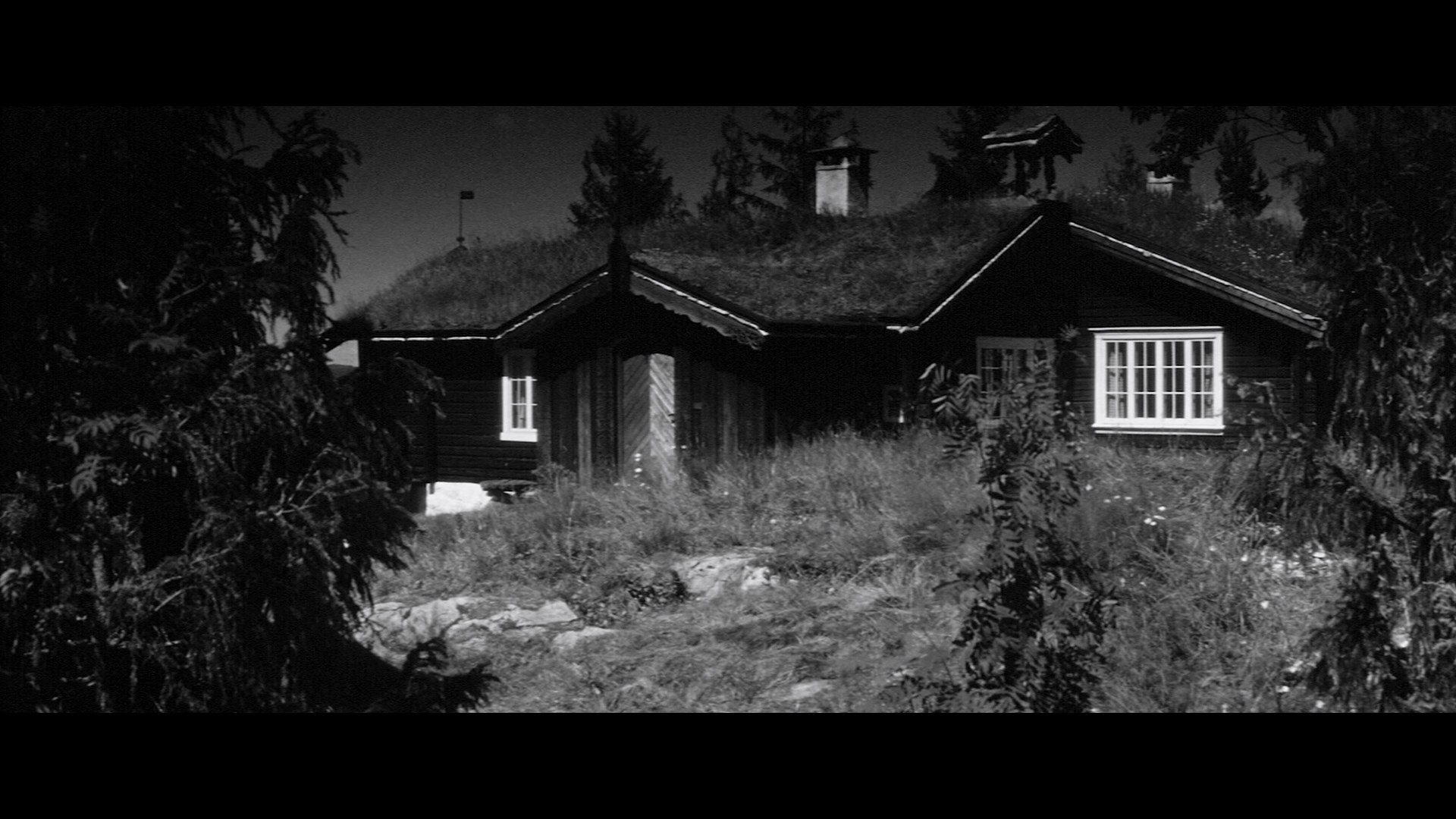
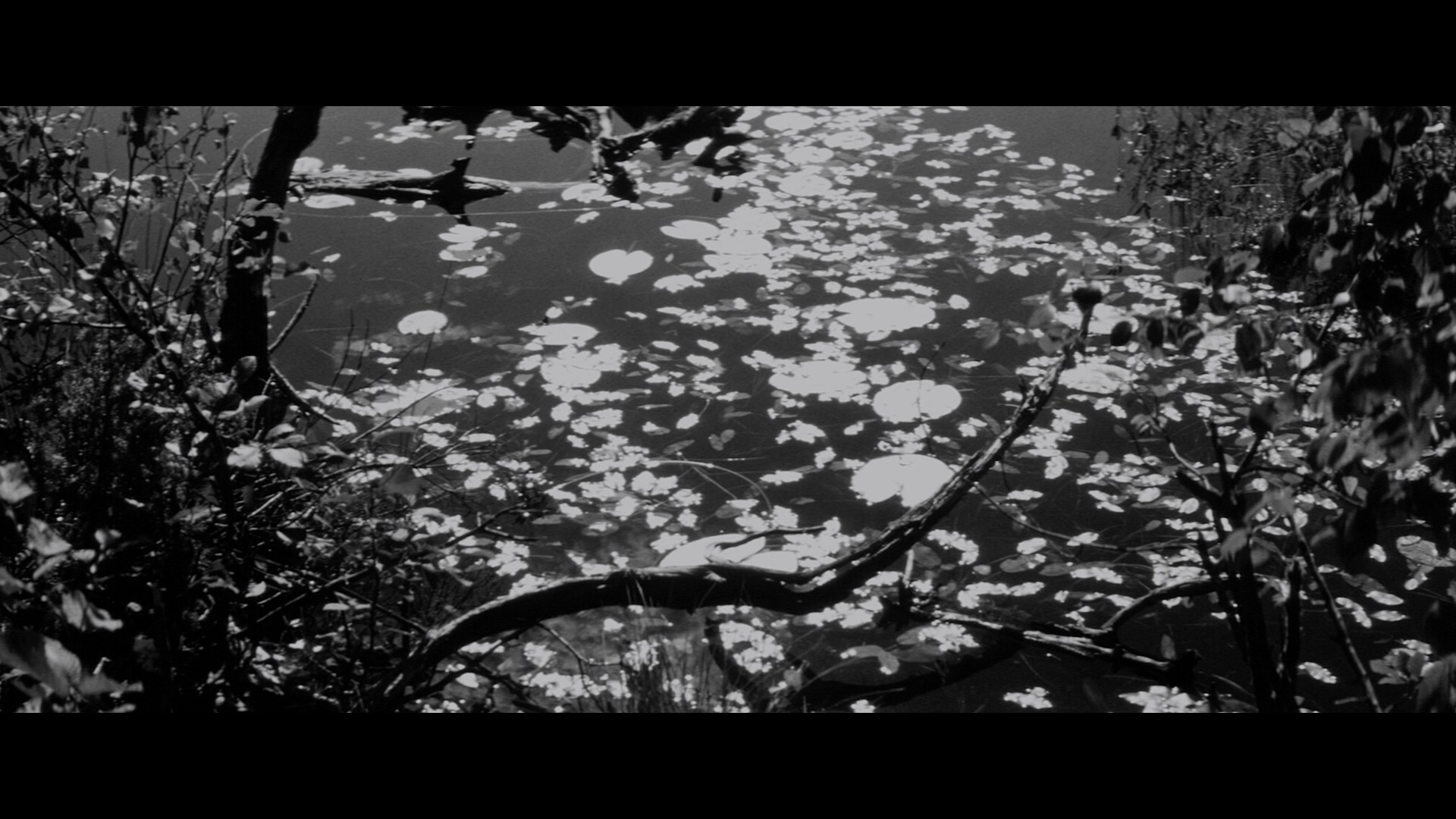
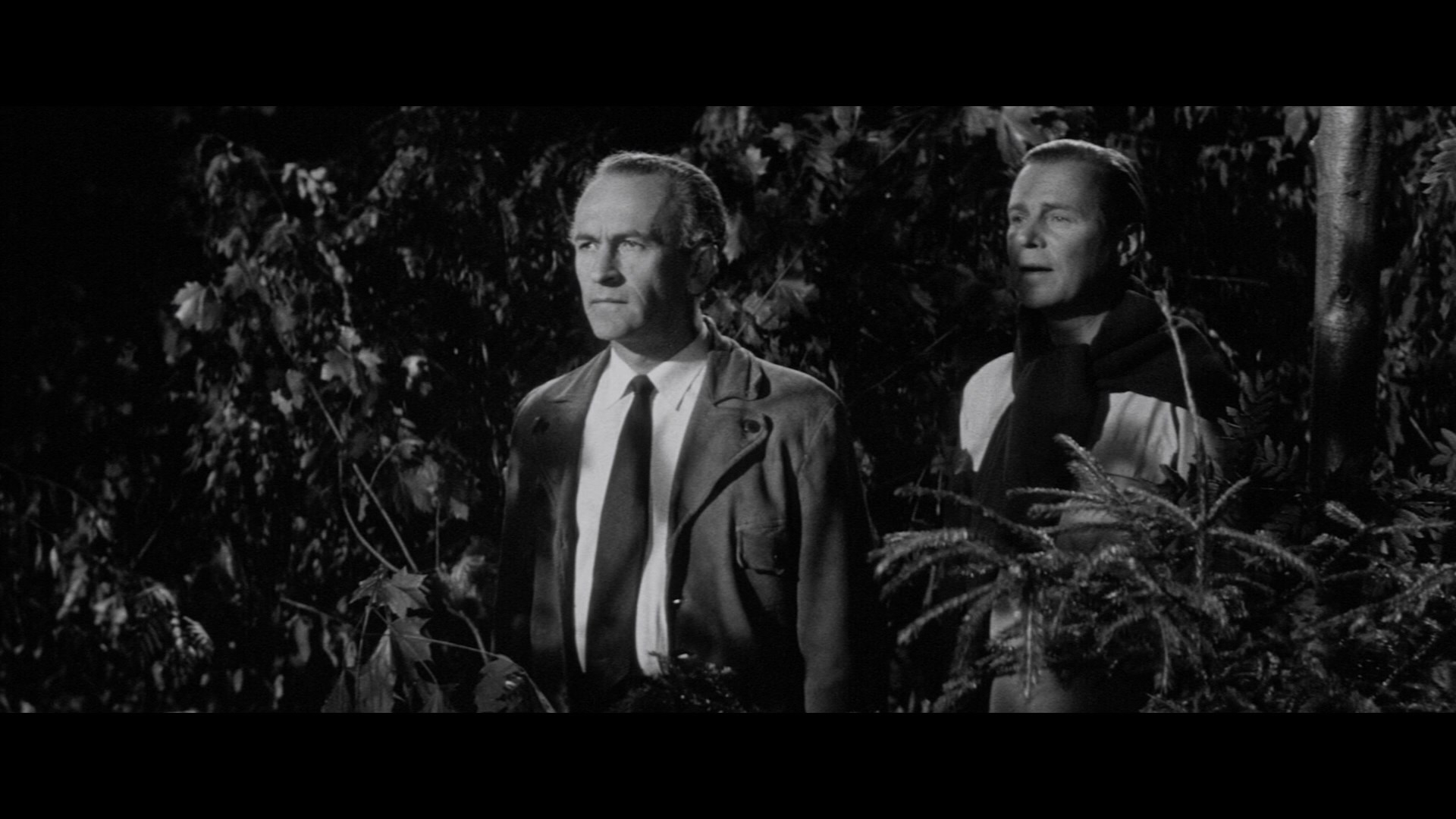
LAKE OF THE DEAD: Norsk Filmstudio (DVD)
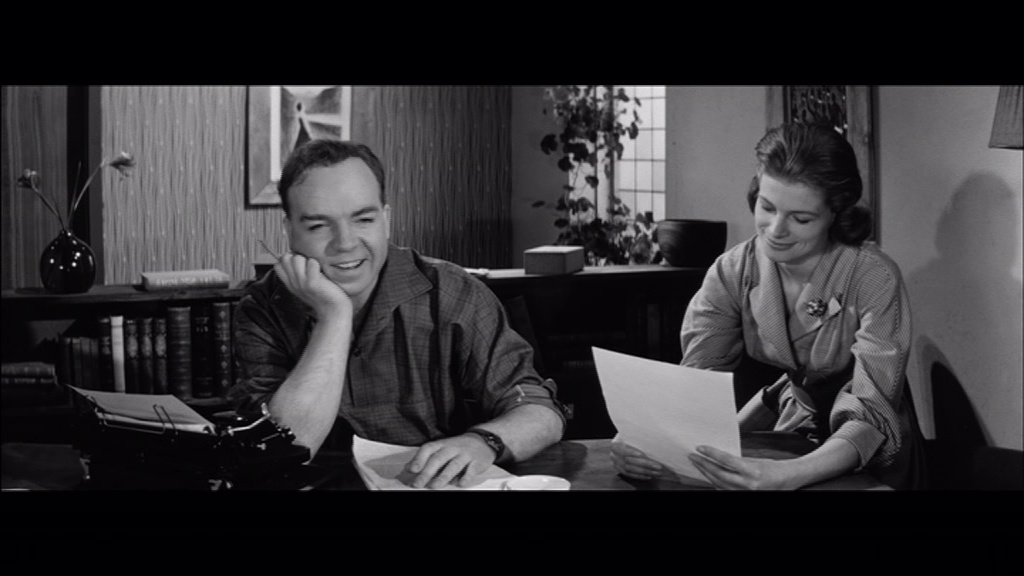
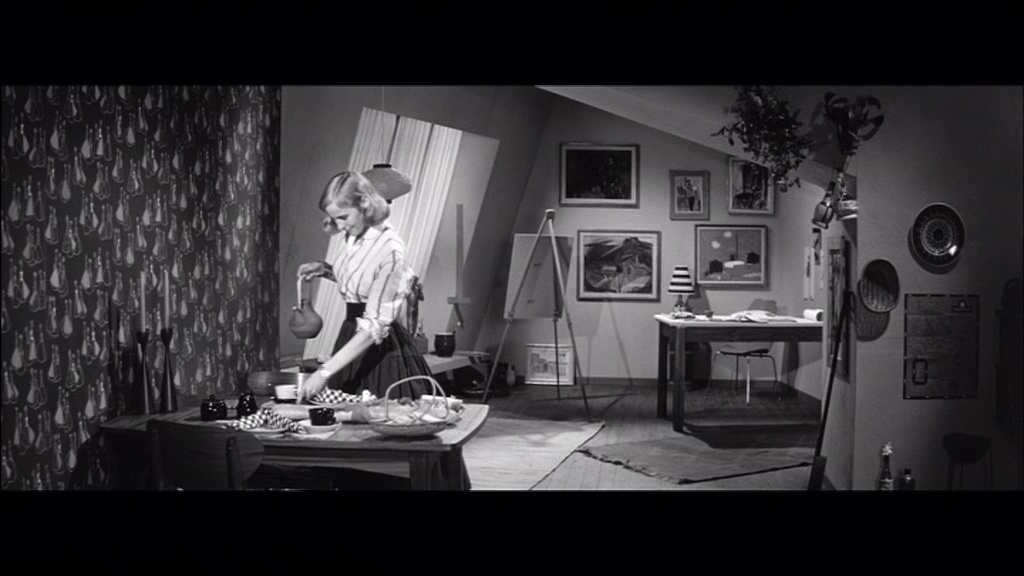
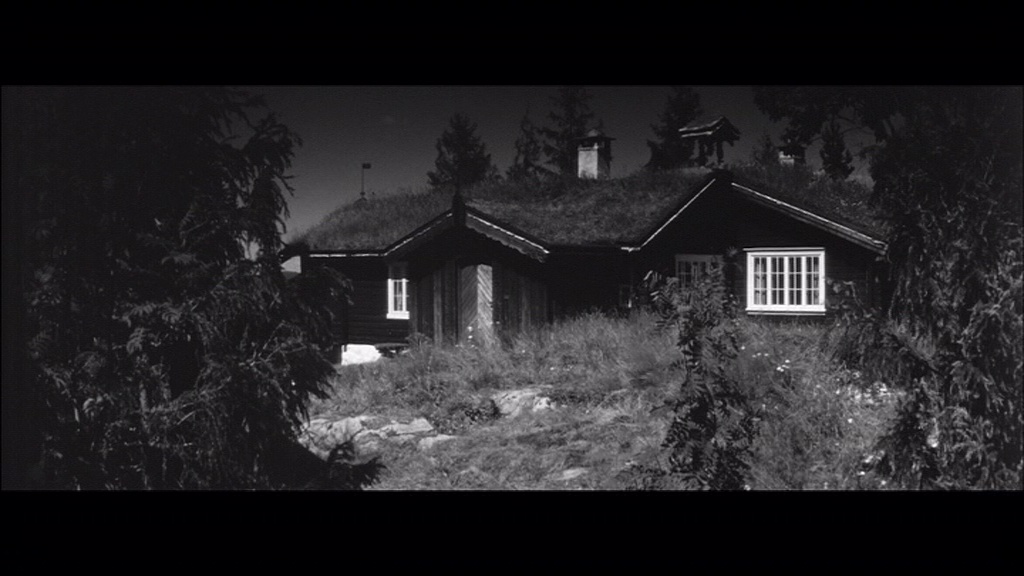
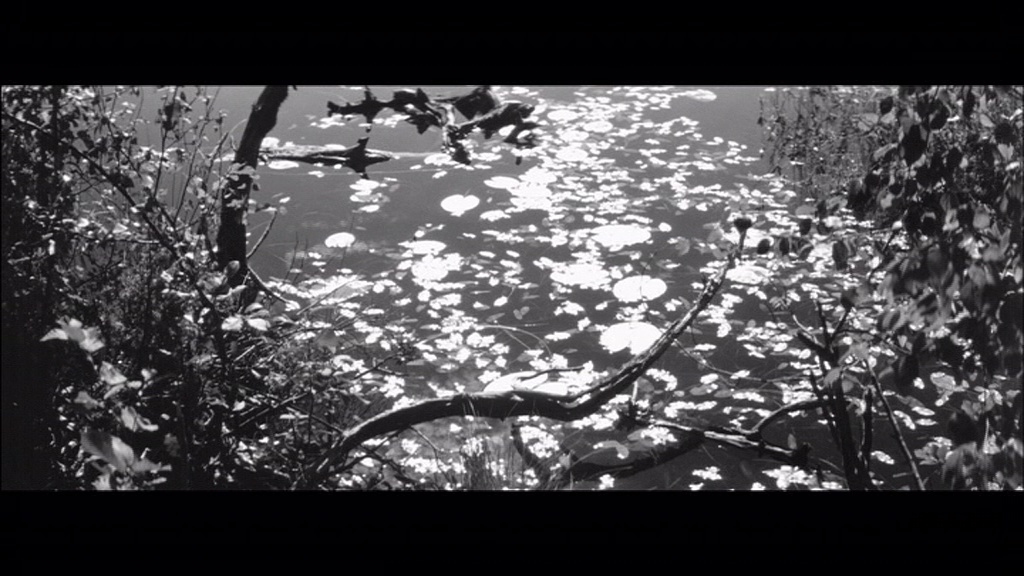
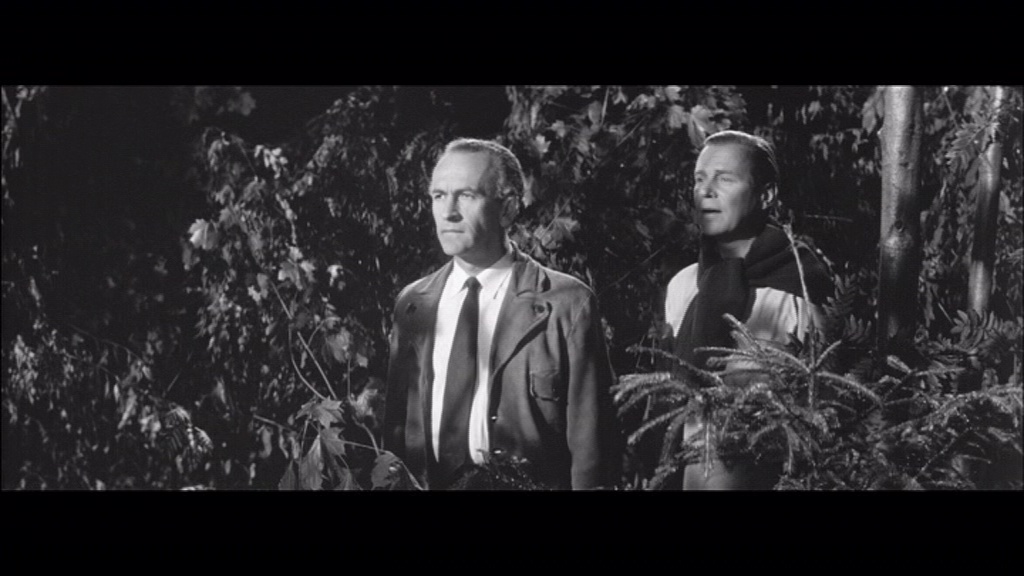
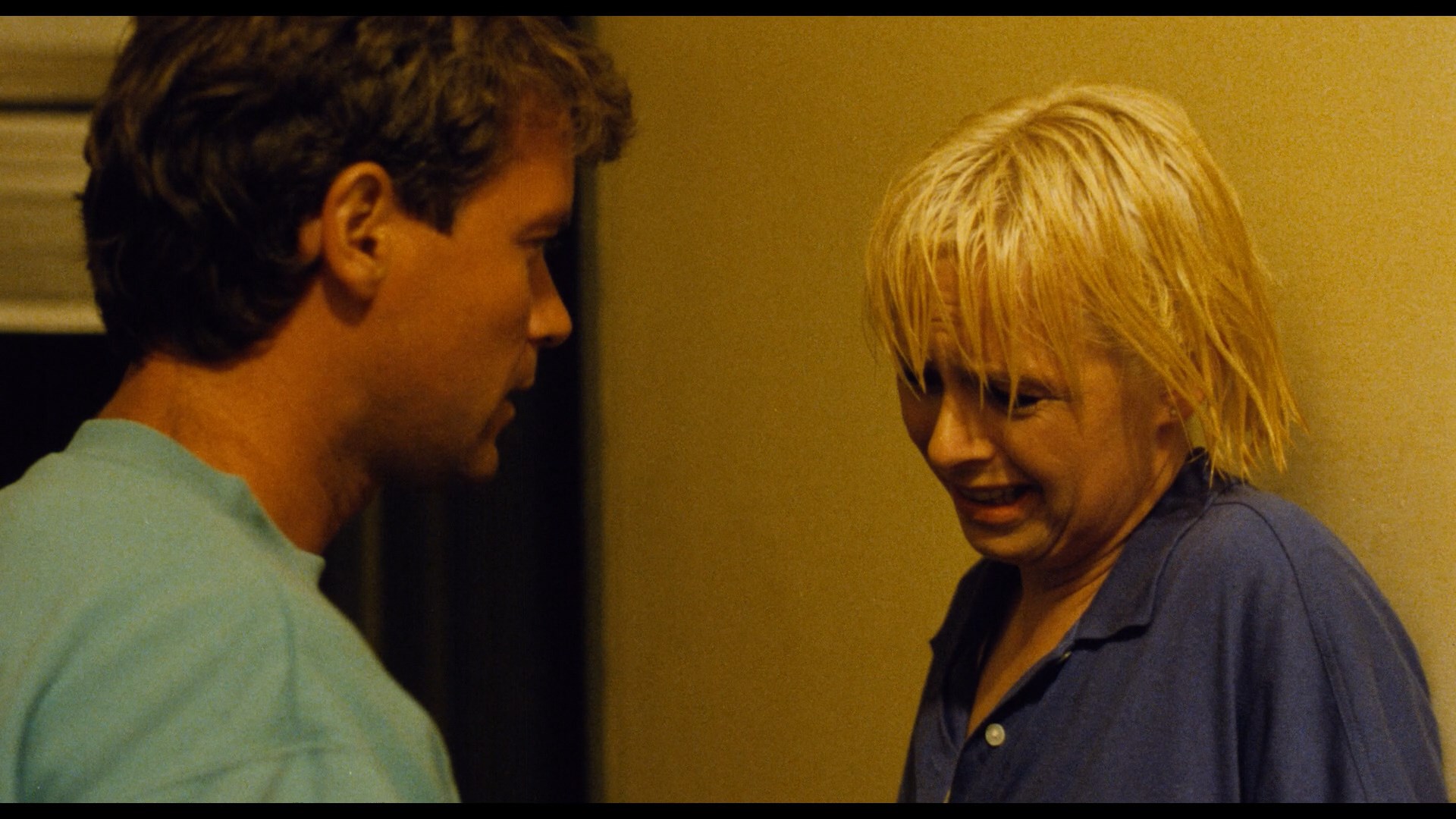 Disc six opens with 1988's The Dreaming,
Disc six opens with 1988's The Dreaming, 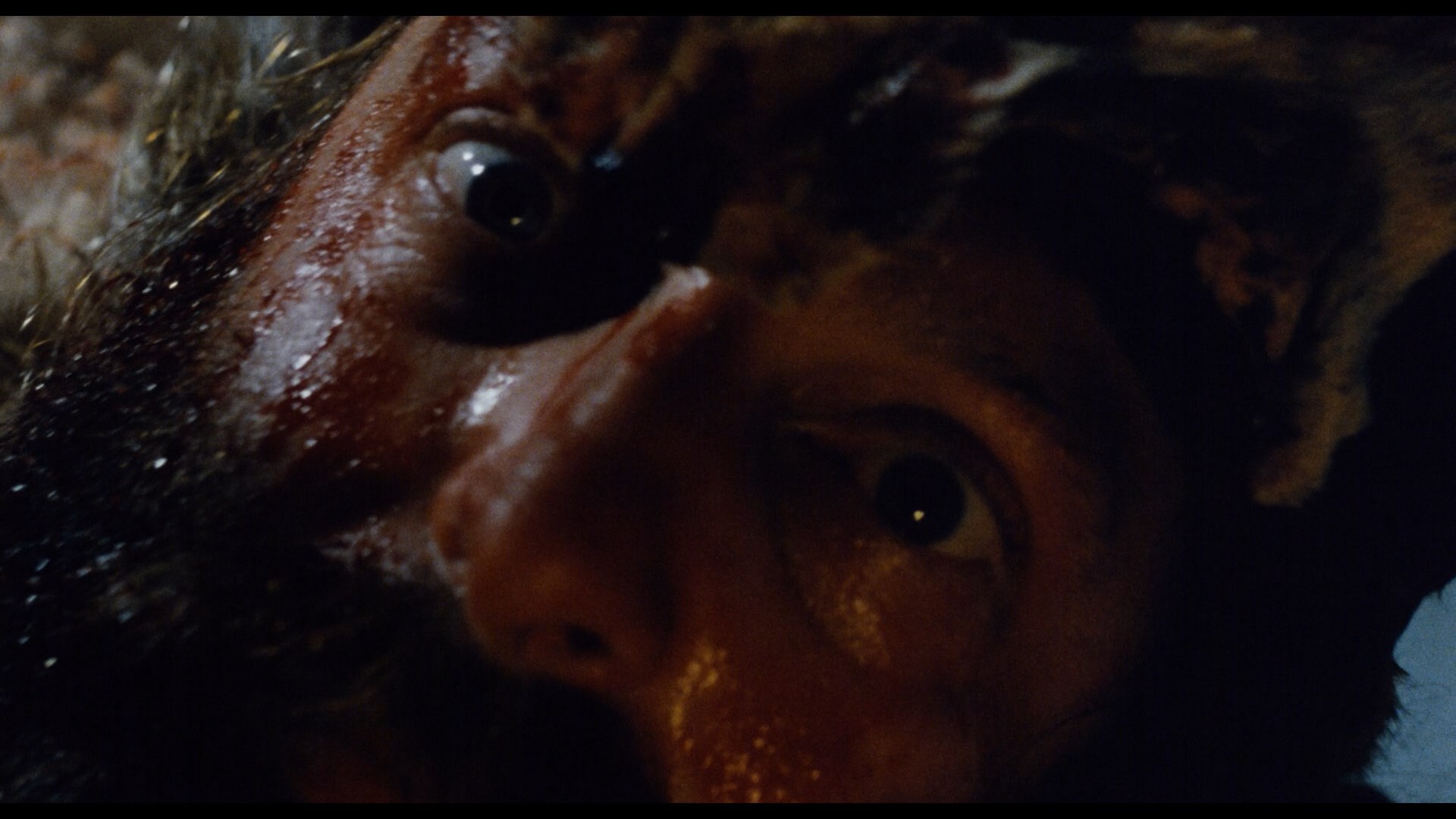 a title previously released on U.S. DVD twice starting with a non-anamorphic transfer from Elite Entertainment in their second Aussie Horror set. Basically it's another sins of the fathers supernatural story about the havoc unleashed when archaeologist Bernard Thornton (Dignam) mounts an expedition that opens up a centuries-old tomb filled with odd Aboriginal artifacts. A young girl is among some locals who try to break in to steal them from the museum a few months later, and when she winds up beaten to the point of death, her emergency doctor turns out to be Cathy (Cook), Thornton's daughter. When the girl dies, Cathy keeps seeing her crying and screaming at night and starts experiencing hallucinatory dreams involving long-dead whalers and the Australian coast where the tomb was first discovered. Even worse, people start turning up death including a guy transfixed by metal poles in the middle of a foggy street. And then there's her dad, who hasn't really been feeling quite himself lately...
a title previously released on U.S. DVD twice starting with a non-anamorphic transfer from Elite Entertainment in their second Aussie Horror set. Basically it's another sins of the fathers supernatural story about the havoc unleashed when archaeologist Bernard Thornton (Dignam) mounts an expedition that opens up a centuries-old tomb filled with odd Aboriginal artifacts. A young girl is among some locals who try to break in to steal them from the museum a few months later, and when she winds up beaten to the point of death, her emergency doctor turns out to be Cathy (Cook), Thornton's daughter. When the girl dies, Cathy keeps seeing her crying and screaming at night and starts experiencing hallucinatory dreams involving long-dead whalers and the Australian coast where the tomb was first discovered. Even worse, people start turning up death including a guy transfixed by metal poles in the middle of a foggy street. And then there's her dad, who hasn't really been feeling quite himself lately...
Senseless but visually striking, The Dreaming ties together a strange knot of horror and fantasy tropes with enough surreal shots thrown in at random to distract you from the fact that the actual nature of the evil is pretty muddled and seems to change its purpose every reel (a problem similar to another beautiful but conceptually confused film made the following year, The Church). The droning electronic score, desolate settings, and solid performances keep it above average, and it's especially fun to see a very young John Noble (as Bernard's boss), years before he chewed the scenery as the corrupt Denethor in the Lord of the Rings films and became a sci-fi 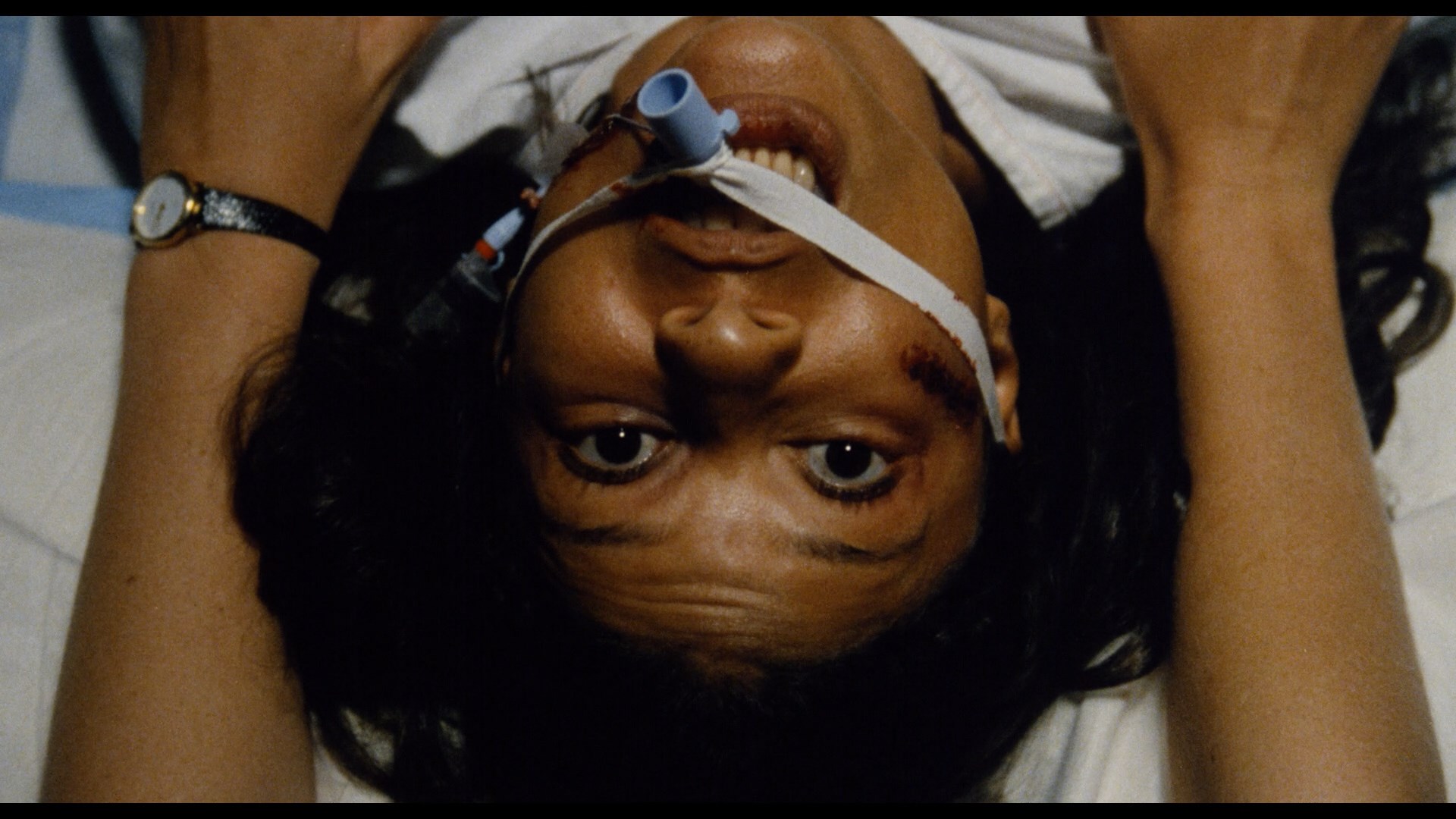 TV icon as Walter Bishop(s) on Fringe. Busy actor Gary Sweet (The Lighthorsemen, Nightmares) has a pretty thankless role as
TV icon as Walter Bishop(s) on Fringe. Busy actor Gary Sweet (The Lighthorsemen, Nightmares) has a pretty thankless role as  Cook's boyfriend, but he does get a great climactic scene at night involving a seemingly abandoned schooner. Though not overly explicit, this one has been slammed by several critics as bloodless, which is hardly true; there's a moderate amount of the red stuff, though nothing that would get this thrown off of mainstream TV.
Cook's boyfriend, but he does get a great climactic scene at night involving a seemingly abandoned schooner. Though not overly explicit, this one has been slammed by several critics as bloodless, which is hardly true; there's a moderate amount of the red stuff, though nothing that would get this thrown off of mainstream TV.
Considering the Elite DVD release was nothing special, the 2013 Scorpion version is bound to be an upgrade with what is apparently the first anamorphic widescreen presentation anywhere in the world (especially given this was dumped straight to video even in Australia). Image quality looks solid considering the nature of late '80s film stock; it's not a slick film by any stretch, but the transfer itself appears to be a good one. As usual, hostess Katarina Leigh Waters enthusiastically introduces the film with some Aussie-themed outfits and covers the basics of the cast and crew while pointing out a pretty major plot hole in her outro following the closing credits. That release is paired up with the non-horror film Initiation and also features an interview with producer Anthony Ginnane (10m52s). The Severin version features a new 2K scan from what's cited as the best surviving 35mm print, and it does indeed improve on the earlier releases with more robust color timing and better black levels. Signs of debris are obvious on and off including specks and a couple of green lines that pop up for a minute, but it's definitely the best this has looked to date. As with all the other English-language titles here, the DTS-HD MA track (2.0 mono here) is as good as the source will allow and comes with optional yellow English subtitles. Apart from the trailer, the one extra here is a new commentary with director Mario Andreacchio in discussion with Jarret Gahan about the nature of government film funding in Australia at the time, the execution of the elaborate helicopter shots, the touchy nature of the subject matter that caused issues for distribution at the time, the one producer whose insisted on removing 12 script 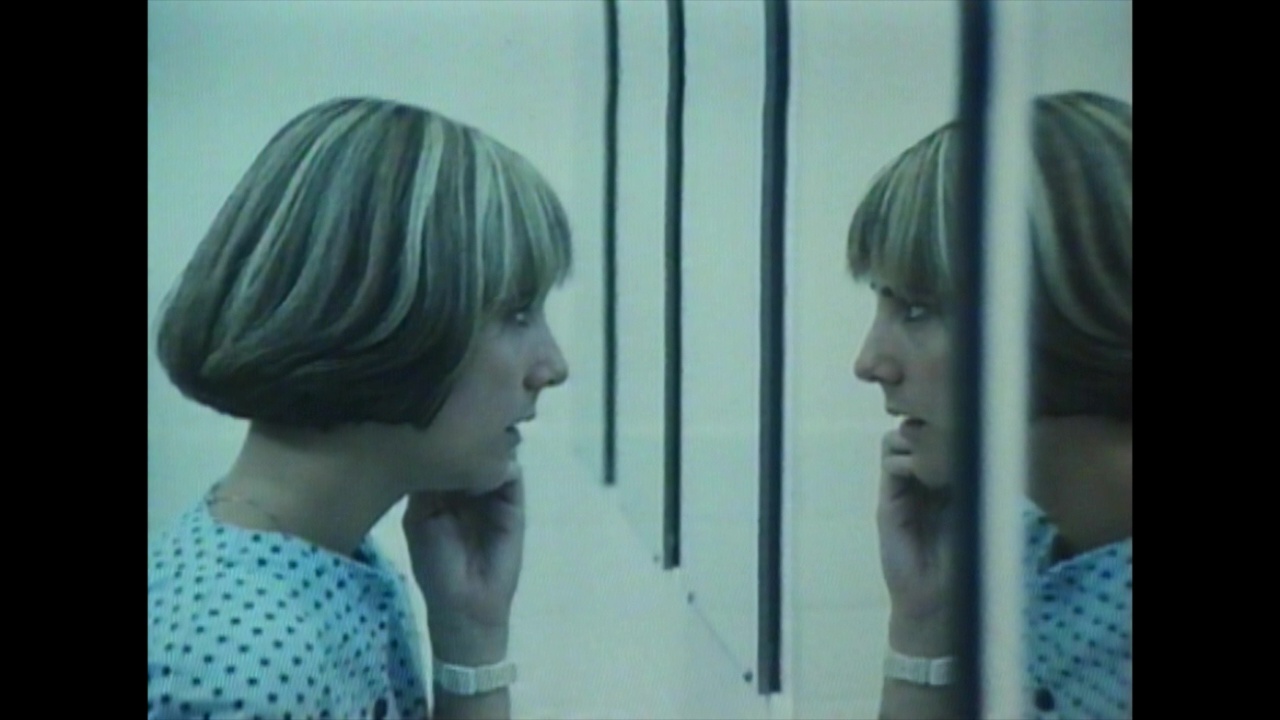 pages involving incest (which would account for
pages involving incest (which would account for 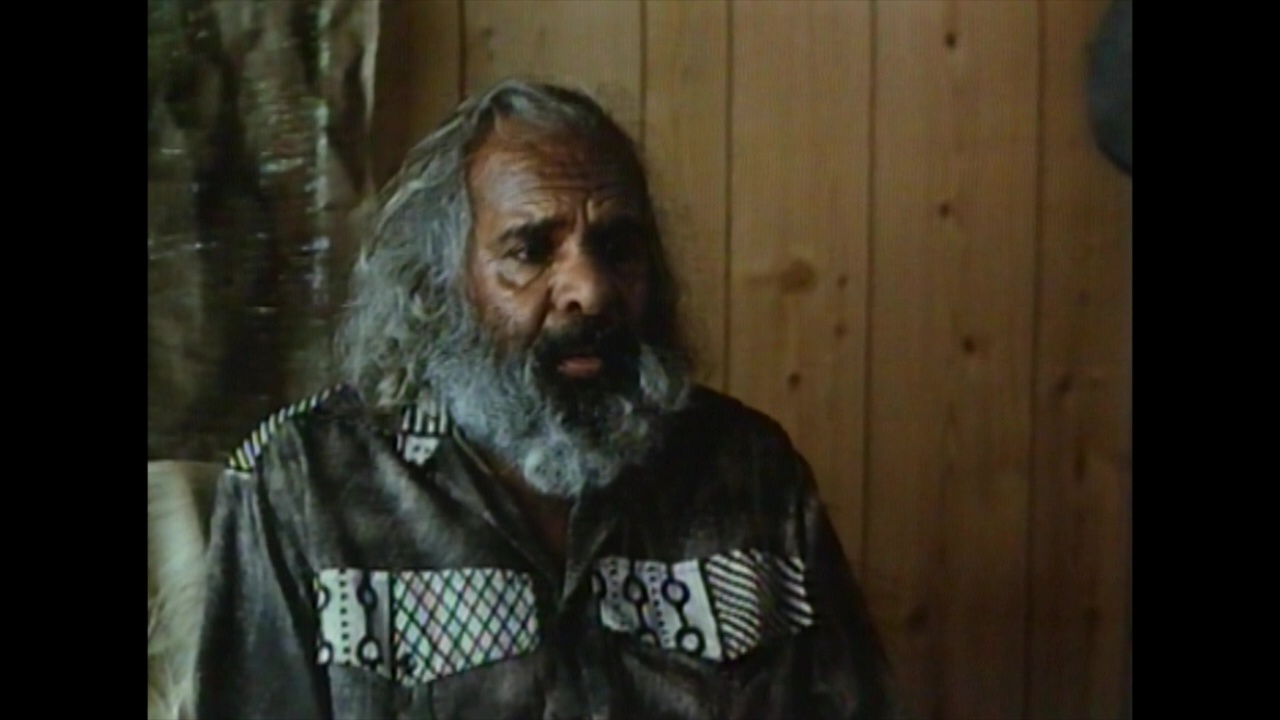 much of the puzzling narrative bits in the finished product), and more.
much of the puzzling narrative bits in the finished product), and more.
Also on the same disc is 1988's Kadaicha, which sometimes did the rounds on VHS as Stones of Death. Essentially this is an Aussie riff on the whole "cursed ancient burial ground" thing (covered in depth in the Woodlands doc, of course) which is most famous in its Native American iteration from films like Poltergeist and Pet Sematary. There's also a nearly bloodless body count angle thrown in here as well, but the execution is pretty listless and would account for why this one's been fairly obscure for so long. Basically a bunch of teenagers (most of whom would look too old even in Grease) are being visited in their dreams by a mystical Aborigine who gives them a stone that foretells a terrible fate in store for them, which all ties in with the new land development built over holy ground that lots of folk are moving into. Various primal elements like insects come into play as some of the kids start to die, which leaves the survivors racing against the clock to figure out how to atone for the sins of their parents.
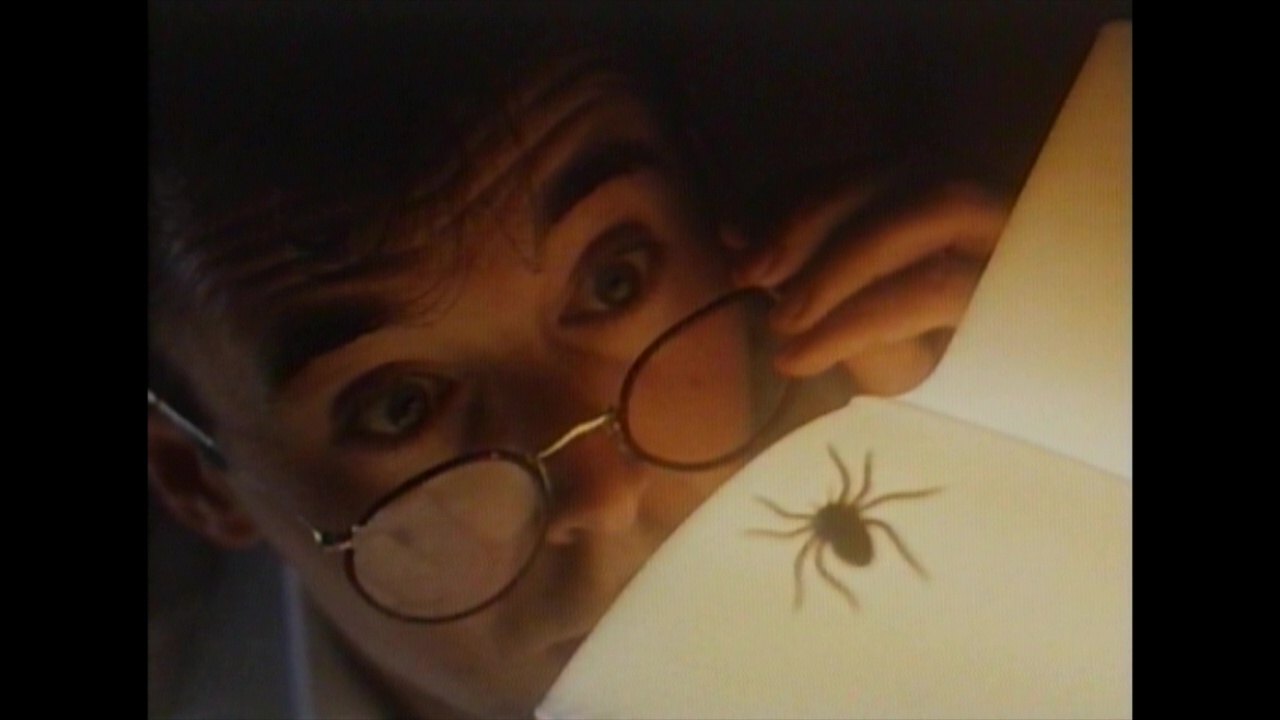 Though the social commentary element here sets it apart from the pack a bit, this is otherwise
Though the social commentary element here sets it apart from the pack a bit, this is otherwise 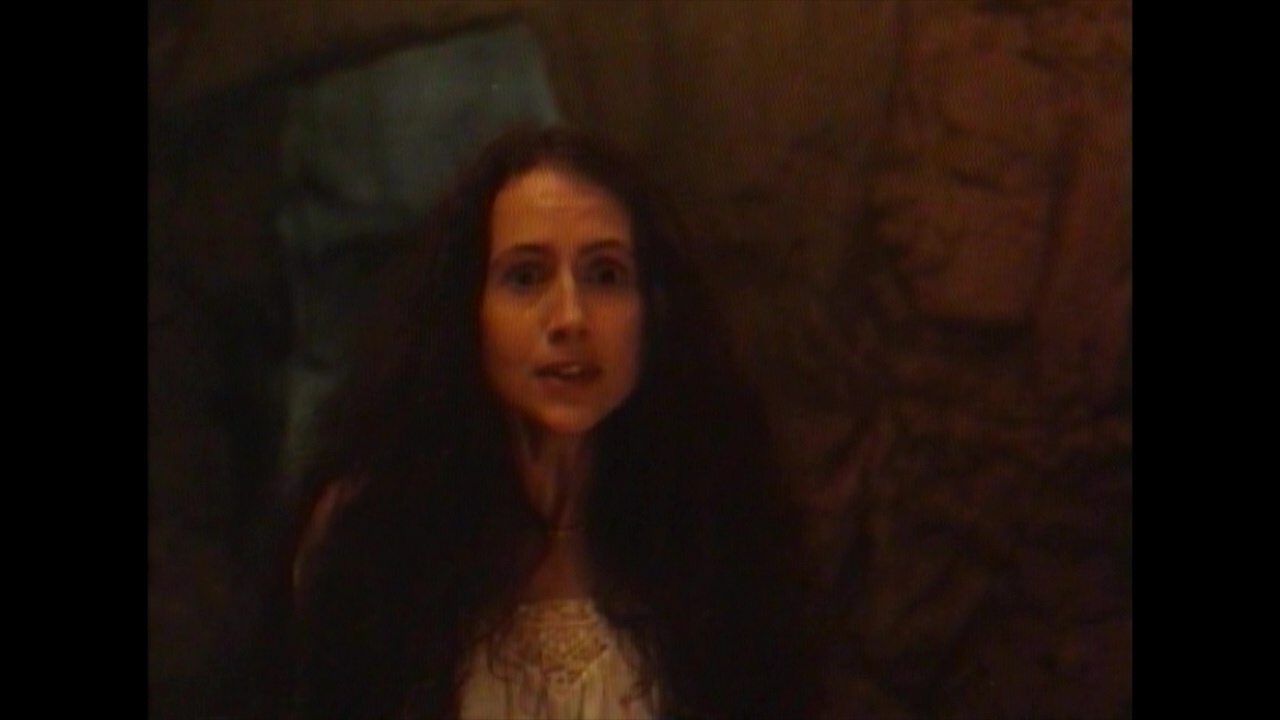 a by-the-numbers late '80s offering that also went straight to VHS back in the day. Umbrella brought it to DVD back in 2017 as a double feature with the fun P.J. Soles slasher film Innocent Prey, with both films' trailers as the only extras. Unfortunately it appears film elements were kept around for this film, so it was presented from a very dated, drab-looking video master. The Severin is listed as being "mastered from the only surviving broadcast quality video master," and it looks... well, quite different from the DVD at least; it's darker and a lot cooler in color temperature, so check out the grabs below to see how they compare. Either way it's too bad there's nothing better left as the film might play more enjoyably if you could see what was going on more clearly. However, this one gets more special features than a lot of its companions in the set starting with an audio commentary with director James Bogle and Fatal Visions writer Michael Helms, with the filmmaker talking about his self-taught path up from working as a camera assistant, the state of late '80s Aussie filmmaking, the very surprising career trajectories of some of the participants after this, and the stories behind the major actors. In "The Final Girl of Kadaicha" (13m8s), Jarret Gahan conducts an audio interview with actress Zoe Carides about her memories of her director at the same time as her sister after meeting him at a party, her role preparation, her faint memories of the rehearsal process, and the allowances for improvisation. "Composing Kadaicha" (17m34s) is another audio interview by Gahan, this time with composer Peter Westheimer explaining how a violin in childhood set him on a musical path and his various journeys in the worlds of film and television. "Behind the Scenes of Kadaicha" (7m5s) offers a fun batch of VHS-shot coverage of the film shoot, with everyone in high spirits as they do a couple of key scenes including the fog-shrouded cave scenes with a very loud on-set didgeridoo. Finally the disc closes out with the original trailer.
a by-the-numbers late '80s offering that also went straight to VHS back in the day. Umbrella brought it to DVD back in 2017 as a double feature with the fun P.J. Soles slasher film Innocent Prey, with both films' trailers as the only extras. Unfortunately it appears film elements were kept around for this film, so it was presented from a very dated, drab-looking video master. The Severin is listed as being "mastered from the only surviving broadcast quality video master," and it looks... well, quite different from the DVD at least; it's darker and a lot cooler in color temperature, so check out the grabs below to see how they compare. Either way it's too bad there's nothing better left as the film might play more enjoyably if you could see what was going on more clearly. However, this one gets more special features than a lot of its companions in the set starting with an audio commentary with director James Bogle and Fatal Visions writer Michael Helms, with the filmmaker talking about his self-taught path up from working as a camera assistant, the state of late '80s Aussie filmmaking, the very surprising career trajectories of some of the participants after this, and the stories behind the major actors. In "The Final Girl of Kadaicha" (13m8s), Jarret Gahan conducts an audio interview with actress Zoe Carides about her memories of her director at the same time as her sister after meeting him at a party, her role preparation, her faint memories of the rehearsal process, and the allowances for improvisation. "Composing Kadaicha" (17m34s) is another audio interview by Gahan, this time with composer Peter Westheimer explaining how a violin in childhood set him on a musical path and his various journeys in the worlds of film and television. "Behind the Scenes of Kadaicha" (7m5s) offers a fun batch of VHS-shot coverage of the film shoot, with everyone in high spirits as they do a couple of key scenes including the fog-shrouded cave scenes with a very loud on-set didgeridoo. Finally the disc closes out with the original trailer.
THE DREAMING: Severin (Blu-ray)
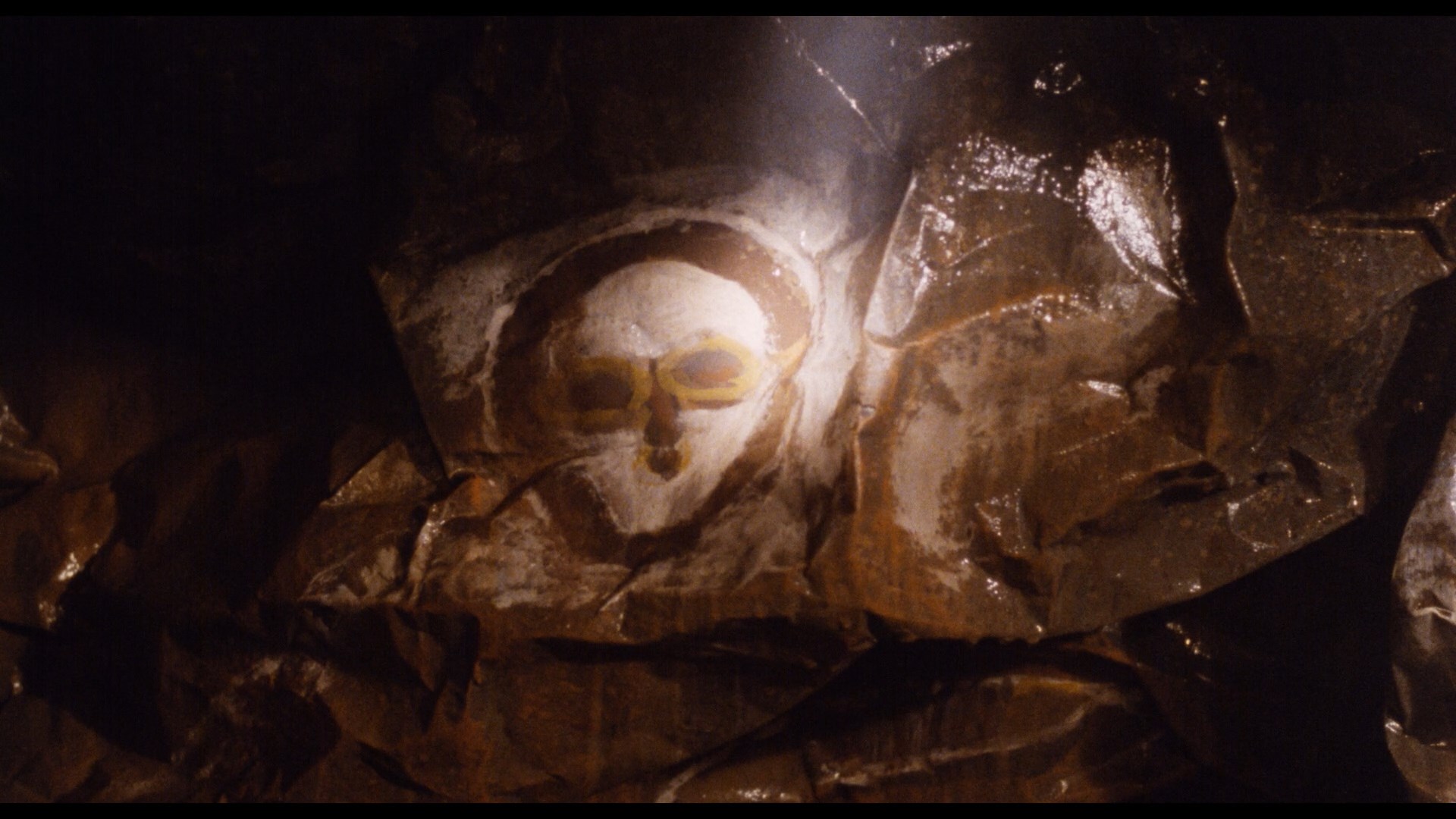
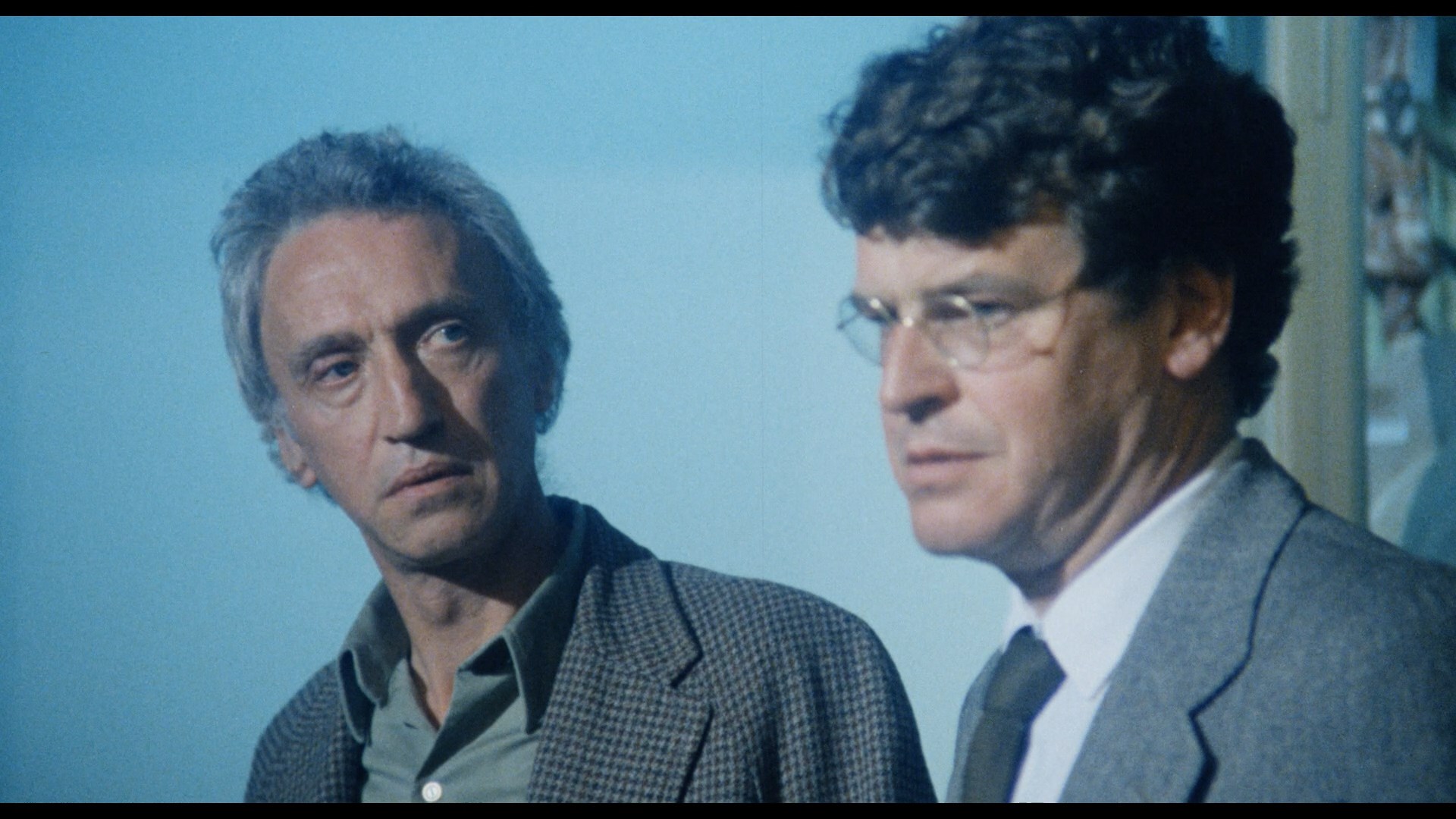
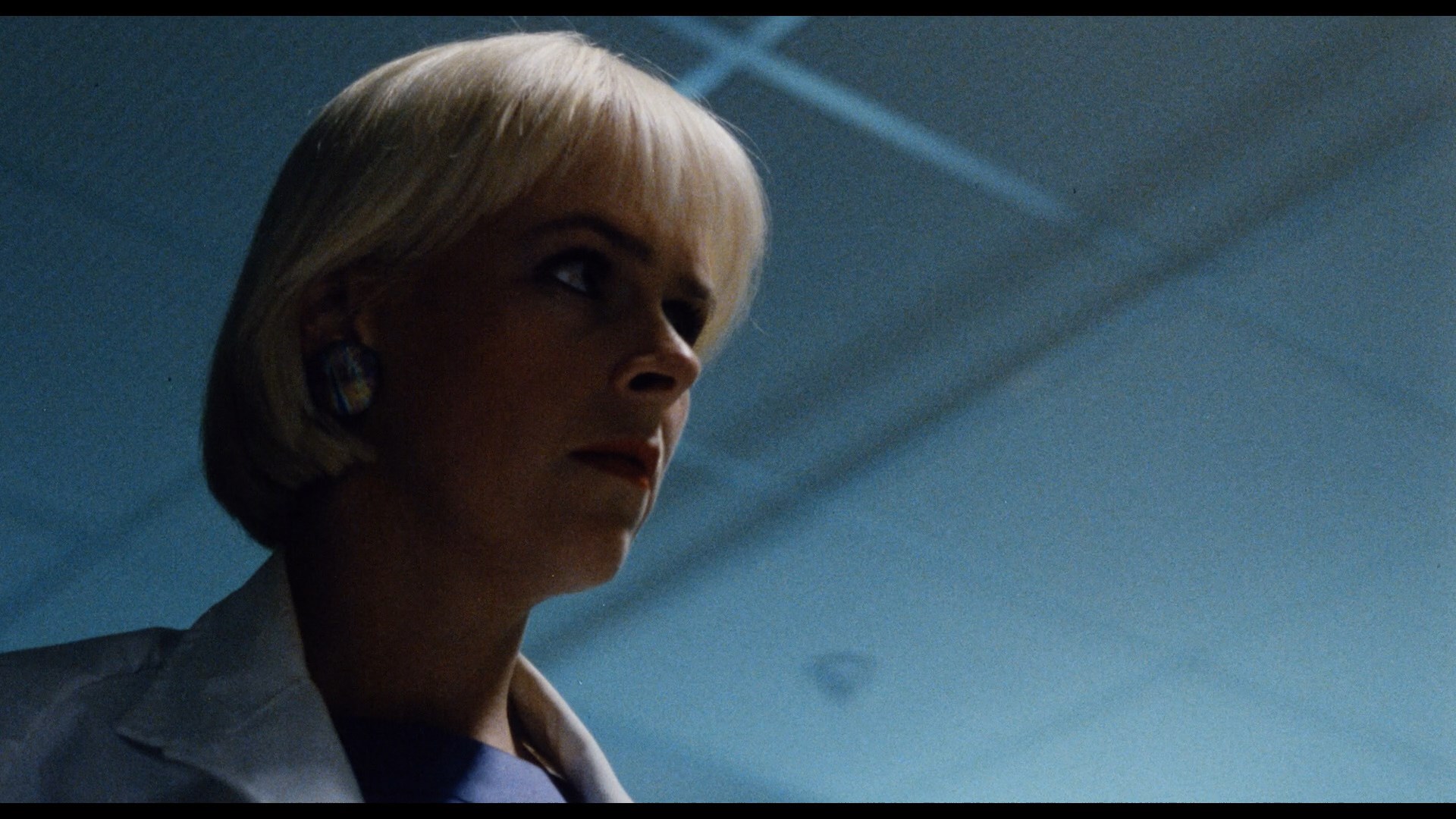
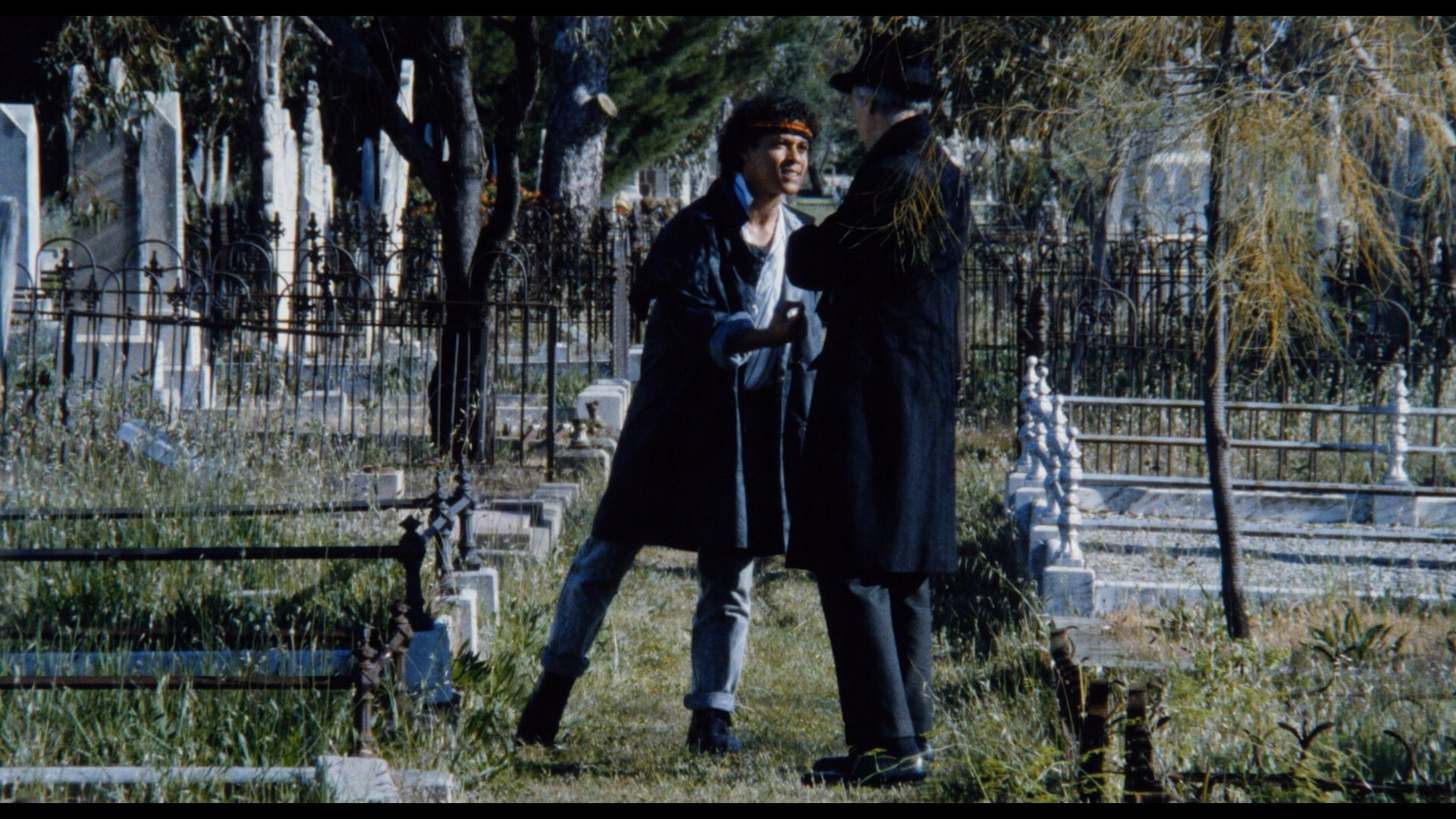
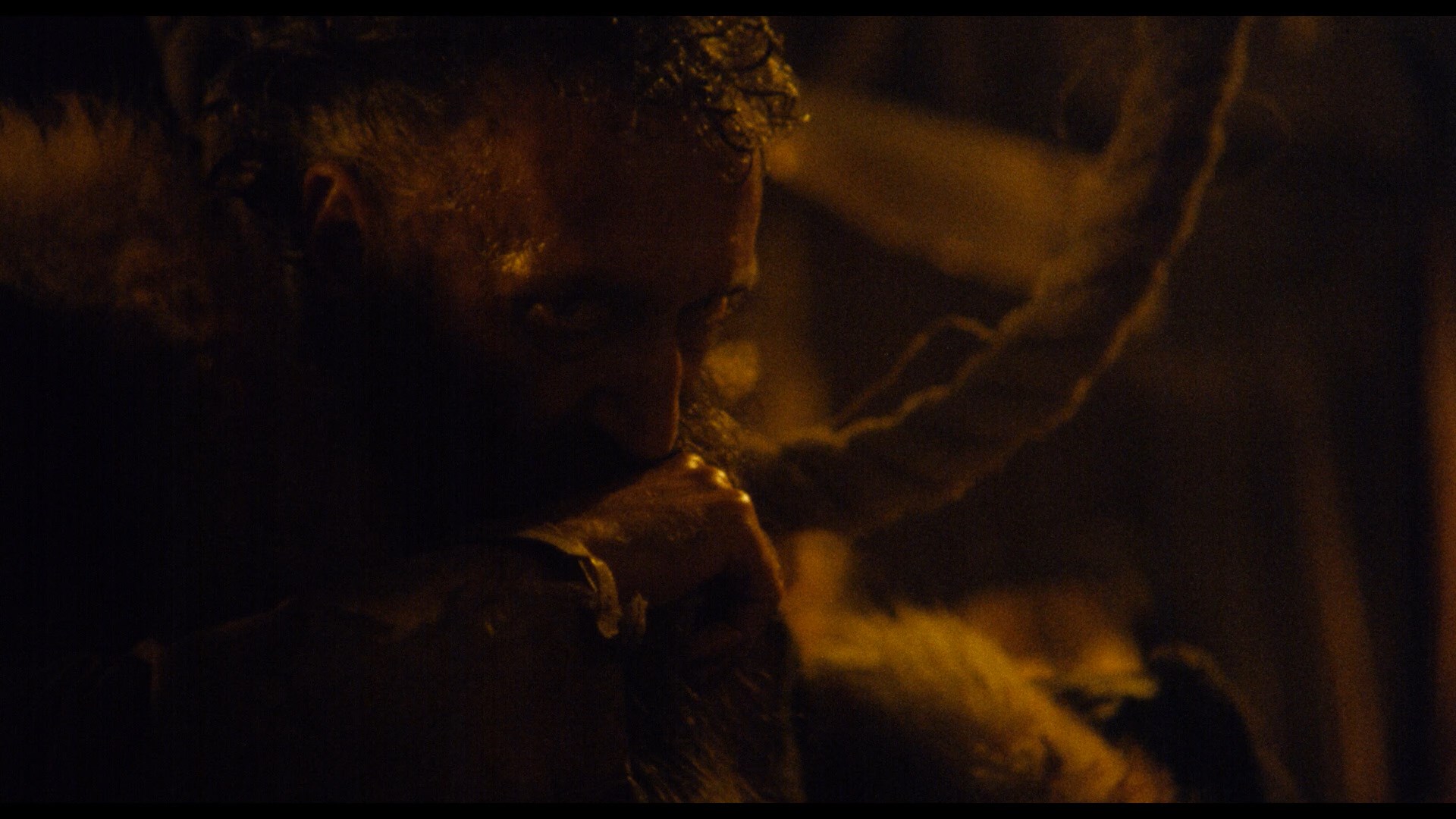
THE DREAMING: Scorpion Releasing (DVD)
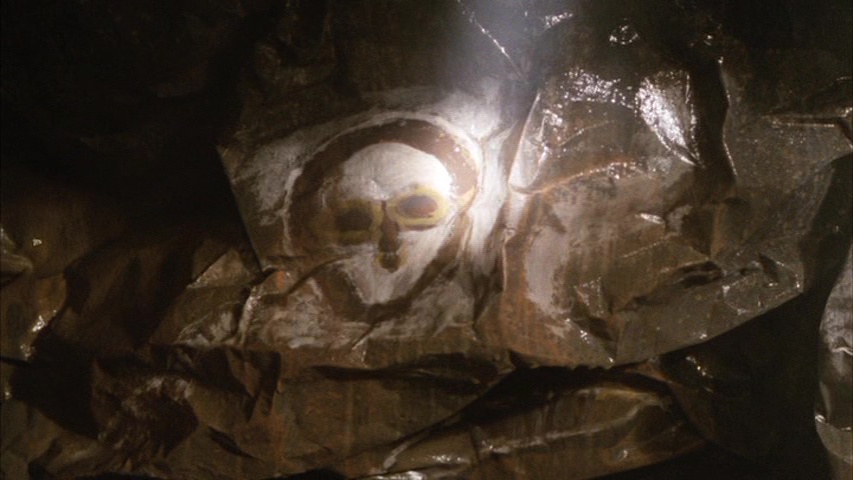
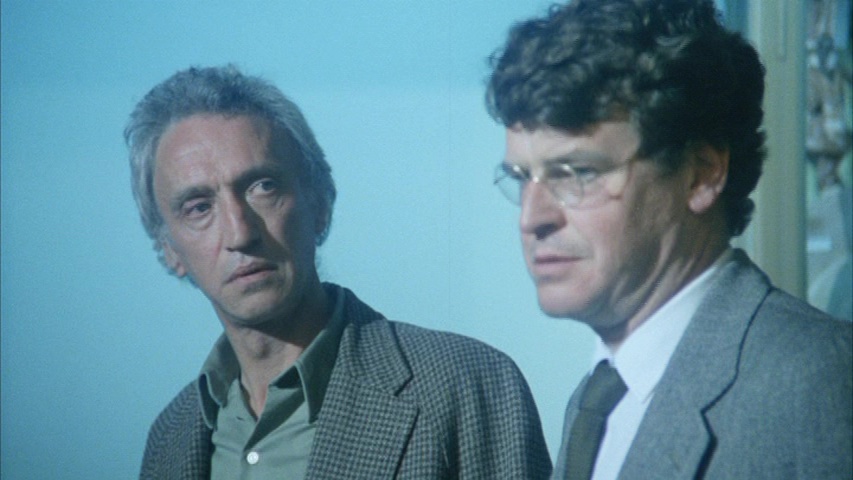
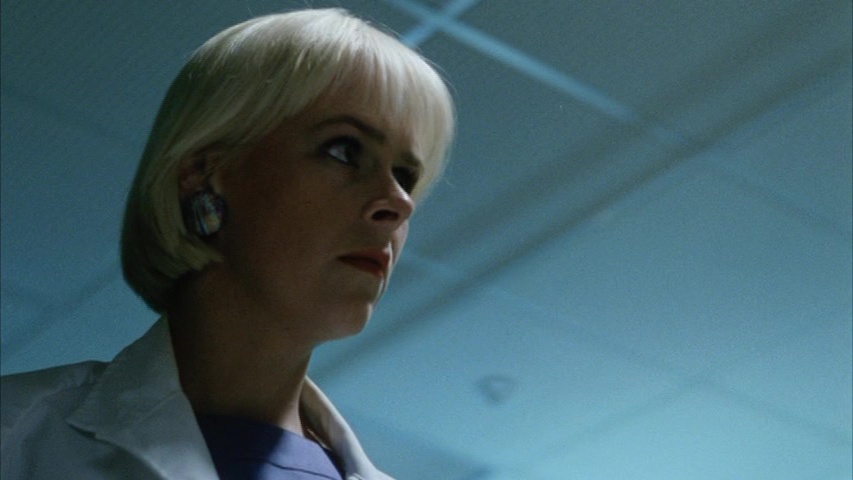
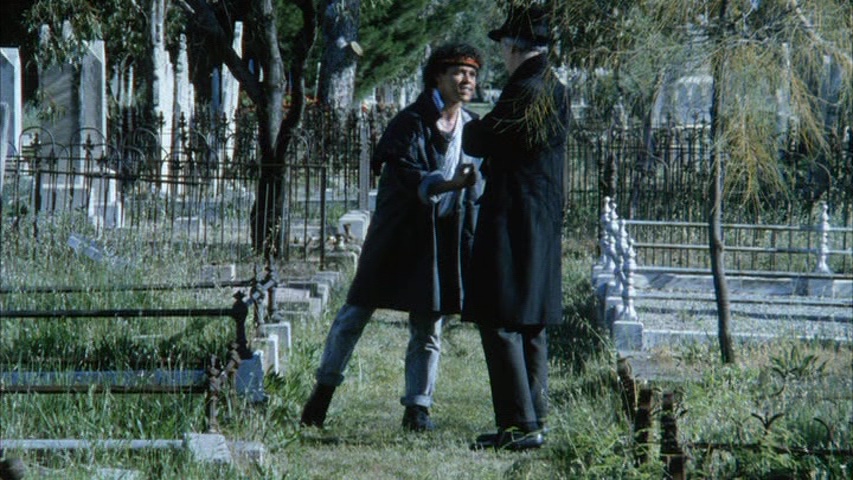
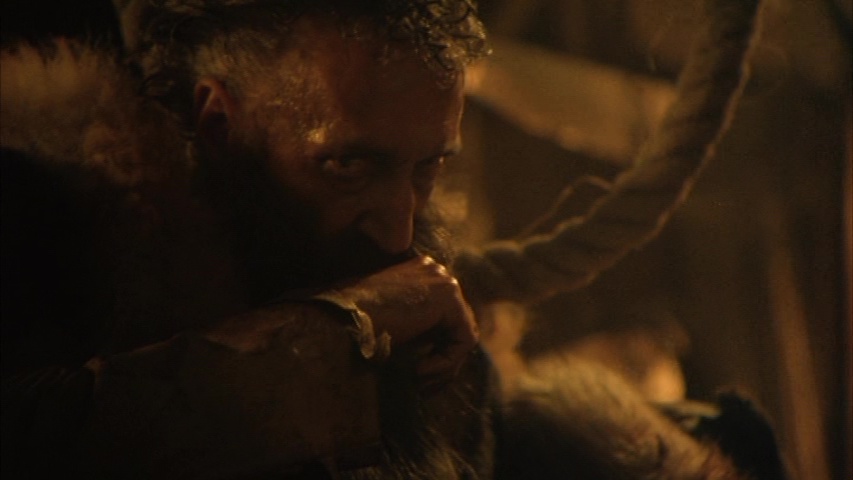
KADAICHA: Severin (Blu-ray)
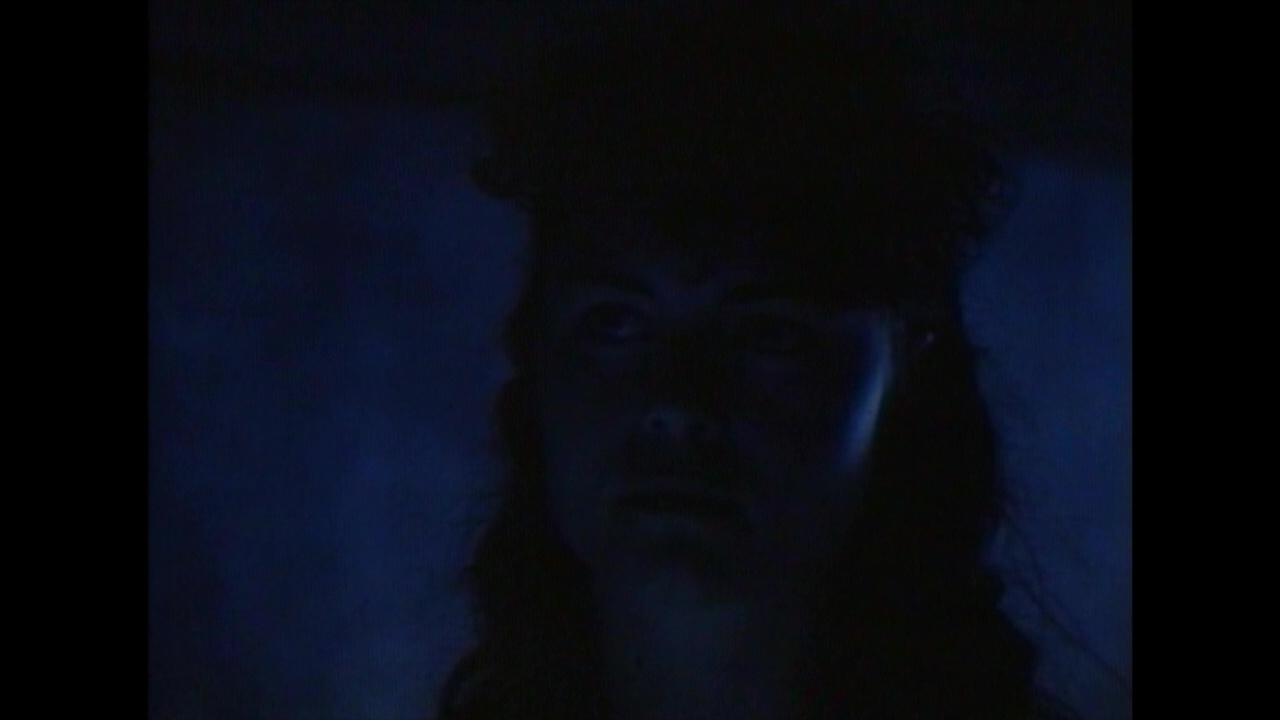
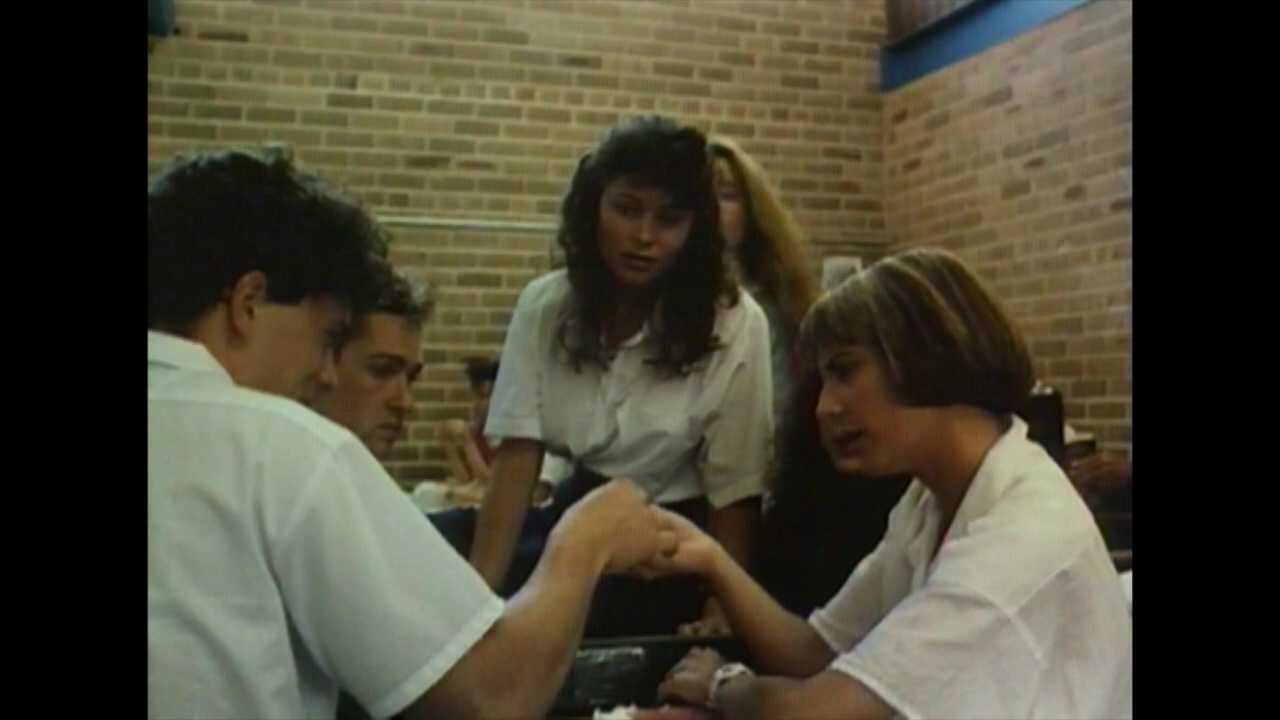
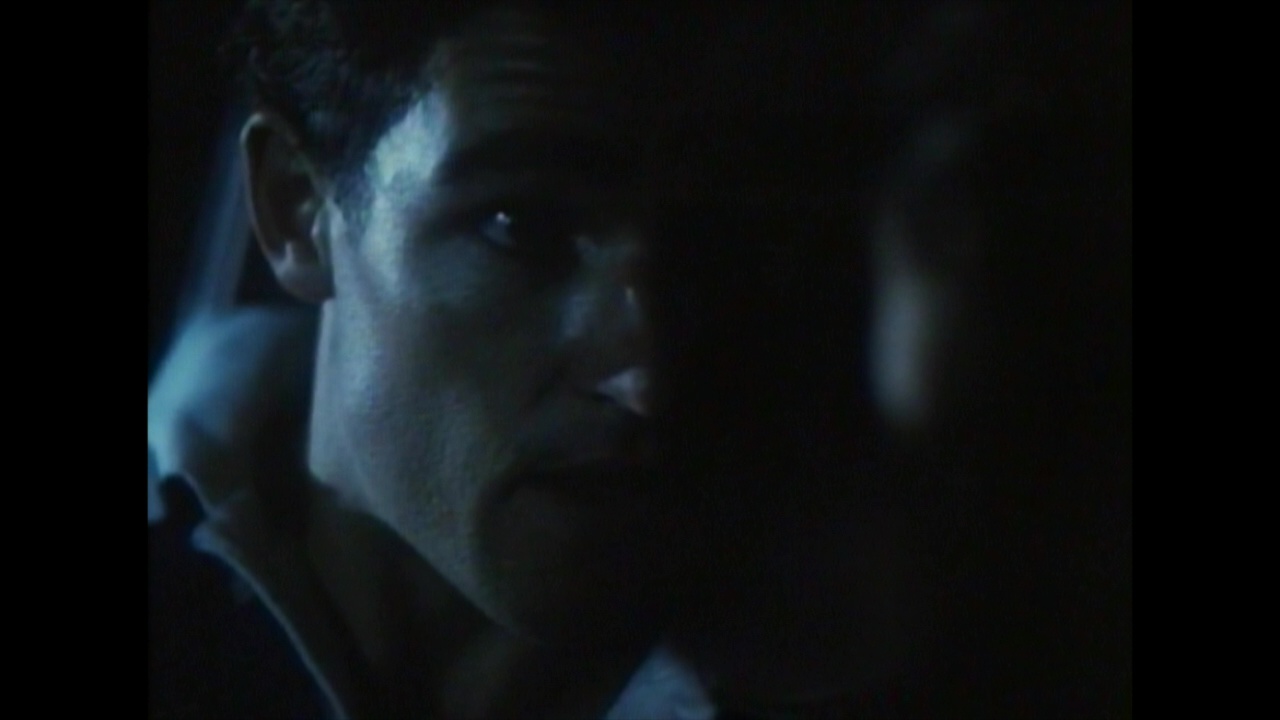
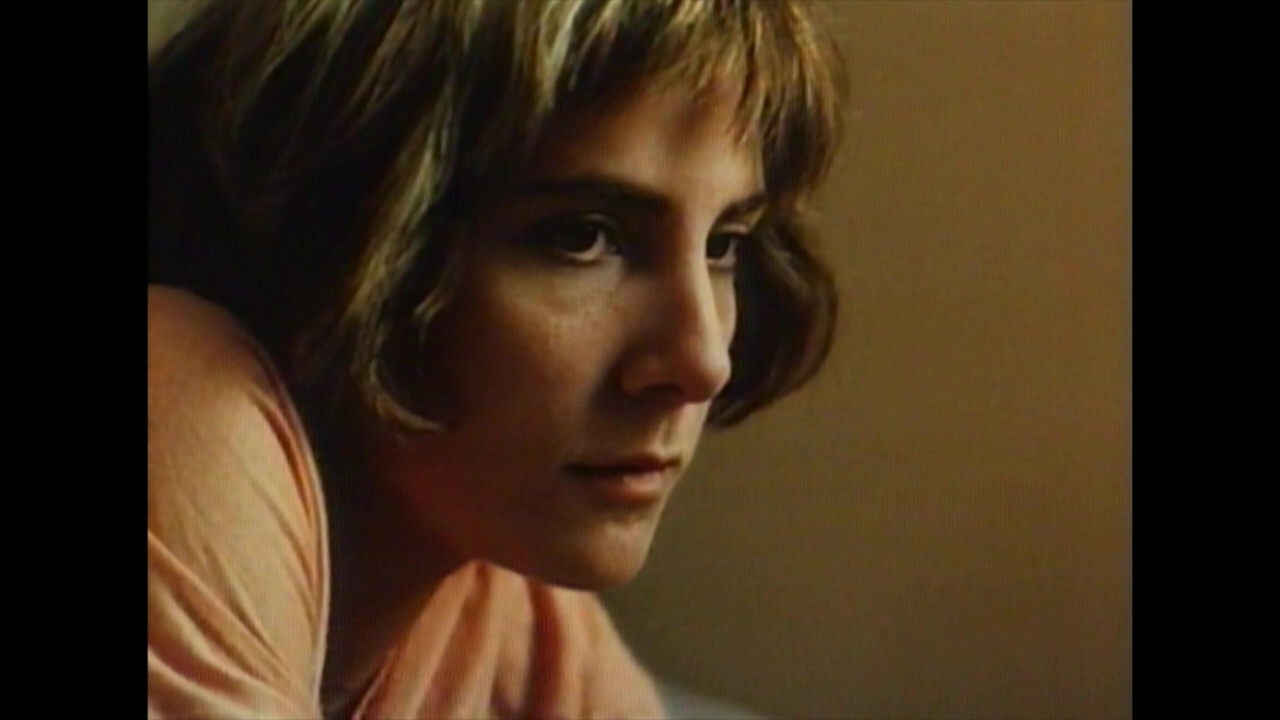
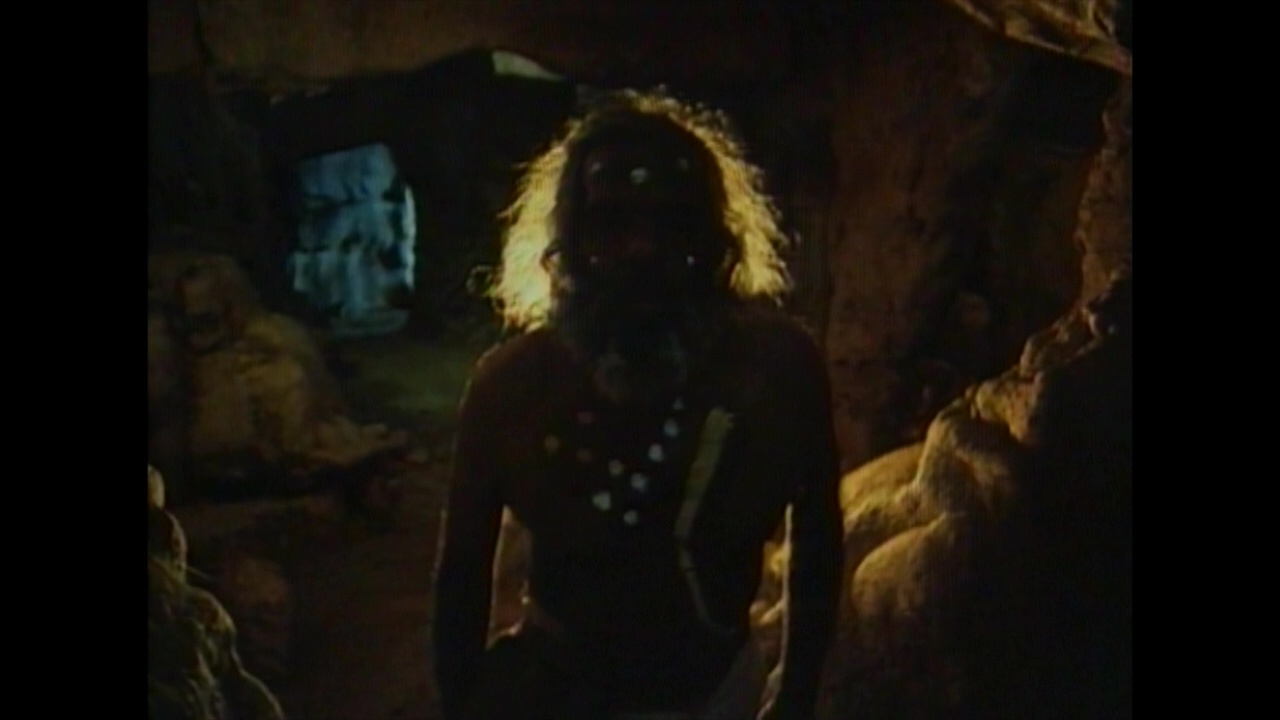
KADAICHA: Umbrella (DVD)
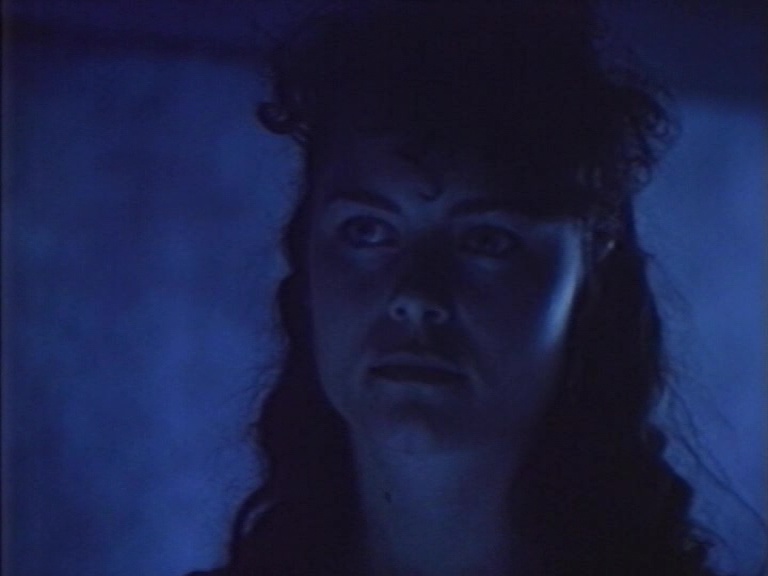
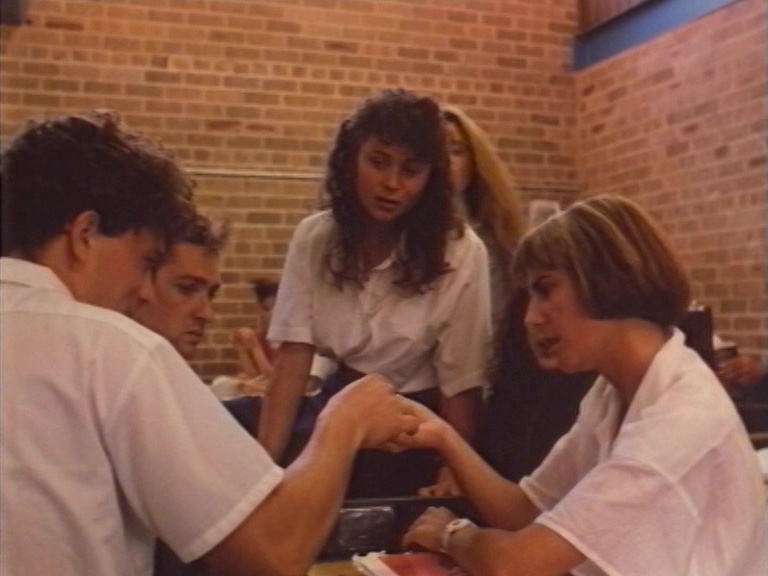
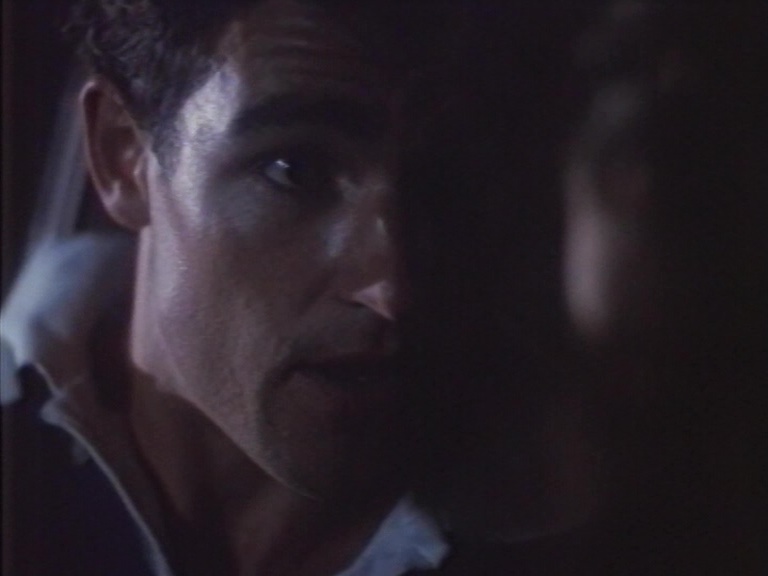
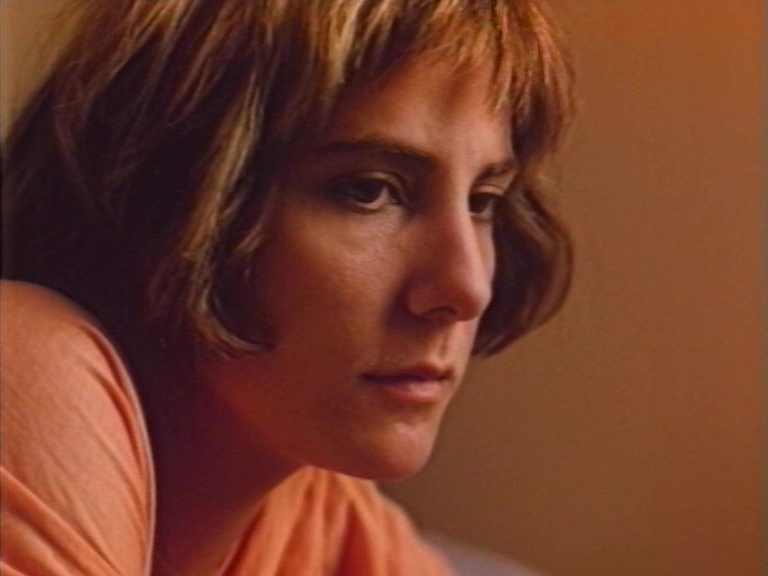
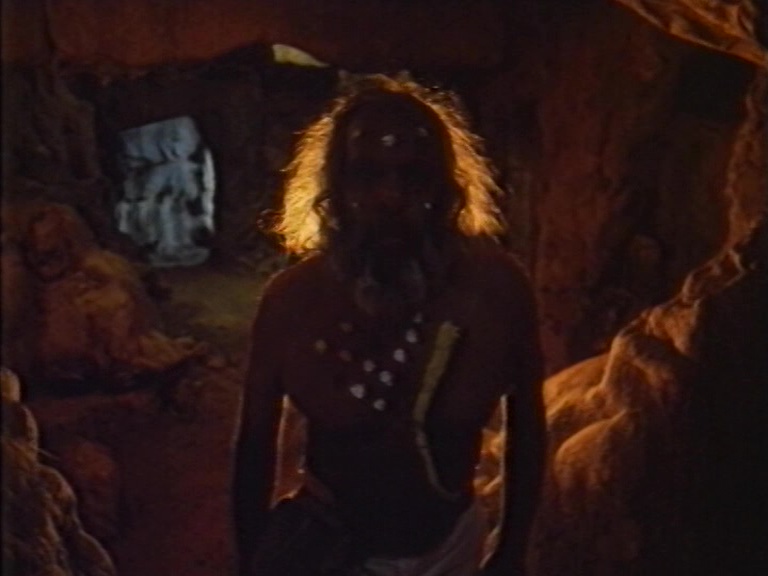
Set in suburban Melbourne in 1957, Celia on disc seven paints a less-than-flattering portrayal of Australian culture at the time 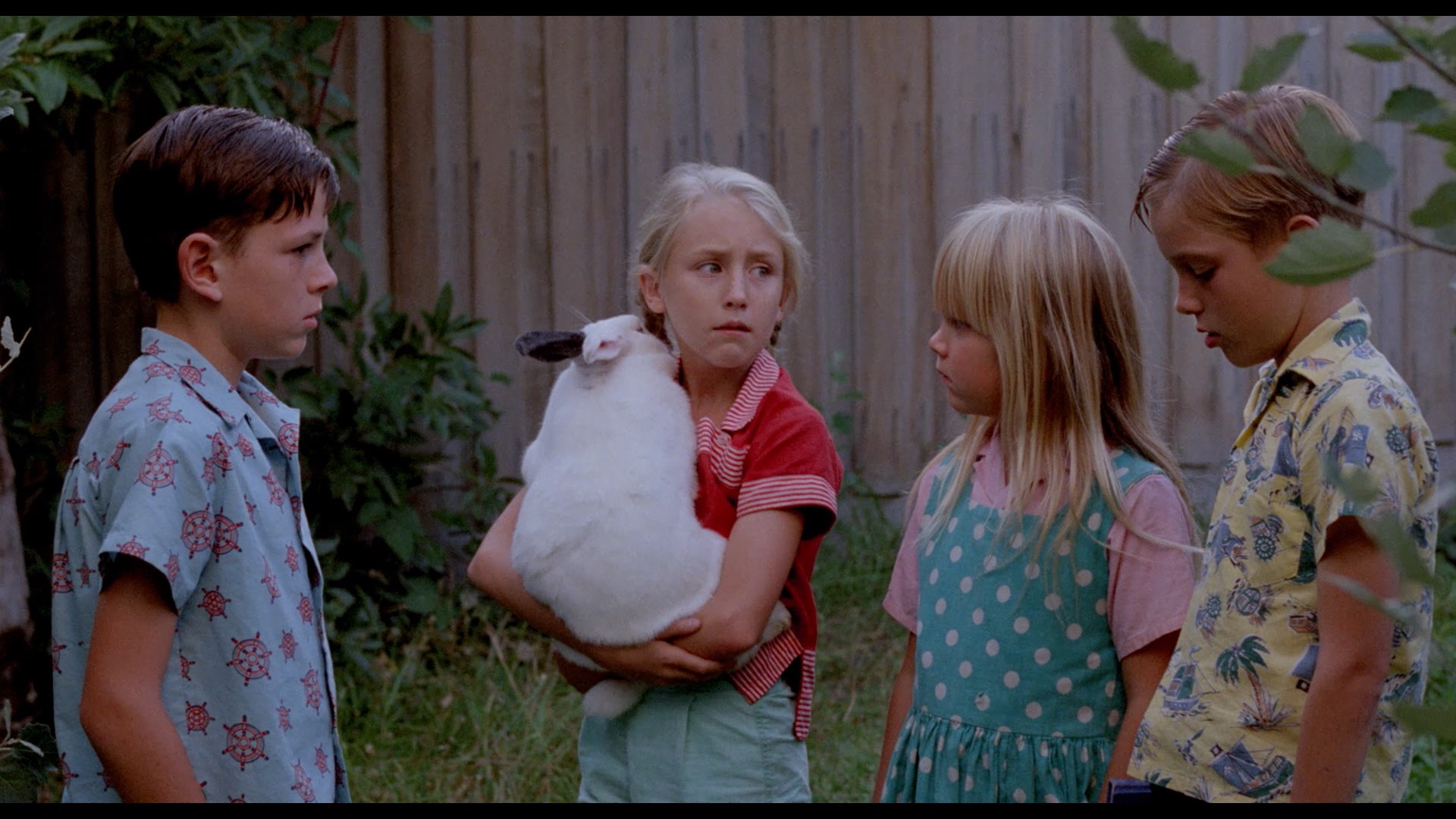 and makes for something
and makes for something 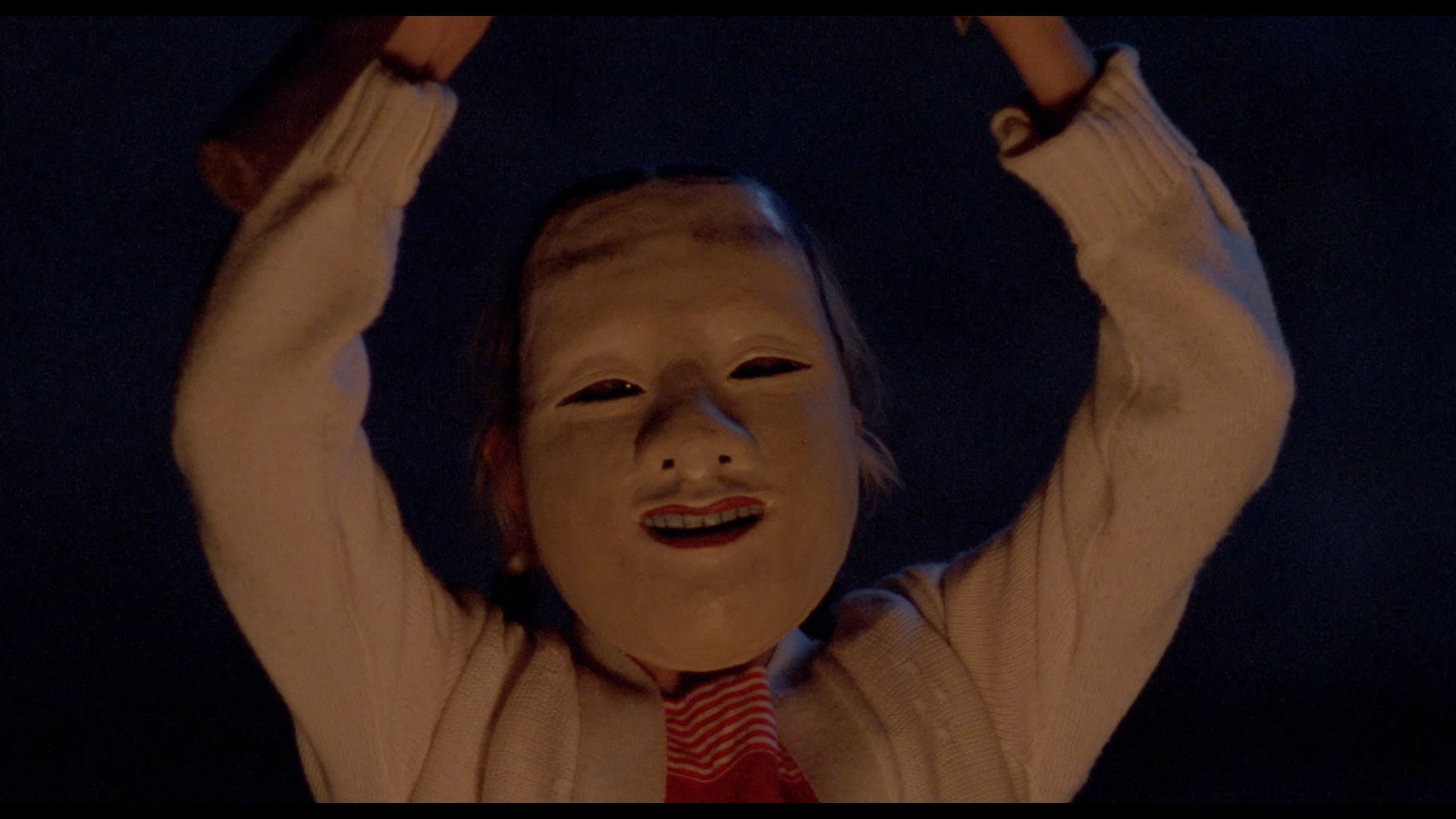 more complex and unsettling than the basic "killer kids" scenario promised by the film's marketing in many countries when it was first released. In American in particular, the extended title of Celia, Child of Terror seemed like an attempt to cash in on something like Children of the Corn, which is rather missing the point. This fits in far more snugly with the fascinating strain of child psychology thrillers running through international cinema from classics like Curse of the Cat People to more modern, subversive fare like Heavenly Creatures, Paperhouse, and the closest point of reference here, The Reflecting Skin. After finding her grandmother dead at home one night, nine-year-old Celia Carmichael (Smart) has a little trouble dealing with the world around her. She wants to fill the void in her life by bring back gran and also getting a pet rabbit, the latter of which her parents manage to appease. Celia starts having disturbing dreams involving her dead grandmother at the window (shades of Salem's Lot) and slimy monsters, but real life proves to be even more disturbing when her family bans her from hanging out with the new neighbors, who apparently have communist sympathies. On top of that, the government is trying to prevent a major rabbit population issue and confiscating all pet rabbits for the local zoo, setting off a tragic series of events
more complex and unsettling than the basic "killer kids" scenario promised by the film's marketing in many countries when it was first released. In American in particular, the extended title of Celia, Child of Terror seemed like an attempt to cash in on something like Children of the Corn, which is rather missing the point. This fits in far more snugly with the fascinating strain of child psychology thrillers running through international cinema from classics like Curse of the Cat People to more modern, subversive fare like Heavenly Creatures, Paperhouse, and the closest point of reference here, The Reflecting Skin. After finding her grandmother dead at home one night, nine-year-old Celia Carmichael (Smart) has a little trouble dealing with the world around her. She wants to fill the void in her life by bring back gran and also getting a pet rabbit, the latter of which her parents manage to appease. Celia starts having disturbing dreams involving her dead grandmother at the window (shades of Salem's Lot) and slimy monsters, but real life proves to be even more disturbing when her family bans her from hanging out with the new neighbors, who apparently have communist sympathies. On top of that, the government is trying to prevent a major rabbit population issue and confiscating all pet rabbits for the local zoo, setting off a tragic series of events 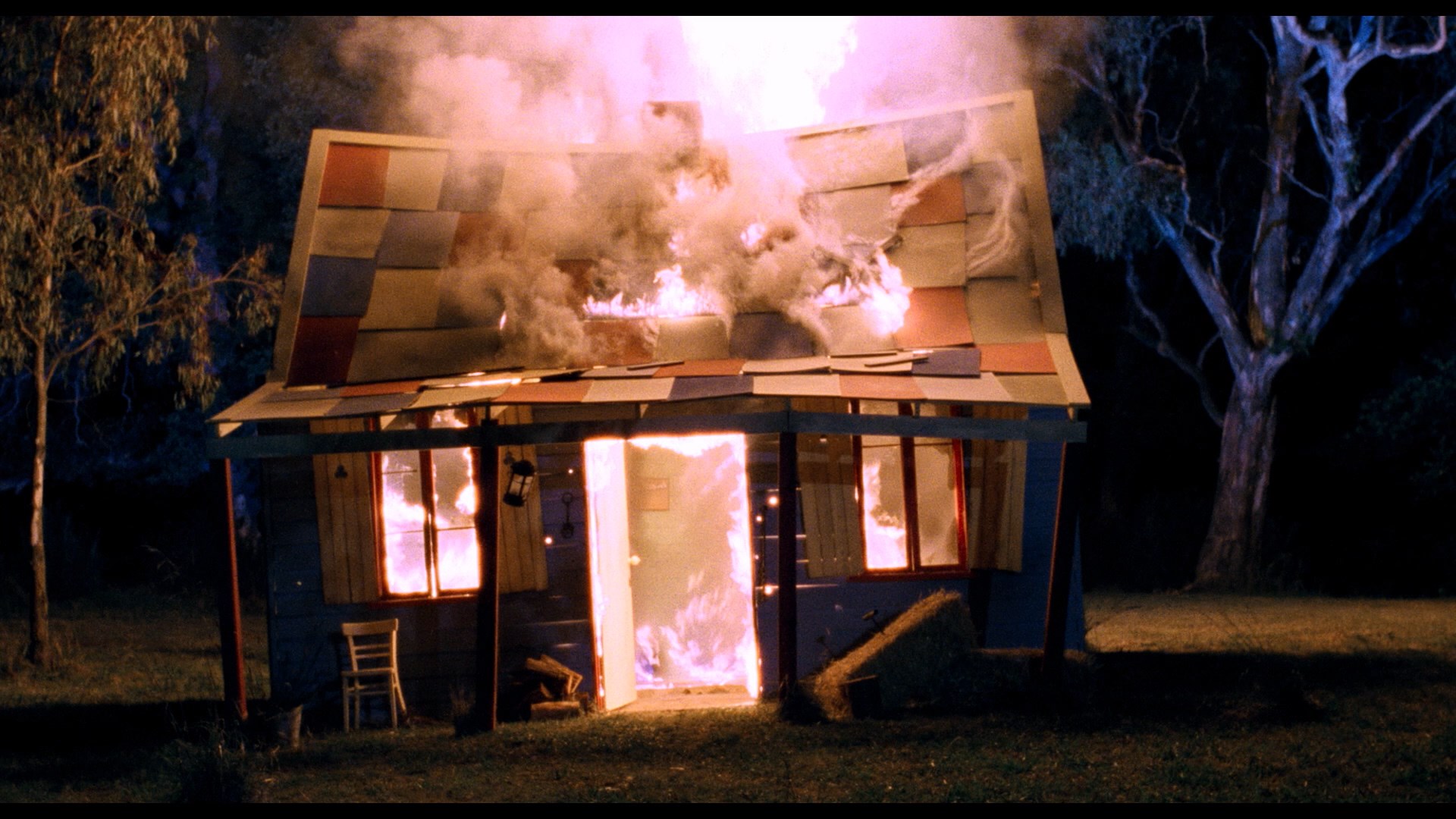 that might send Celia down a very dark rabbit hole of her
that might send Celia down a very dark rabbit hole of her 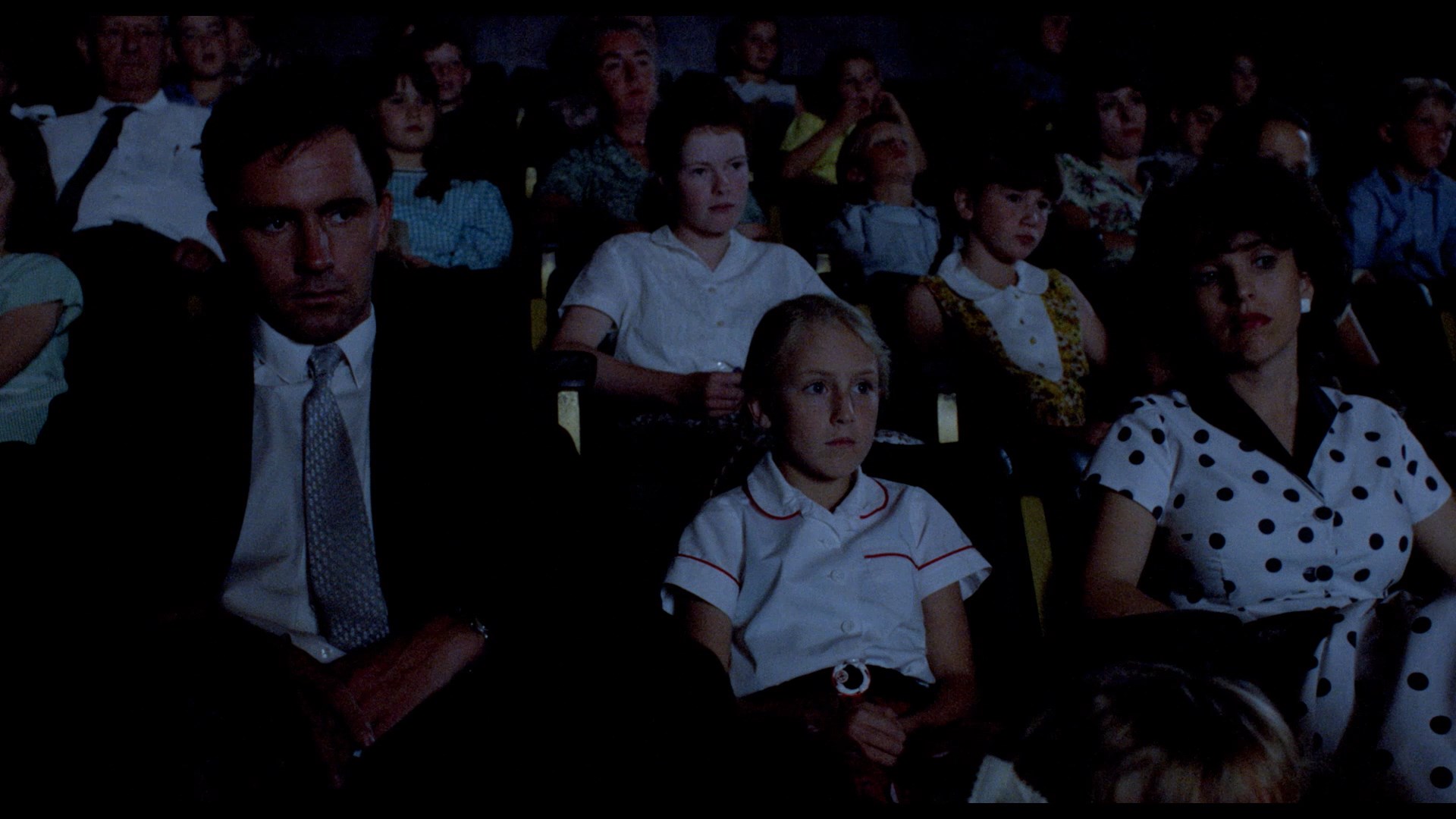 own.
own.
Not surprisingly, the positioning of Celia as a straight horror film continued with its VHS release in America, while the first DVD out of the gate from Second Run in 2009 sold it more accurately as a dark art film and featured a new 13-minute interview with Turner (whose features since this included the early Russell Crowe vehicle Hammers Over the Anvil and the Susan Sarandon thriller Irresistible). Shortly after that came an Australian release from Umbrella, and its extras form the core of what was included for the film's American DVD debut from Scorpion Releasing in 2013.
The Scorpion disc features an anamorphic transfer framed at 1.75:1, which seems to open the framing up a bit from the more masked 1.85:1 as it would have been shown in theaters. The compositions work fine, 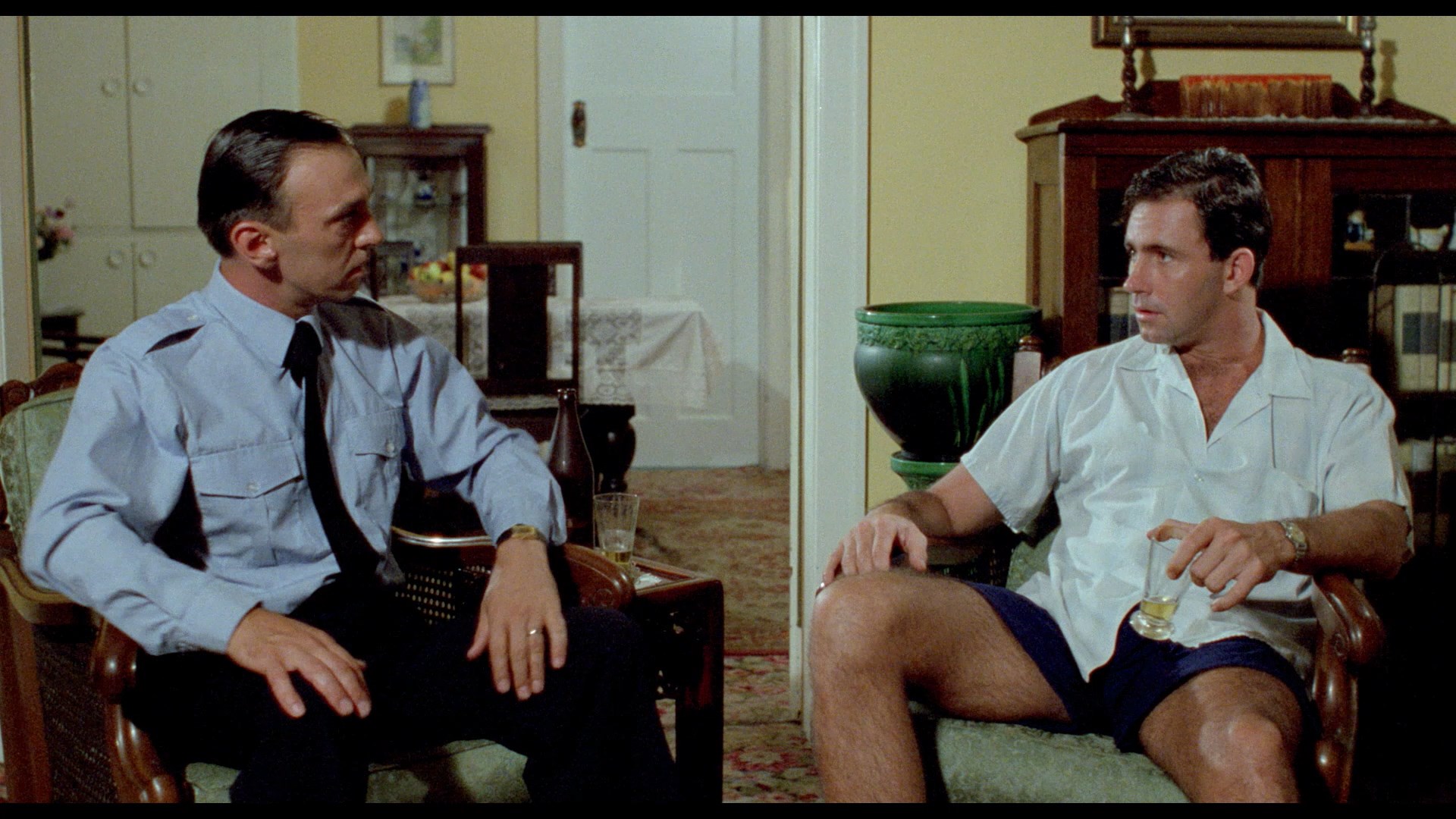 and the Scorpion disc also marks the
and the Scorpion disc also marks the 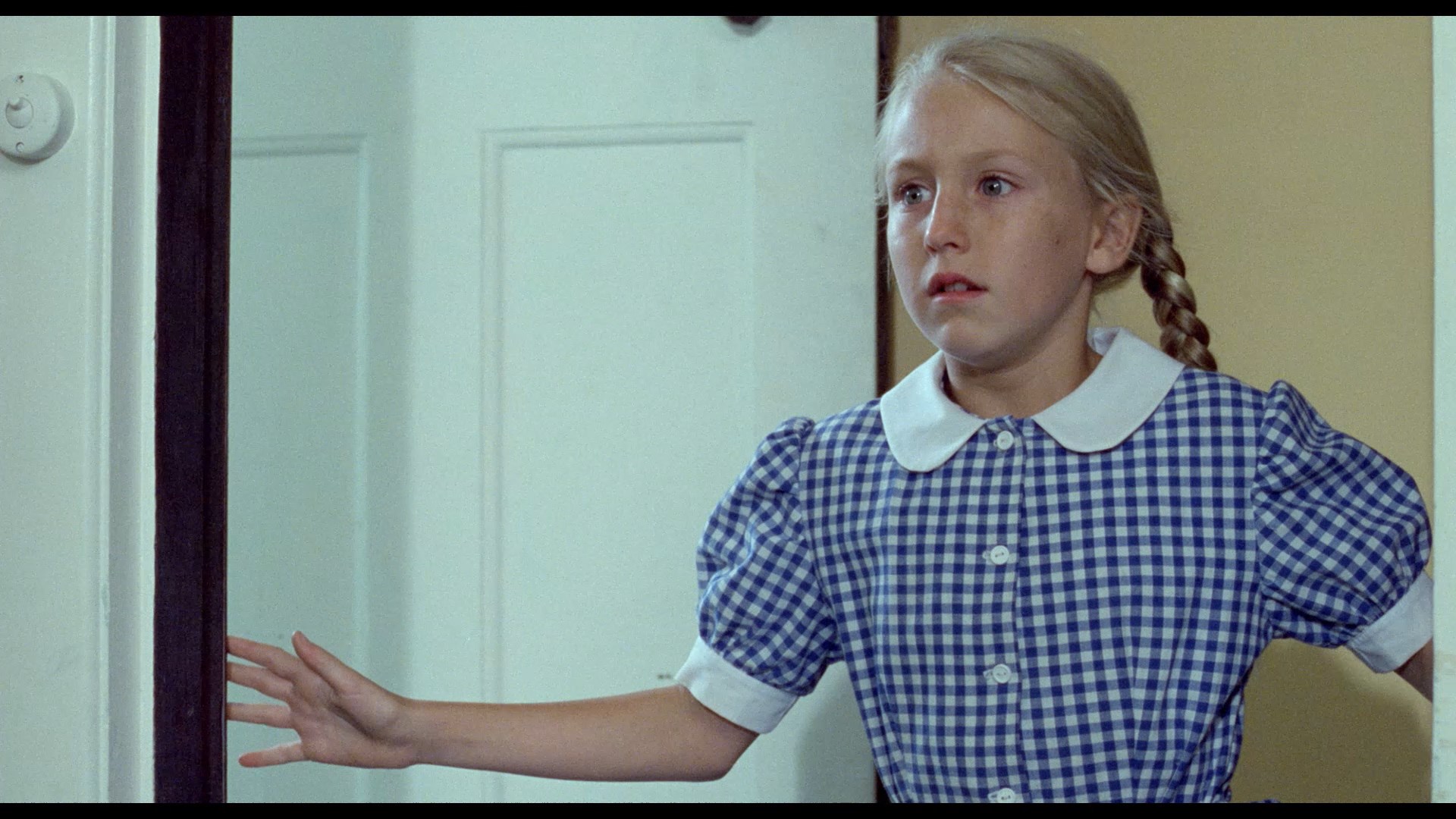 first time the film has been available in its original film speed running 103 minutes instead of the sped-up 97 minutes of the previous PAL versions. Image quality is fine if limited by the drab and sometimes dark nature of the film; don't expect pristine HD quality here, but it's the equal of the international releases and much, much better than the American VHS version. Not surprisingly, this presented as part of Scorpion's Katarina's Nightmare Theater line, with hostess Katarina Leigh Waters kicking things off by chasing and attacking a stuffed bunny rabbit (cue the Night of the Lepus jokes here) and offering loads of trivia about the participants in the film. The extras from the Aussie release include a 1989 Sunday Show review of the film (7m5s) by Paul Thompson including a chat with the director, plus a 10m58s audio interview between Turner and critic David Stratton covering some of the cultural, political, and psychological undercurrents of the film. The short German-language trailer (probably prepared for the video release) is also included along with bonus trailers for The Monster Club, Grizzly, Day of the Animals, Death Ship, The Unseen, and The Survivor.
first time the film has been available in its original film speed running 103 minutes instead of the sped-up 97 minutes of the previous PAL versions. Image quality is fine if limited by the drab and sometimes dark nature of the film; don't expect pristine HD quality here, but it's the equal of the international releases and much, much better than the American VHS version. Not surprisingly, this presented as part of Scorpion's Katarina's Nightmare Theater line, with hostess Katarina Leigh Waters kicking things off by chasing and attacking a stuffed bunny rabbit (cue the Night of the Lepus jokes here) and offering loads of trivia about the participants in the film. The extras from the Aussie release include a 1989 Sunday Show review of the film (7m5s) by Paul Thompson including a chat with the director, plus a 10m58s audio interview between Turner and critic David Stratton covering some of the cultural, political, and psychological undercurrents of the film. The short German-language trailer (probably prepared for the video release) is also included along with bonus trailers for The Monster Club, Grizzly, Day of the Animals, Death Ship, The Unseen, and The Survivor.
In 2021, Second Run gave the film its global Blu-ray debut as an expanded special edition along with a striking new 2K restoration by the National Film and Sound Archive of Australia. The uptick here is very obvious with deeper blacks, far finer detail, and richer colors; the framing adjusts slightly to 1.85:1, with no particular impact on the compositions one way or the other. The LPCM English 2.0 track (with optional SDH subtitles) is also in mint condition. The 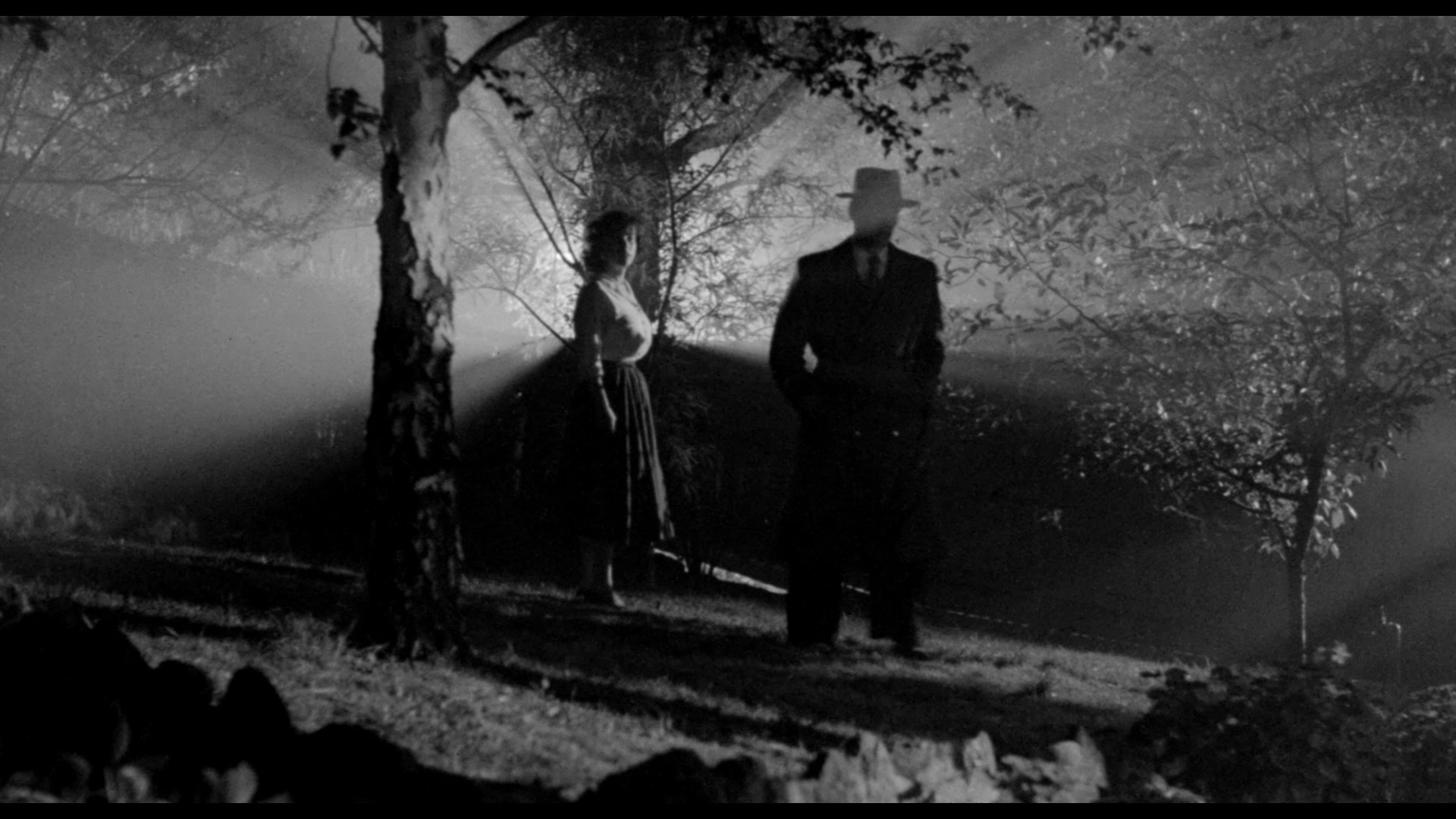 earlier UK DVD interview with Turner is ported over here, without PAL speedup and
earlier UK DVD interview with Turner is ported over here, without PAL speedup and 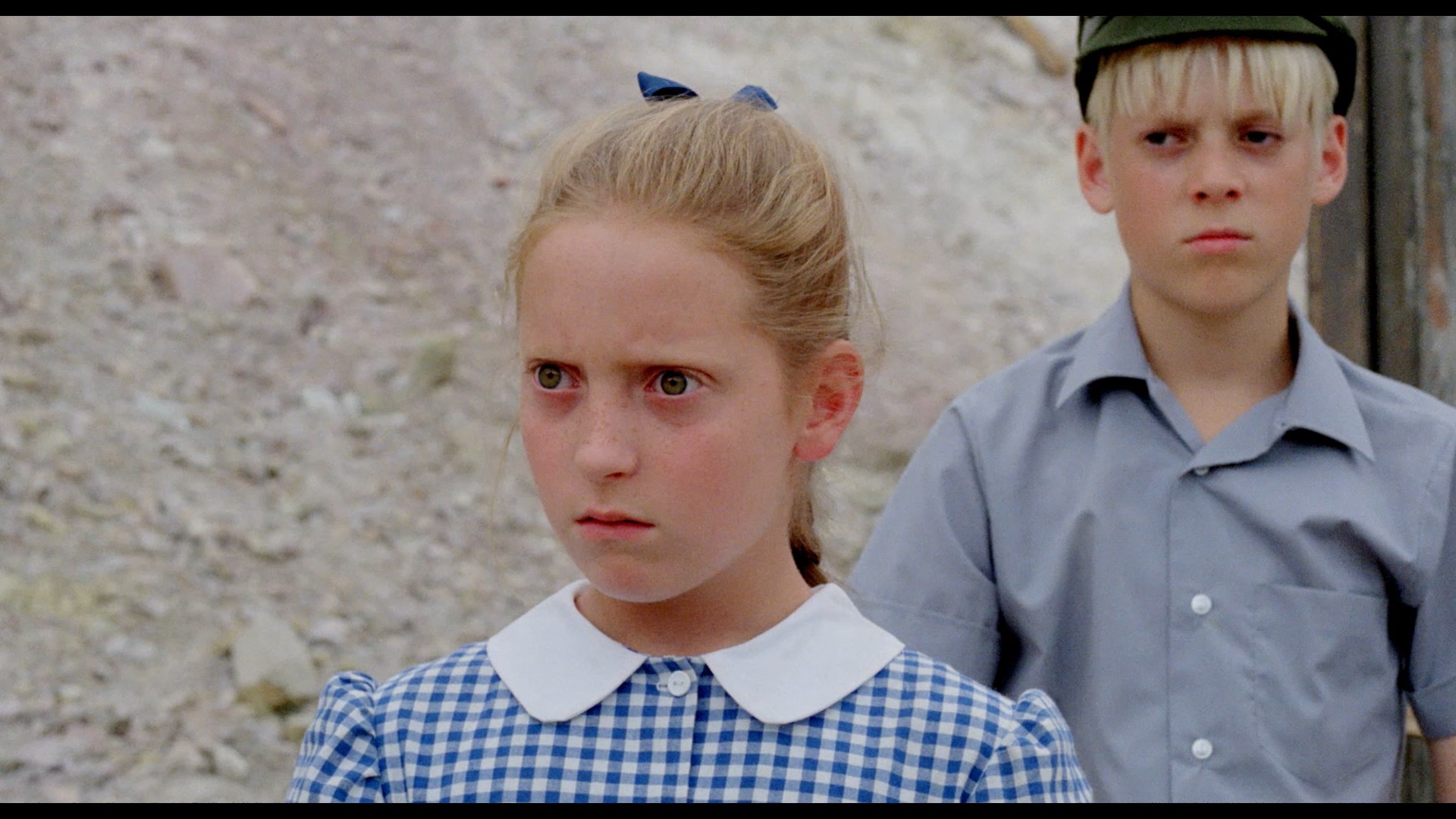 now running 14m16s. However, you also get two substantial new video bonuses starting with "Celia's World" (61m23s), a very interesting documentary by Turner including interviews she conducted with children of 1950s Australian communist sympathizers. She also goes into memories of the real rabbit muster that inspired the story, as well as its reception and various attempts to read it as a feminist or child psychology tract. "There's Something About Celia" (17m39s) is a post-screening Q&A with author Alexandra Heller-Nicholas and Maria Lewis at the Australian Centre for Moving Image in Melbourne, discussing how they first encountered the film and how it stands apart from traditional genre readings while offering insight into a young female psyche. The disc closes out with a very hefty photo gallery including some great candid shots of the monsters in and out of costume, while the insert booklet comes with insightful essays by Michael Brooke and Joy Damousi (including additional bits on the arduous process of bringing the production to fruition) and the eerie folktale incorporated into the script, "The Hobyahs."
now running 14m16s. However, you also get two substantial new video bonuses starting with "Celia's World" (61m23s), a very interesting documentary by Turner including interviews she conducted with children of 1950s Australian communist sympathizers. She also goes into memories of the real rabbit muster that inspired the story, as well as its reception and various attempts to read it as a feminist or child psychology tract. "There's Something About Celia" (17m39s) is a post-screening Q&A with author Alexandra Heller-Nicholas and Maria Lewis at the Australian Centre for Moving Image in Melbourne, discussing how they first encountered the film and how it stands apart from traditional genre readings while offering insight into a young female psyche. The disc closes out with a very hefty photo gallery including some great candid shots of the monsters in and out of costume, while the insert booklet comes with insightful essays by Michael Brooke and Joy Damousi (including additional bits on the arduous process of bringing the production to fruition) and the eerie folktale incorporated into the script, "The Hobyahs."
The Severin release is identical in terms of a/v quality compared to the U.K. disc, but it diverges completely in terms of extras. "Celia and Me" (39m43s) is a Zoom-shot interview with Turner about the film, pretty much covering the usual main topics including the rabbit cull, the communist panic, and her battles over how to title and market the film. In "From Crawfords to Celia" (17m4s), editor Ken Sallows discusses his early work on TV shows like Bluey 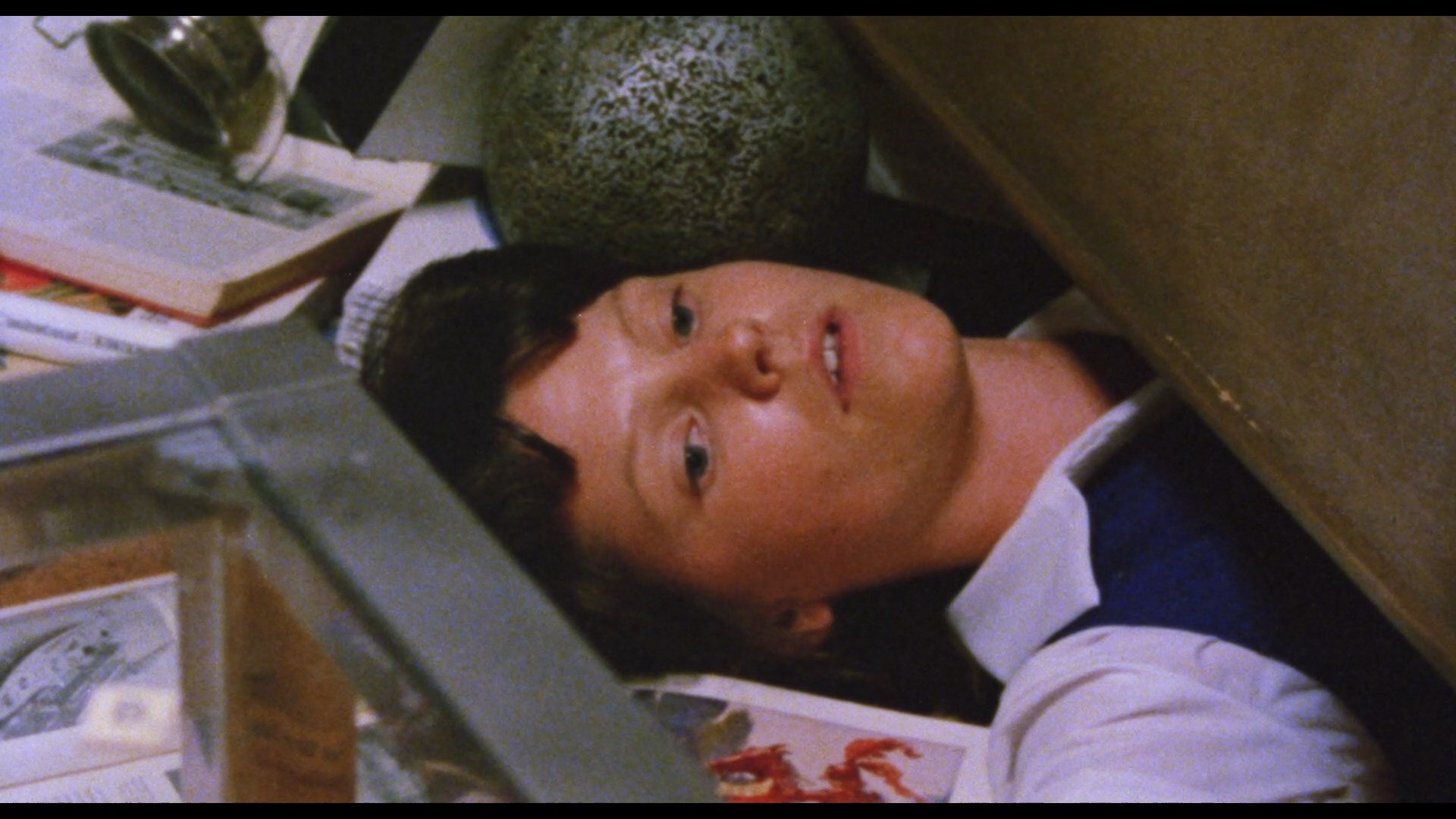 that led to films like Long Weekend, Next of Kin, and this one, whose post-production process was fairly
that led to films like Long Weekend, Next of Kin, and this one, whose post-production process was fairly 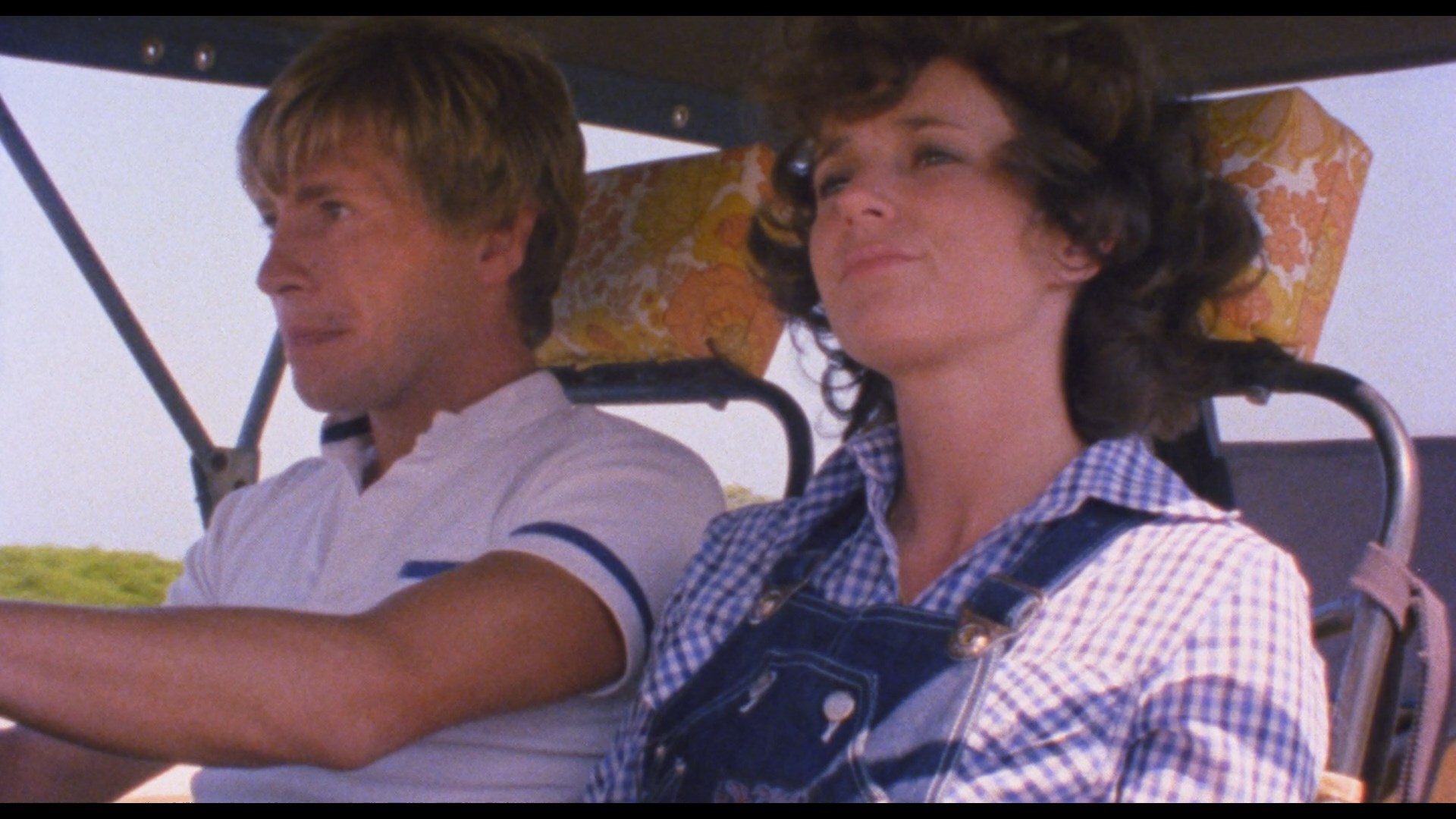 straightforward. Finally "The Rabbit In Australia" (23m49s) is a 1979 educational doc from Australia’s national science agency CSIRO about the rabbit population control tactics after the animals were imported from Europe, including footage of shot and poisoned bunnies so consider yourself warned.
straightforward. Finally "The Rabbit In Australia" (23m49s) is a 1979 educational doc from Australia’s national science agency CSIRO about the rabbit population control tactics after the animals were imported from Europe, including footage of shot and poisoned bunnies so consider yourself warned.
The disc's co-feature is a title that hasn't been around for decades in the U.S. since its VHS run from VidAmerica in 1984: Alison's Birthday, a moody 16mm Aussie horror film from director Ian Coughlan. This one has a strong made-for-TV horror vibe even though it went theatrical, and that's not a diss at all as it's loaded with that kind of low-key charm you get from gore-free, slow-burn supernatural thrills with fun characters and unexpected creative choices.
To celebrate her sweet sixteen, orphaned Alison (Mad Max's Samuel) decides to celebrate by having an impromptu seance with her best friend, Chrissy-- who intones in a creepy male voice claiming to be her dead father, "Alison, you have to get away from them, before 19th birthday! 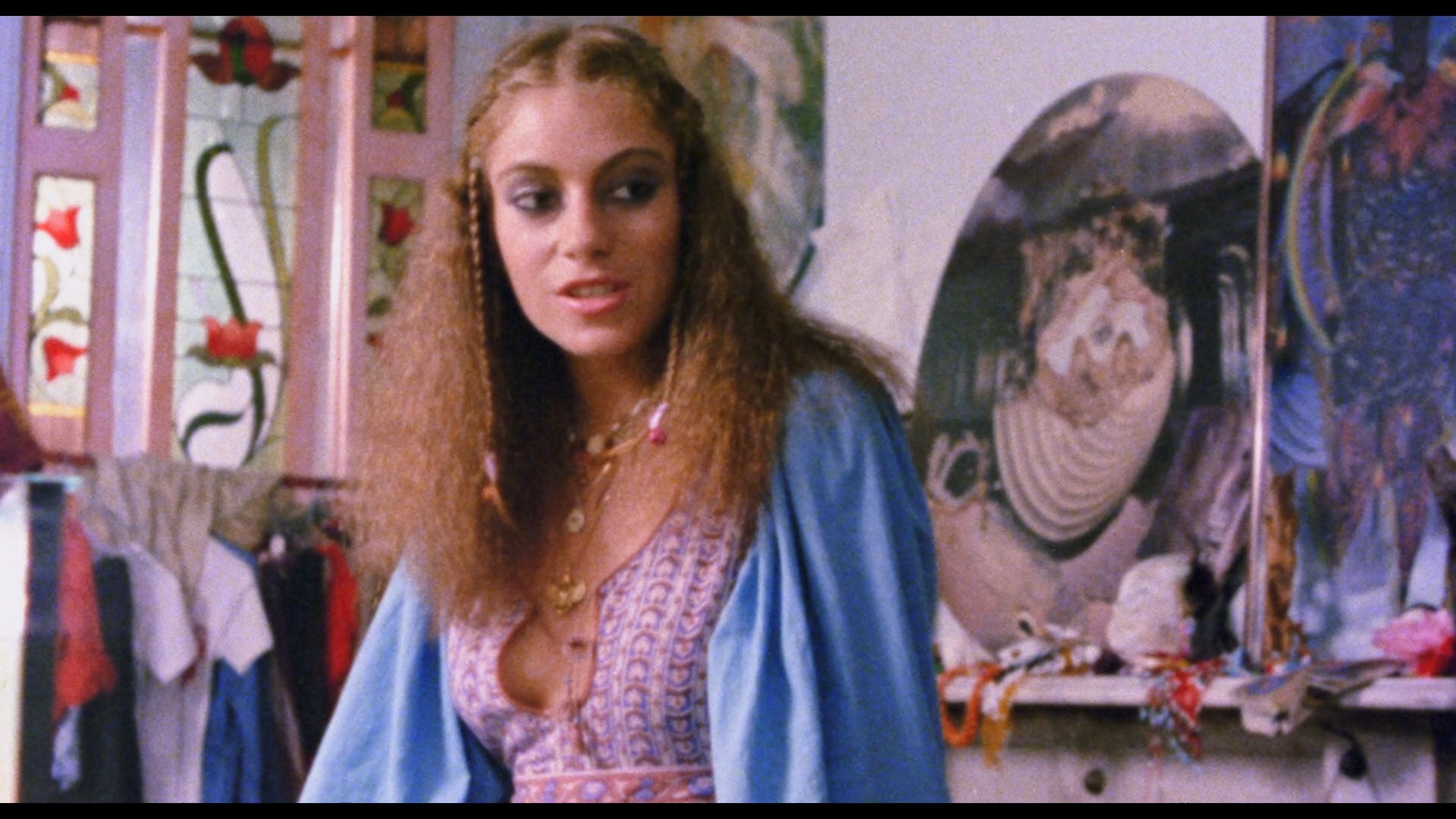 They want you for murder! Don't let them take you!" That leads to some billowing curtains and overturned furniture
They want you for murder! Don't let them take you!" That leads to some billowing curtains and overturned furniture 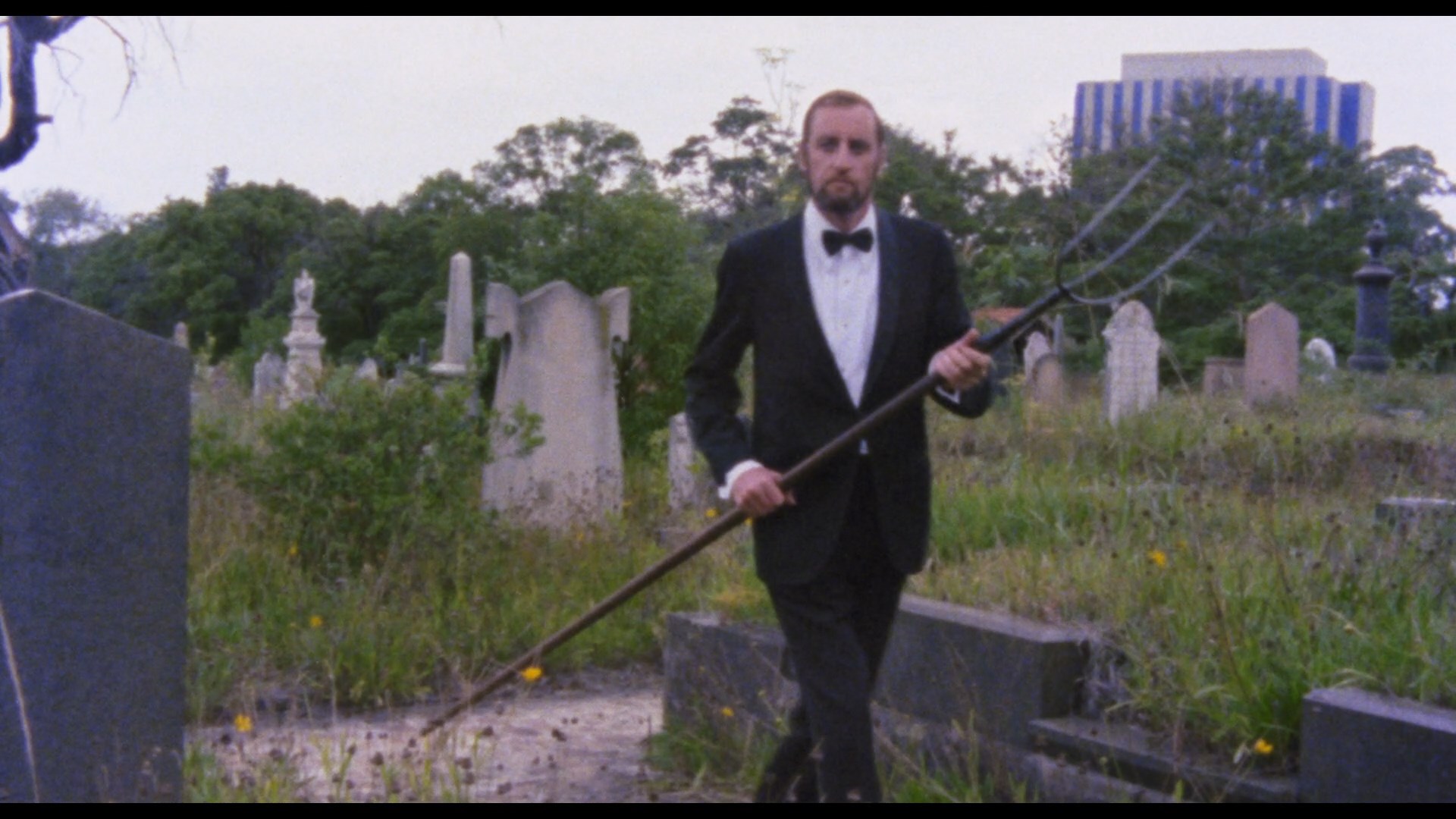 that leave Chrissy dead on the floor with an amulet in her hand. Jump forward three years, and it's just about time for Alison to turn 19. Working at a record shop in New South Wales, she's dating Peter (Brown), a local DJ, and reluctantly gets guilt tripped into spending her birthday with Aunt Jenny (Brooke) and Uncle Dean (The Vicar of Dibley's Bluthal) since the latter supposedly has major health issues. Peter agrees to drive her out there, which of course leads to occult nightmares, cemetery shenanigans, lots of chanting of the name "Myrna," suspicious physician visits, a trip to a hippie mystic, and a secret Celtic cult. Yep, it's a fun one, right down to the twist ending and closing folk song.
that leave Chrissy dead on the floor with an amulet in her hand. Jump forward three years, and it's just about time for Alison to turn 19. Working at a record shop in New South Wales, she's dating Peter (Brown), a local DJ, and reluctantly gets guilt tripped into spending her birthday with Aunt Jenny (Brooke) and Uncle Dean (The Vicar of Dibley's Bluthal) since the latter supposedly has major health issues. Peter agrees to drive her out there, which of course leads to occult nightmares, cemetery shenanigans, lots of chanting of the name "Myrna," suspicious physician visits, a trip to a hippie mystic, and a secret Celtic cult. Yep, it's a fun one, right down to the twist ending and closing folk song.
Since the VHS days, this one was only issued on DVD in Australia years ago by Umbrella as part of The David Hannay Collection paired up with Solo. Here in the Severin box you get a nice 2K restoration from the 16mm CRI that looks a lot more colorful than you'd 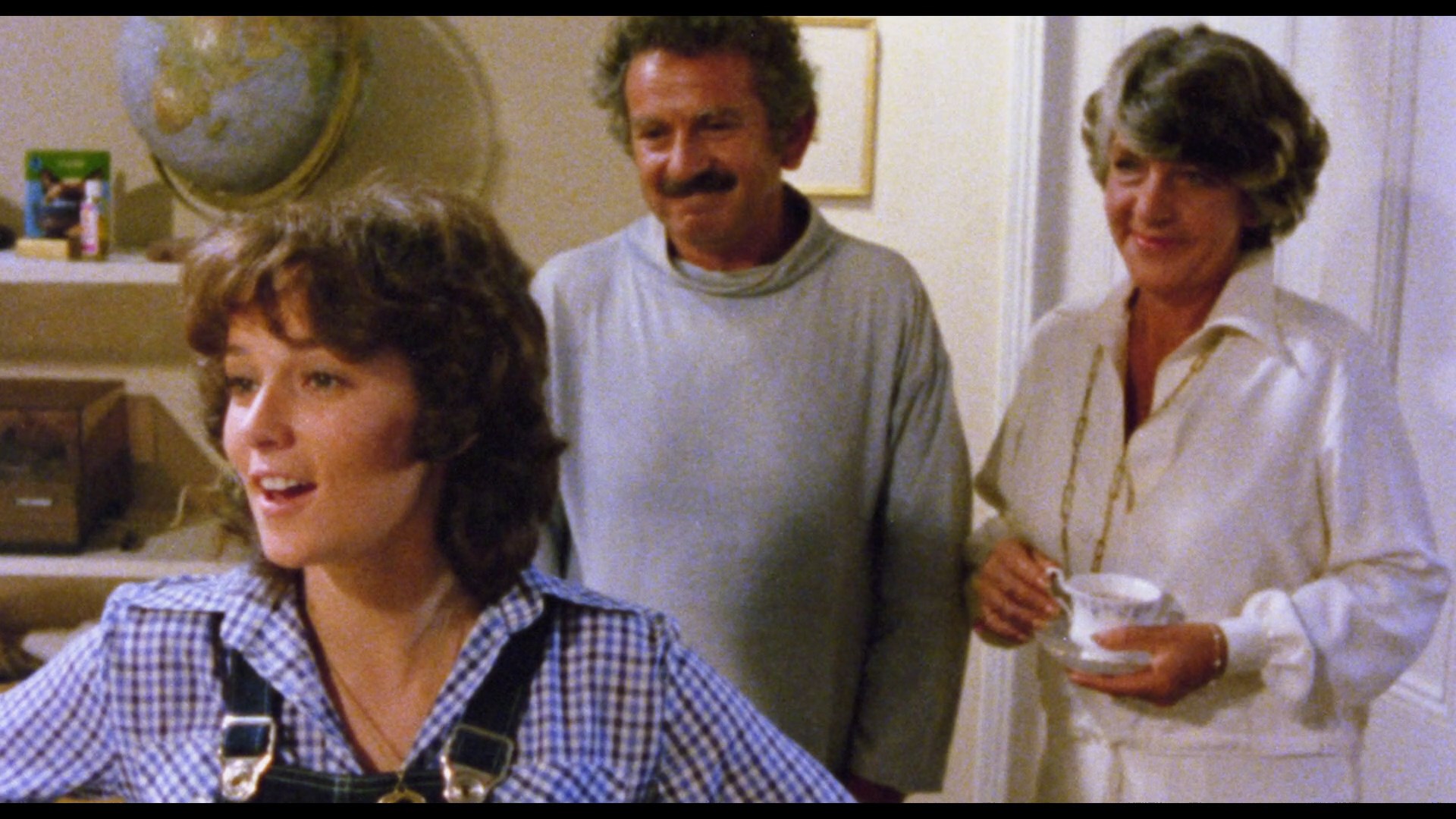 expect
expect 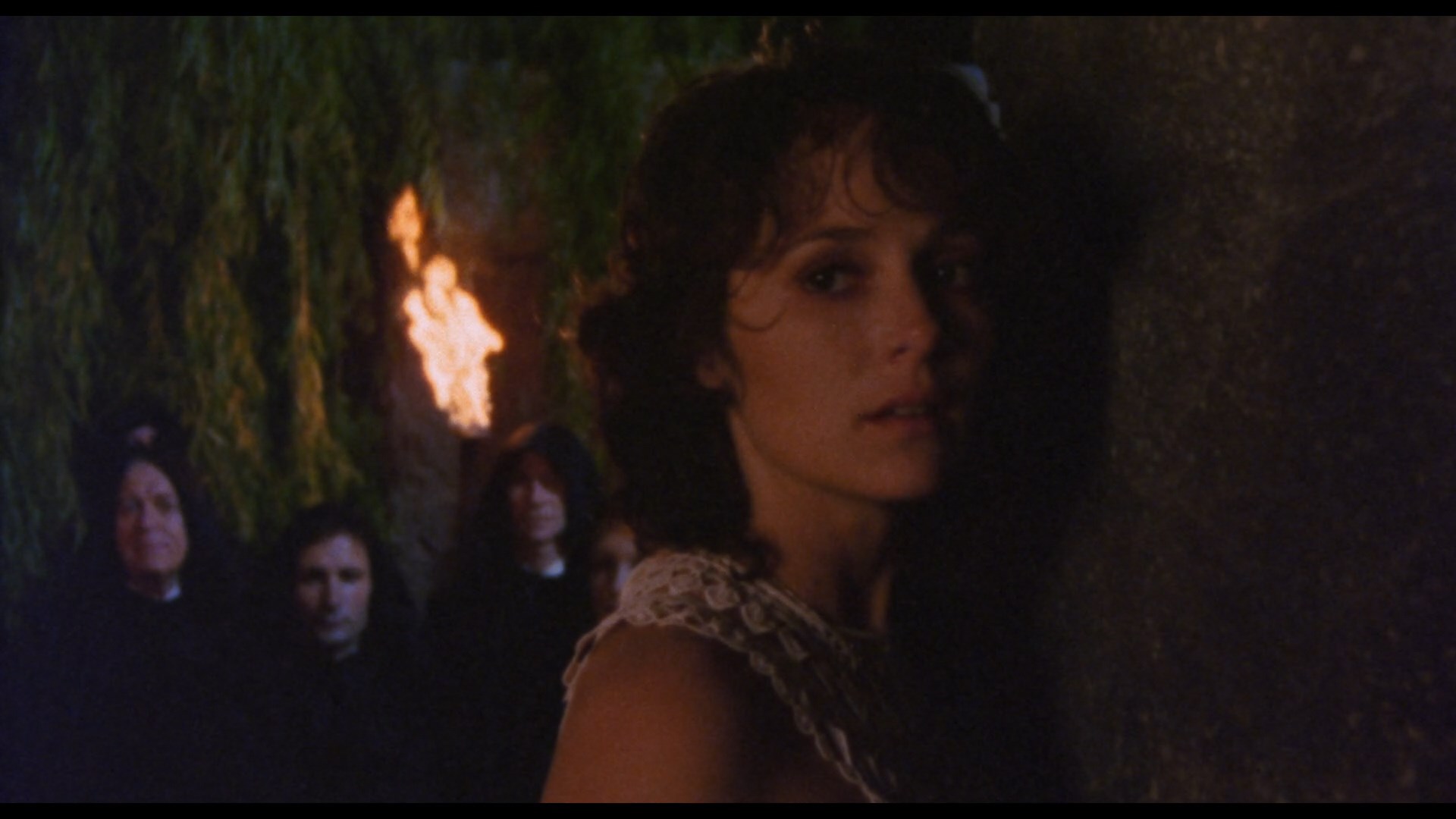 (especially the Argento- or maybe Norman J. Warren-inspired climax), with all that lovely heavy 16mm film grain left completely intact. Also included is a batch of extended interviews from the Aussiesploitation doc Not Quite Hollywood (12m1s) with producer David Hannay, Samuel, and actress Belinda Giblin about the very DIY attitude on low-budget films like this, Bluthal's acting technique, and the tactics of pulling off a possession scene. In "The Devil Down Under: Satanic Panic In Australia From Rosaleen Norton To Alison's Birthday" (16m58s), Alexandra Heller-Nicholas talks about the crossover of the Satanic panic movement from the U.S. to Australia in the early '90s stemming from origins involving Sydney-based occultist Norton.
(especially the Argento- or maybe Norman J. Warren-inspired climax), with all that lovely heavy 16mm film grain left completely intact. Also included is a batch of extended interviews from the Aussiesploitation doc Not Quite Hollywood (12m1s) with producer David Hannay, Samuel, and actress Belinda Giblin about the very DIY attitude on low-budget films like this, Bluthal's acting technique, and the tactics of pulling off a possession scene. In "The Devil Down Under: Satanic Panic In Australia From Rosaleen Norton To Alison's Birthday" (16m58s), Alexandra Heller-Nicholas talks about the crossover of the Satanic panic movement from the U.S. to Australia in the early '90s stemming from origins involving Sydney-based occultist Norton.
CELIA: Severin / Second Run (Blu-ray)

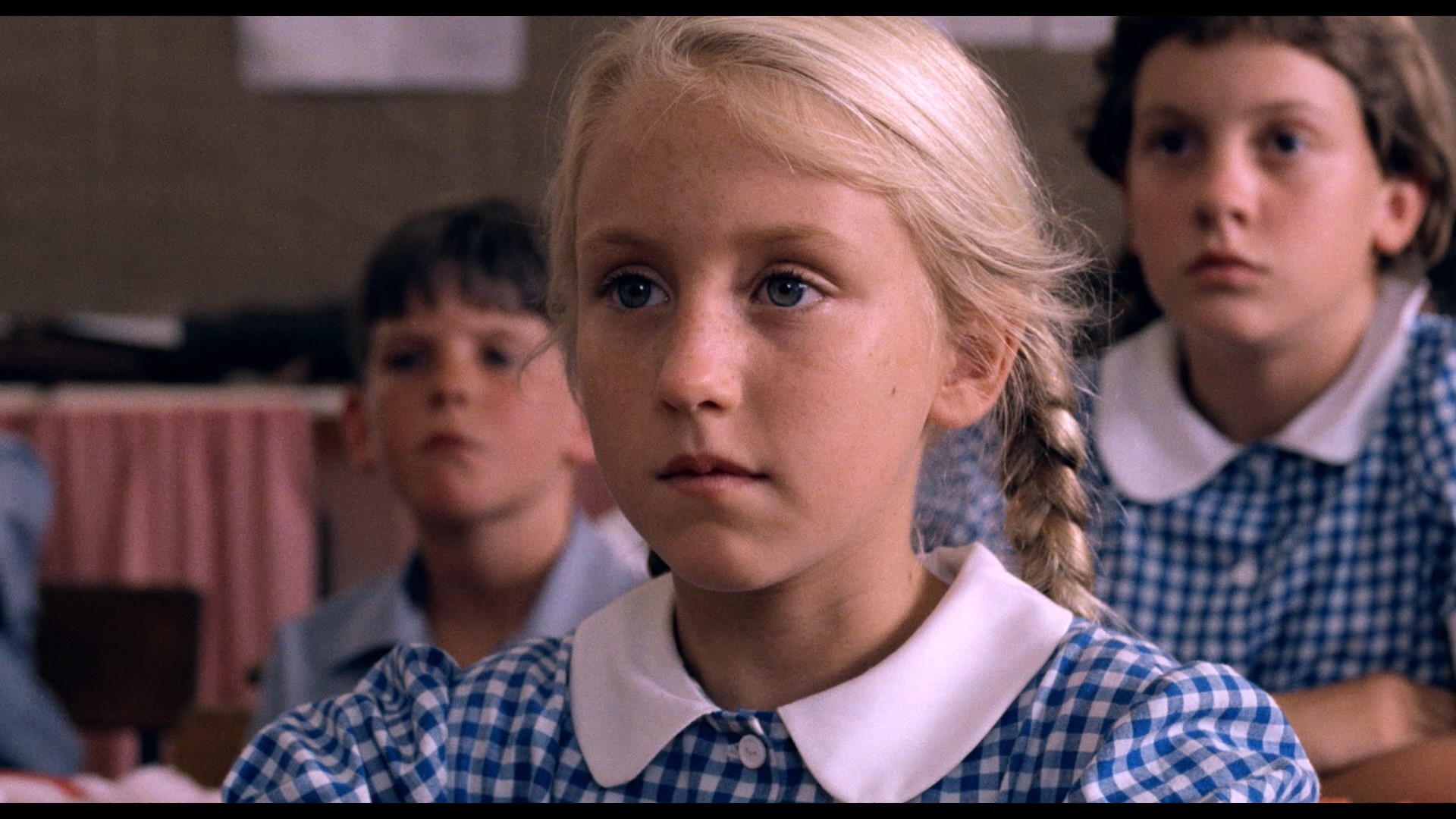
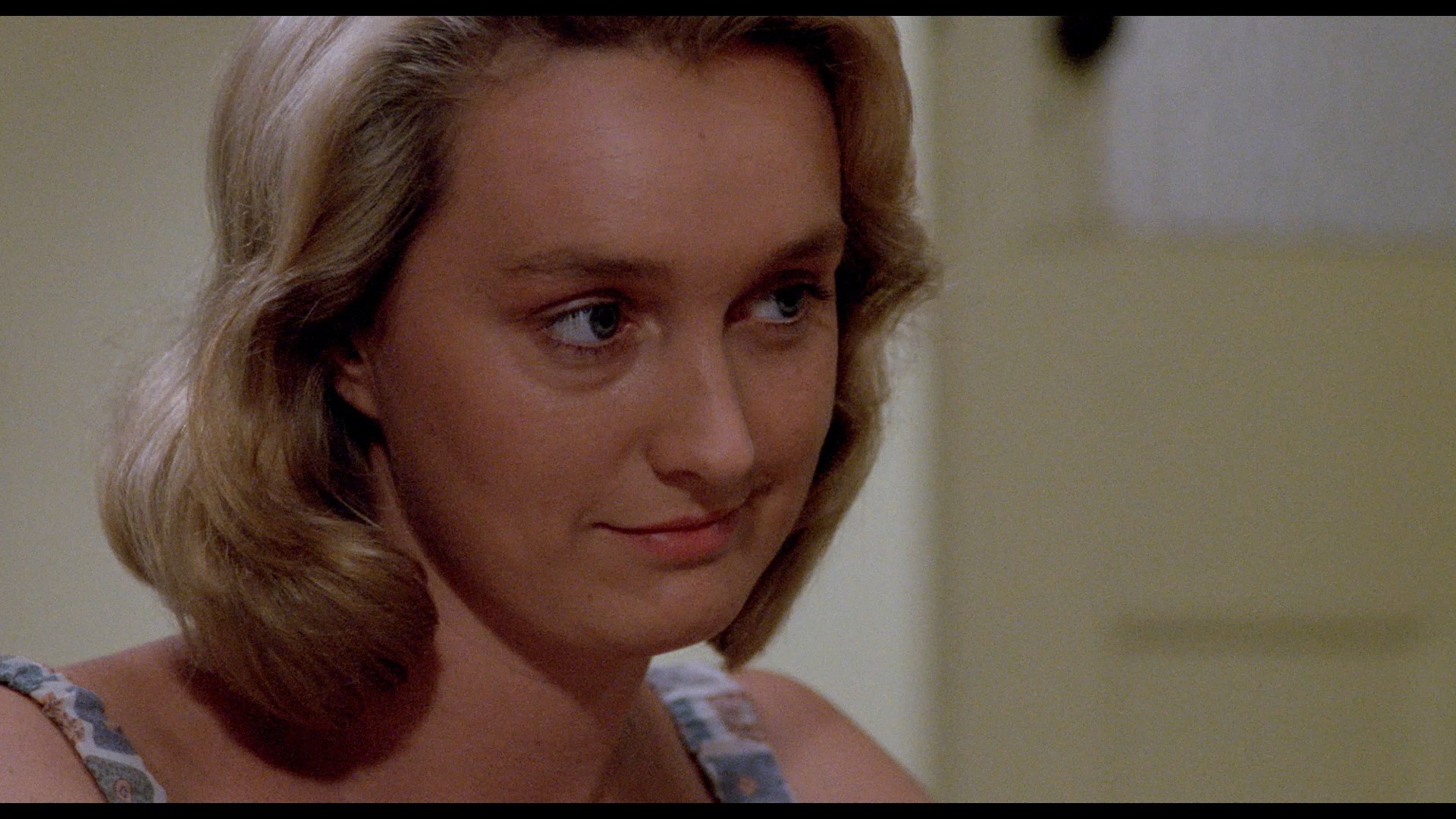
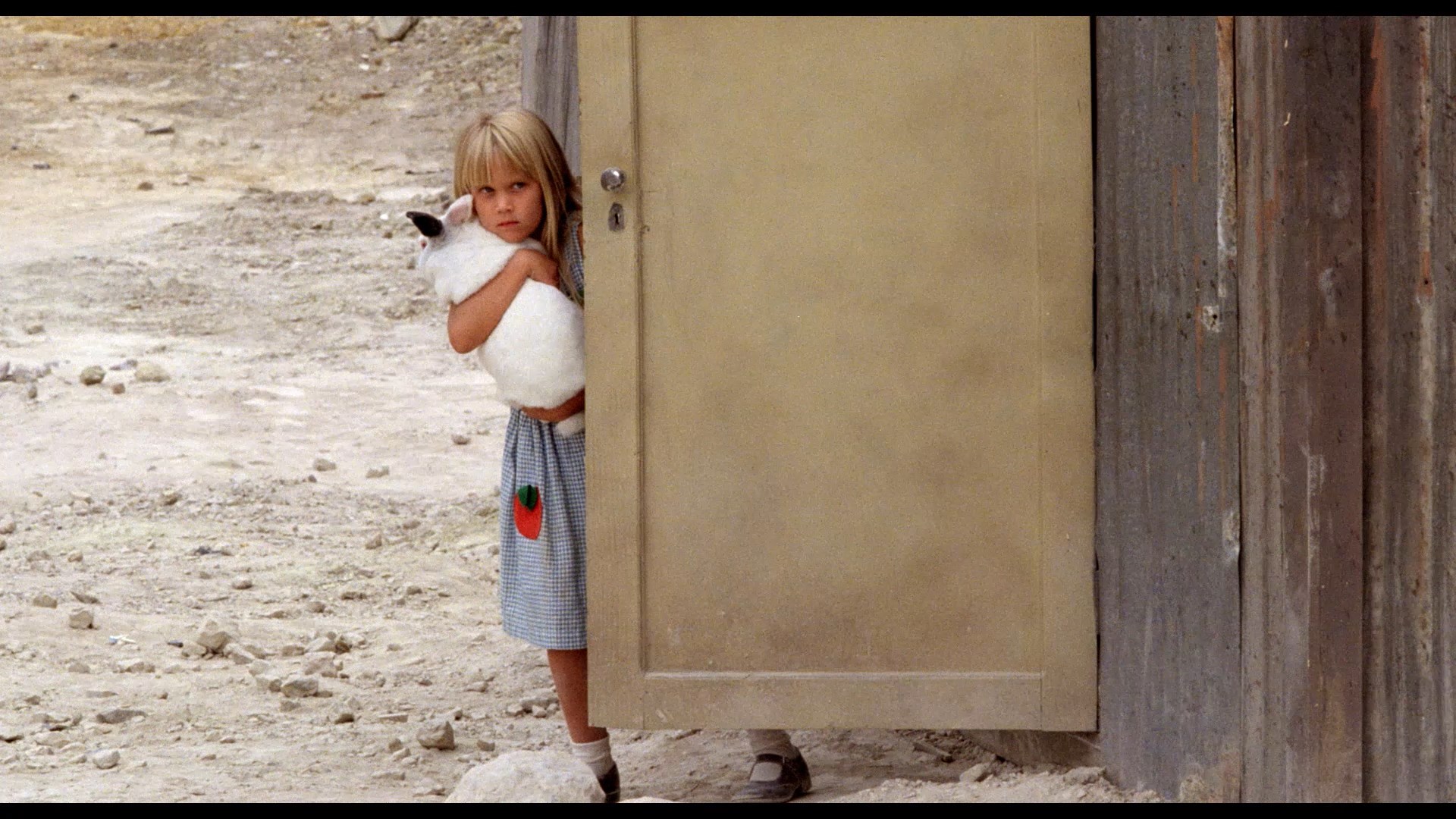
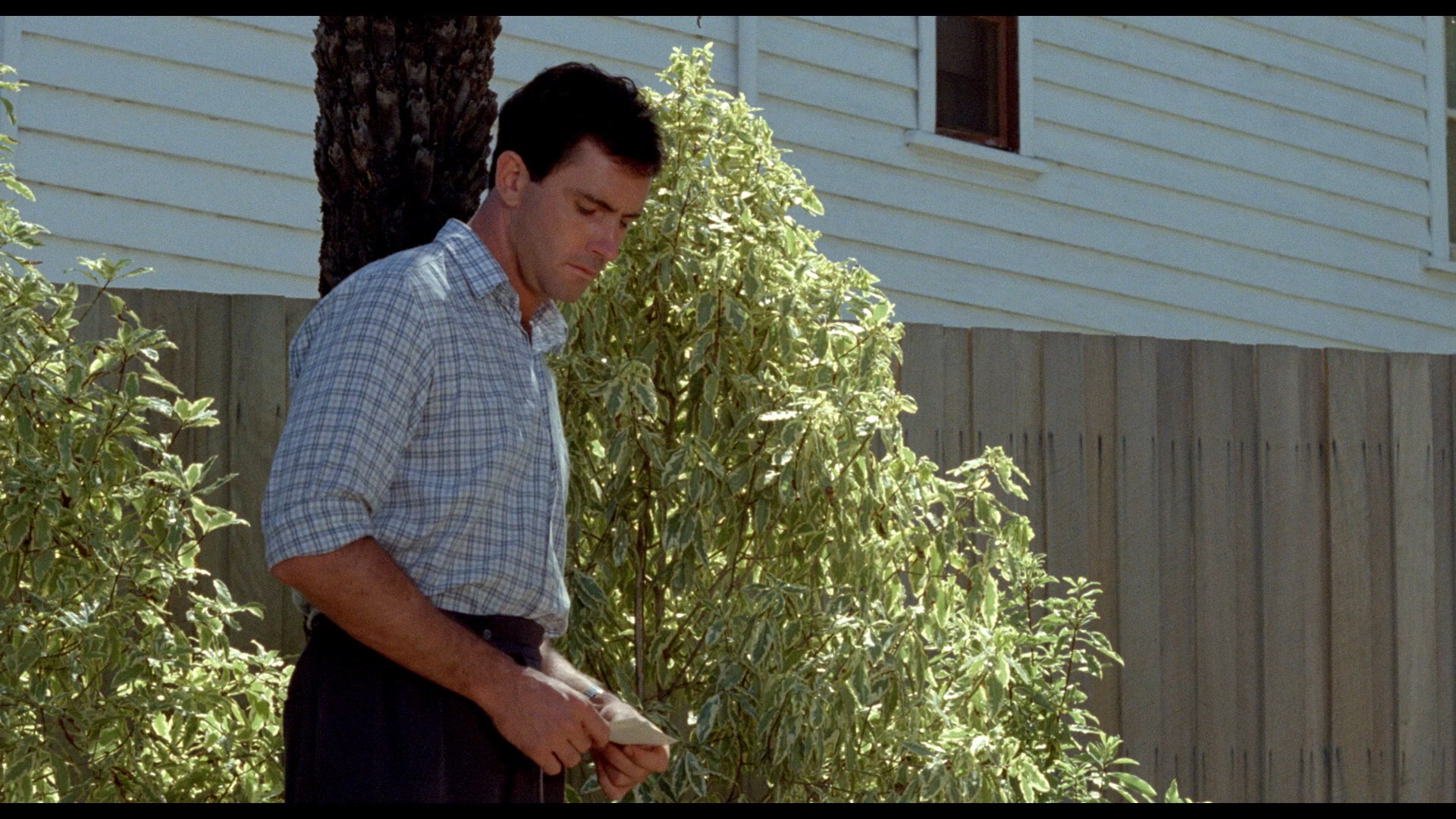
CELIA: Scorpion Releasing (DVD)
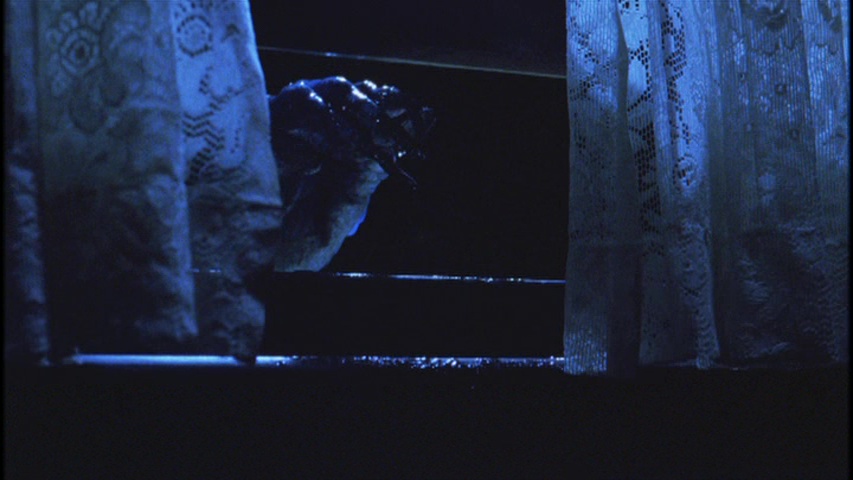
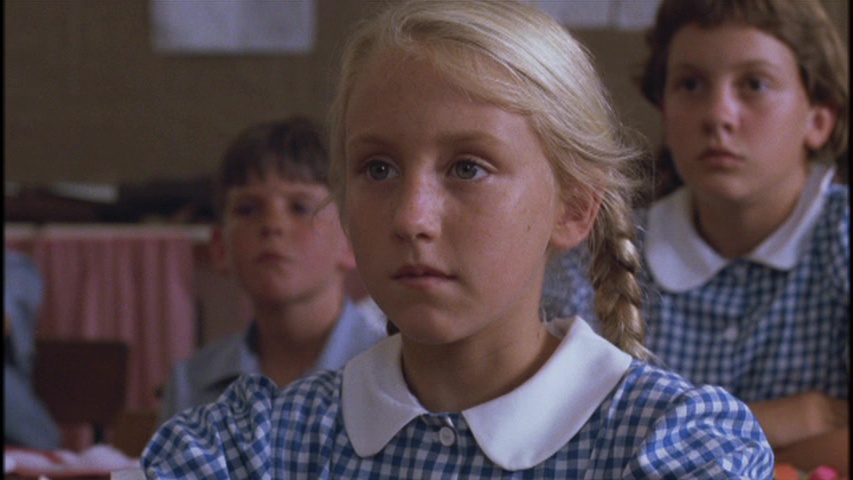
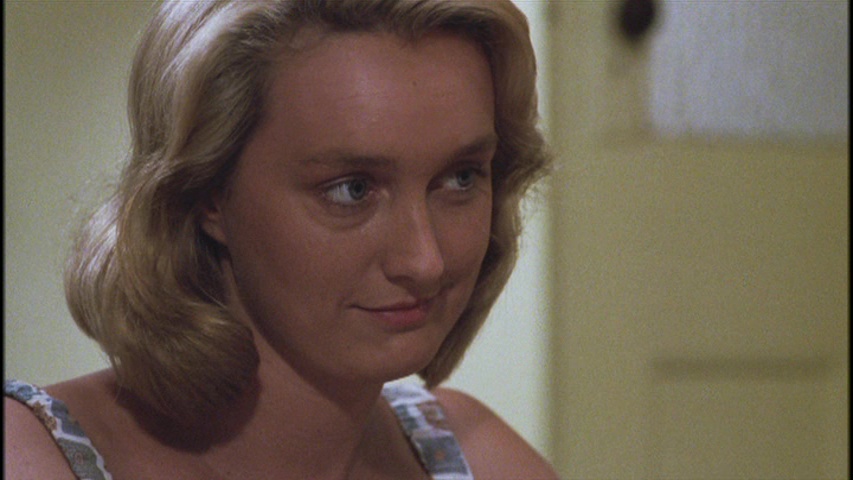
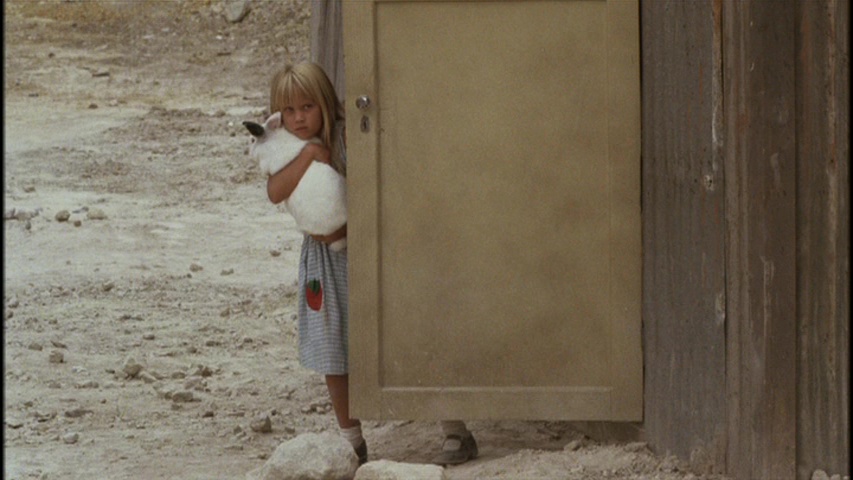
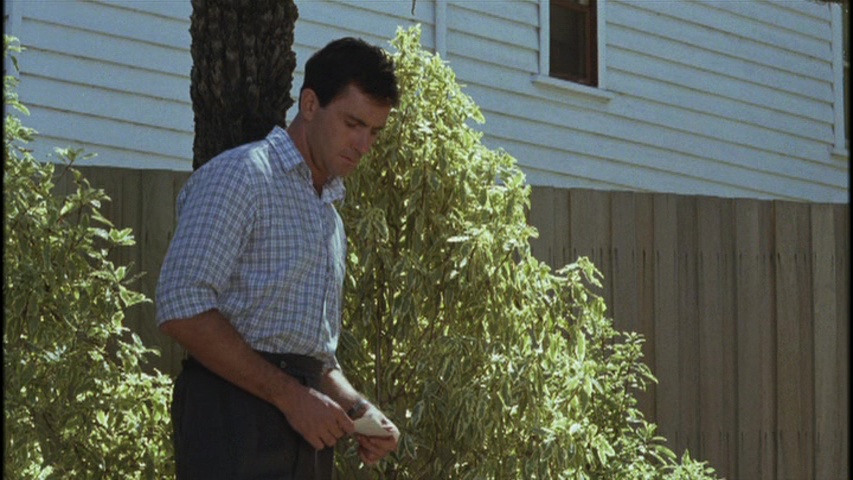
_________________________________________________________________________________________________________________
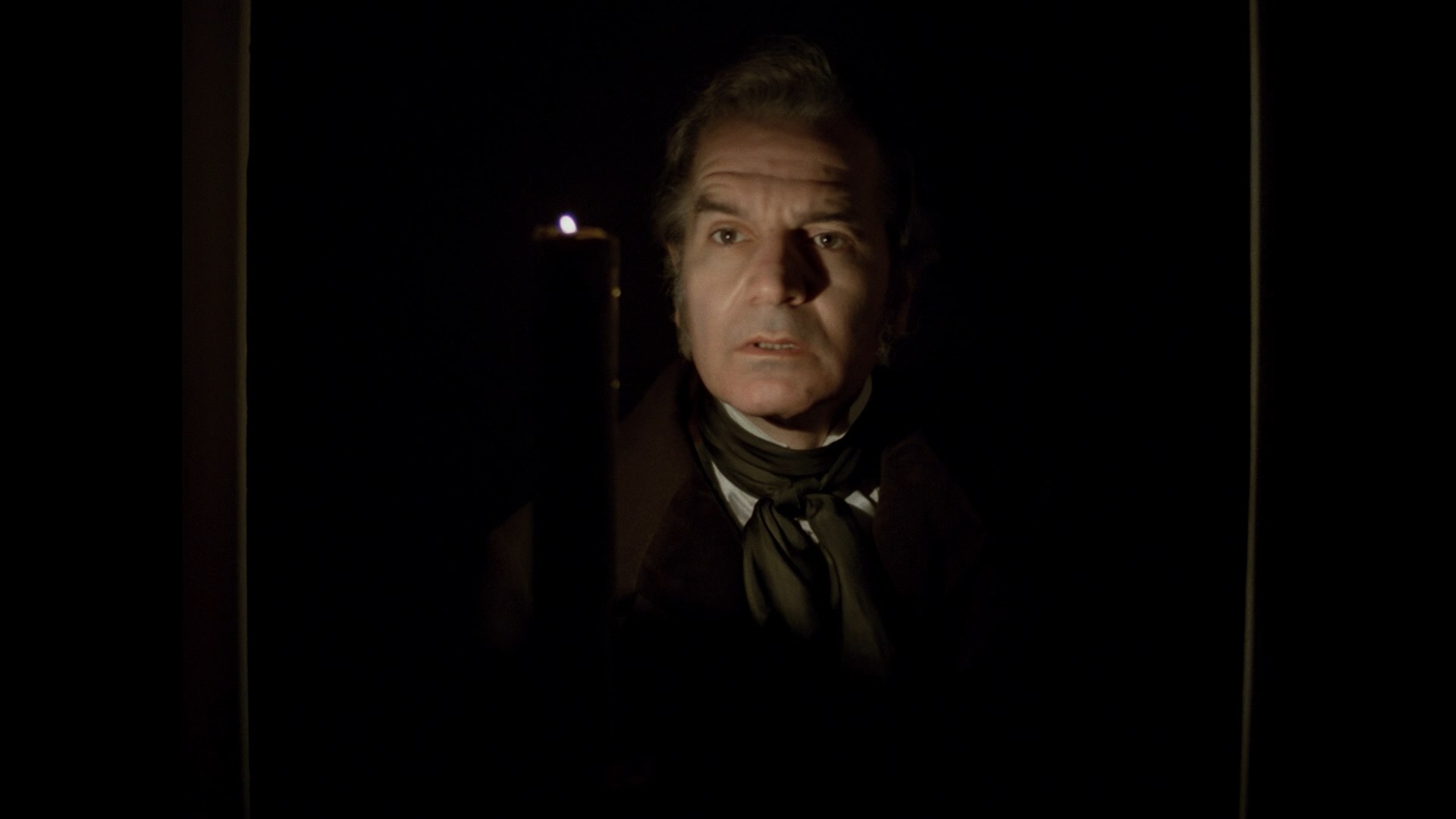
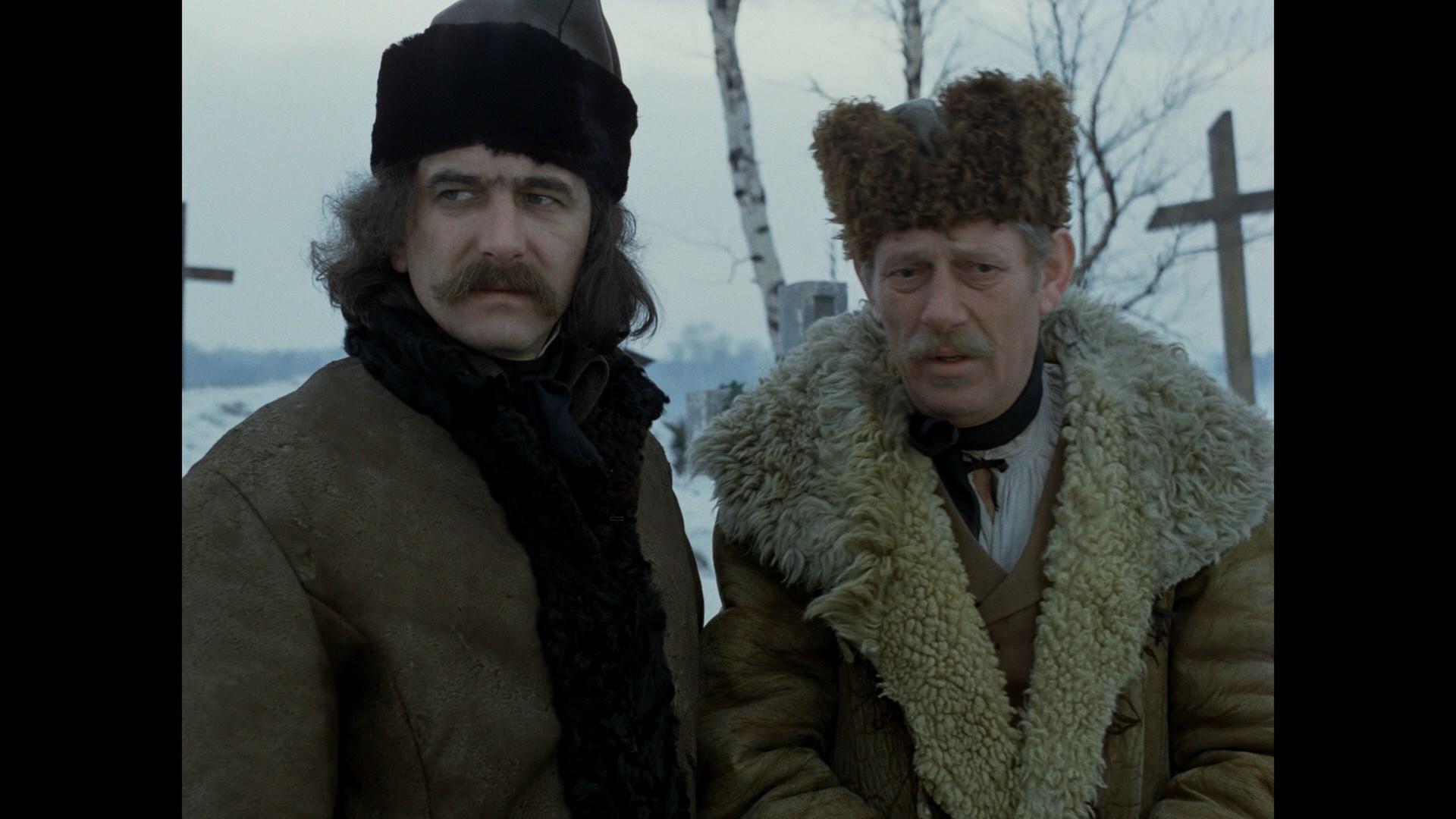 Disc eight features a pair of visually captivating Polish creature features, starting off with 1983's Wilczyca (or The She-Wolf). Directed by Marek Piestrak, the tale takes place in the mid-19th century countryside where liberation soldier Kacper (Krzysztof Jasiński) returns home from combat to find his very estranged, unfaithful, and resentful wife, Mary (Iwona Bielska), laying a curse upon him with a wolf's paw while she's in her death throes following a self-administered abortion. Aware of Mary's burgeoning witchcraft skills, Kacper's brother Mateusz (Jerzy Prażmowski) drives a stake through her body's heart for safety. After swearing off returning to the area ever again, Kacper ends up crossing paths with military official Count Ludwik (Stanisław Brejdygant) and becomes convinced his bride, Julia (Bielska again), is possessed by Mary and connected to the supernatural wolf-related activities in the area. With increasing horror, Kacper fears that history could be repeating itself and starts to take drastic steps to stop it.
Disc eight features a pair of visually captivating Polish creature features, starting off with 1983's Wilczyca (or The She-Wolf). Directed by Marek Piestrak, the tale takes place in the mid-19th century countryside where liberation soldier Kacper (Krzysztof Jasiński) returns home from combat to find his very estranged, unfaithful, and resentful wife, Mary (Iwona Bielska), laying a curse upon him with a wolf's paw while she's in her death throes following a self-administered abortion. Aware of Mary's burgeoning witchcraft skills, Kacper's brother Mateusz (Jerzy Prażmowski) drives a stake through her body's heart for safety. After swearing off returning to the area ever again, Kacper ends up crossing paths with military official Count Ludwik (Stanisław Brejdygant) and becomes convinced his bride, Julia (Bielska again), is possessed by Mary and connected to the supernatural wolf-related activities in the area. With increasing horror, Kacper fears that history could be repeating itself and starts to take drastic steps to stop it.
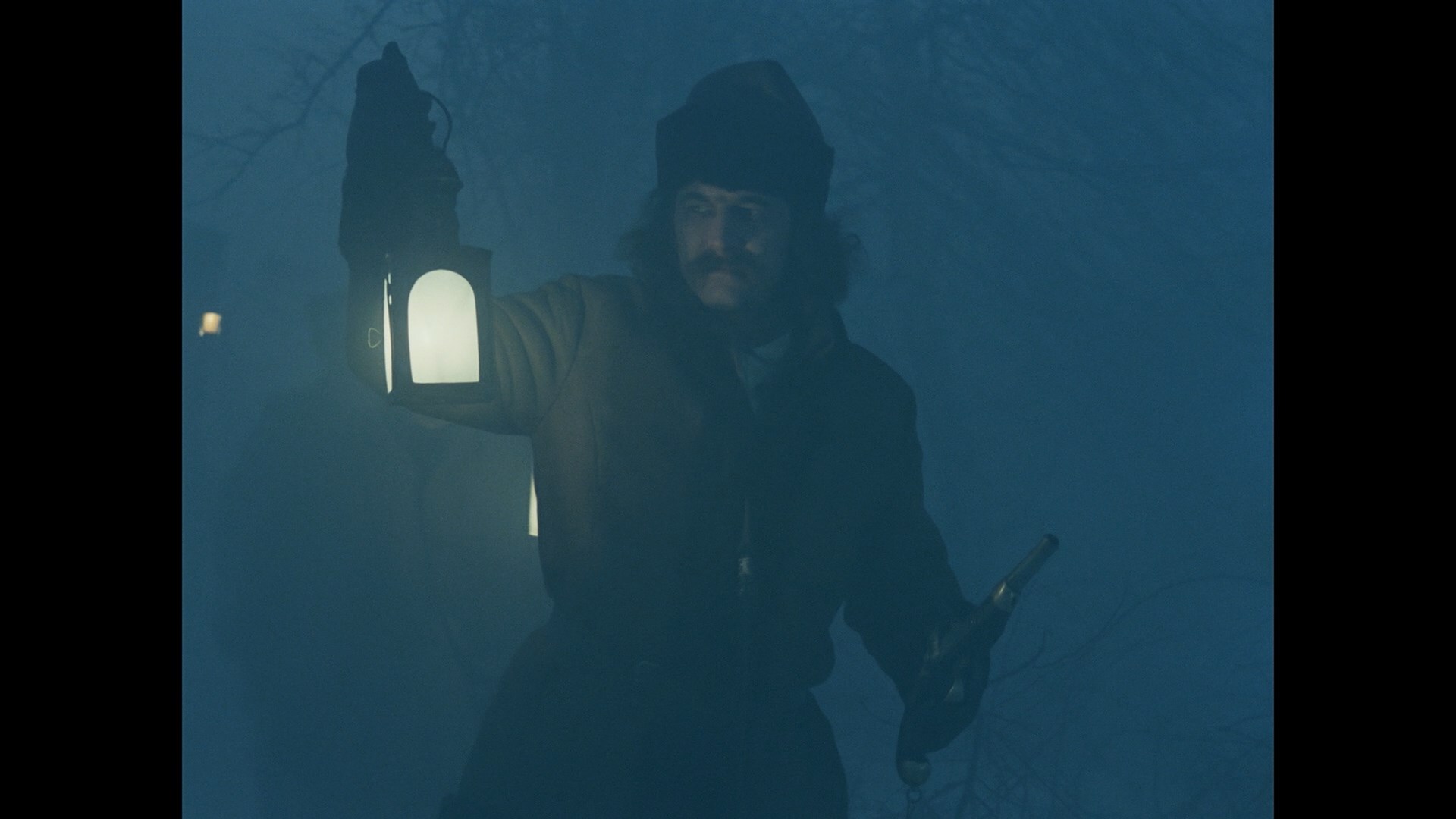 From its opening shot of nature's predators in action, this is a somber and haunting film that
From its opening shot of nature's predators in action, this is a somber and haunting film that 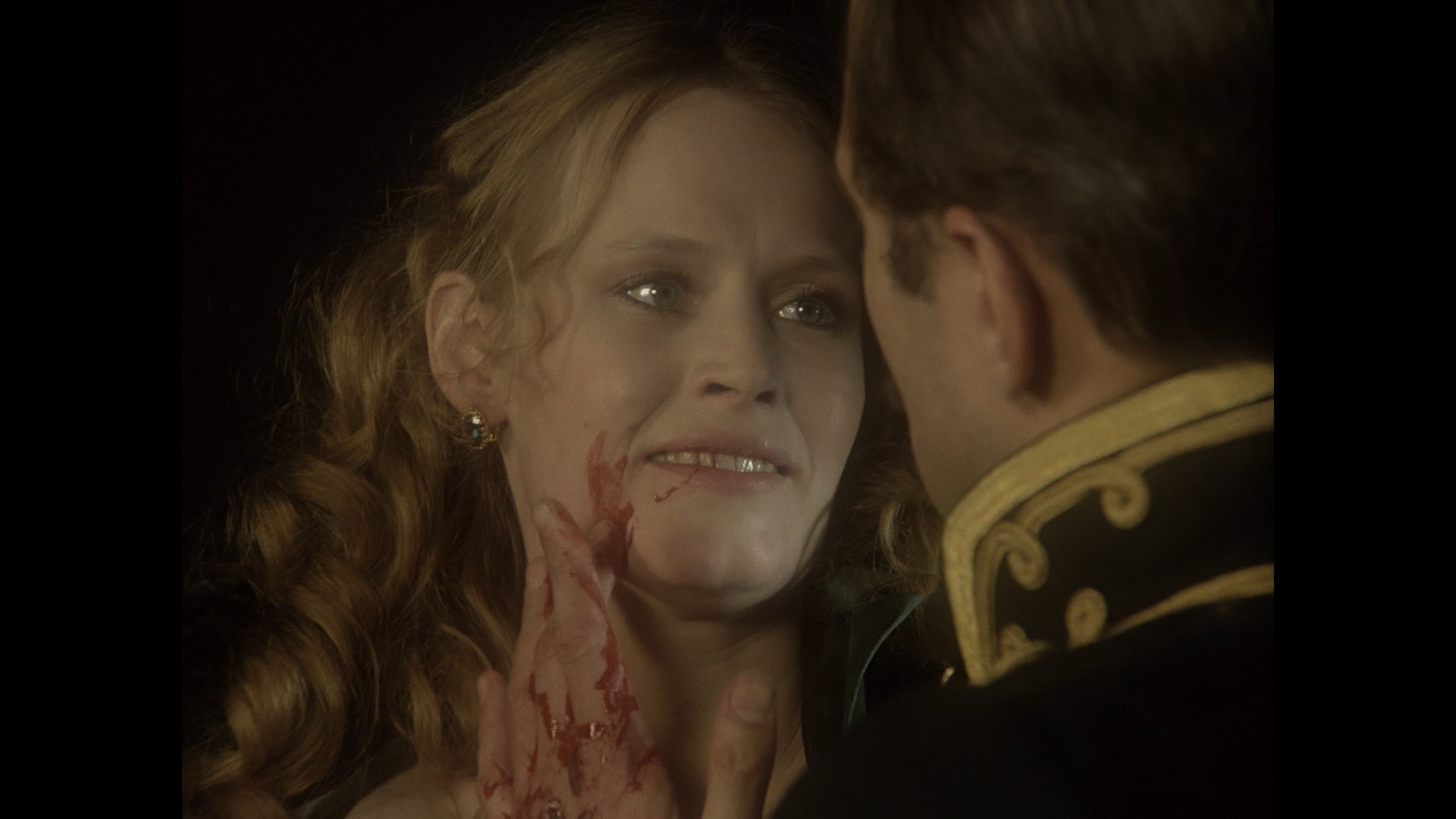 carefully doles out its shocks (including a handful of creepy monster effects and one very gory climactic scene) and gradually works up a nice air of paranoia and dread. The quiet approach and methodical pacing won't be for everyone, but Bielska's unnerving performance(s) and the exquisite, ornate look of the film should be enough to compel anyone interested in Polish horror to find this more than worthwhile. It's also one of the coldest horror films you'll ever see with the soundtrack usually filled with rushing wind, howls, and crackling feet on snowfall, which makes it perfect viewing in wintertime.
carefully doles out its shocks (including a handful of creepy monster effects and one very gory climactic scene) and gradually works up a nice air of paranoia and dread. The quiet approach and methodical pacing won't be for everyone, but Bielska's unnerving performance(s) and the exquisite, ornate look of the film should be enough to compel anyone interested in Polish horror to find this more than worthwhile. It's also one of the coldest horror films you'll ever see with the soundtrack usually filled with rushing wind, howls, and crackling feet on snowfall, which makes it perfect viewing in wintertime.
Never officially released in any form in the U.S. before the Severin set, Wilczyca has only been released on DVD in Poland as part of a three-film Horrory set with 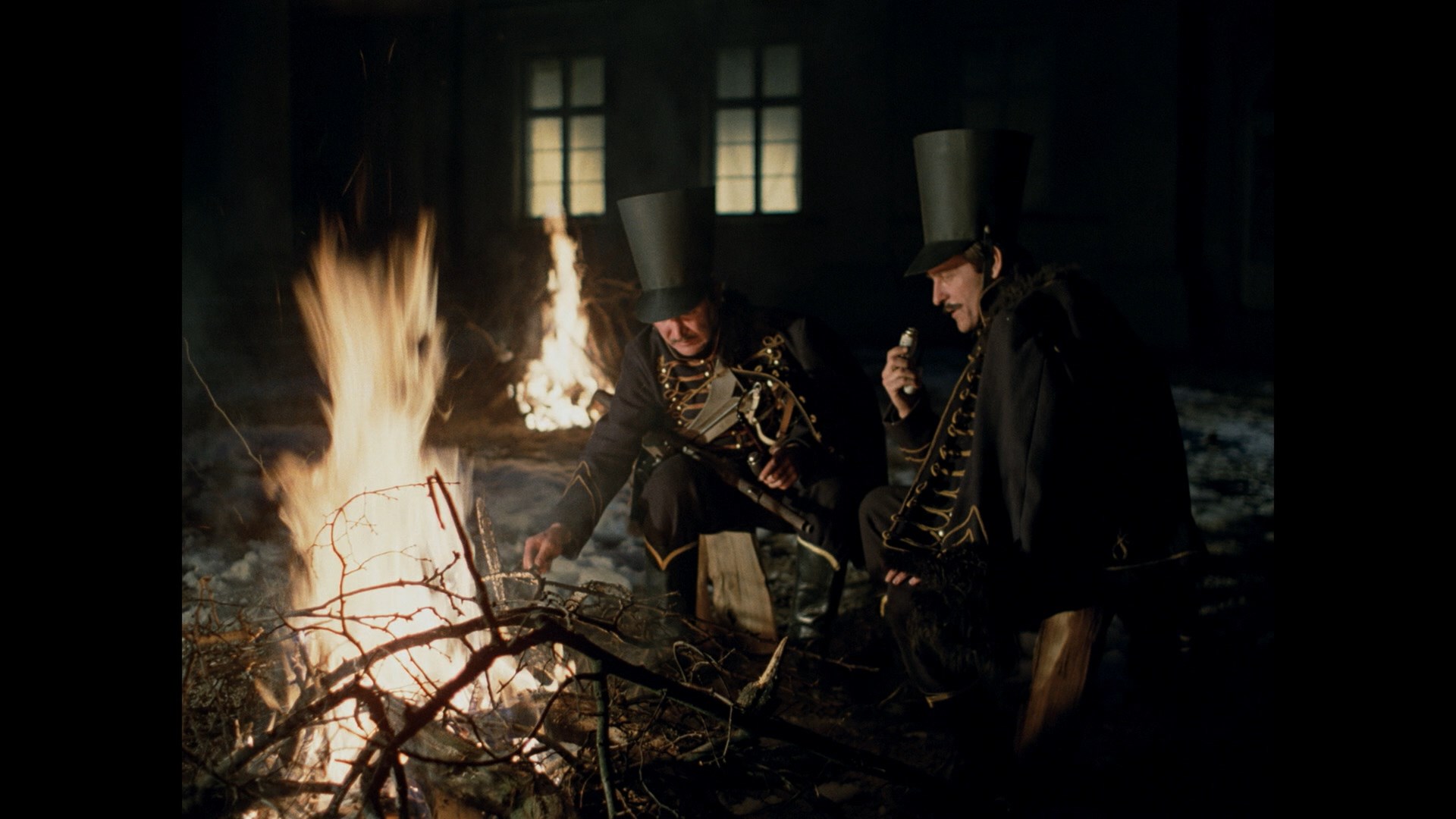 Lokis (see below) and Widziadło (The Phantom). Featuring a new HD restoration from the original negative
Lokis (see below) and Widziadło (The Phantom). Featuring a new HD restoration from the original negative 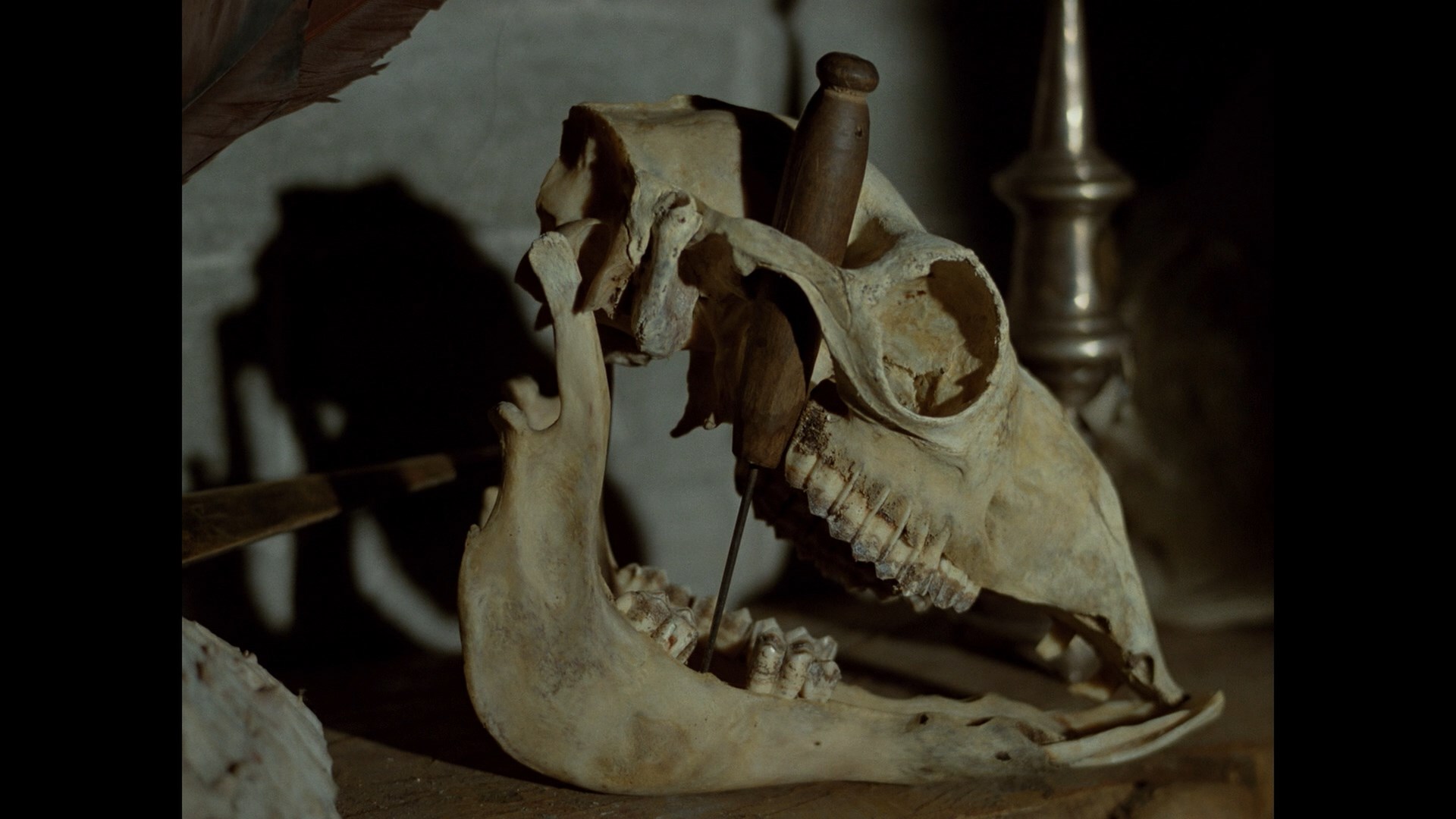 by WFDIF in Warsaw, the Blu-ray looks immeasurably superior to the DVD (which was pulled from a colorful but somewhat murky print) with excellent detail that really allows you to finally savor the intricate production design and costumes. The Polish DTS-HD MA 2.0 mono audio also sounds excellent and, as usual, features optional yellow English subtitles. The one extra is "Unleashing the She-Wolf" (10m37s) with Piestra explaining how he had to go back and rework the story after his first script was rejected, the mandate to change what were originally Russian officers, the choice of period setting mandated by those pivotal photographs, and other bits of cultural commentary in the film.
by WFDIF in Warsaw, the Blu-ray looks immeasurably superior to the DVD (which was pulled from a colorful but somewhat murky print) with excellent detail that really allows you to finally savor the intricate production design and costumes. The Polish DTS-HD MA 2.0 mono audio also sounds excellent and, as usual, features optional yellow English subtitles. The one extra is "Unleashing the She-Wolf" (10m37s) with Piestra explaining how he had to go back and rework the story after his first script was rejected, the mandate to change what were originally Russian officers, the choice of period setting mandated by those pivotal photographs, and other bits of cultural commentary in the film.
A very appropriate co-feature here on the same disc is 1970's Lokis: A 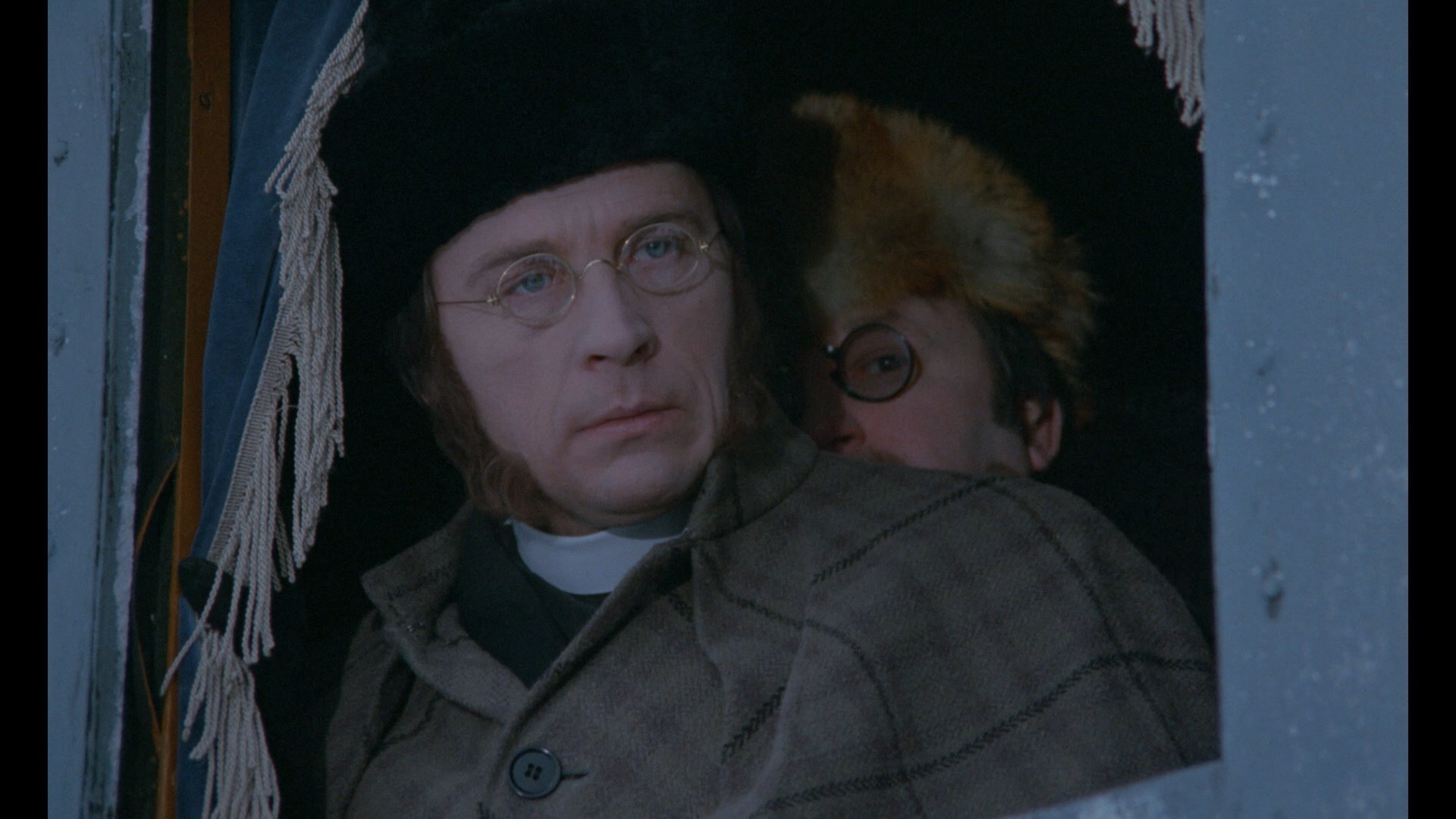 Manuscript of Professor Wittembach from director Janusz
Manuscript of Professor Wittembach from director Janusz 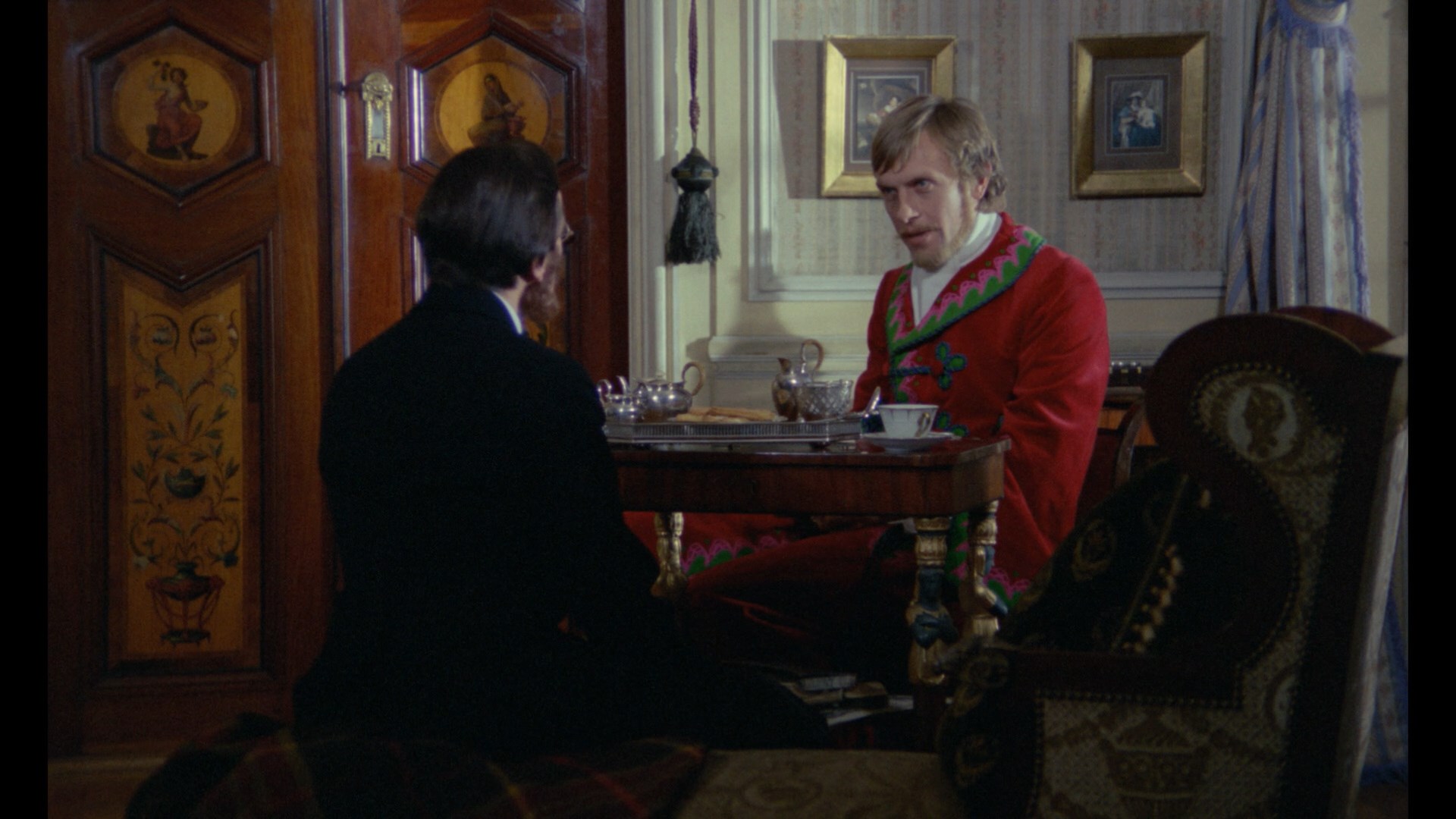 Majewski which, as mentioned above, was previously released on Polish DVD with Wilczyca and makes its U.S. premiere in any format here as well. Here we get another austere tale of animalistic terror adapted from a novella by Prosper Mérimée (Carmen) in which Reverend Wittembach (Edmund Fetting) takes an afternoon train ride to visit Count Michał Szemiot (Michał Durlasz) of Lithuania to perform a Bible translation. There he observes the strict treatment of the seemingly mad matriarch Countess Szemiot (Zofia Mrozowska), about whom the family physician (Gustaw Lutkiewicz) asks questions like "What do you think of euthanasia, reverend?" He also reunites with three of his voyage travel mates -- Catherine, Duchess of Pacow (Zofia Mrozowska), her niece Julia (Malgorzata Braunek), and governess Pamela (Luana Anders lookalike Hanna Stankówna) -- who all mingle in the local nobility where talk swirls about the Countess' attack by a
Majewski which, as mentioned above, was previously released on Polish DVD with Wilczyca and makes its U.S. premiere in any format here as well. Here we get another austere tale of animalistic terror adapted from a novella by Prosper Mérimée (Carmen) in which Reverend Wittembach (Edmund Fetting) takes an afternoon train ride to visit Count Michał Szemiot (Michał Durlasz) of Lithuania to perform a Bible translation. There he observes the strict treatment of the seemingly mad matriarch Countess Szemiot (Zofia Mrozowska), about whom the family physician (Gustaw Lutkiewicz) asks questions like "What do you think of euthanasia, reverend?" He also reunites with three of his voyage travel mates -- Catherine, Duchess of Pacow (Zofia Mrozowska), her niece Julia (Malgorzata Braunek), and governess Pamela (Luana Anders lookalike Hanna Stankówna) -- who all mingle in the local nobility where talk swirls about the Countess' attack by a 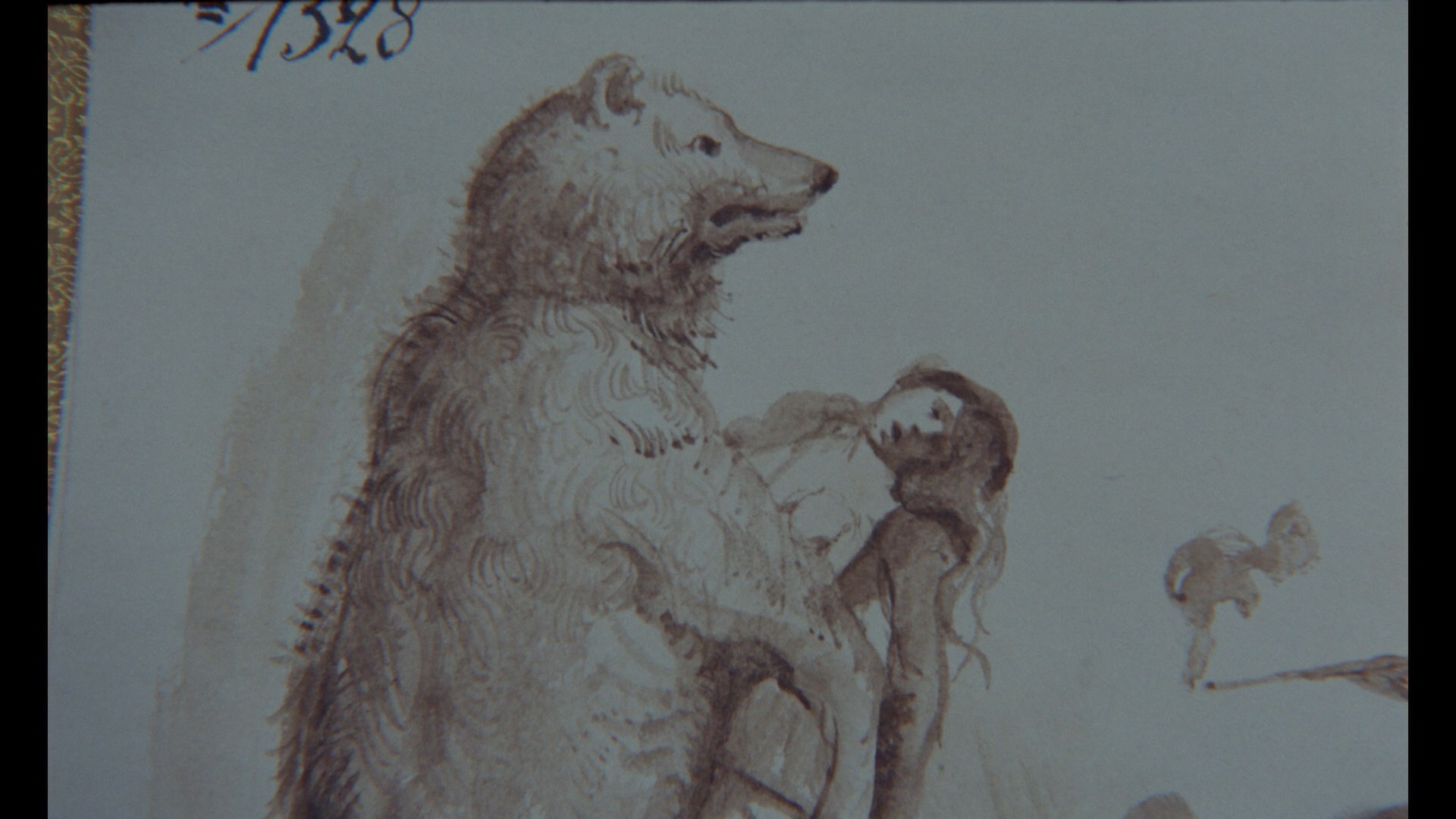 bear on her wedding night and the family curse it may have spawned. When it's time for the Count to get
bear on her wedding night and the family curse it may have spawned. When it's time for the Count to get 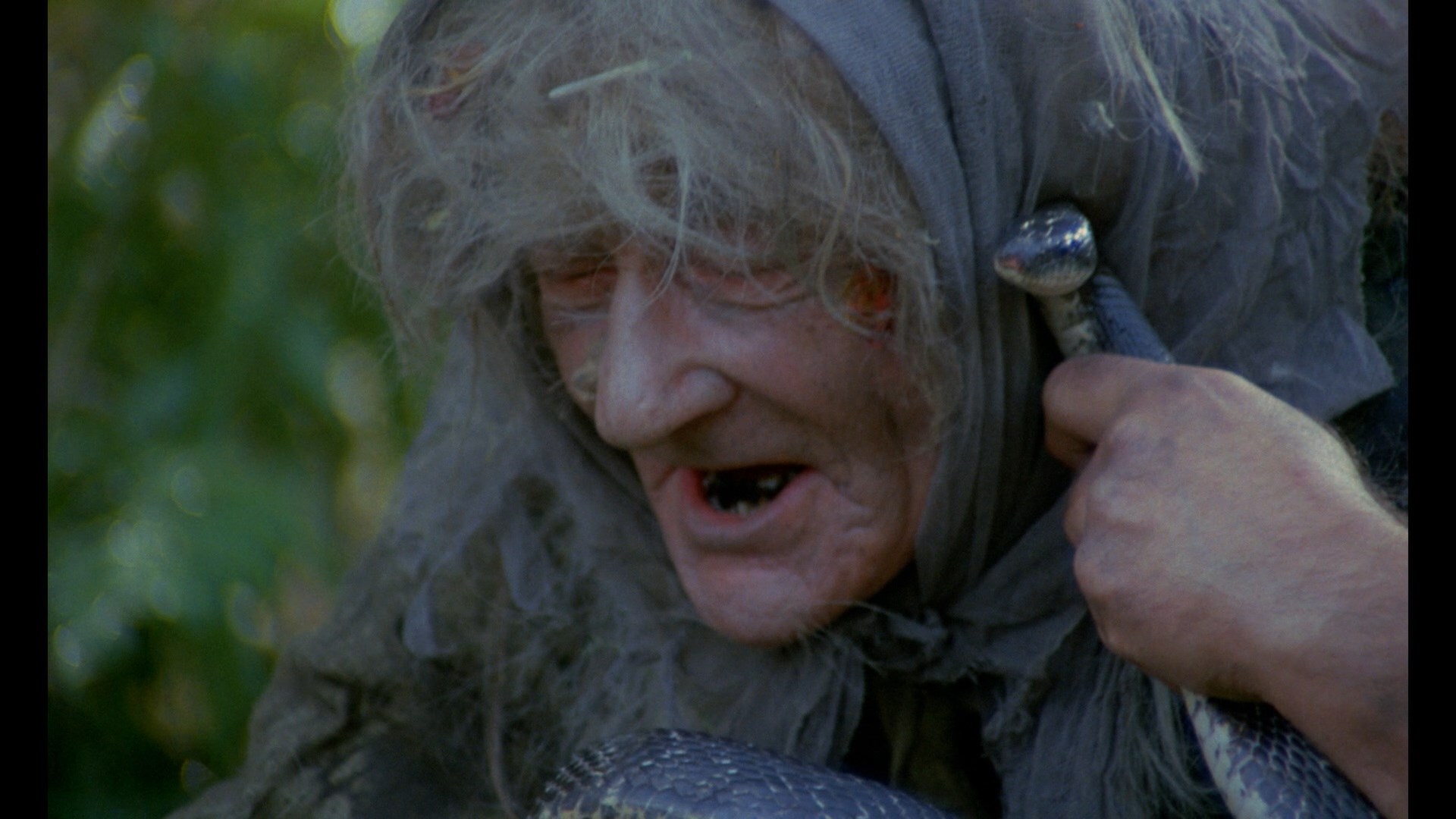 married to one of the women, needless to say, all does not go well.
married to one of the women, needless to say, all does not go well.
A film of eerie suggestion more than outright horror, Lokis has a strong AIP vibe at times with its forbidding swamp, dark family secrets, superstitious coachmen, colorful candles, and sprawling mansion. Of course, the implied bestiality aspects add a very un-American layer of perversity that the film manages to still be a bit ambiguous about right to the end. Like a lot of Polish horror it could also be read as a very dark comedy of manners about the denial and suppression inherent in the nobility, here taken to a supernatural extreme that only gradually reveals itself. Whether this approach will work for all viewers is debatable given the divisive responses to this film over the years, but it's a beautifully mounted production that will resonate quite a bit if you're feeling receptive. The restoration here is on par with its companion film and a significant leap over the murkier, higher contrast DVD; try to watch it on the biggest screen you can for maximum effect. The one bonus here is a new interview with Majewski, "Wild Country Of The Were-Bear" (13m51s), which covers his love of antiquated trappings (this would make a fun double feature with any number of Walerian Borowczyk films), the high skill level of Polish film technicians, the handmade costumes, the inspiration of classic films, and the backgrounds of his cast.
WILCZYCA: Severin (Blu-ray)
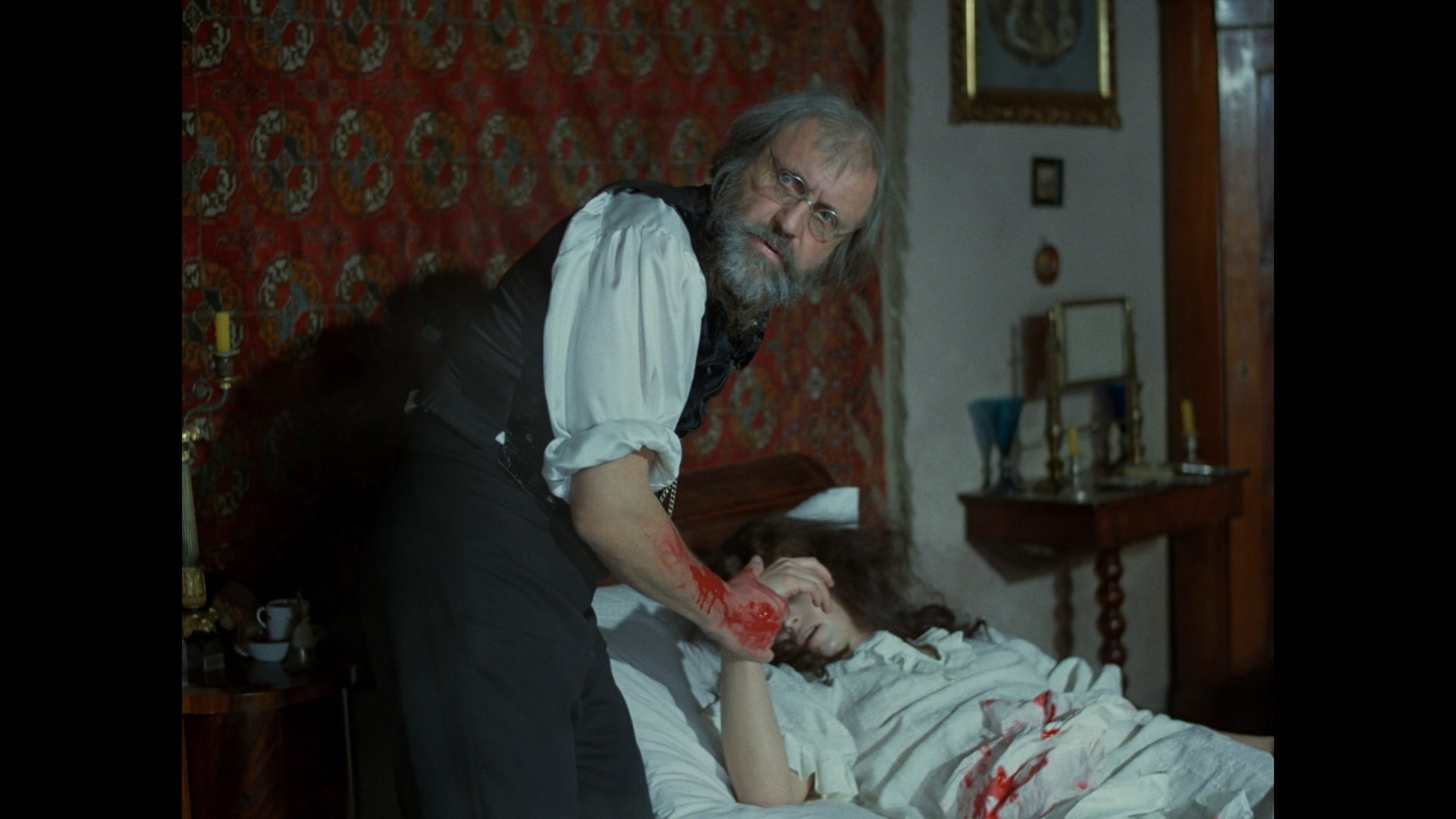
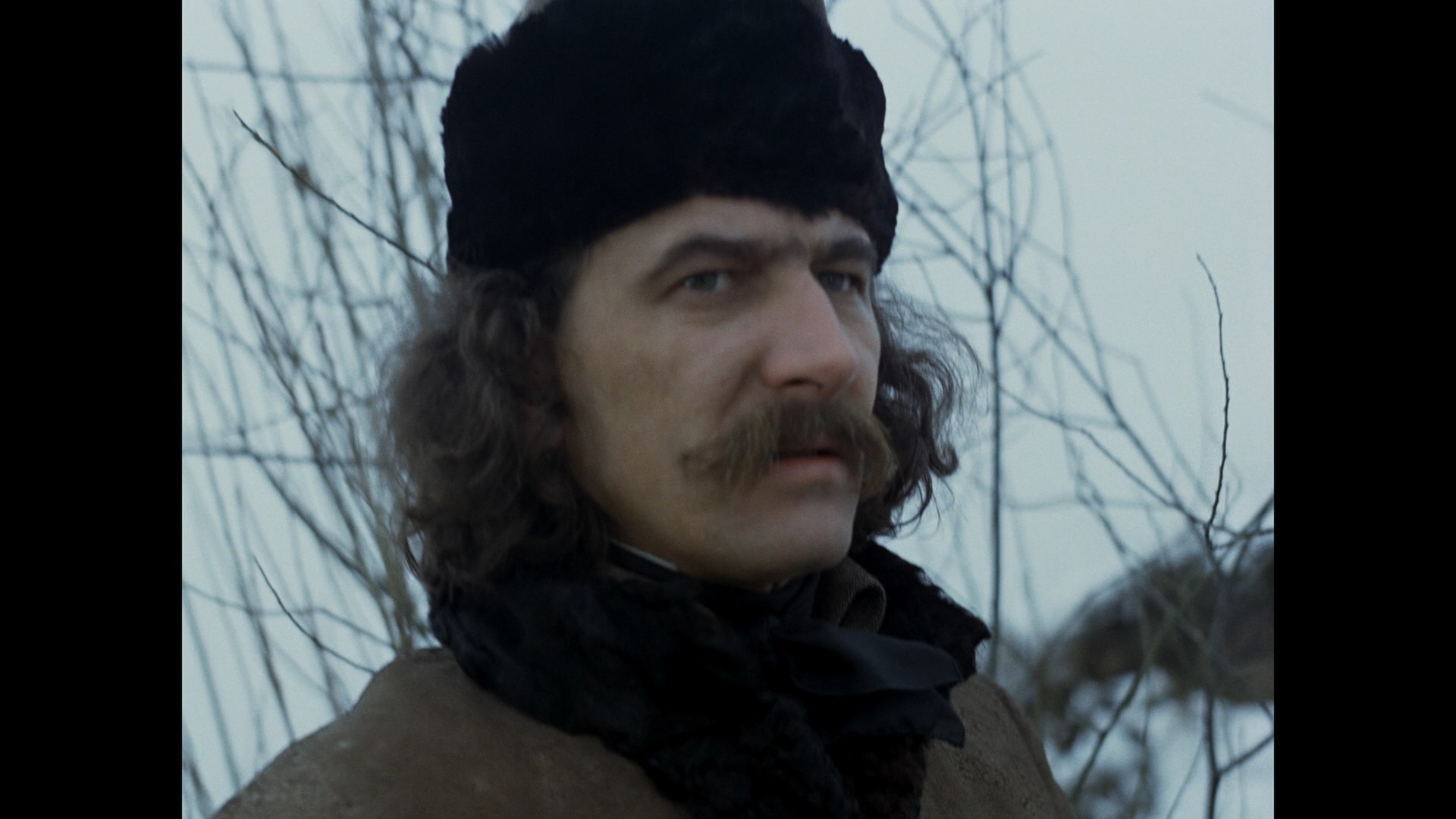
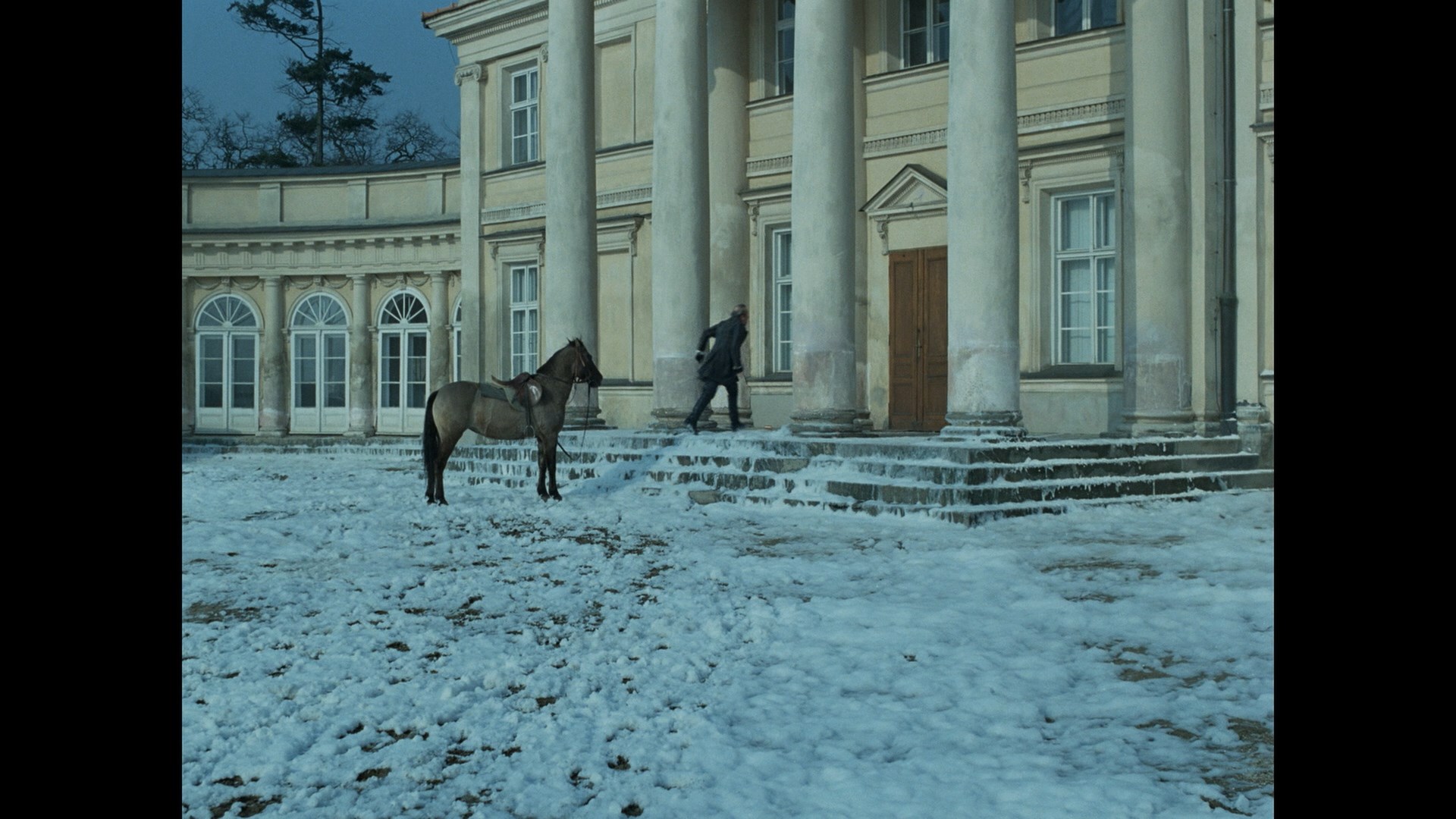
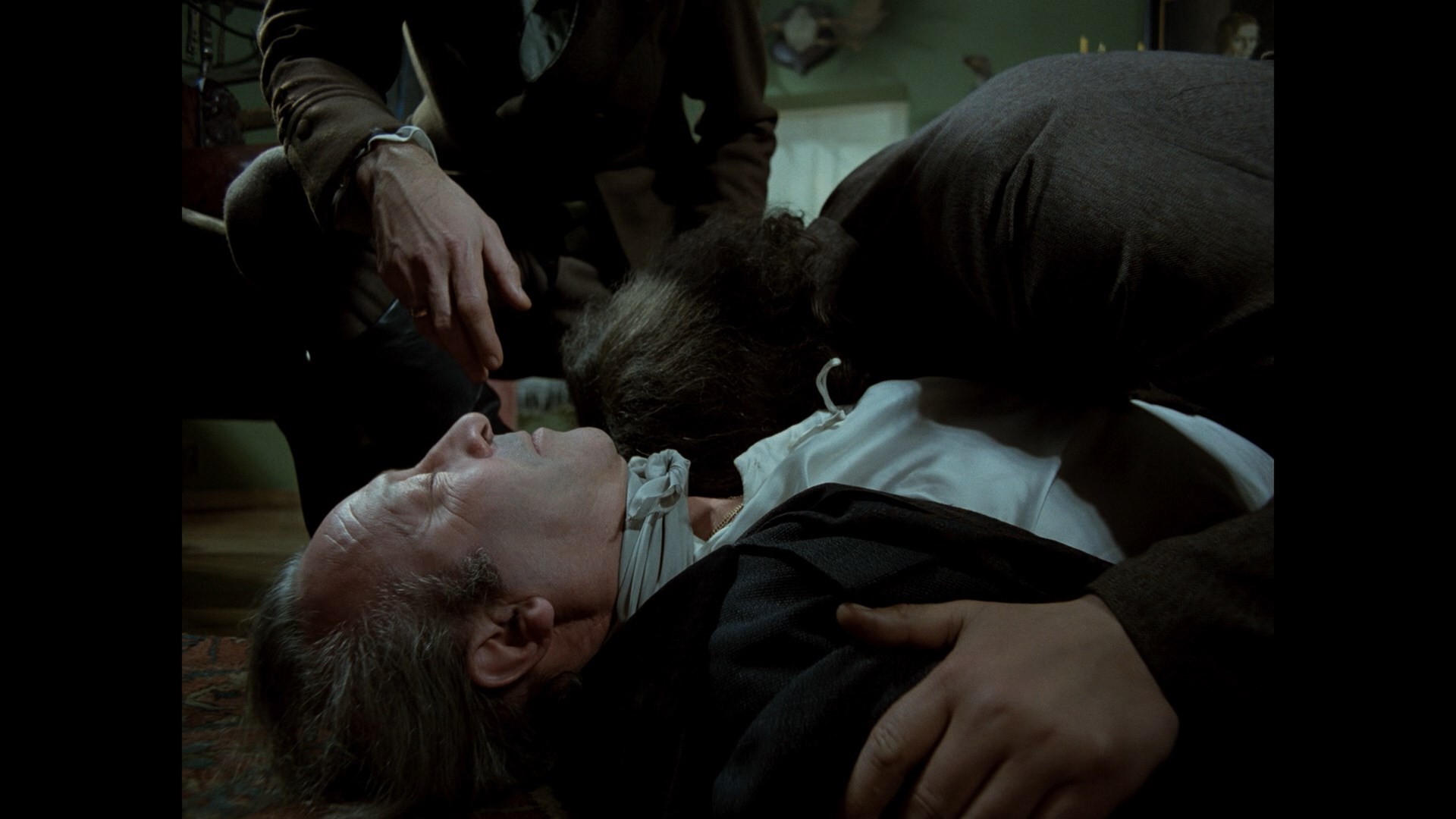
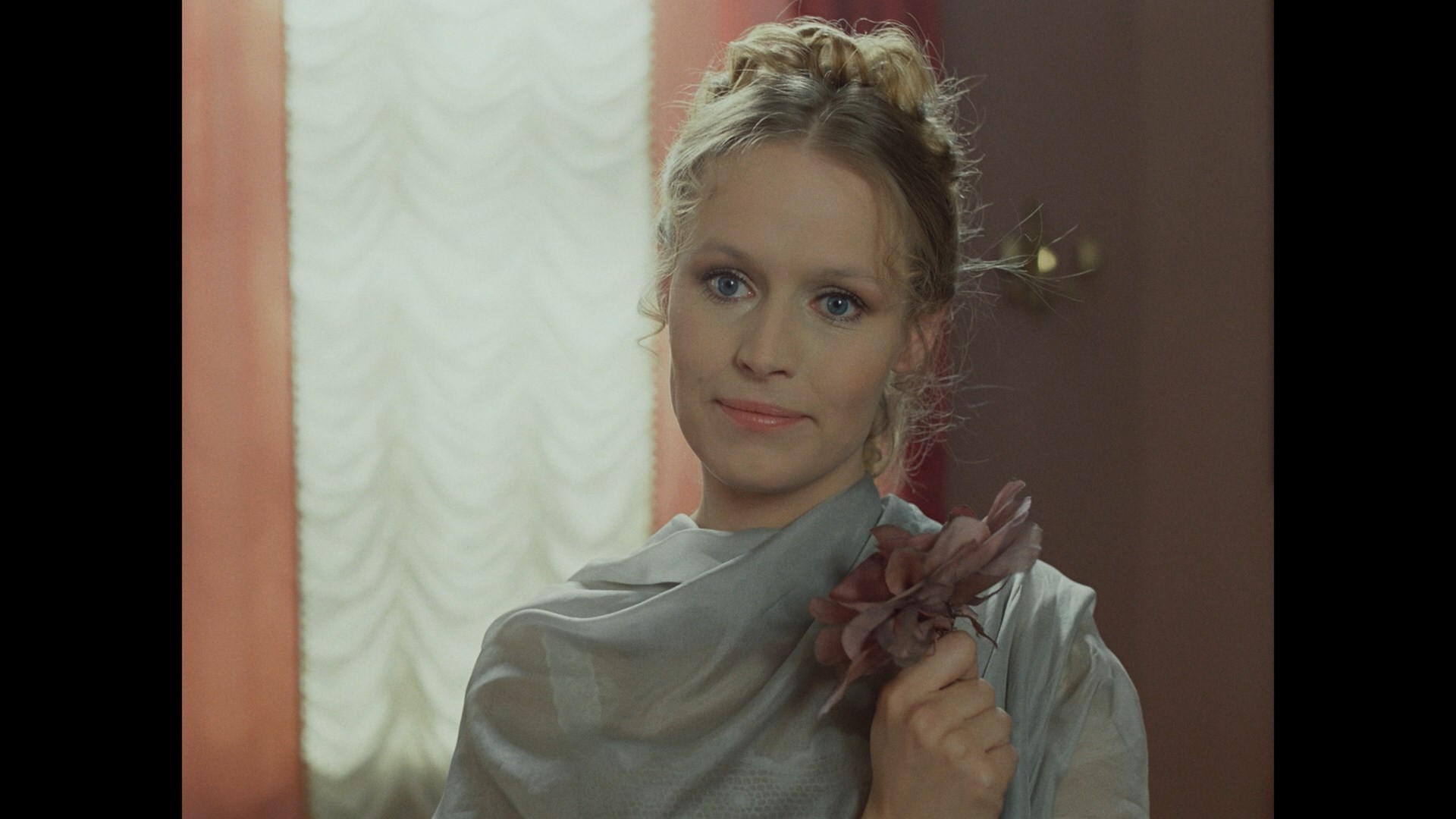
WILCZYCA: KinoPolska (DVD)
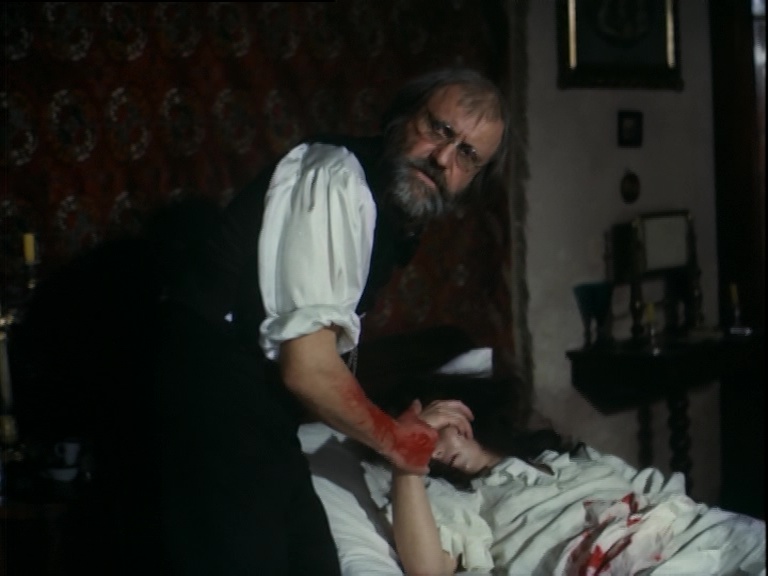
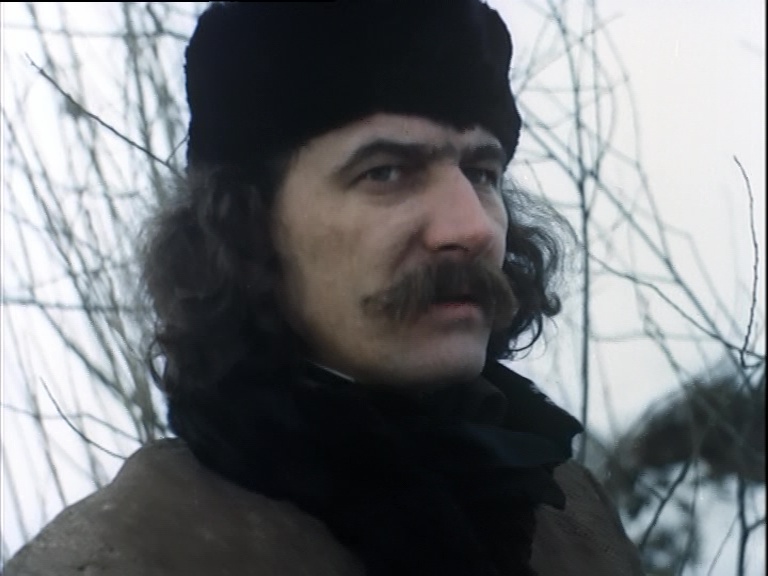

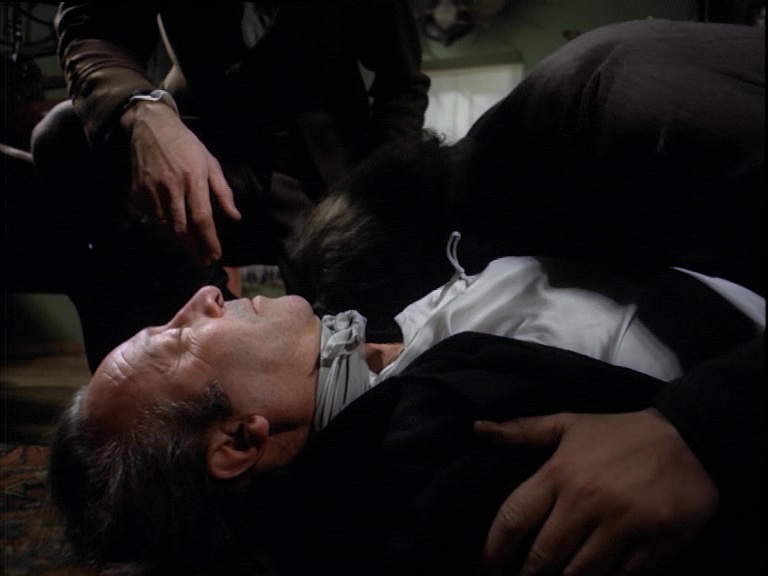
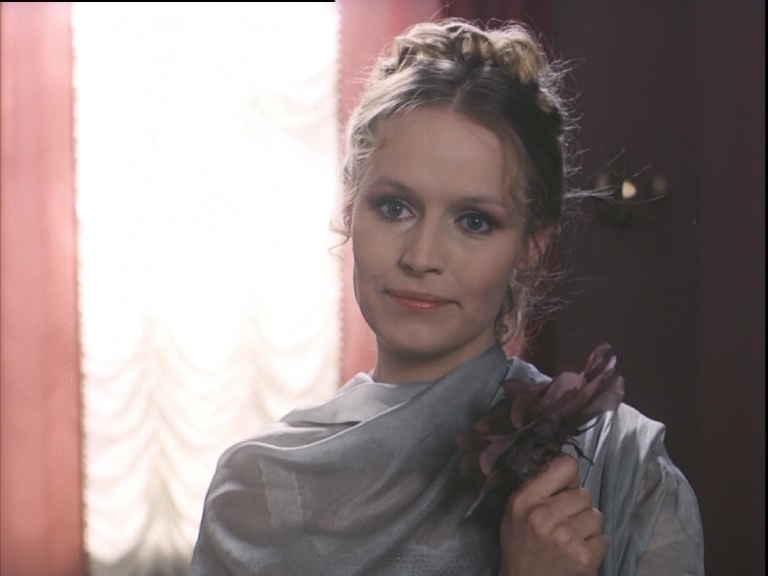
LOKIS: Severin (Blu-ray)
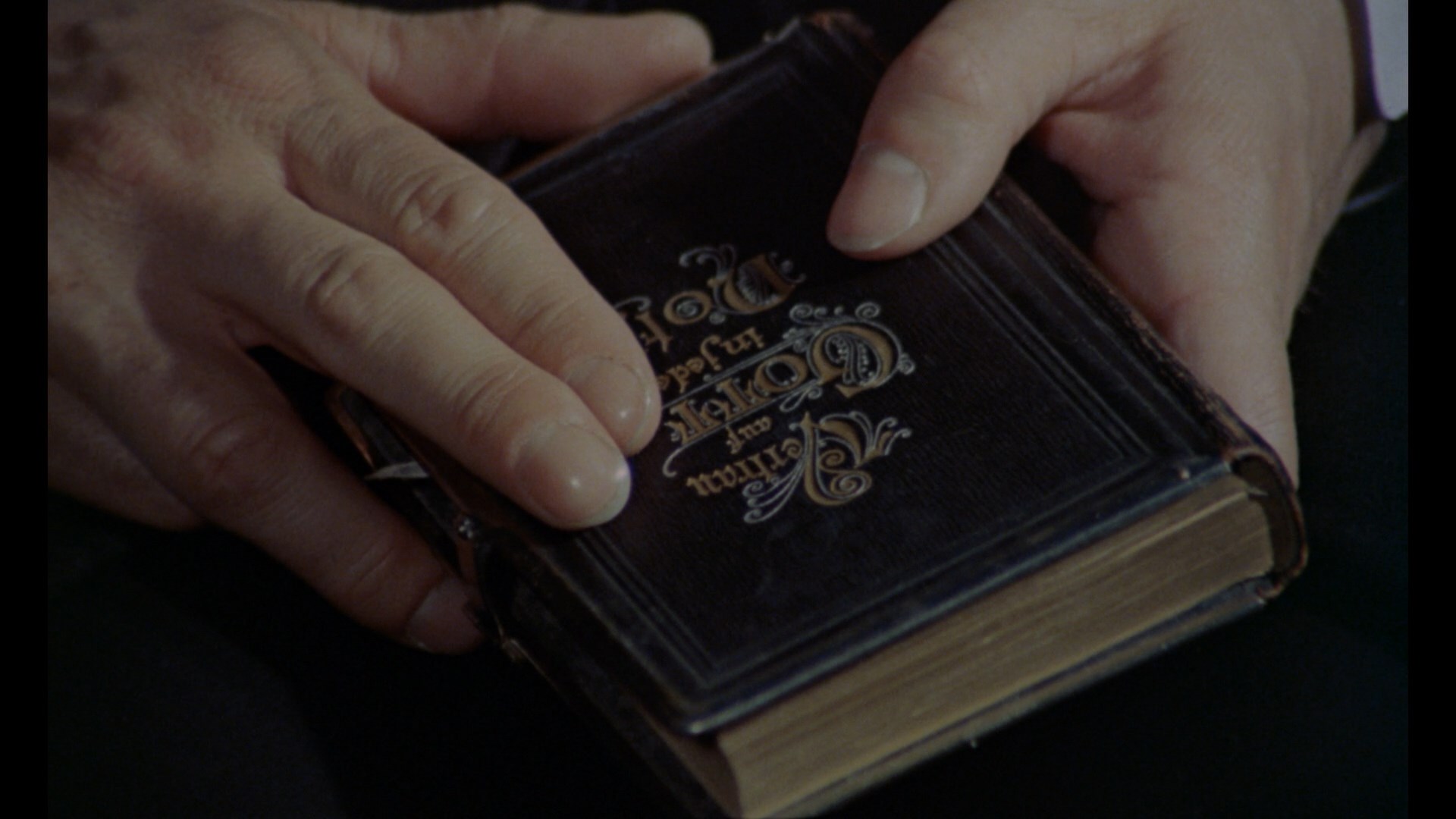
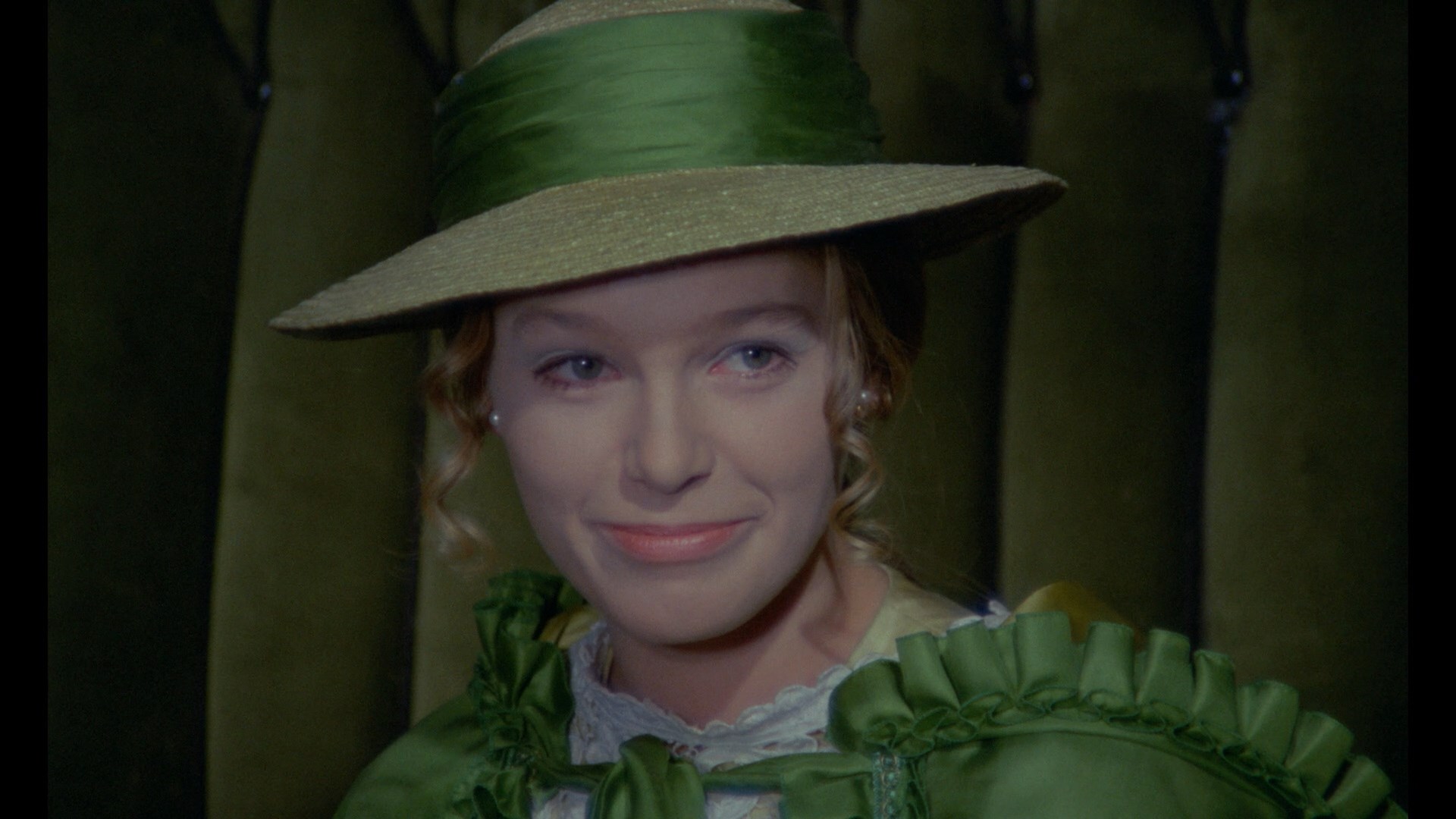
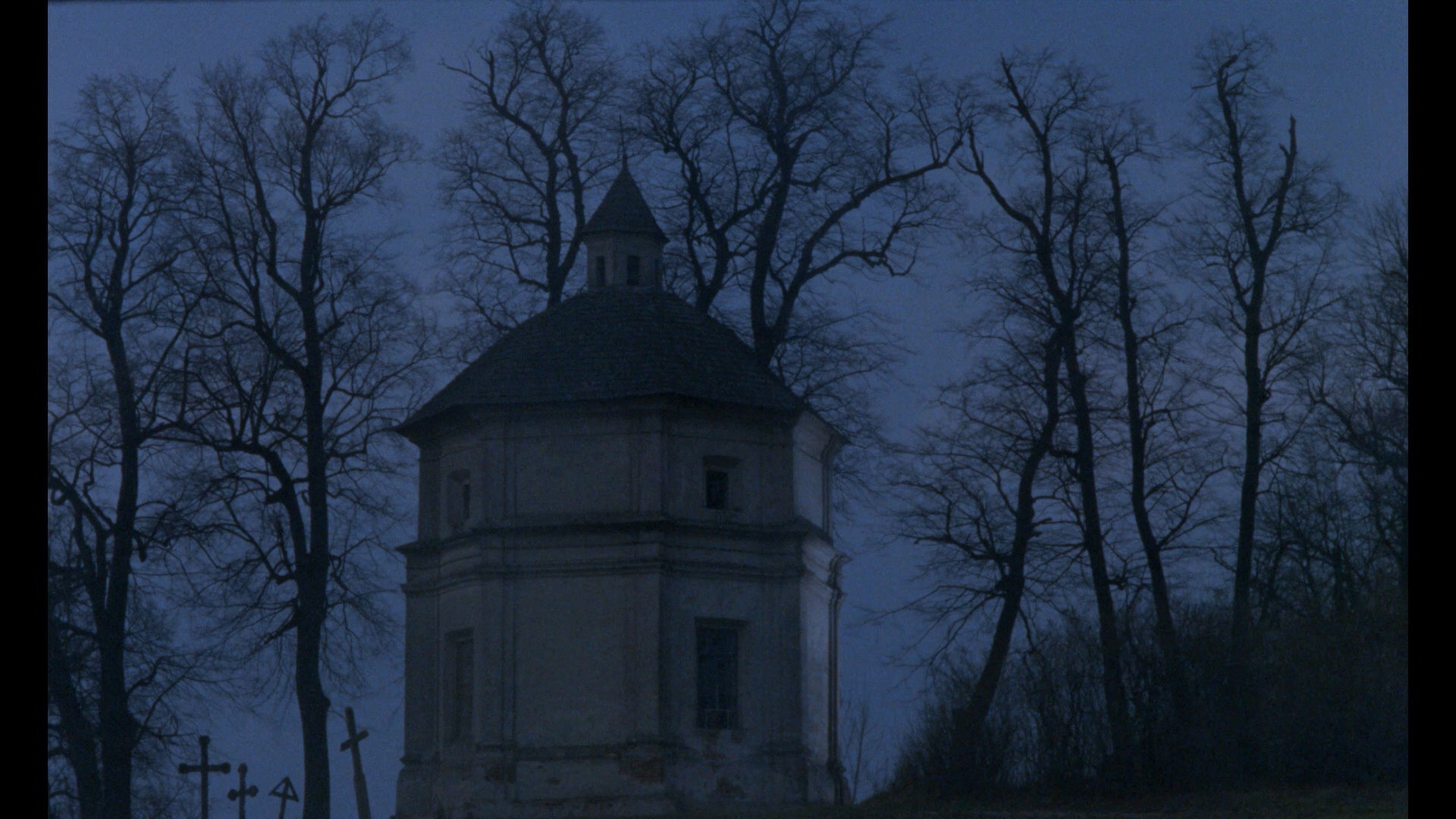
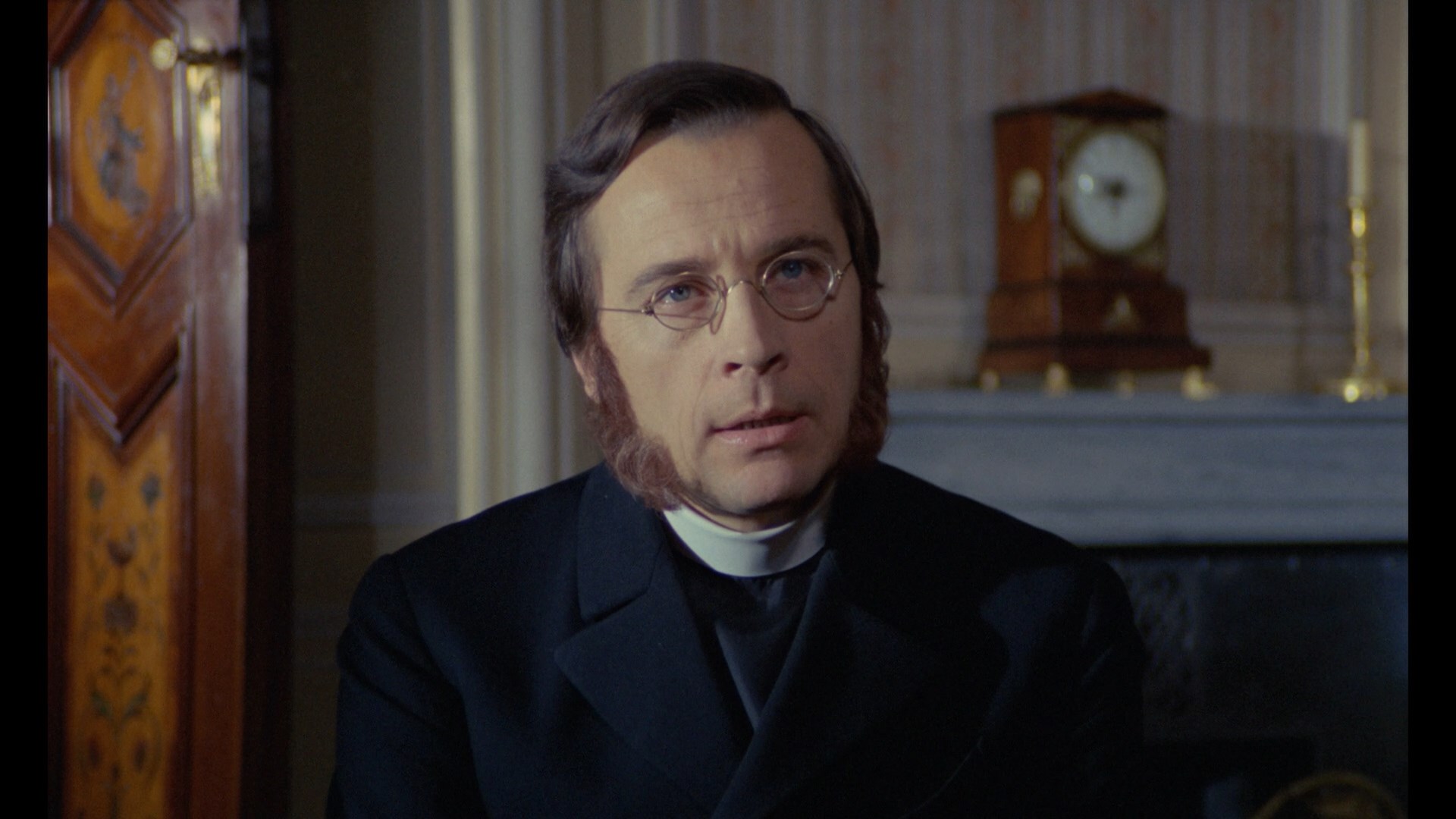
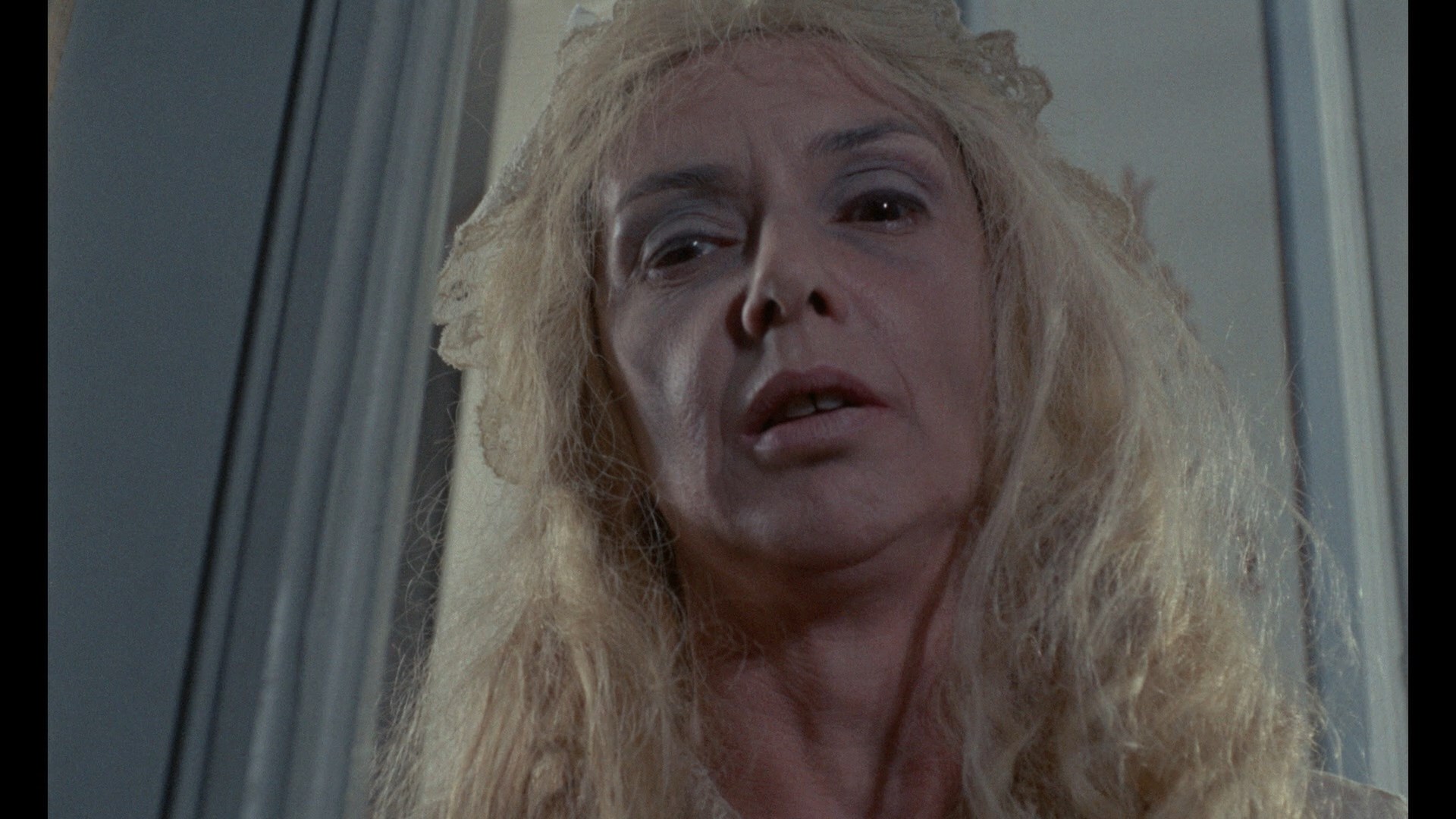
LOKIS: KinoPolska (DVD)
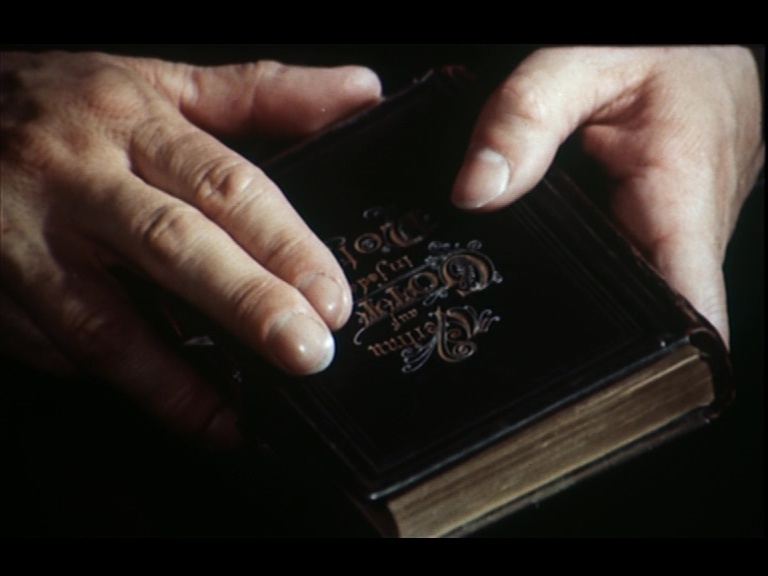
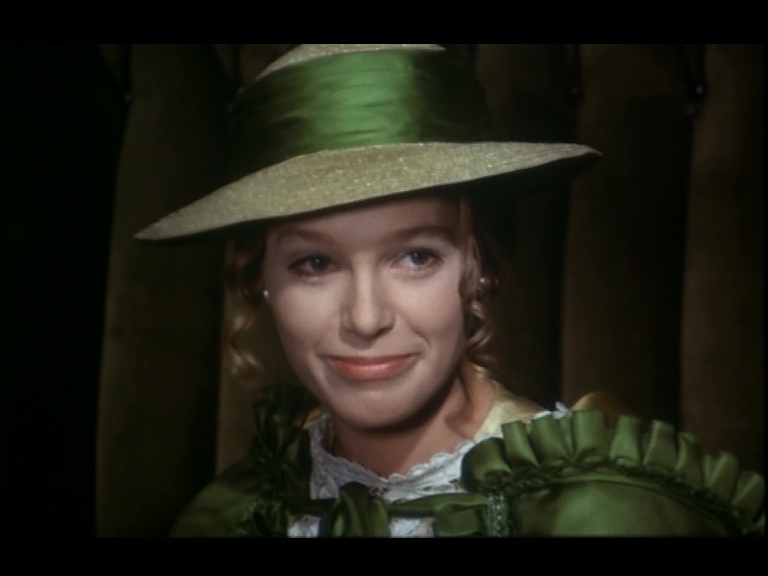
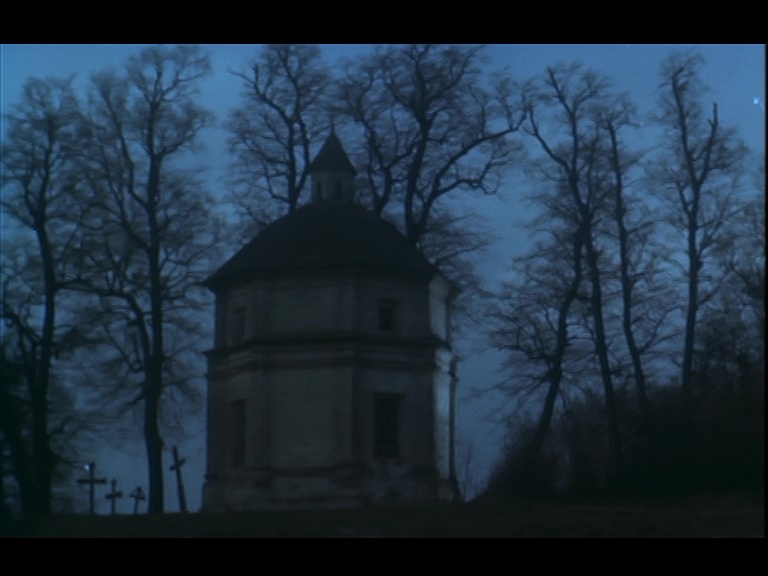
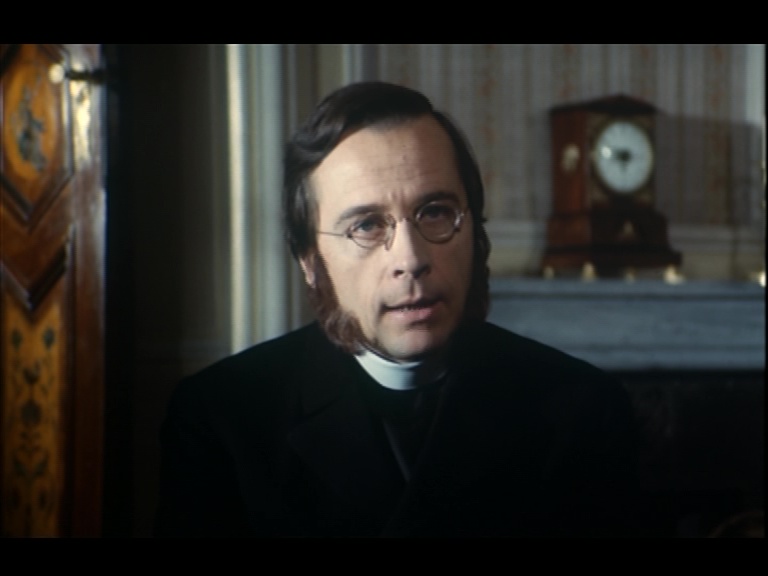
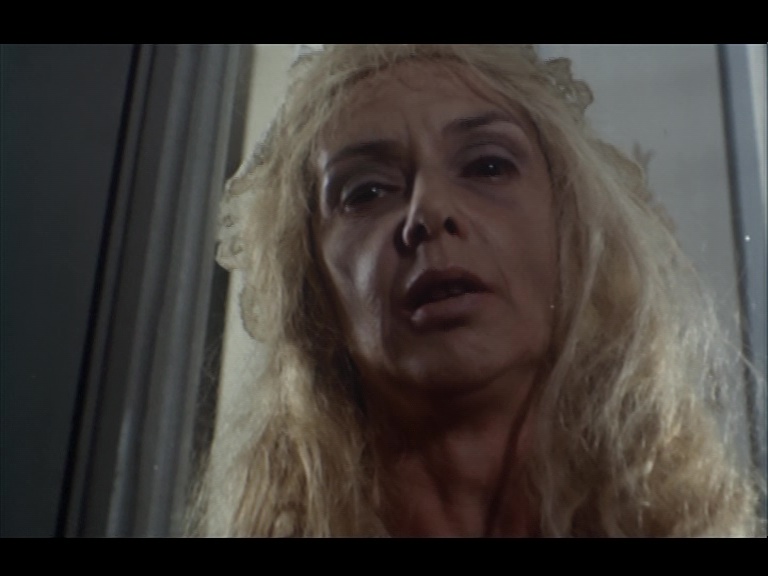
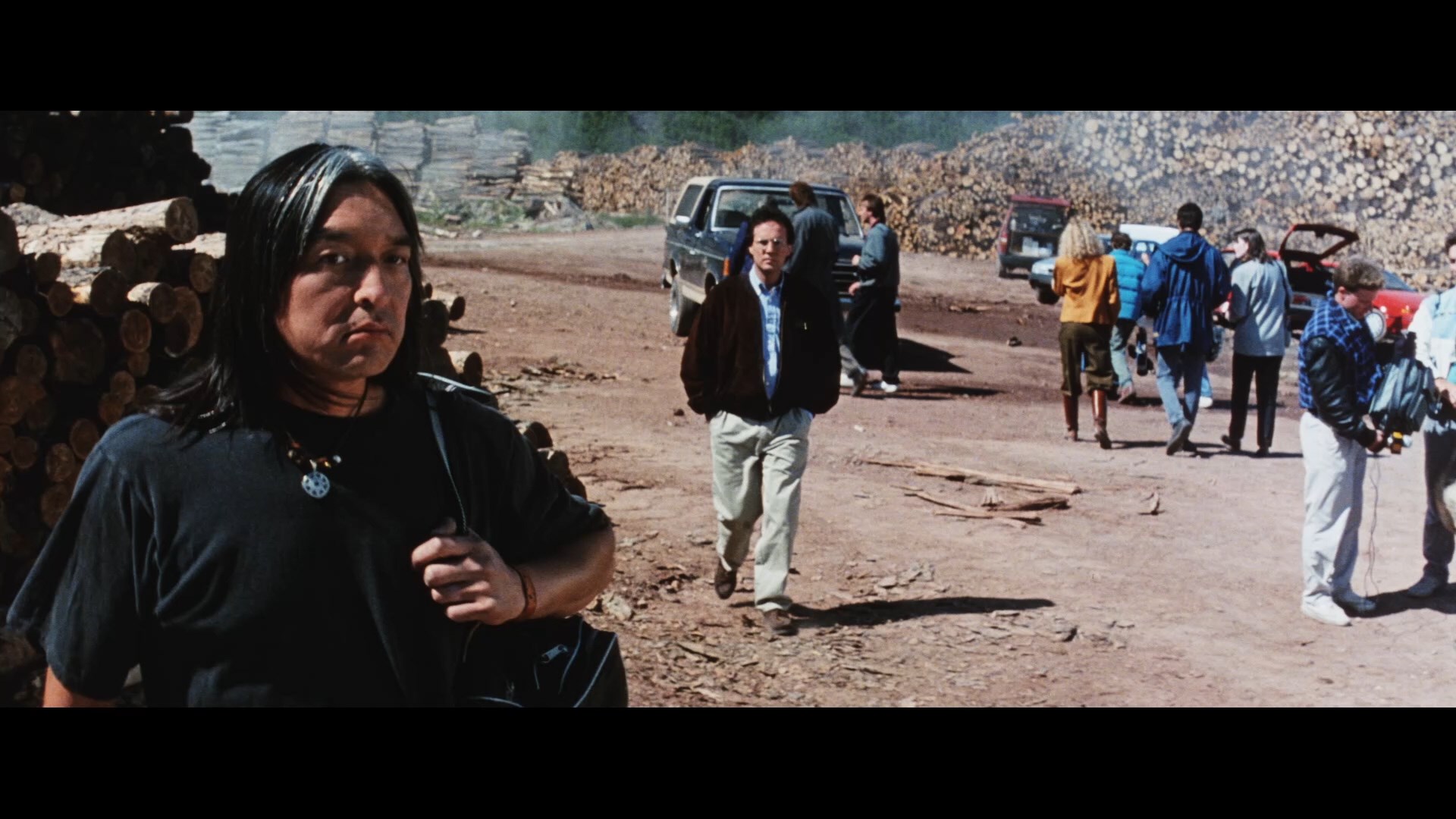 The Native
The Native 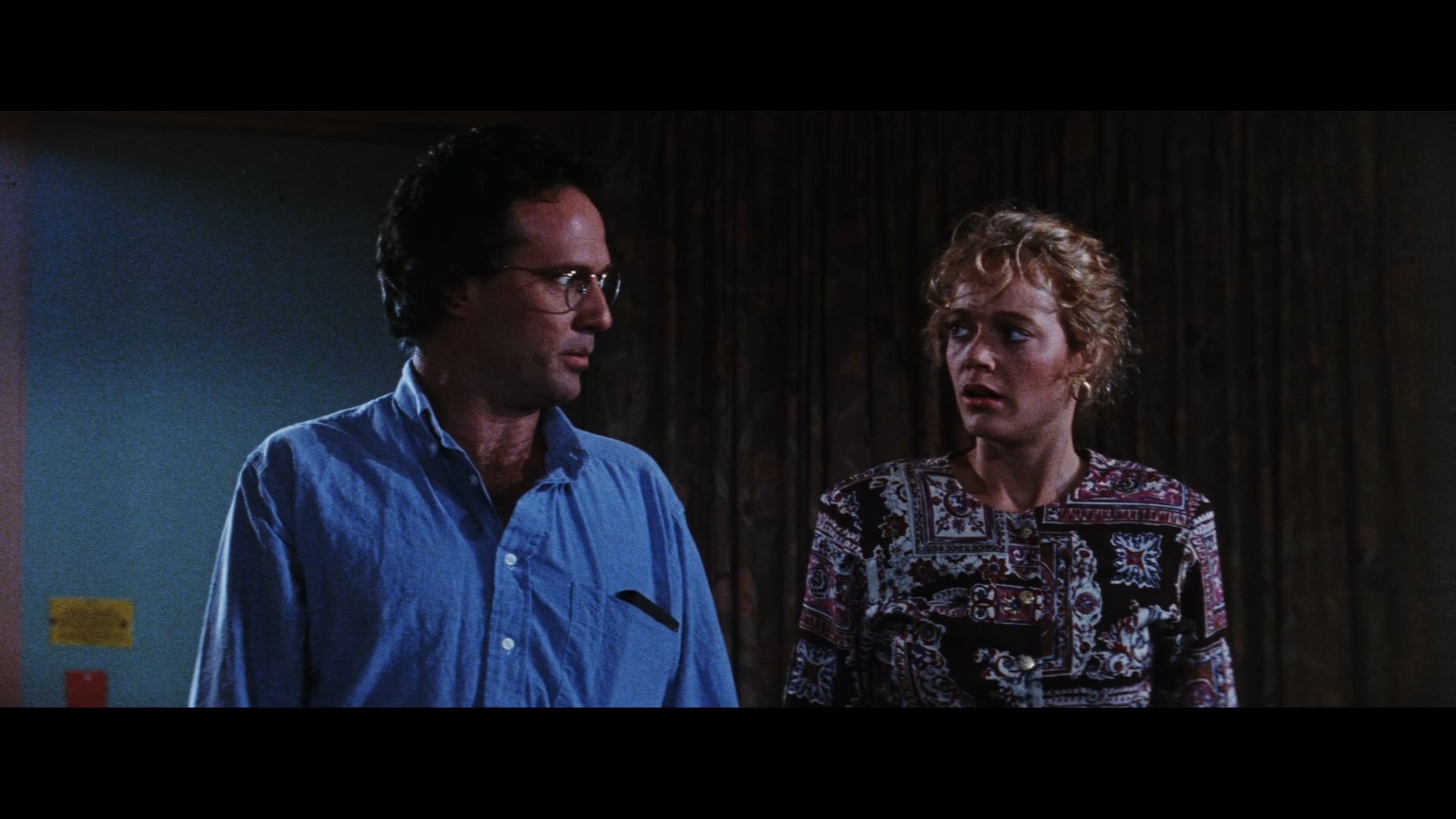 American angle on folk horror discussed in the documentary doesn't turn up again in the set until disc nine with 1991's Clearcut, a Canadian production offering a solid showcase role for the always reliable Graham Greene. How much you could call this "horror" is up for debate, but it's does have some harrowing violent bits and works very effectively as an expression of cinematic rage.
American angle on folk horror discussed in the documentary doesn't turn up again in the set until disc nine with 1991's Clearcut, a Canadian production offering a solid showcase role for the always reliable Graham Greene. How much you could call this "horror" is up for debate, but it's does have some harrowing violent bits and works very effectively as an expression of cinematic rage.
Attorney Peter Maguire (Lea) flies into a beautiful area of wilderness where a ruthless logging company is not only razing the landscape but making life hell for the indigenous population. Peter's disgust with the practice endears him to the locals who introduce him to the hallucinogenic possibilities of sweat lodging, but things take a darker turn when Arthur (Greene) decides to put the lawyer's convictions to the test by holding him hostage duct taped along with logging manager Bud (Hogan). That situation soon switches to a dark road trip where it becomes clear that Arthur may be more of a literal force of nature than anyone expected.
Though well acted all around, this is really Greene's show as he plays a justifiably avenging powerhouse who openly mocks white 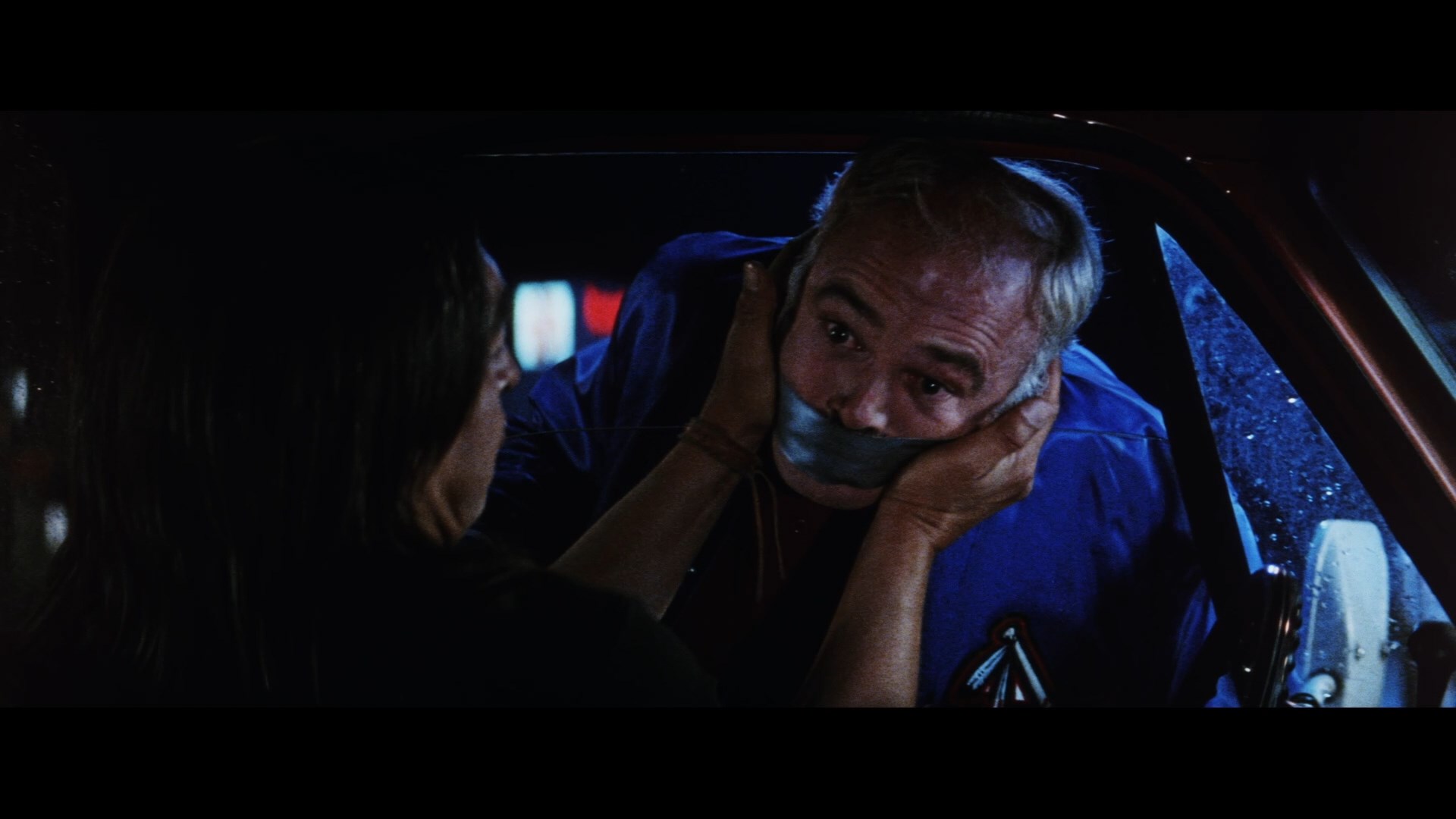 stereotypes about First Nations customs and behavior.
stereotypes about First Nations customs and behavior. 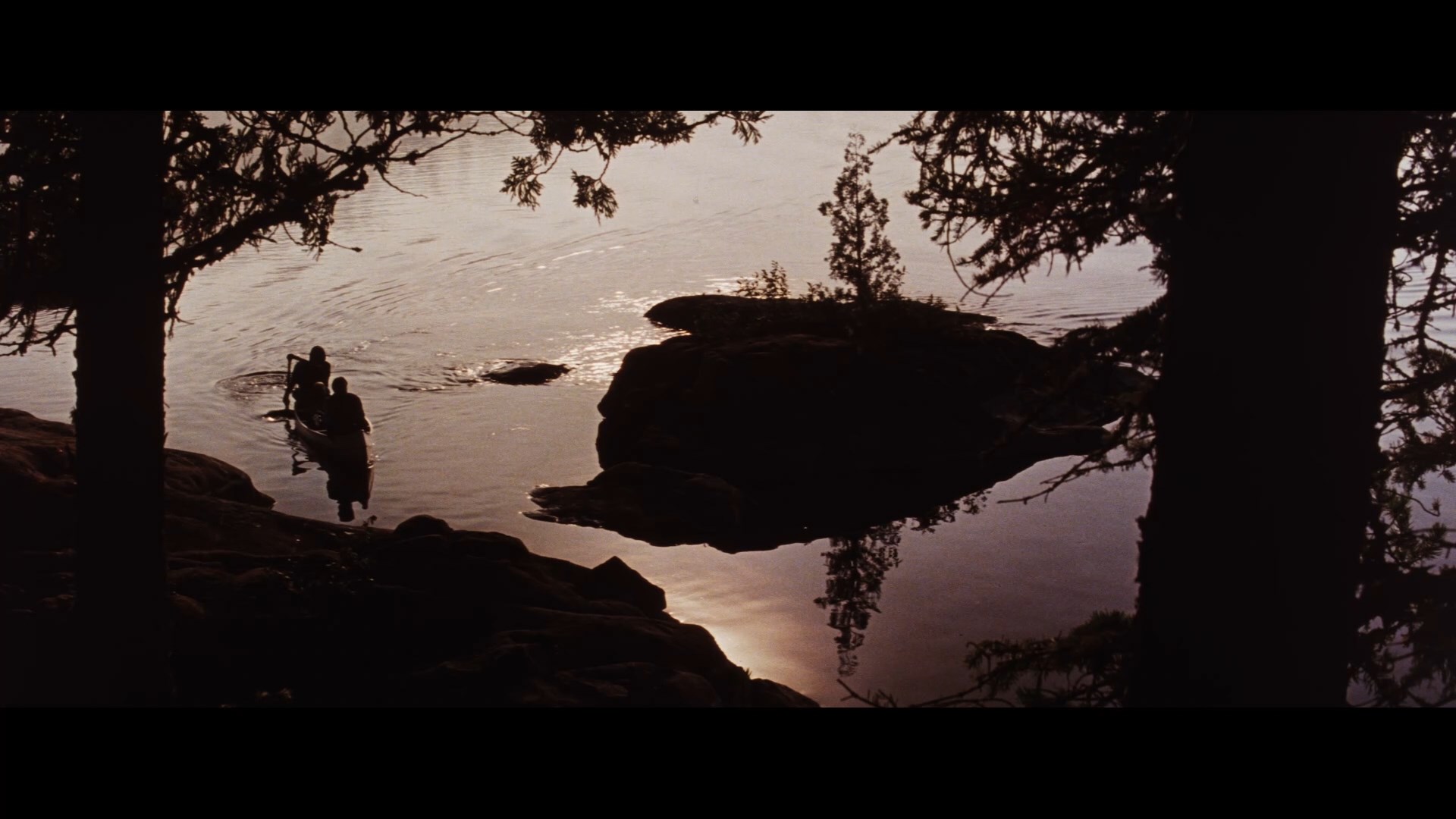 The rather jaded ending is an interesting choice apparently designed to provoke conversation after the film's over, but there's no question where the filmmakers' sympathies lie or what should happen in a just world.
The rather jaded ending is an interesting choice apparently designed to provoke conversation after the film's over, but there's no question where the filmmakers' sympathies lie or what should happen in a just world.
Beautifully shot in scope, this one doesn't appear to have gotten much theatrical play outside of Canada and barely made a blip in the U.S. for its heavily cropped VHS release from Academy in 1992. The Severin release (which marks the film's Blu-ray debut anywhere) is taken from a 4K scan of a 35mm answer print, which means it's a big step up from what we've had before (the correct framing is a major plus) even given the limitations of the source, namly the somewhat clogged blacks you see in a lot of print scans. The DTS-HD MA English 5.1 track is very center focused but sounds fine given the film is mostly dialogue driven anyway; however, to these ears the 2.0 track representing the theatrical stereo mix is a stronger experience with better channel separation and a lot more atmosphere. The extras include an archival video intro by Polish director Ryszard Bugajski (7m27s) about his work made in Canada, an audio commentary by scholar and anthropologist Shaawano Chad Uran (White Earth Anishinaabe) with a perceptive analysis of the film's themes, its use of natural elements, and its anthropological imagery used to reinforce its social statements, a very thorough audio interview with Bugajski and journalist Allan MacInnis playable as a second commentary track, an "A Dream Like Arthur's" audio interview with Greene (16m8s) about his 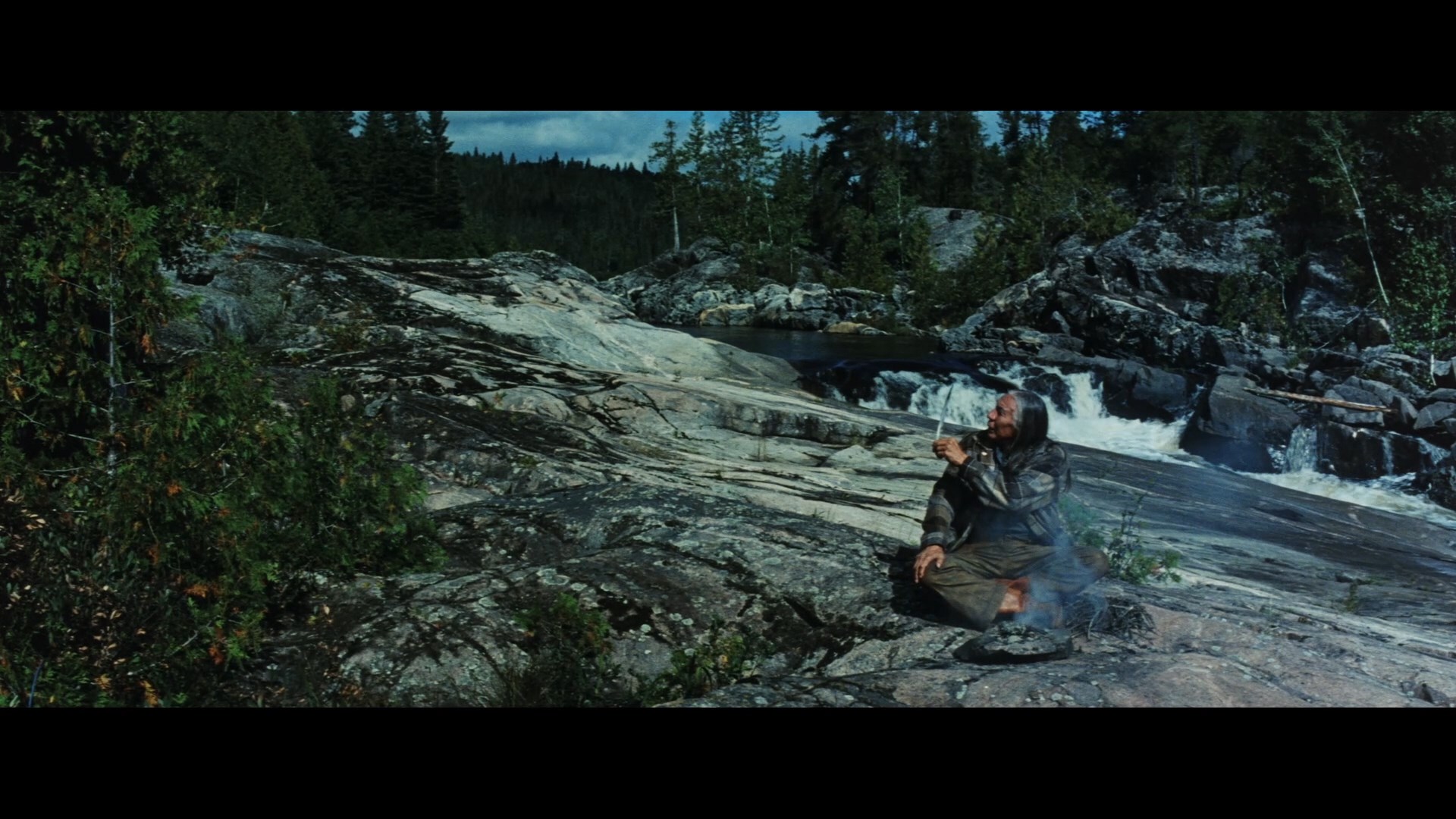 memories of the production including some of the rewrites brought to the table, and "Composing Clearcut" (17m46s) with composer Shane Harvey covering his collaborations with the director and
memories of the production including some of the rewrites brought to the table, and "Composing Clearcut" (17m46s) with composer Shane Harvey covering his collaborations with the director and 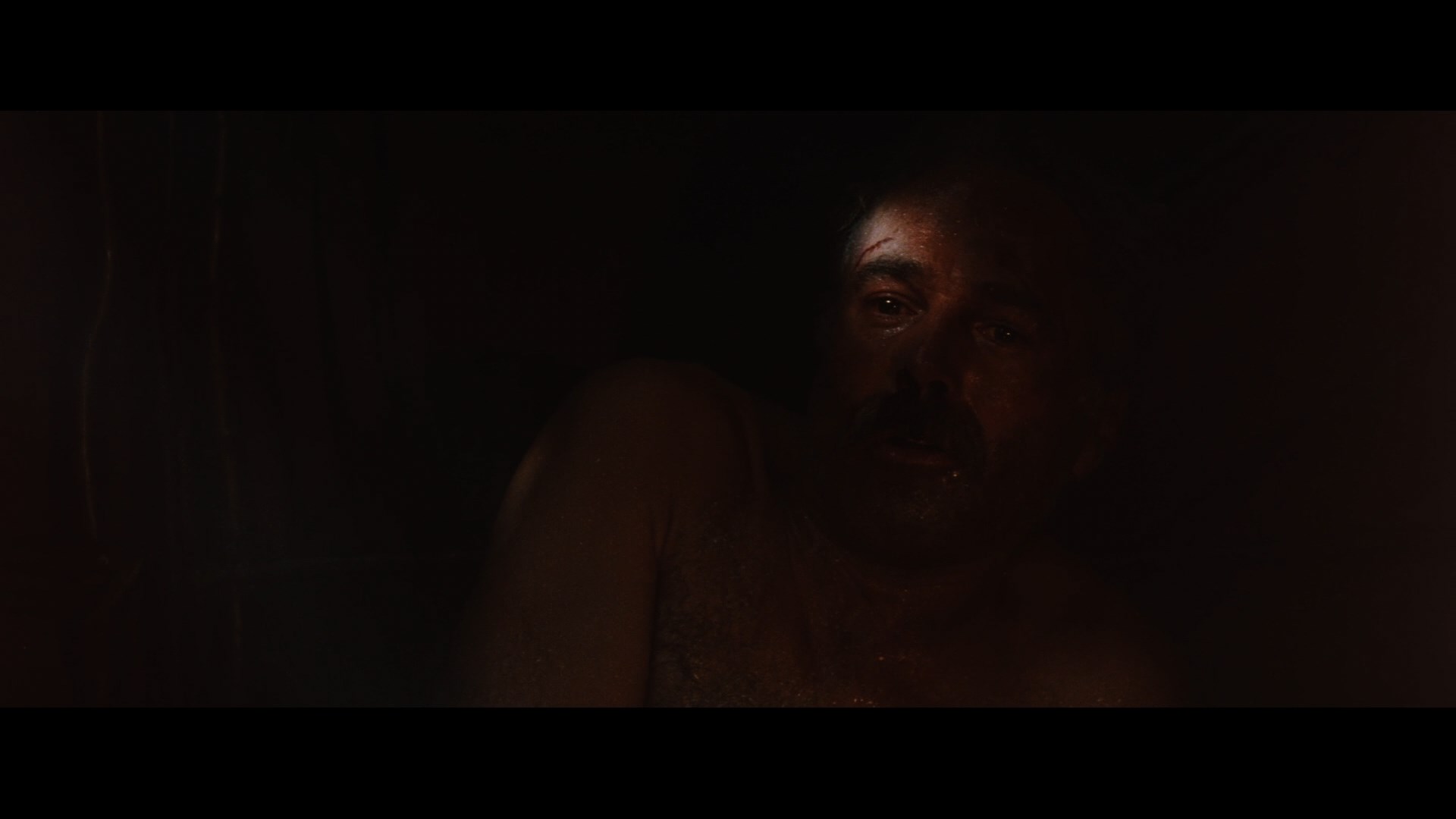 the indigenous instrument choices made for the soundtrack. You also get three thematically connected short films starting with Willie Dunn's The Ballad Of Crowfoot (10m30s), essentially an activist music video demonstrating the violence of colonialism in action. It also comes with an audio commentary by Kevin Howes And Lawrence Dunn, producers of Creation Never Sleeps, Creation Never Dies: The Willie Dunn Anthology, about the origins of the piece and the real-life story that inspired it. 1969's You Are On Indian Land (37m2s) by Michael Kanentakeron Mitchell is a fascinating documentary capturing the Kanien’kéhaka (Mohawk) of Akwesasne protest at the Canadian border about the annexation of its land by the government and the unjust fines imposed on them, capturing a particularly combative moment in local history in action. Finally, 2017's Consume (20m7s) is the most folk horror-connected with its impressionistic look at the Wendigo manifested by the conflict within Jacob (Julian Black Antelope) as he tries to provide for his family and copes with his experiences as a survivor of the infamous residential school program that claimed and damaged countless lives.
the indigenous instrument choices made for the soundtrack. You also get three thematically connected short films starting with Willie Dunn's The Ballad Of Crowfoot (10m30s), essentially an activist music video demonstrating the violence of colonialism in action. It also comes with an audio commentary by Kevin Howes And Lawrence Dunn, producers of Creation Never Sleeps, Creation Never Dies: The Willie Dunn Anthology, about the origins of the piece and the real-life story that inspired it. 1969's You Are On Indian Land (37m2s) by Michael Kanentakeron Mitchell is a fascinating documentary capturing the Kanien’kéhaka (Mohawk) of Akwesasne protest at the Canadian border about the annexation of its land by the government and the unjust fines imposed on them, capturing a particularly combative moment in local history in action. Finally, 2017's Consume (20m7s) is the most folk horror-connected with its impressionistic look at the Wendigo manifested by the conflict within Jacob (Julian Black Antelope) as he tries to provide for his family and copes with his experiences as a survivor of the infamous residential school program that claimed and damaged countless lives.
_________________________________________________________________________________________________________________
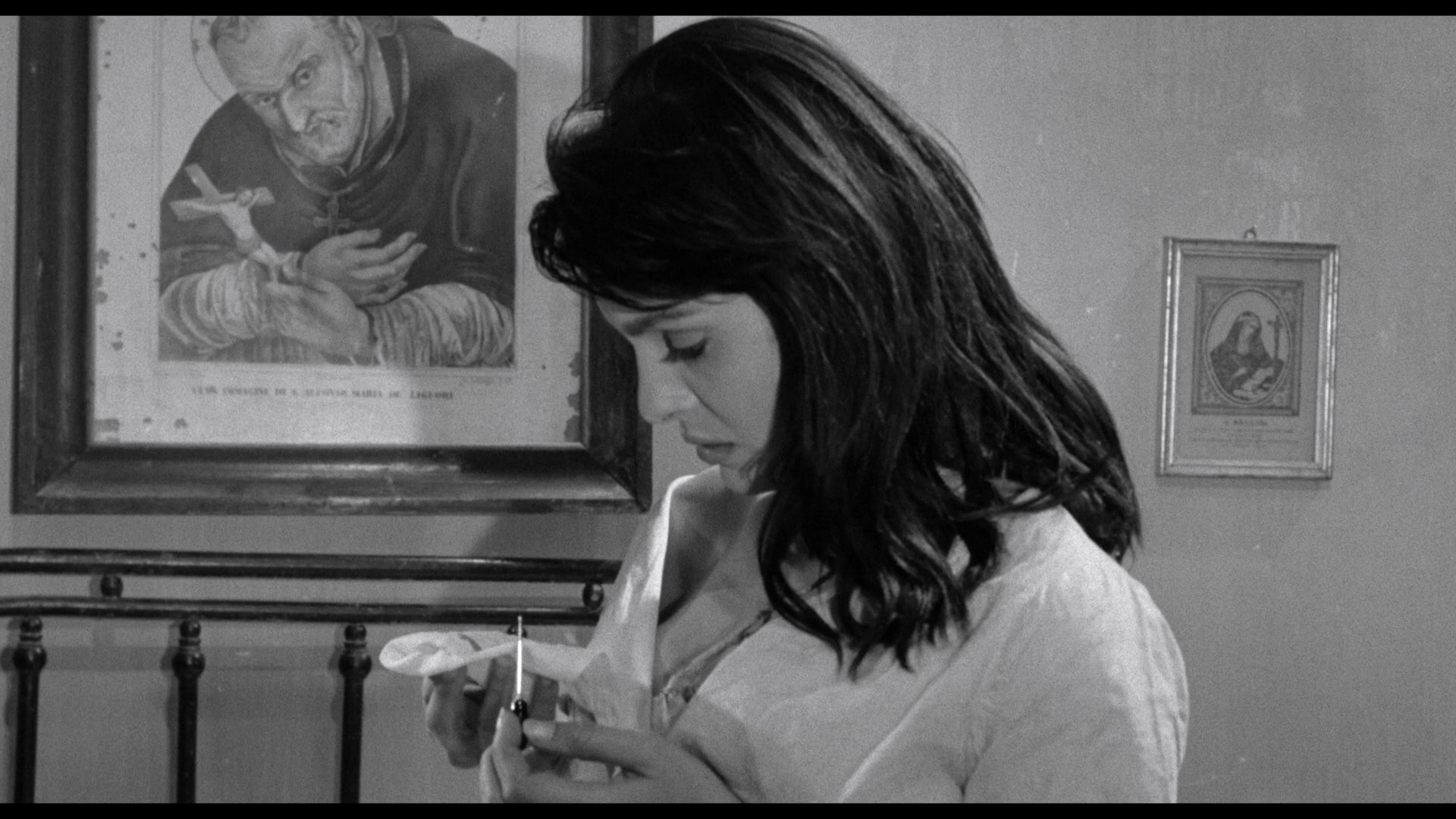 Disc ten features
Disc ten features 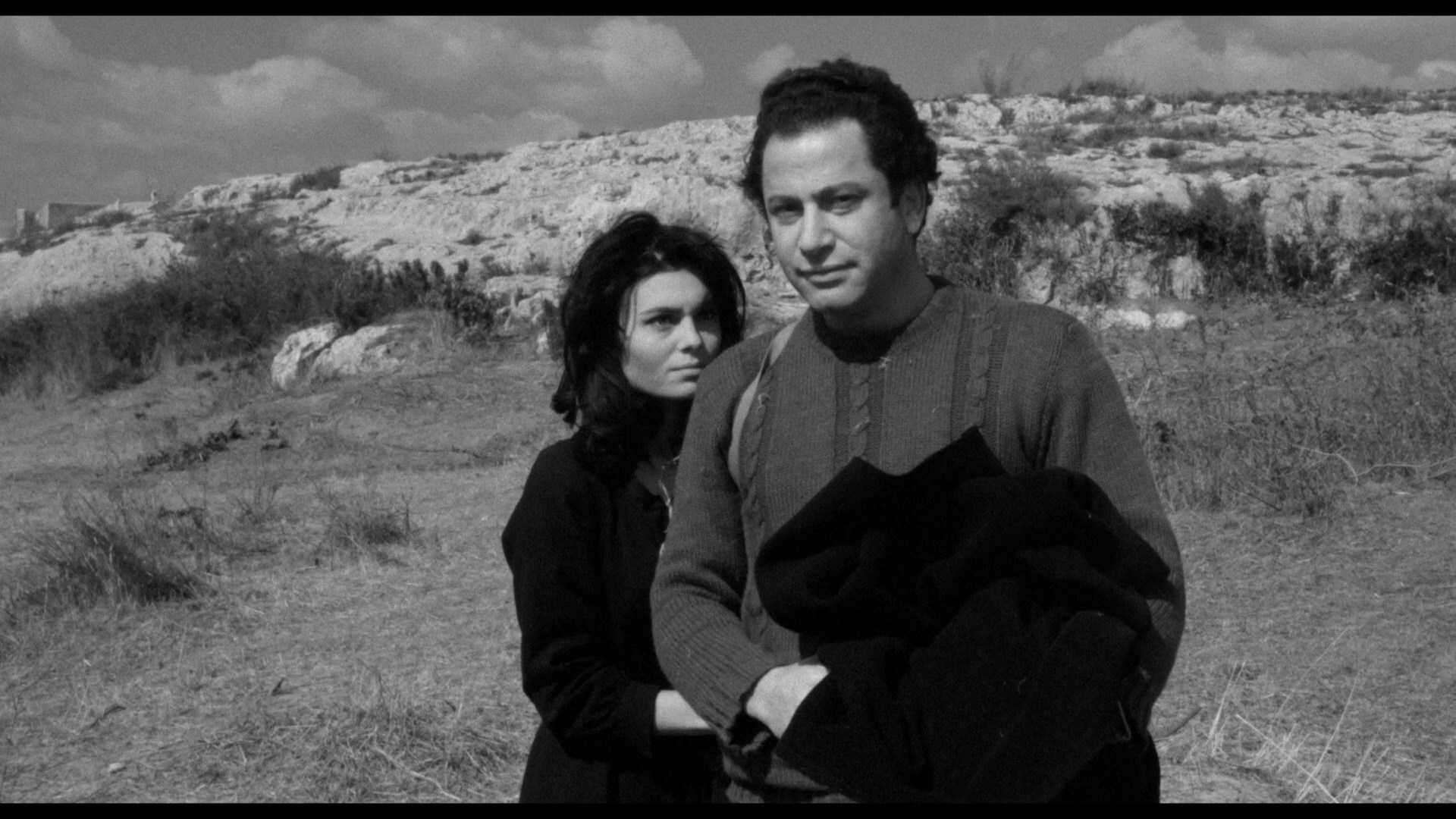 what will likely be the biggest draw here for Italian cinema fans: Il Demonio (The Demon), a 1963 combination of folk horror, psychological study, and unflinching social commentary with a career-best performance by Daliah Lavi (The Whip and the Body). Never released theatrically in the U.S. and only legally available before on a 2004 Italian DVD without English-friendly options, the film was inspired by a true case of mental pathology known to director and frequent Fellini collaborator Brunello Rondi and holds a great deal of fascination today for its sympathetic portrayal of female witchcraft and its early possession imagery, including a startling spiderwalk scene later reprised for William Friedkin's revised version of The Exorcist.
what will likely be the biggest draw here for Italian cinema fans: Il Demonio (The Demon), a 1963 combination of folk horror, psychological study, and unflinching social commentary with a career-best performance by Daliah Lavi (The Whip and the Body). Never released theatrically in the U.S. and only legally available before on a 2004 Italian DVD without English-friendly options, the film was inspired by a true case of mental pathology known to director and frequent Fellini collaborator Brunello Rondi and holds a great deal of fascination today for its sympathetic portrayal of female witchcraft and its early possession imagery, including a startling spiderwalk scene later reprised for William Friedkin's revised version of The Exorcist.
Growing increasingly distraught by the betrothal of her lover Antonio (The Lickerish Quartet's Wolff), Purificata finds the only way to react to the oppressive and extremely patriarchal life in a Southern Italian village is to resort to pagan rituals to win him back. Meanwhile a distraught Antonio turns to the Catholic Church to solve his problems, which the provincial social structure is clearly 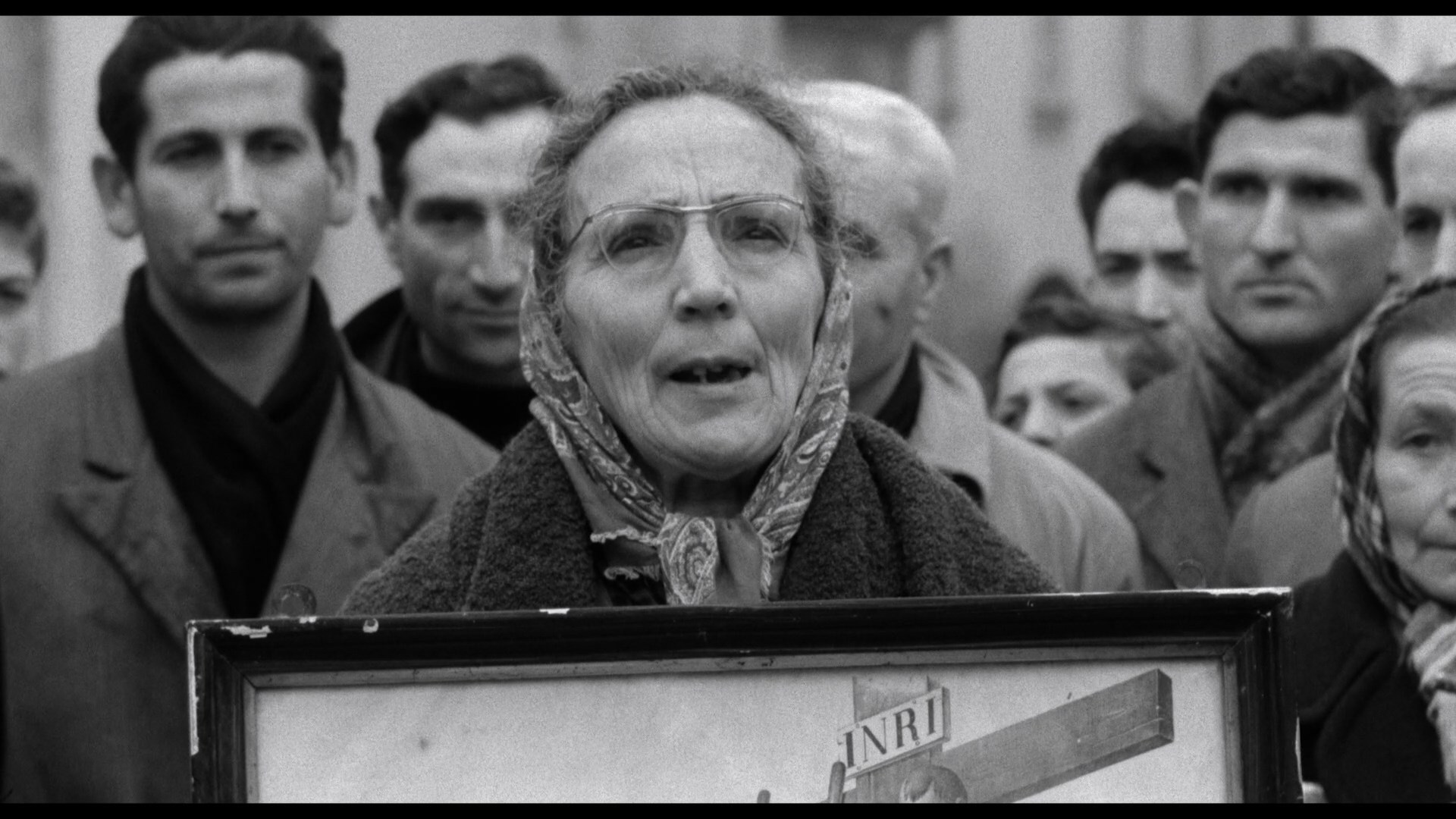 not even remotely equipped to address given how casually sexual assault seems to be committed.
not even remotely equipped to address given how casually sexual assault seems to be committed.
Restored from the original negative at RAI TV in Rome, Il Demonio is presented in its most 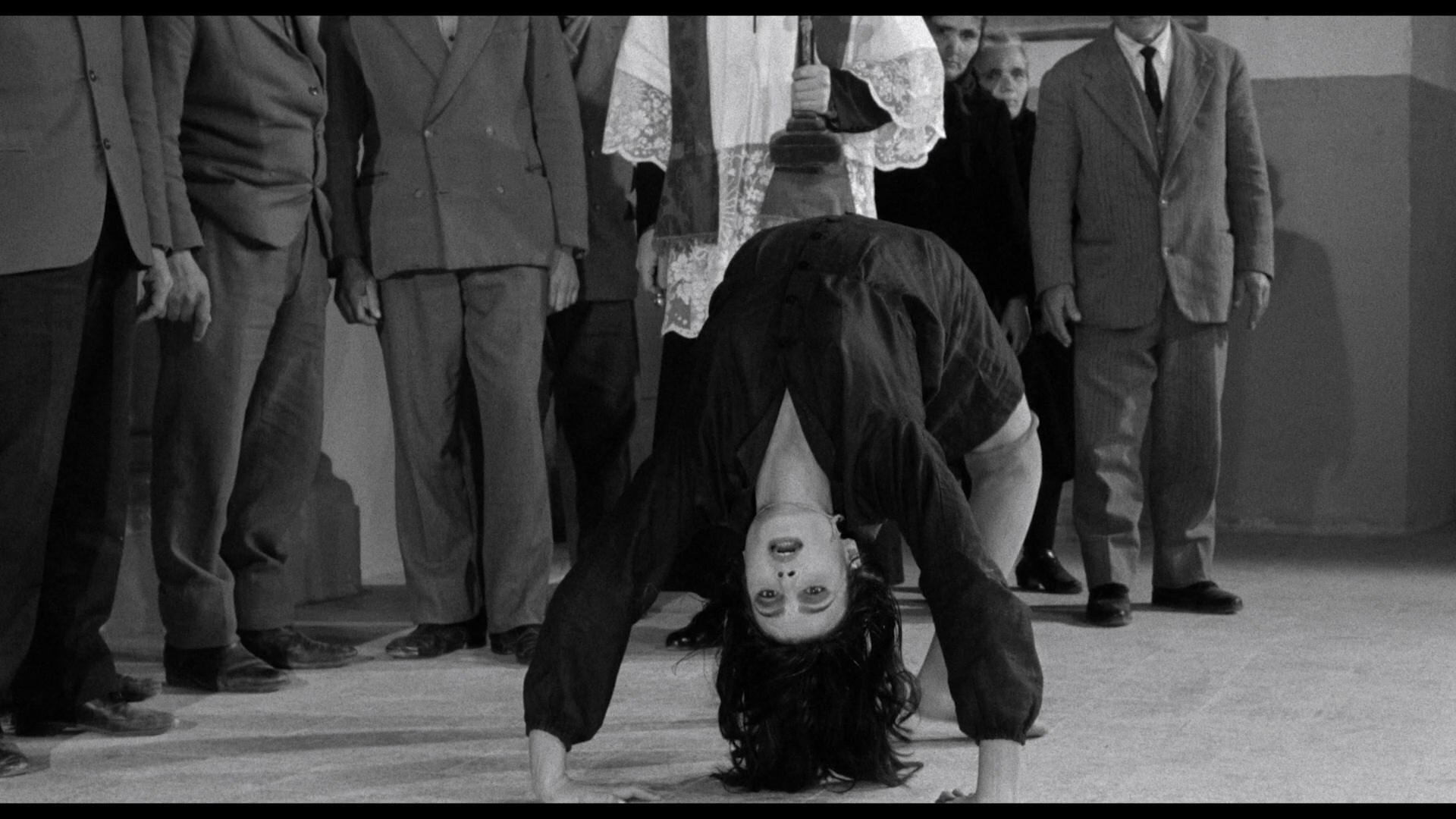 complete version to date compared to the scissored theatrical and DVD Italian editions. The quality here is truly stunning and should help word of mouth about this one to spread like wildfire as it's arguably the most visually impressive presentation in the set as well as one of the very best films. The clarity also helps appreciate what Lavi and Rondi were going for with the many striking landscape shots where her character seems like an aberrant extension of the land itself, making it easier to draw a clear line from this film to the later characters portrayed by Fabienne Dali in Kill, Baby... Kill! and Florinda Bolkan in Don't Torture a Duckling. The Italian mono DTS-HD MA 2.0 audio is also in mint condition and features good English subtitles. Kat Ellinger provides a substantive and very rewarding new audio commentary in which she weaves together Rondi's career and Lavi's performance with concepts involving Italian Gothic, folk horror, female autonomy, possession stories, and historical tidbits like this being the first credit for
complete version to date compared to the scissored theatrical and DVD Italian editions. The quality here is truly stunning and should help word of mouth about this one to spread like wildfire as it's arguably the most visually impressive presentation in the set as well as one of the very best films. The clarity also helps appreciate what Lavi and Rondi were going for with the many striking landscape shots where her character seems like an aberrant extension of the land itself, making it easier to draw a clear line from this film to the later characters portrayed by Fabienne Dali in Kill, Baby... Kill! and Florinda Bolkan in Don't Torture a Duckling. The Italian mono DTS-HD MA 2.0 audio is also in mint condition and features good English subtitles. Kat Ellinger provides a substantive and very rewarding new audio commentary in which she weaves together Rondi's career and Lavi's performance with concepts involving Italian Gothic, folk horror, female autonomy, possession stories, and historical tidbits like this being the first credit for 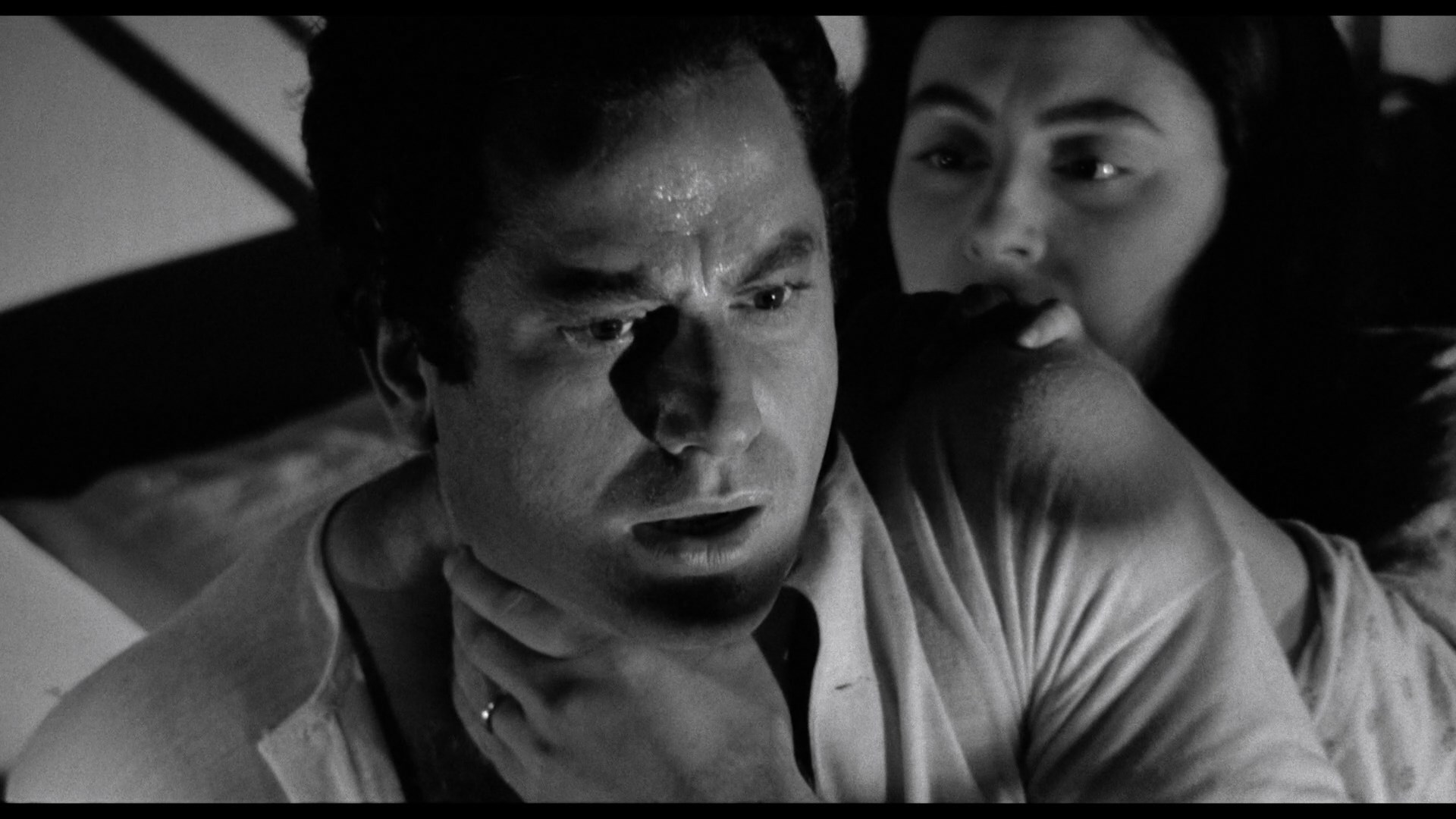 producer Luciano Martino. Equally worthwhile is "The Kid From A Kibbutz: Daliah Lavi and the
producer Luciano Martino. Equally worthwhile is "The Kid From A Kibbutz: Daliah Lavi and the 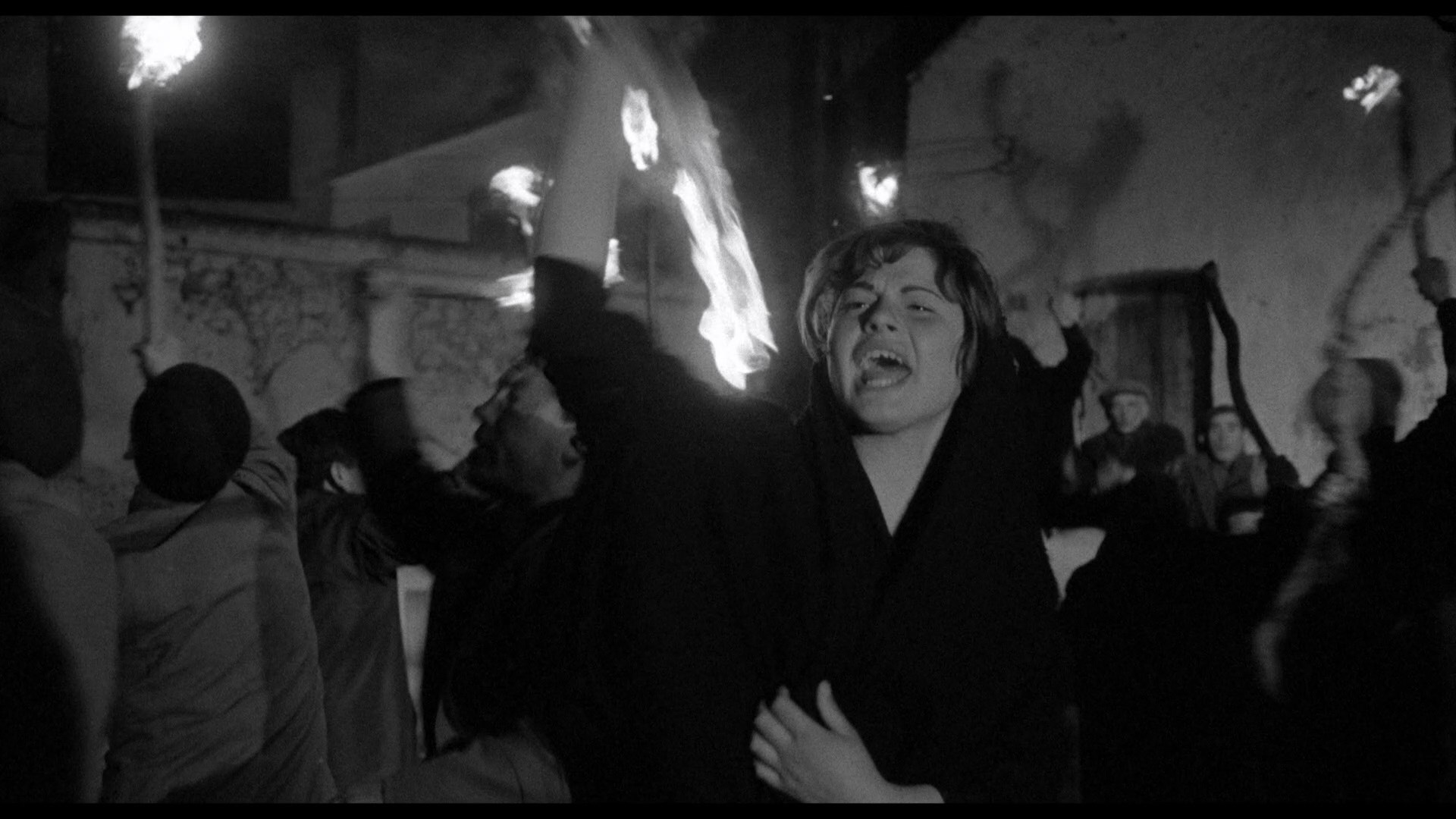 Road to Il Demonio" (27m37s), edited by Chris O'Neill, in which Tim Lucas covers her life and career from the perspective of the friendship he forged with her while prepping his Mario Bava biography. It's very informative going well beyond her screen work (this film was cited as her favorite) including her upbringing in Palestine and her later singing career. (On a nitpicky note though, he refers to her as the screen's only female 007 when we've actually had five of 'em.) Finally "Once Upon a Time in Basilicata" (22m52s) features Rondi biographer Alberto Pezzotta exploring this film in the broader perspective of its director's career including his prior film, 1961's Una vita violenta based on Pier Paolo Pasolini's book, and the Italian attitudes being explored in this film.
Road to Il Demonio" (27m37s), edited by Chris O'Neill, in which Tim Lucas covers her life and career from the perspective of the friendship he forged with her while prepping his Mario Bava biography. It's very informative going well beyond her screen work (this film was cited as her favorite) including her upbringing in Palestine and her later singing career. (On a nitpicky note though, he refers to her as the screen's only female 007 when we've actually had five of 'em.) Finally "Once Upon a Time in Basilicata" (22m52s) features Rondi biographer Alberto Pezzotta exploring this film in the broader perspective of its director's career including his prior film, 1961's Una vita violenta based on Pier Paolo Pasolini's book, and the Italian attitudes being explored in this film.
Also on the same disc is the far more widely seen Dark Waters from 1993, directed by Mariano Baino near the waning days of the Italian horror boom and something of a jinxed project from the outset. While the entire 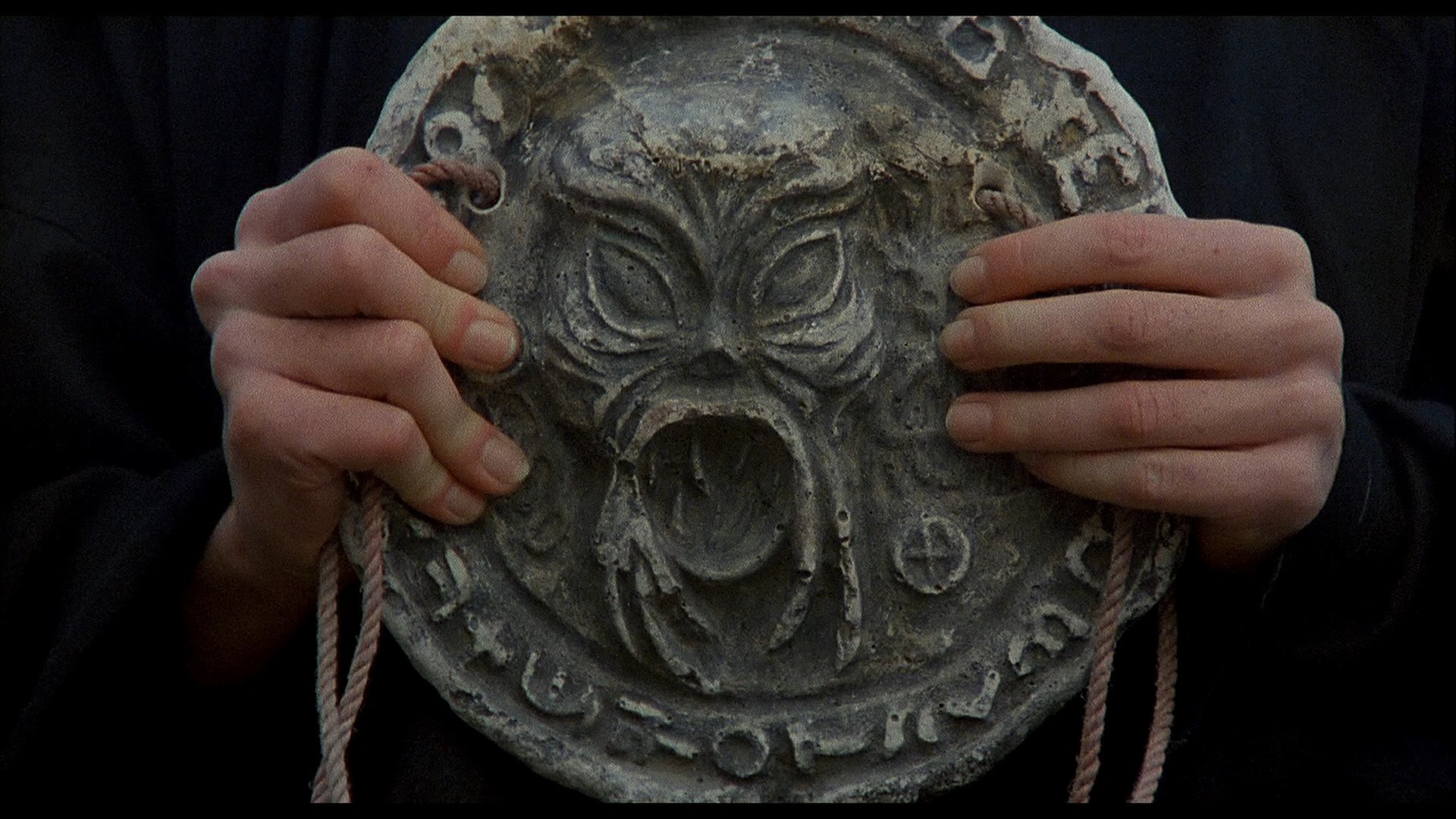 Italian film industry was gradually shifting
Italian film industry was gradually shifting 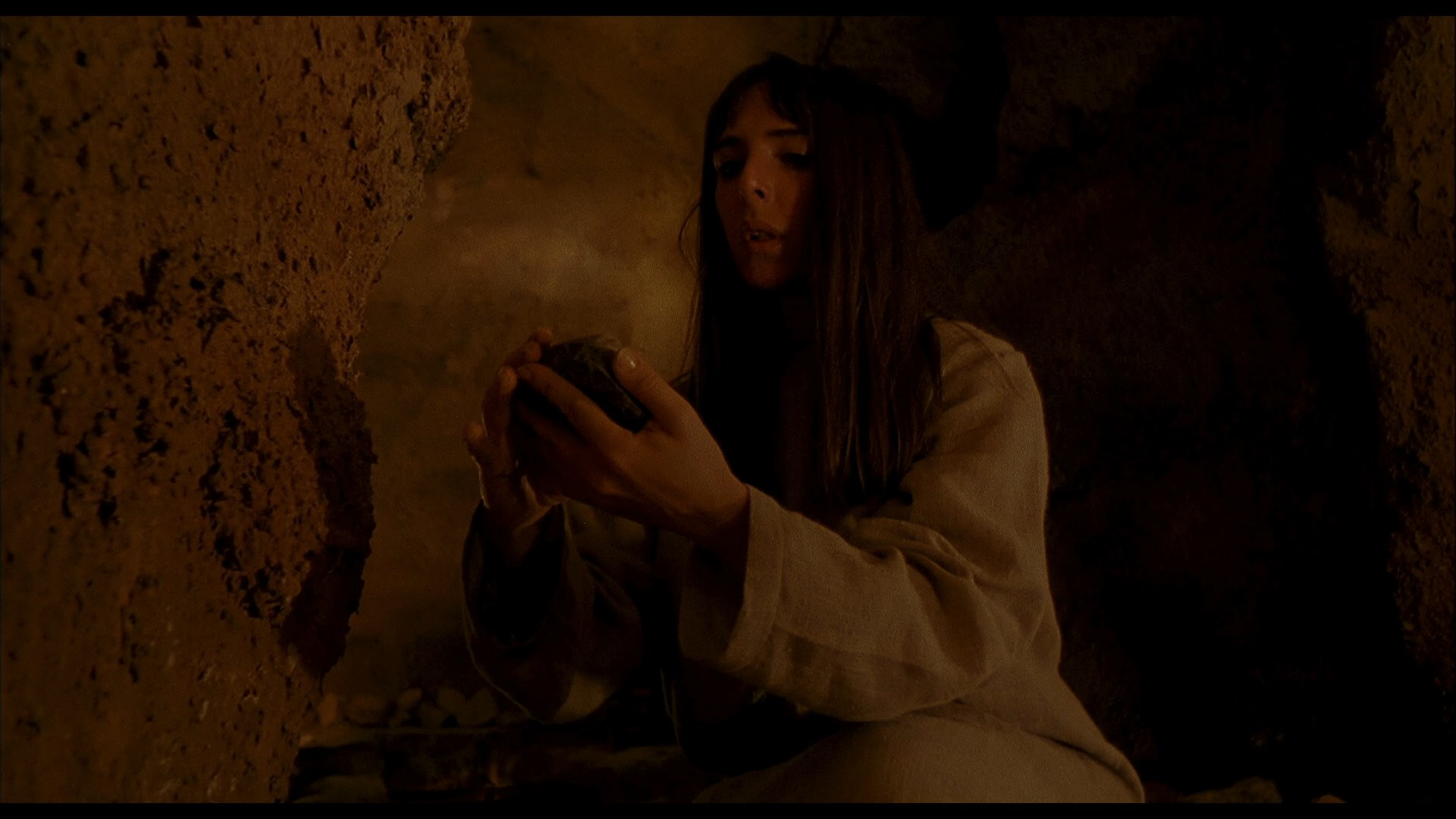 its attention to watered-down "spooky" TV movies, first-time director Baino had already garnered praise for his stylish short film, Caruncula, and was being praised as the Generation X successor to Bava and Argento. The comparison continued to stick, even though Dark Waters is absolutely nothing like previous Italian films; in fact, if you took off the credits, you'd be hard-pressed to peg its nationality at all, thanks to the multinational talent and locales.
its attention to watered-down "spooky" TV movies, first-time director Baino had already garnered praise for his stylish short film, Caruncula, and was being praised as the Generation X successor to Bava and Argento. The comparison continued to stick, even though Dark Waters is absolutely nothing like previous Italian films; in fact, if you took off the credits, you'd be hard-pressed to peg its nationality at all, thanks to the multinational talent and locales.
In the puzzling prologue, an isolated religious establishment on a stormy island is beset by problems originating from a stone medallion. Nuns trudge through the landscape carrying fiery crosses, a young girl is repeatedly stabbed until the water runs red with her blood, and a priest trapped in an underground flood meets the wrong end of a broken shaft of wood. Flash forward twenty years later, as young Elizabeth (Salter) arrives at the aforementioned island to discover why her father has been sending payments to the nuns ever since her mother's premature death. The Mother Superior (Kapnist) and her charges prove less than helpful, so Elizabeth takes to the library to find out the horrible secrets which have left her with nightmarish flashbacks involving a long lost sister. Meanwhile the occasional malicious nun tries to shove her out a window or stab her, leaving Elizabeth more determined than ever to uncover the diabolical secret which ties her to this wicked order.
From the opening moments, Dark Waters tries to overwhelm the viewer with rich, suffocating visuals. The impressive opening half hour is almost entirely devoid of dialogue, leaving the viewer to piece everything together with a series of visual clues equally inspired by Jodorowsky, The 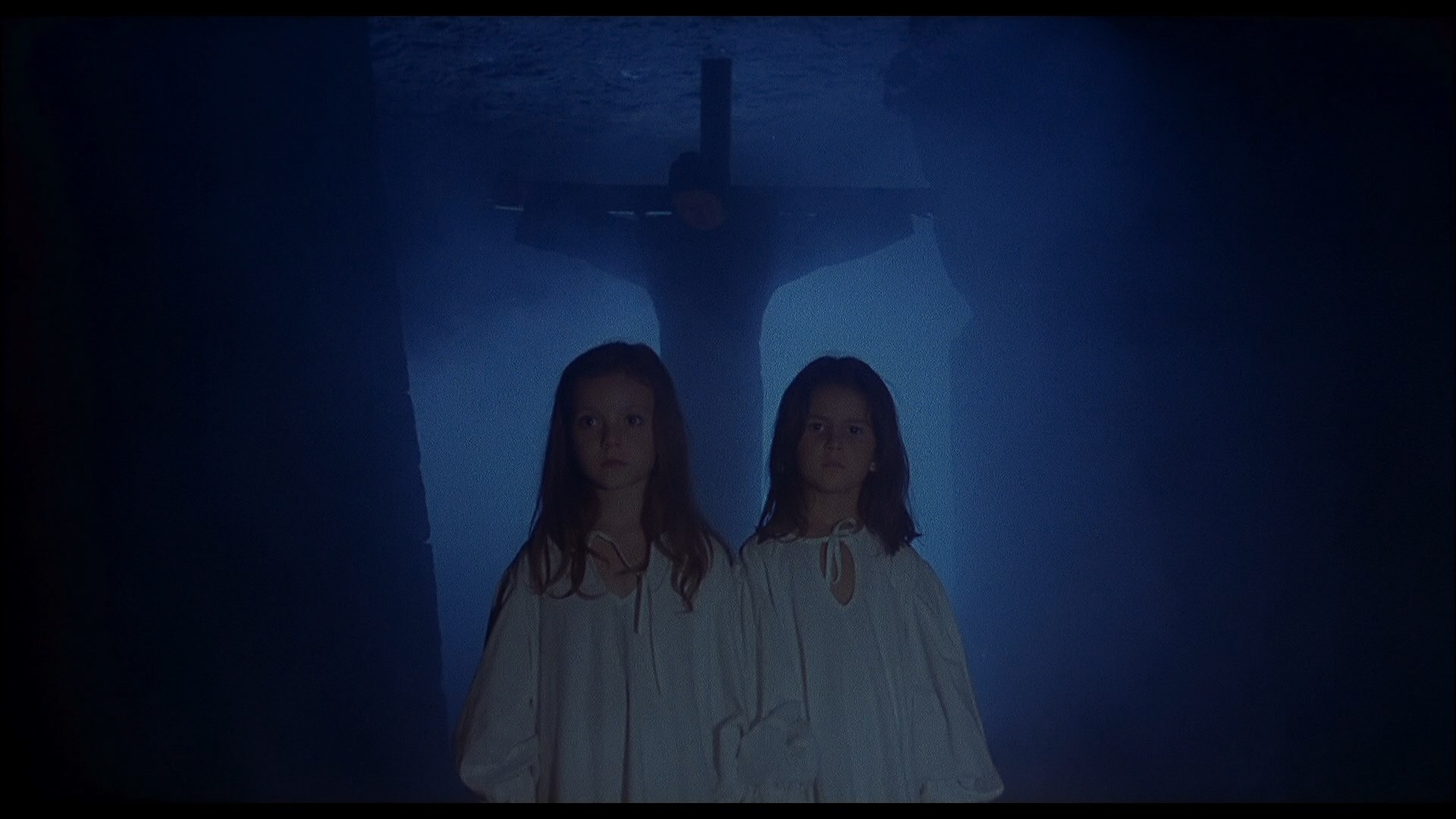 Name of the Rose and Michael Mann, whose The Keep is aped right down to the droning,
Name of the Rose and Michael Mann, whose The Keep is aped right down to the droning, 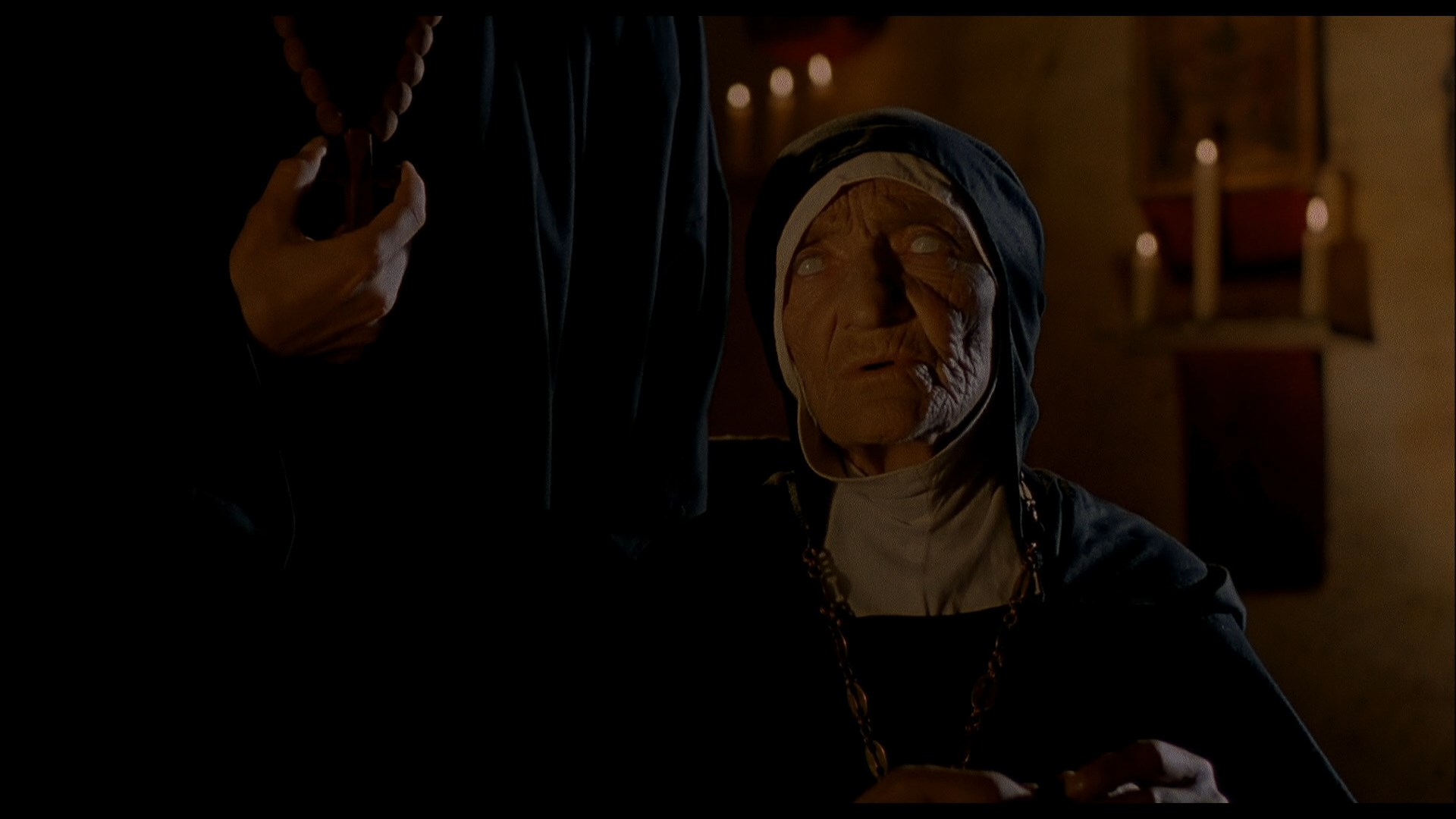 Tangerine Dream-inspired synth score. However, the delicate balance goes off-kilter in the midsection as the pace slows to a crawl and the actors seem to lose their way mid-scene with regularity; fortunately it all gets back on track again eventually for the weird, Lovecraftian finale with a little dash of The Sentinel tossed in for good measure. Gore fans will find a few scattered thrills, such as an extended entrail pulling that seems to have wandered in from another film.
Tangerine Dream-inspired synth score. However, the delicate balance goes off-kilter in the midsection as the pace slows to a crawl and the actors seem to lose their way mid-scene with regularity; fortunately it all gets back on track again eventually for the weird, Lovecraftian finale with a little dash of The Sentinel tossed in for good measure. Gore fans will find a few scattered thrills, such as an extended entrail pulling that seems to have wandered in from another film.
Very few people had a chance to see this film in theaters, with Americans instead seeing it go direct to video in the late '90s courtesy of York Video (as Dead Waters) in one of the lousiest presentations ever inflicted on the viewing public. NoShame's 2005 DVD is a completely different experience from past video editions of this film; the colors are now rich and striking, the widescreen compositions have finally been restored, and the detail and black levels bring out textures and visual details completely obscured before. Contrary to the outside box, there's no 5.1 remix included here; however, the standard stereo version sounds terrific and easily outclasses the wretched York disc's audio, which inexplicably channeled the dialogue to the rear channels. Optional English (or Italian) subtitles are provided, and they come in handy during some of the more densely-mixed scenes. The feature is preceded by a long video intro by a candle-wielding Baino, who seems enthused about the film and promises to make a second feature one of these days. Baino then returns for an audio commentary with NoShame's Michele De Angelis, covering all of the various shooting and  cast
cast 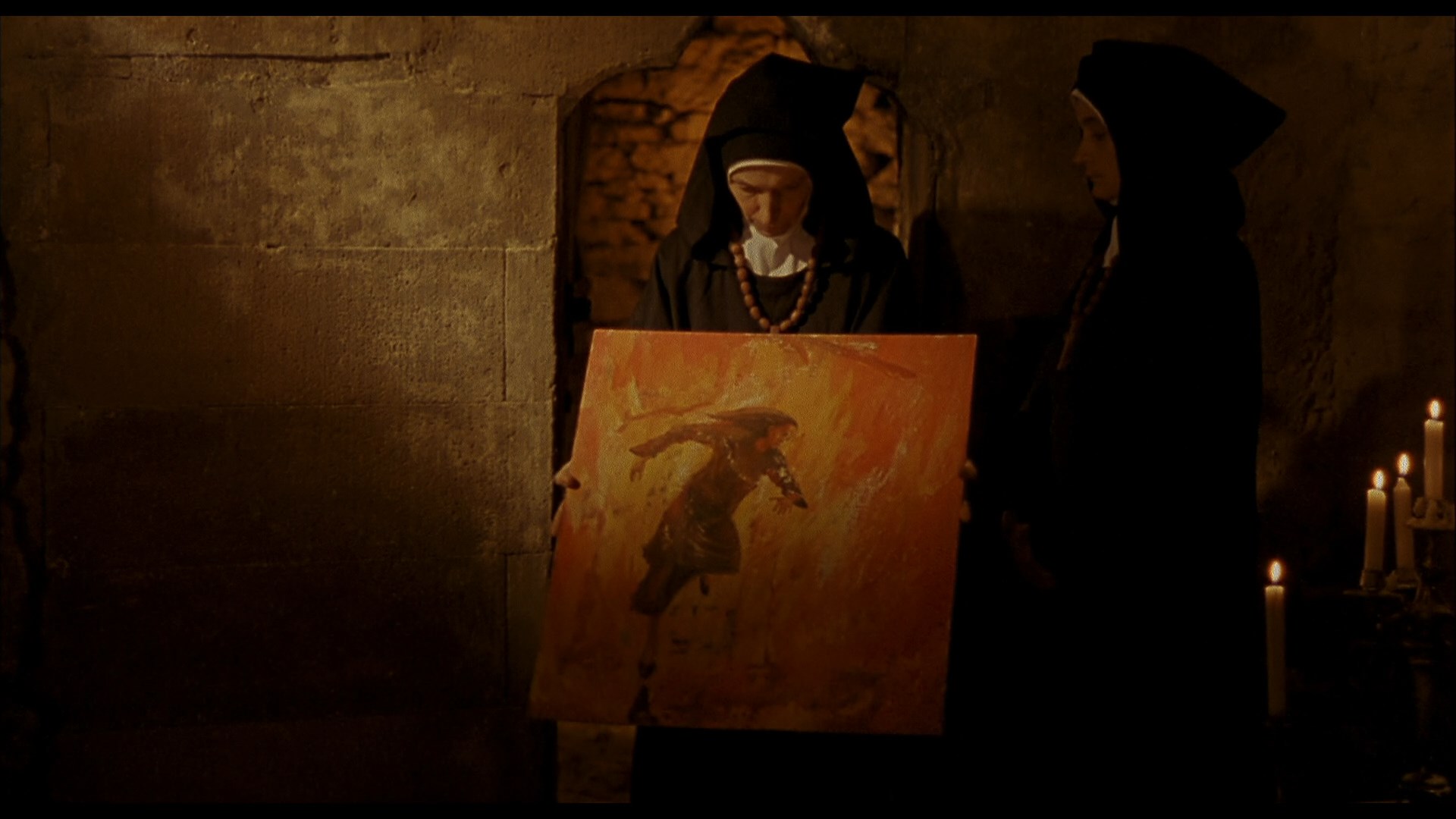 details with an emphasis on creating the film's unique visual look (perhaps in turn an inspiration to Stuart Gordon, whose underrated Dagon would play well with this film). The shoot was quite dramatic and almost never reached completion, thanks to thefts and near-fatal disasters at every turn. Also included are some chatty deleted scenes that add a bit of character detail but were wisely cut from the final director's cut (though they were present in some of the early tape versions floating around). Also included on the disc are "Deep into Dark Waters," a 50m28s documentary about the making of the film featuring interviews with Baino, Salter, producer Nigel Dali, cinematographer Steve Brooke Smith, and editor Rick Littler. Though it tends to repeat itself a number of times, the making-of features some interesting details and lots of backstage info (coupled with plenty of on-location photos). Also included is an outtake reel (with more Baino commentary) and a hefty still gallery.
details with an emphasis on creating the film's unique visual look (perhaps in turn an inspiration to Stuart Gordon, whose underrated Dagon would play well with this film). The shoot was quite dramatic and almost never reached completion, thanks to thefts and near-fatal disasters at every turn. Also included are some chatty deleted scenes that add a bit of character detail but were wisely cut from the final director's cut (though they were present in some of the early tape versions floating around). Also included on the disc are "Deep into Dark Waters," a 50m28s documentary about the making of the film featuring interviews with Baino, Salter, producer Nigel Dali, cinematographer Steve Brooke Smith, and editor Rick Littler. Though it tends to repeat itself a number of times, the making-of features some interesting details and lots of backstage info (coupled with plenty of on-location photos). Also included is an outtake reel (with more Baino commentary) and a hefty still gallery.
The NoShame edition was available as a general-release version with the single disc described above, but collectors with a lot of shelf space could opt to spring for the more lavish two-disc set, which comes packed in a huge (video game size) box with a stone replica of the medallion seen in the film. (Intact, that is, not broken.) The second disc represents something of a DVD calling card for the director, profiling his shorter work including a much-needed good transfer of the 20-minute Caruncula. Packed with unsettling imagery involving dolls, barbed wire and other fetishistic detail, it's a very strong piece of work profiling a particularly disturbed young woman's cannibalistic tendencies and is largely responsible for established Baino's reputation. Baino's first real short, Dream Car, is also included and profiles a man's unhealthy obsession with a new automobile; it's an interesting first attempt and should interest completists. The much more recent shot-on-video short, Never Ever After, showcases Baino's more recent style; though it would have obviously benefited from being shot on film instead, the visuals are still strong throughout this story of a woman whose quest for physical improvement takes her into very dark territory. Quirky and stylized to the extreme, this looks a whole lot more like the fevered imaginings of, say, Stephen Sayadian rather than your usual Italian horror director. A 20-minute featurette goes behind the scenes of this last short, and a DVD-Rom screenplay is included as well. Baino provides quick and informative commentaries for each short. Also included is Baino's Cecily Fay music video for "The Face and 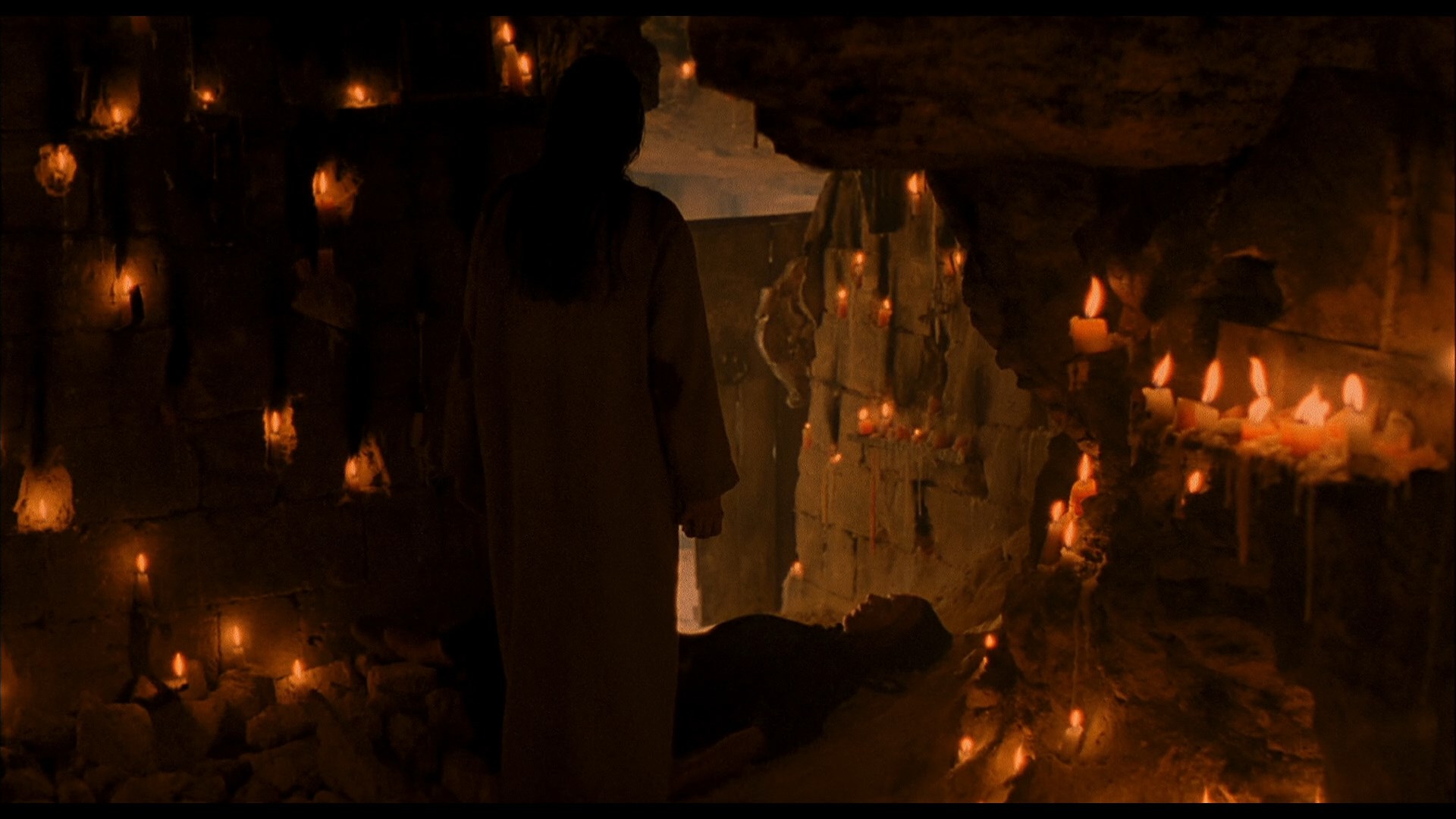 the Body" (nice, but again crippled by being shot on standard video), another photo gallery for the shorts, and, as if the box didn't weigh enough(!), a
the Body" (nice, but again crippled by being shot on standard video), another photo gallery for the shorts, and, as if the box didn't weigh enough(!), a 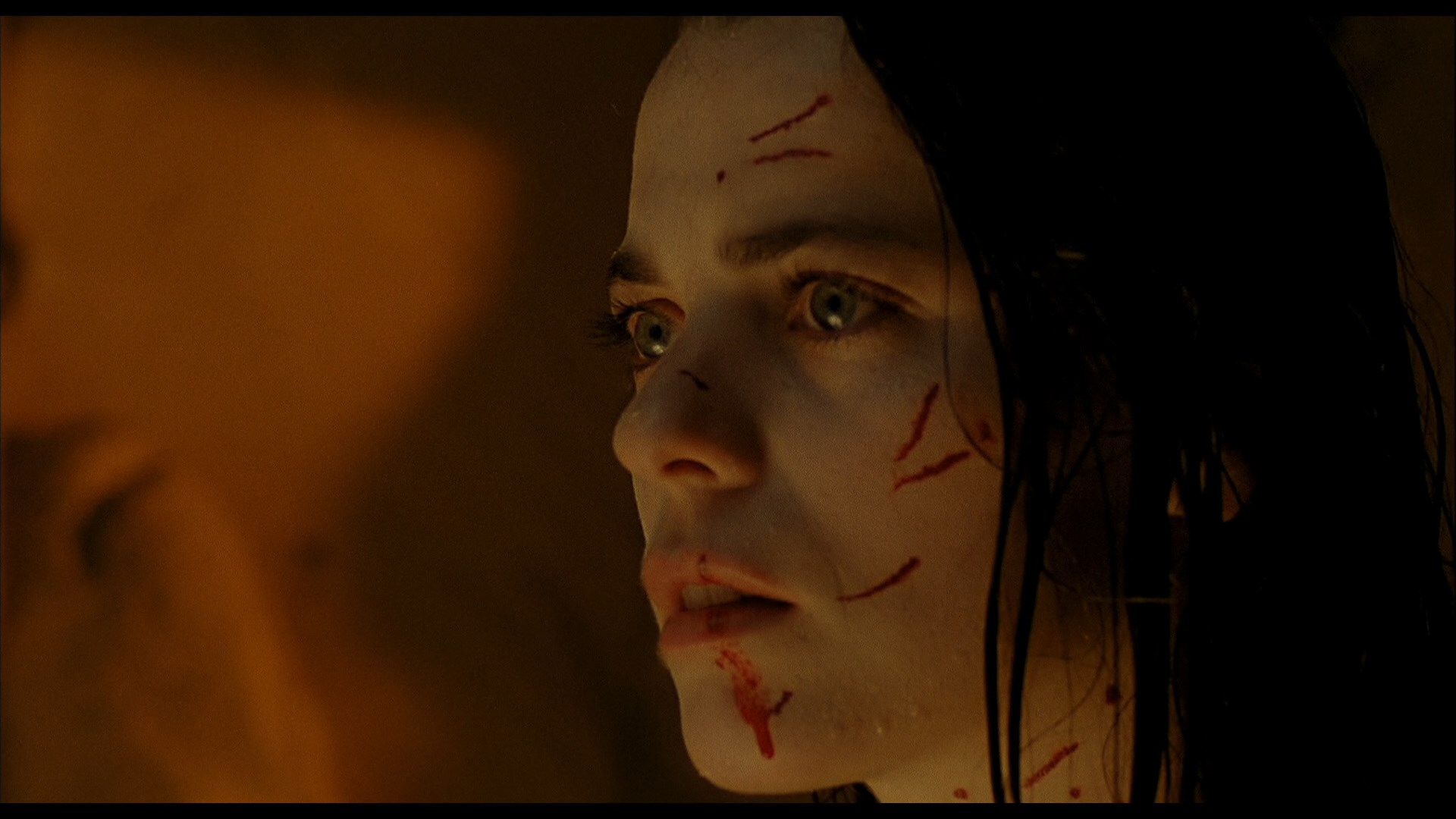 huge insert booklet containing liner notes, a Baino bio, production sketches and storyboards.
huge insert booklet containing liner notes, a Baino bio, production sketches and storyboards.
After that release the film fell into obscurity for a while until Severin Films revived it in 2017 for separate Blu-ray and DVD releases that offer the best-looking incarnation of the film, which is still speaking relatively given its video history and the challenges presented by its stylized look that often turned to mud in standard definition. Deep blacks, eye-popping reds and browns, and improved detail all make for a stronger viewing experience transferred from the original negative, though the frequently dark lighting and funky film stock also look even more inconsistent with the heightened resolution and an overall funky digital look. The bit rate is consistently beefy but the film often has a coarse, chunky texture to it that's less evident in motion than in frame grabs but definitely odd looking; given the film's threadbare technical capacity with the Ukraine film shoot, this may be about as good as it gets. Like the DVD, the image is slightly windowboxed. Oddly the English stereo audio is only presented in lossy Dolby Digital 2.0 while the commentary is ported over in LPCM, which seems a bit backwards; optional English subtitles are included. Everything on the standalone disc is carried over from the NoShame release in terms of video extras ("Deep into Dark Waters," the intro, deleted scenes, bloopers, and short films and music video with optional commentary, taken from the usual interlaced SD masters), with some new goodies added as well. In the featurette "Lovecraft Made Me Do It" (9m51s), Baino talks about discovering the world of Lovecraftian horror as a voracious reader and distilling it into his cinema, while "Let There Be Water" (6m44s) finds him chatting about a more spectacular, unreleased sequence for the climax involving a giant wave bursting into the chapel, some of which was filmed and is presented here for the first time. Finally, "Controlling the Uncontrollable" (5 mins. 10 secs.) goes into Baino's process of building worlds through drawings and books to maintain a sense of control over media and the elements he regards as, well, uncontrollable. It's also nice to have all of the extras -- and some new ones -- on a single disc that you can actually fit onto a shelf. The presentation in the folk horror box features the same transfer, looking identical and giving the audio a bump to DTS while retaining the Baino commentary. However, only one of the video extras, "Deep into the Dark Waters," has been retained, so hang on to your old Blu-ray if you have it.
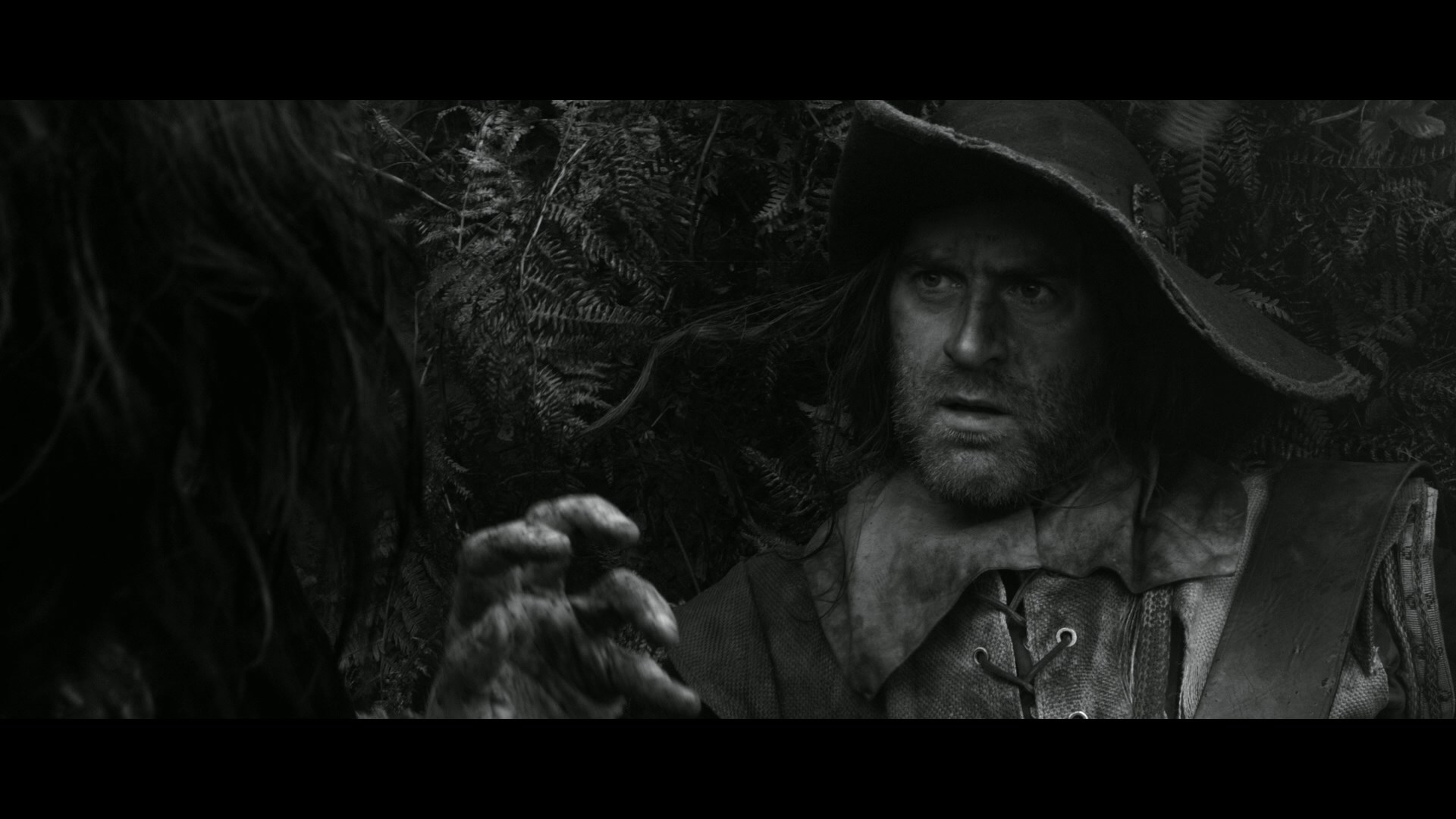
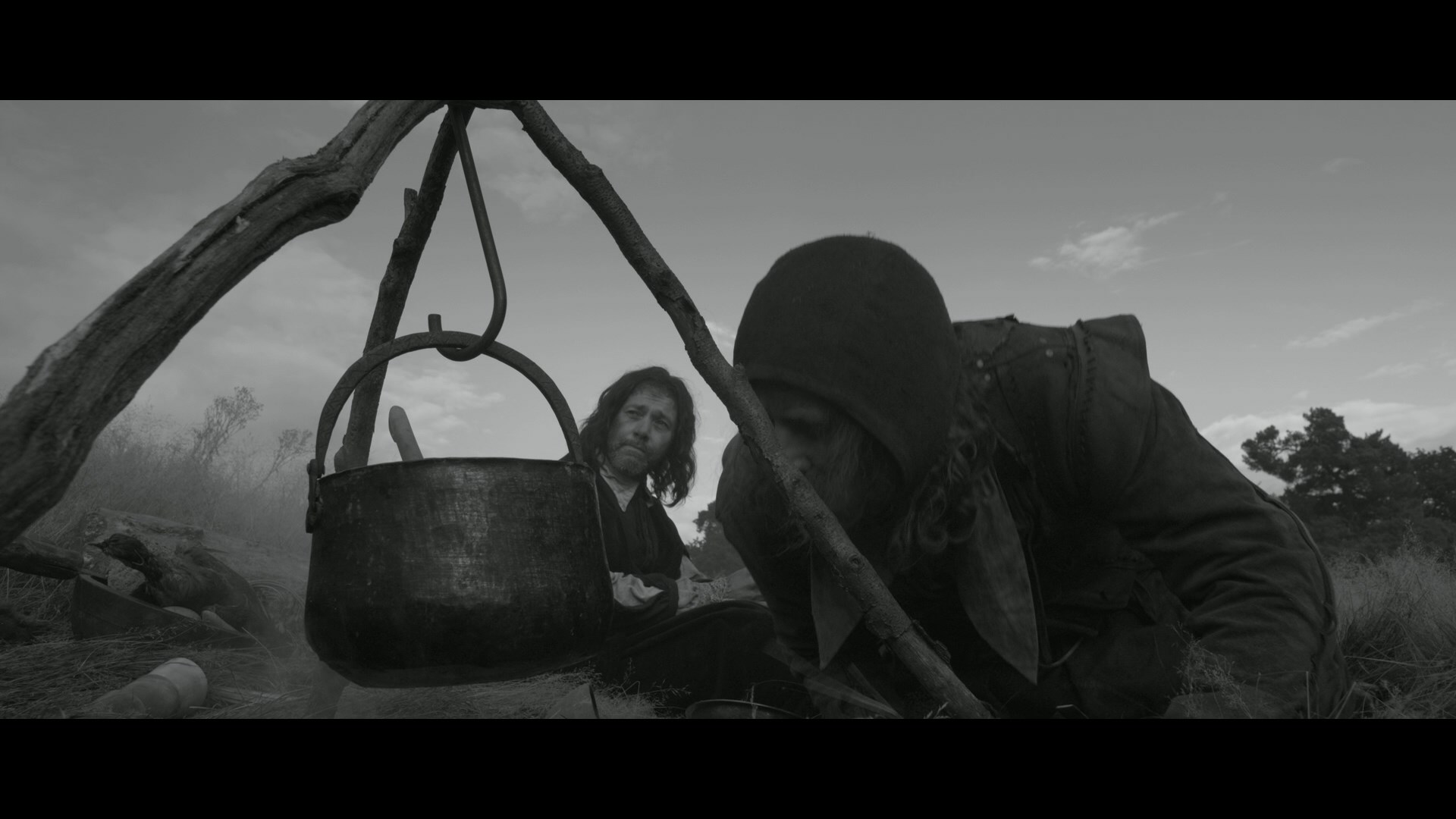 Disc eleven begins with the most recent narrative feature in the set: A Field in England, which was picked up by Drafthouse back in 2014 and has been something of an under the radar cult item ever since. A full-throttle folk horror film that anticipated the major resurgence from outfits like A24 a few years later, this was the fourth directorial feature from Ben Wheatley and his second foray into folk horror following his major breakthrough genre film, 2011's Kill List. (His third stab in that arena, 2021's In the Earth, would seem to complete a pretty wild trilogy of sorts.)
Disc eleven begins with the most recent narrative feature in the set: A Field in England, which was picked up by Drafthouse back in 2014 and has been something of an under the radar cult item ever since. A full-throttle folk horror film that anticipated the major resurgence from outfits like A24 a few years later, this was the fourth directorial feature from Ben Wheatley and his second foray into folk horror following his major breakthrough genre film, 2011's Kill List. (His third stab in that arena, 2021's In the Earth, would seem to complete a pretty wild trilogy of sorts.)
During the English Civil War, fleeing alchemist's helper Whitehead (Inside No. 9's Reece Shearsmith) ends up near battle at an expansive field where he's initially saved by a soldier, Cutler (Ryan Pope). Joined by two deserters, Friend (Glover) and Jacob (Ferdinando), they end up in an area filled with psychedelic mushrooms and fall under the control of another alchemist, O'Neill (Michael Smiley), who brutalizes and manipulates them into finding a treasure hidden in the area. However, insanity and murder soon overtake them as their time in the field turns into 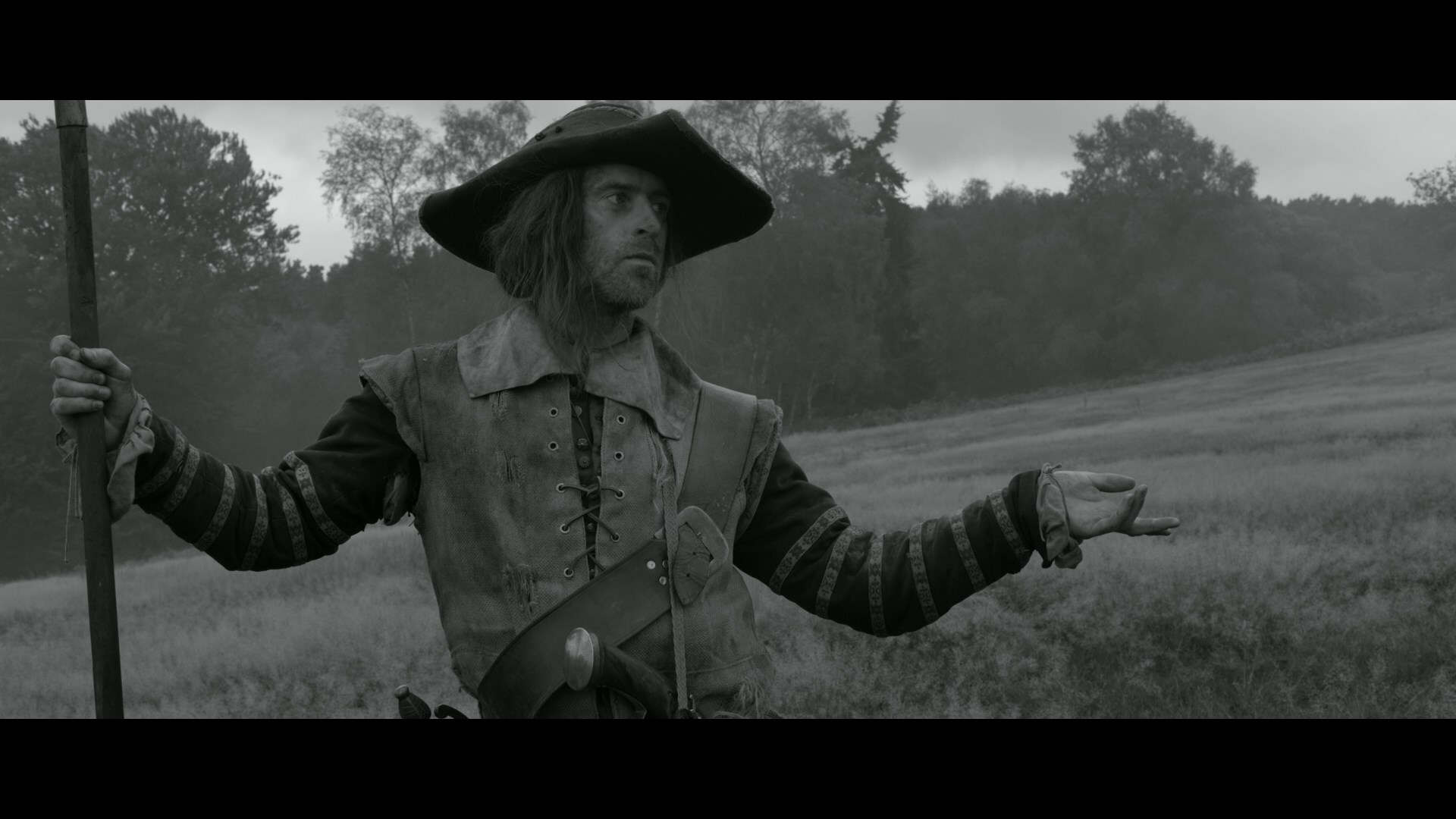 a
a 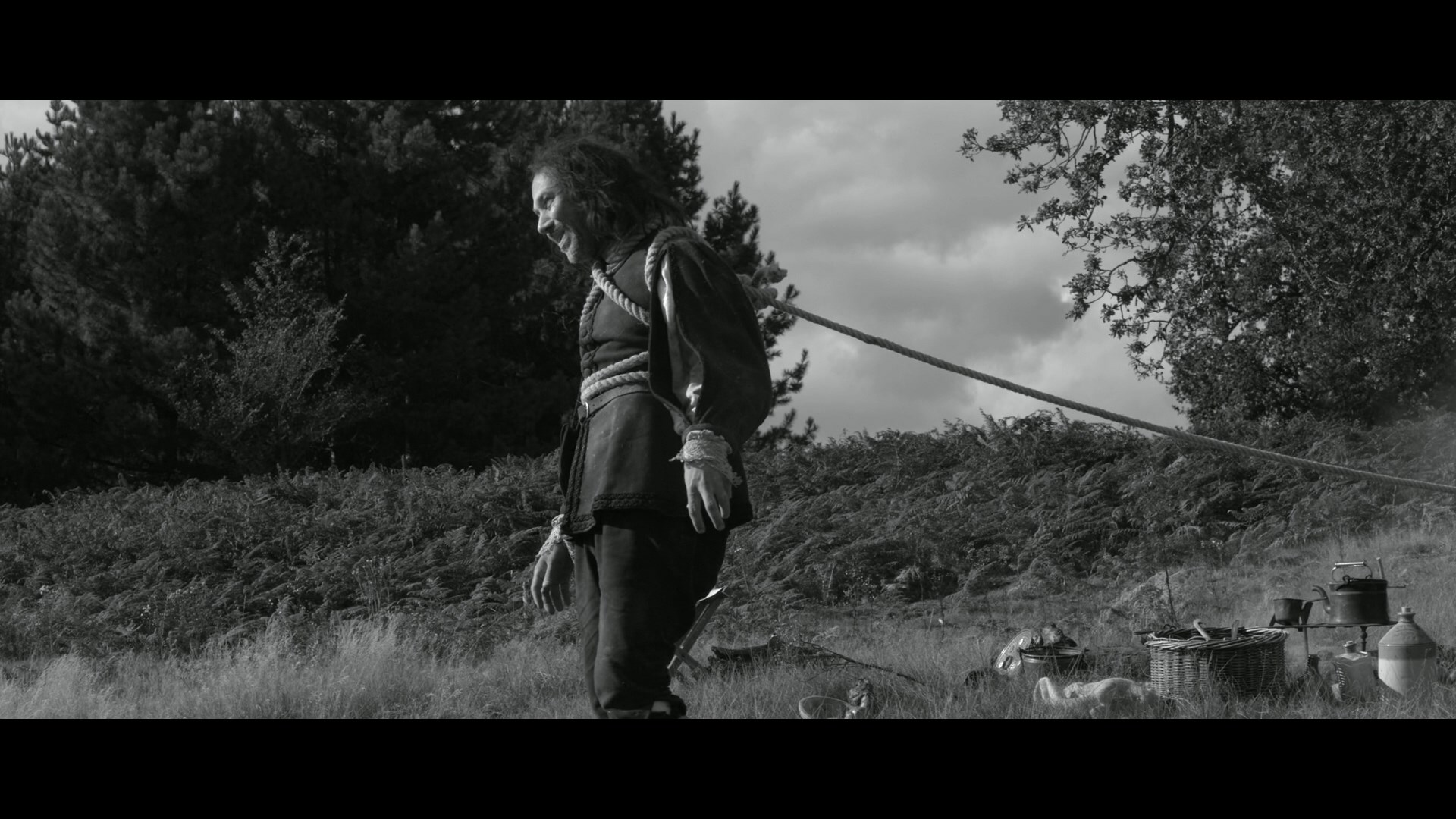 nightmare.
nightmare.
Obviously the mixture of psychedelic horror and period war film isn't necessarily going to be up everyone's alley, but as with some of the previous films in this set, it's a wild ride if you're on the right wavelength. The pulsing electronic score is a real plus and helps conjure up a potent dreamlike air, and it's fun seeing British TV faces popping up out of context here including an opening cameo by The Mighty Boosh's Julian Barratt (who gets dispatched before the main titles even roll). The actual horror content here is more conceptual than explicit, though the slo-mo "divining rod" scene is extremely creepy thanks to Shearsmith's performance and that dizzying soundtrack.
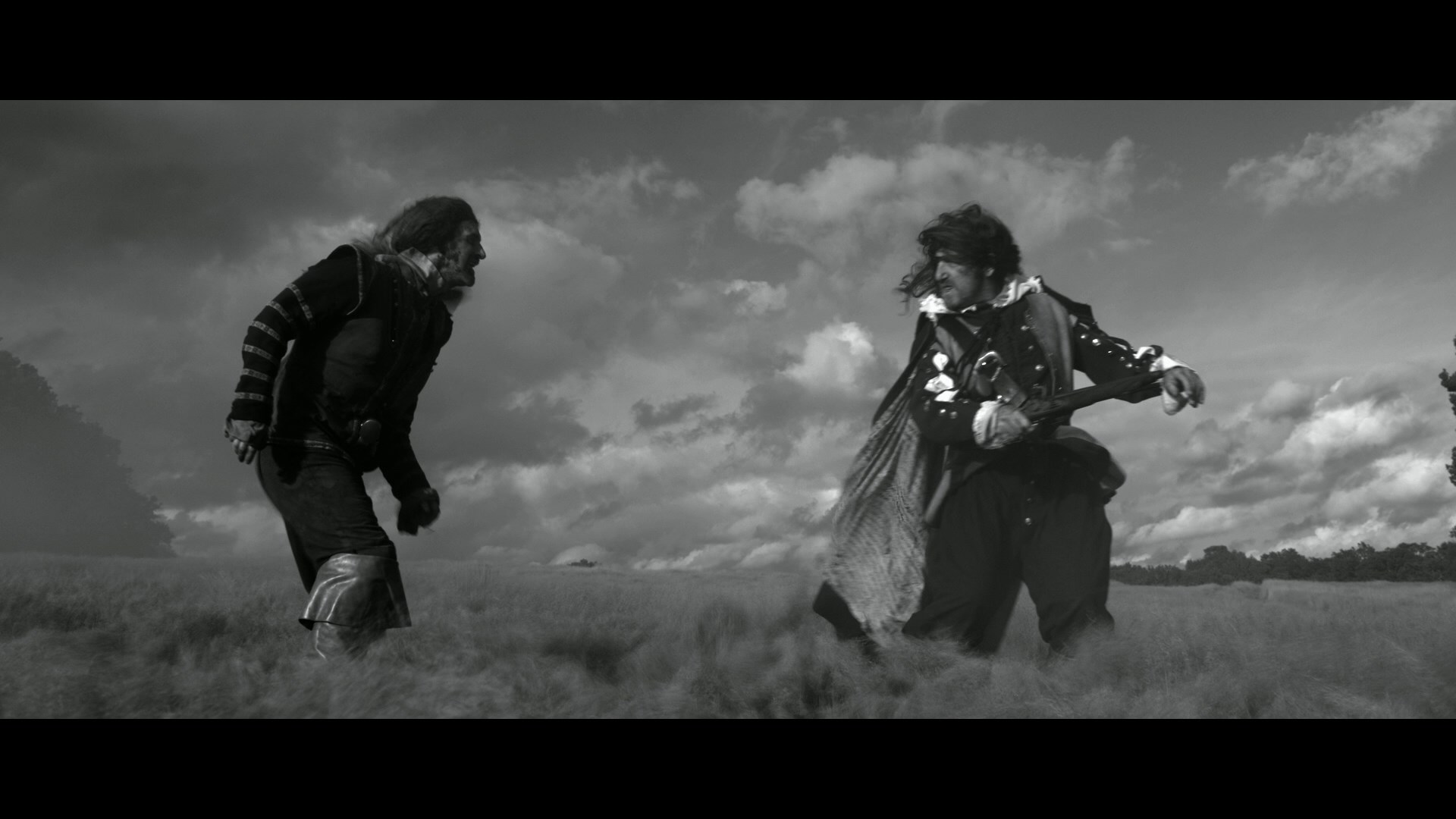 At the time this film was an anomaly for its simultaneous
At the time this film was an anomaly for its simultaneous 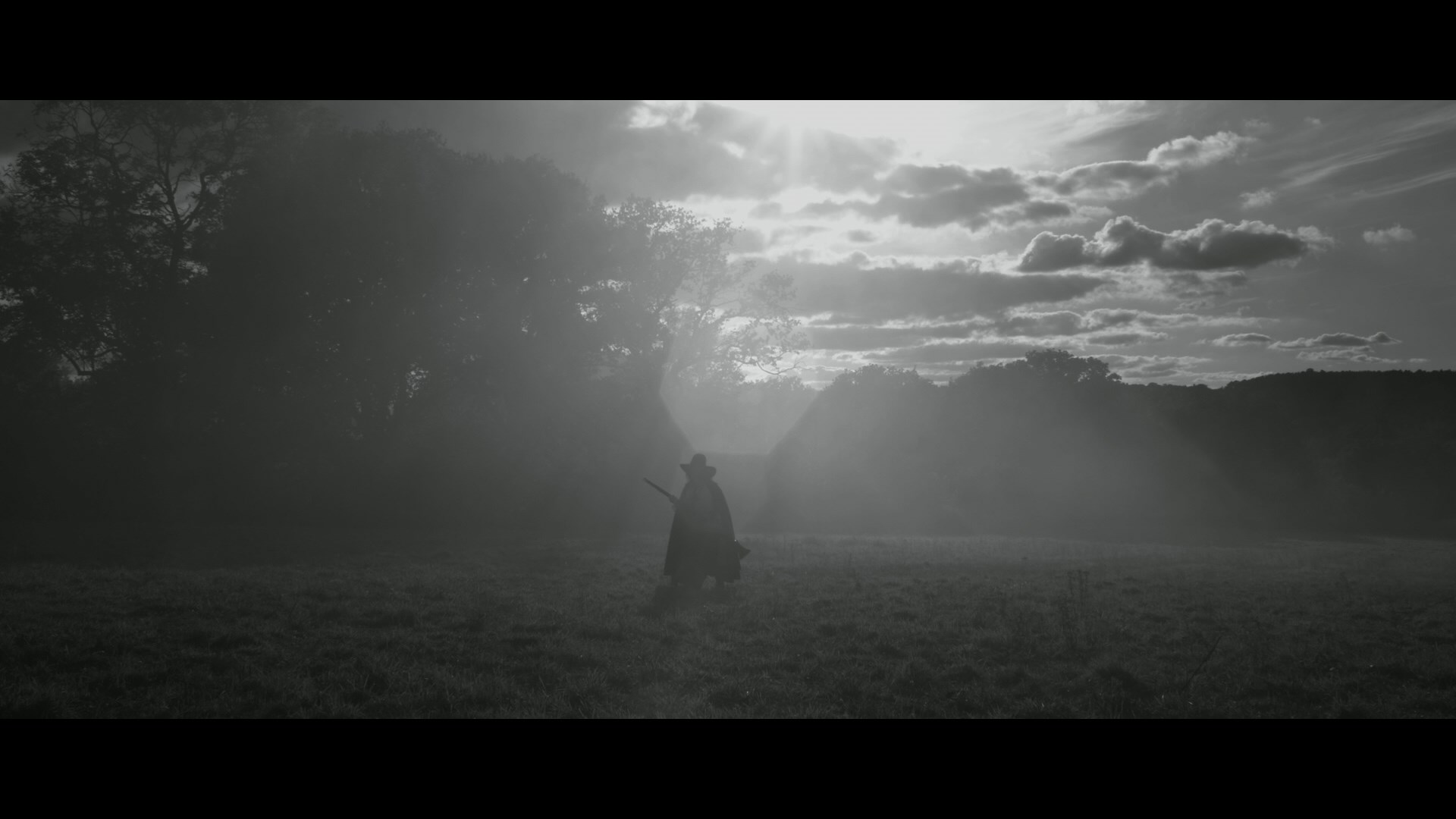 theatrical and VOD release in the U.S., something that seemed to backfire a bit as it didn't seem to do a ton of business. Fortunately it's been steadily building an audience ever since, and the always excellent HD master used here looks akin to the past releases (with nicely enveloping 5.1 and 2.0 stereo mixes)-- and you get a mixture of old and new goodies to boot. A commentary with Wheatley, producer Andy Starke, and sound editor Martin Pavey is an entertaining and dense account of the production process starting with the genesis of the idea on a related doc project, while the new "Letterboxd Magic Hour Episode One" (46m40s) features a lively Zoom conversation between Wheatley and Janisse touching on working with Starke, the ties from In the Earth to his earlier folk horror projects. "Please Hear Me" (6m) features Wheatley and composer Jim Williams (who also scored Woodlands) diving into the creation of the soundscape of the film, while a third Wheatley conversation features Pete Tombs (22m41s) - shot in black and white, fittingly - for a more generalized history of how the film began and evolved. Also included are a batch of camera tests (10m28s) and the U.K. and U.S. trailers.
theatrical and VOD release in the U.S., something that seemed to backfire a bit as it didn't seem to do a ton of business. Fortunately it's been steadily building an audience ever since, and the always excellent HD master used here looks akin to the past releases (with nicely enveloping 5.1 and 2.0 stereo mixes)-- and you get a mixture of old and new goodies to boot. A commentary with Wheatley, producer Andy Starke, and sound editor Martin Pavey is an entertaining and dense account of the production process starting with the genesis of the idea on a related doc project, while the new "Letterboxd Magic Hour Episode One" (46m40s) features a lively Zoom conversation between Wheatley and Janisse touching on working with Starke, the ties from In the Earth to his earlier folk horror projects. "Please Hear Me" (6m) features Wheatley and composer Jim Williams (who also scored Woodlands) diving into the creation of the soundscape of the film, while a third Wheatley conversation features Pete Tombs (22m41s) - shot in black and white, fittingly - for a more generalized history of how the film began and evolved. Also included are a batch of camera tests (10m28s) and the U.K. and U.S. trailers.
Stark medieval dramas are usually a tough sell in the film market, and the 1993 British 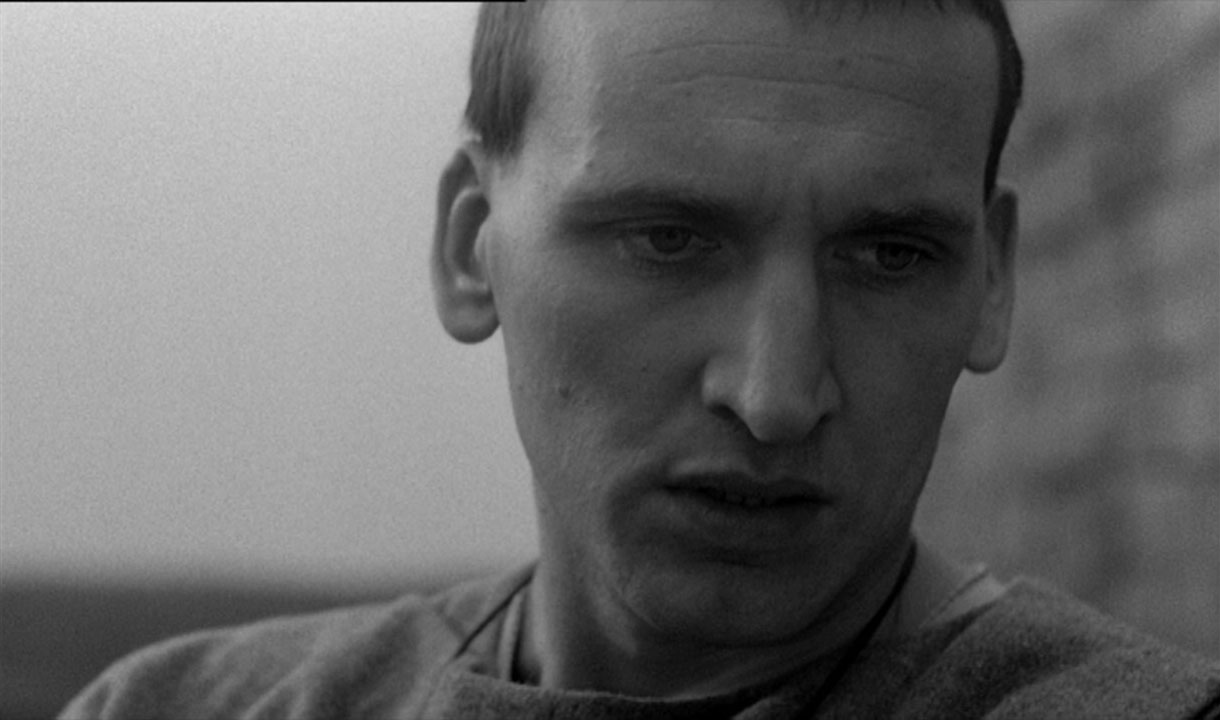 film Anchoress, included on the same disc, appears to be no exception. "Ecstasy and
film Anchoress, included on the same disc, appears to be no exception. "Ecstasy and 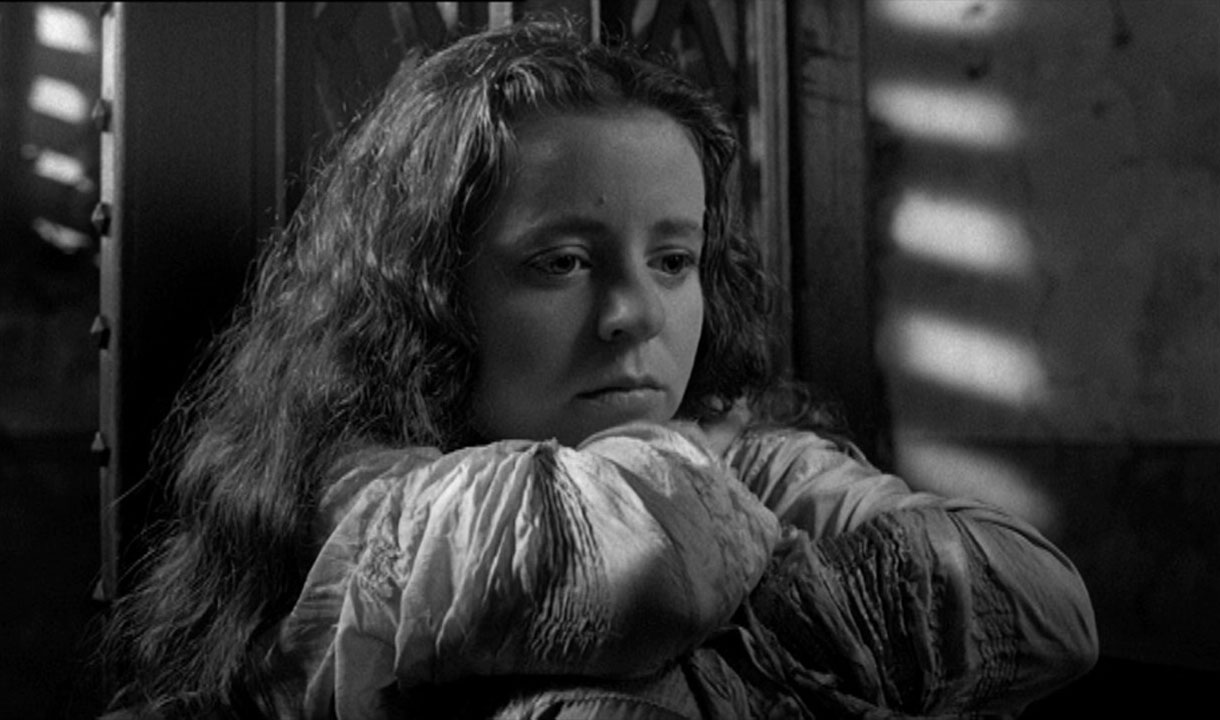 orthodoxy in the 14th Century!" proclaimed the tagline for the film, though the ecstasy is entirely of a spiritual nature. Sort of a modern feminist response to films like The Seventh Seal, this film may prove difficult for the average consumer but rewards patient viewers with stunning imagery and plenty of food for thought.
orthodoxy in the 14th Century!" proclaimed the tagline for the film, though the ecstasy is entirely of a spiritual nature. Sort of a modern feminist response to films like The Seventh Seal, this film may prove difficult for the average consumer but rewards patient viewers with stunning imagery and plenty of food for thought.
Christine Carpenter (Natalie Morse), a devout peasant girl, becomes enraptured with a statue of the Virgin Mary and develops a strong bond with the young local priest (Christopher Eccleston). Her parents, William (Pete Postlethwaite) and Pauline (pop star and TV staple Toyah Willcox), are not as devoted to the church but allow their daughter to become an anchoress - a woman who is walled in to be at one with the Virgin and offer blessings to the outside people. The villagers congregate to a small window at Christine's self-imposed prison, where the priest controls how long and with whom she interacts. However, Christine's introspective existence causes her to move away from her religious faith and become focused on her more earthy dedication to the female goddess herself, Mother Earth. When her mother falls prey to the persecuting religious practices of the day, Christine comes to realize that perhaps she was not destined to 
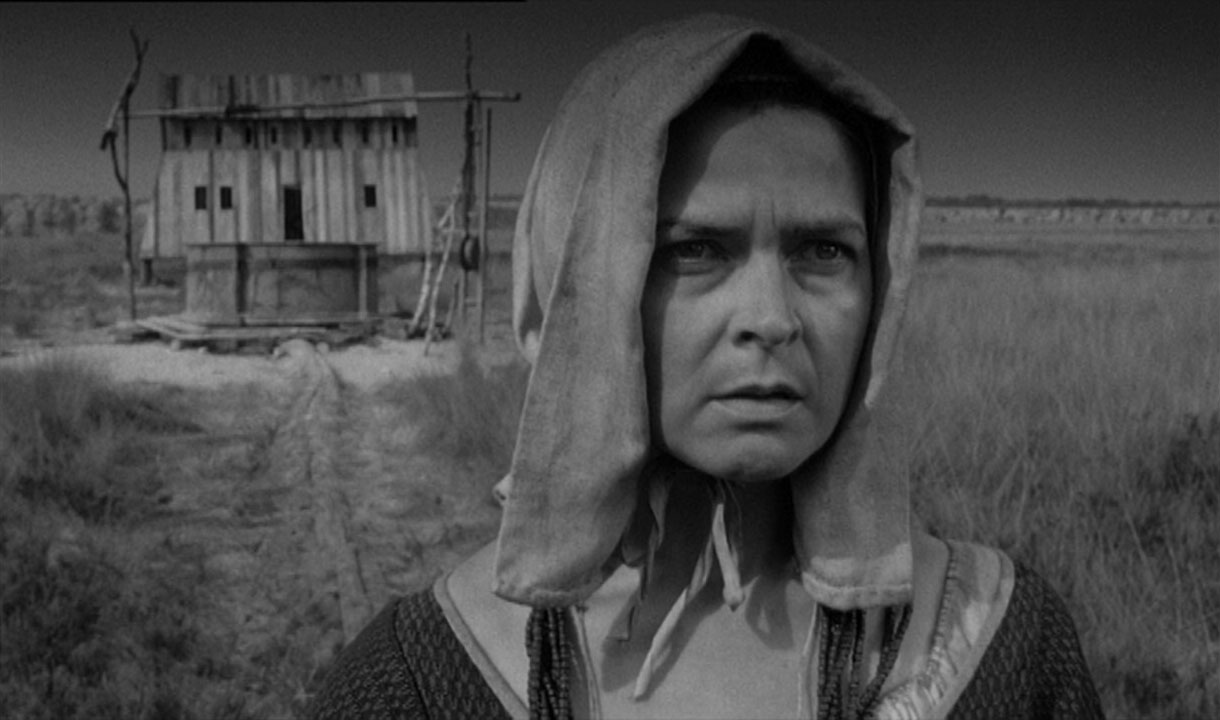 remain an anchoress after all.
remain an anchoress after all.
Featuring a very strong cast of art house regulars (including The Vanishing's Gene Bervoets and a virtually unrecognizable Willcox), Anchoress is first and foremost a convincing, gritty depiction of the Middle Ages, a time when religious convictions dominated every word and deed. The beautiful black and white photography perfectly captures the appearance of a delicate wood carving on film, while the surrealist eye of director Chris Newby (who directed some high profile gay shorts and features like Madagascar Skin) pays off during the delirious, haunting final twenty minutes. Fans of experimental British filmmakers like Derek Jarman and Peter Greenaway will be especially receptive to this film's unique, strangely resonant tone, which seems to spring out of some odd historically-tinged dream state.
Vanguard's U.S. DVD from 2006 presented an accurately letterboxed transfer of the film, albeit non-anamorphic. More dynamic is the Dolby Digital 2.0 audio track, which bristles with life throughout the film. Ambient noises flood the surround speakers, offering a surprising amount of range that will 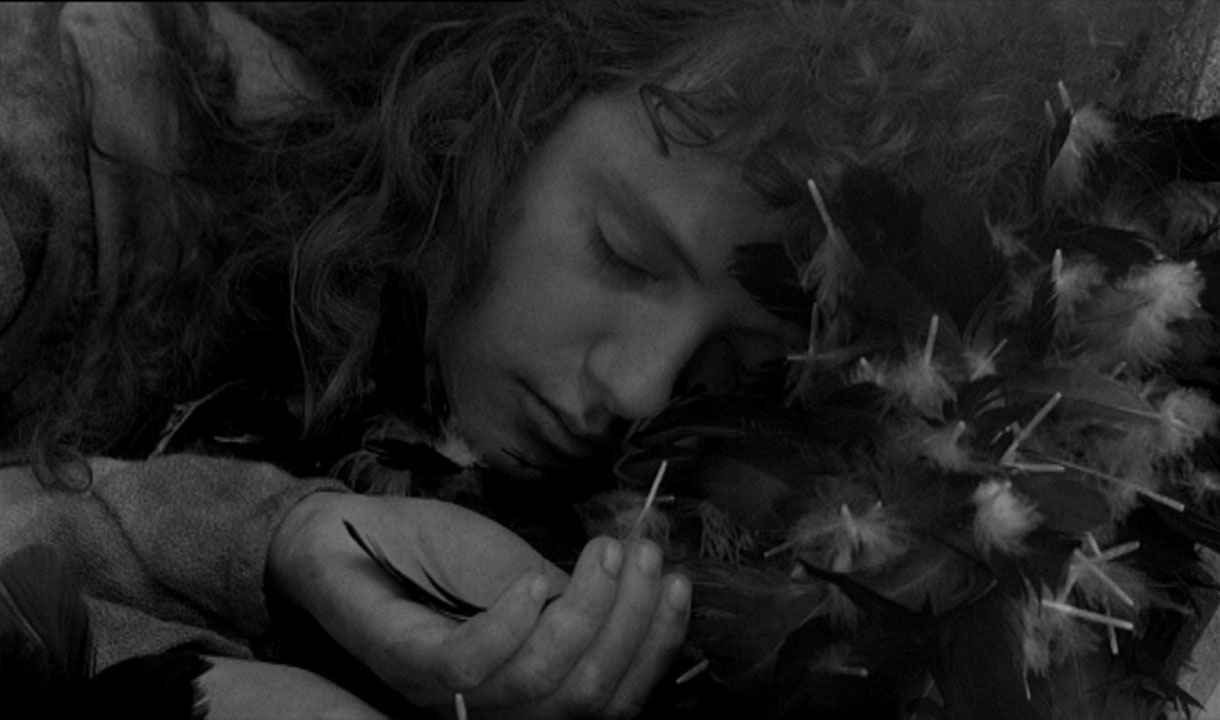 have
have 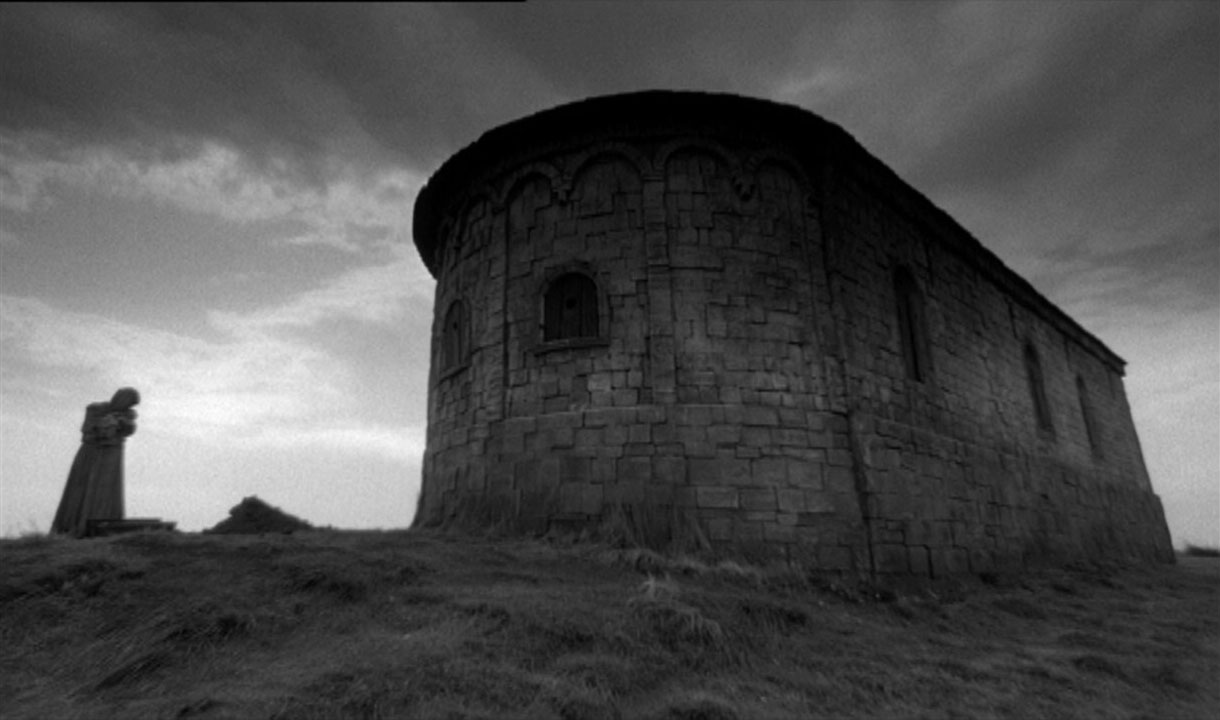 you often glancing over your shoulder. In 2009 the BFI brought the film to U.K. DVD featuring three shorts by director Chris Newby: The Old Man of the Sea (1989), Flicker (2001), and Stromboli (1998). The Severin release marks the film's first appearance in HD from a master provided by the BFI, though curiously it's 720p instead of the usual 1080. It still looks significantly better than its SD predecessors though with the contrast in particular looking much more natural and nuanced here. The DTS-HD MA English 2.0 track is an accurate representation of the original mix, again with some nice separation throughout (especially that windy rainfall). Extras consist of two featurettes by Newby: Lockdown 1329 (14m4s), a reflection on how his existence during the Covid lockdown in some ways parallels the events of the film (which is represented here by some interesting VHS-sourced unused outtakes), and A Short Trip to Shere (2m27s), a video visit to the location of the real Christine Carpenter's cell.
you often glancing over your shoulder. In 2009 the BFI brought the film to U.K. DVD featuring three shorts by director Chris Newby: The Old Man of the Sea (1989), Flicker (2001), and Stromboli (1998). The Severin release marks the film's first appearance in HD from a master provided by the BFI, though curiously it's 720p instead of the usual 1080. It still looks significantly better than its SD predecessors though with the contrast in particular looking much more natural and nuanced here. The DTS-HD MA English 2.0 track is an accurate representation of the original mix, again with some nice separation throughout (especially that windy rainfall). Extras consist of two featurettes by Newby: Lockdown 1329 (14m4s), a reflection on how his existence during the Covid lockdown in some ways parallels the events of the film (which is represented here by some interesting VHS-sourced unused outtakes), and A Short Trip to Shere (2m27s), a video visit to the location of the real Christine Carpenter's cell.
ANCHORESS: Severin (Blu-ray)
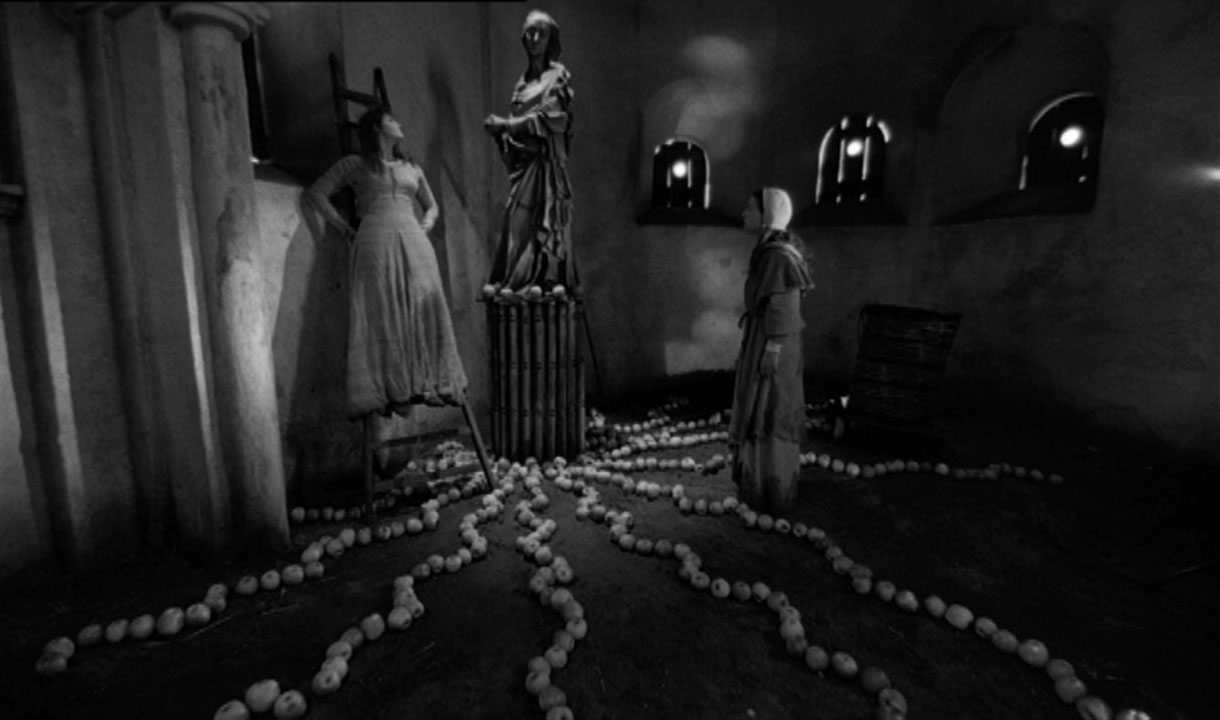
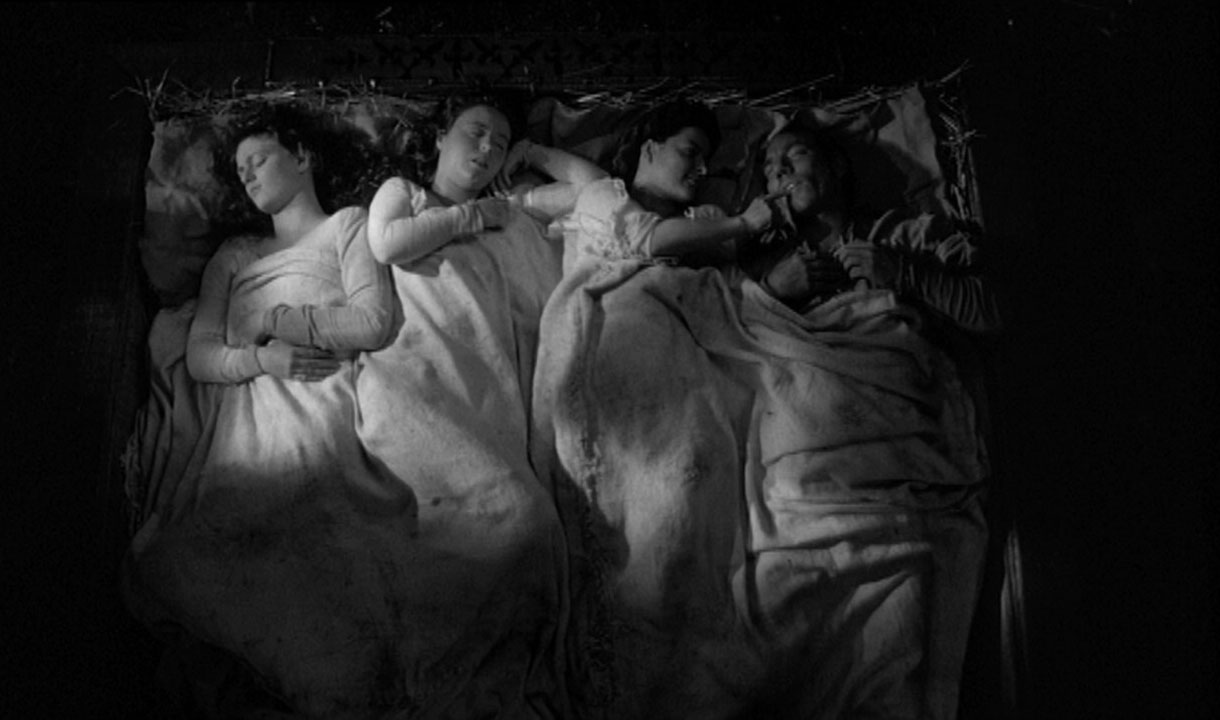
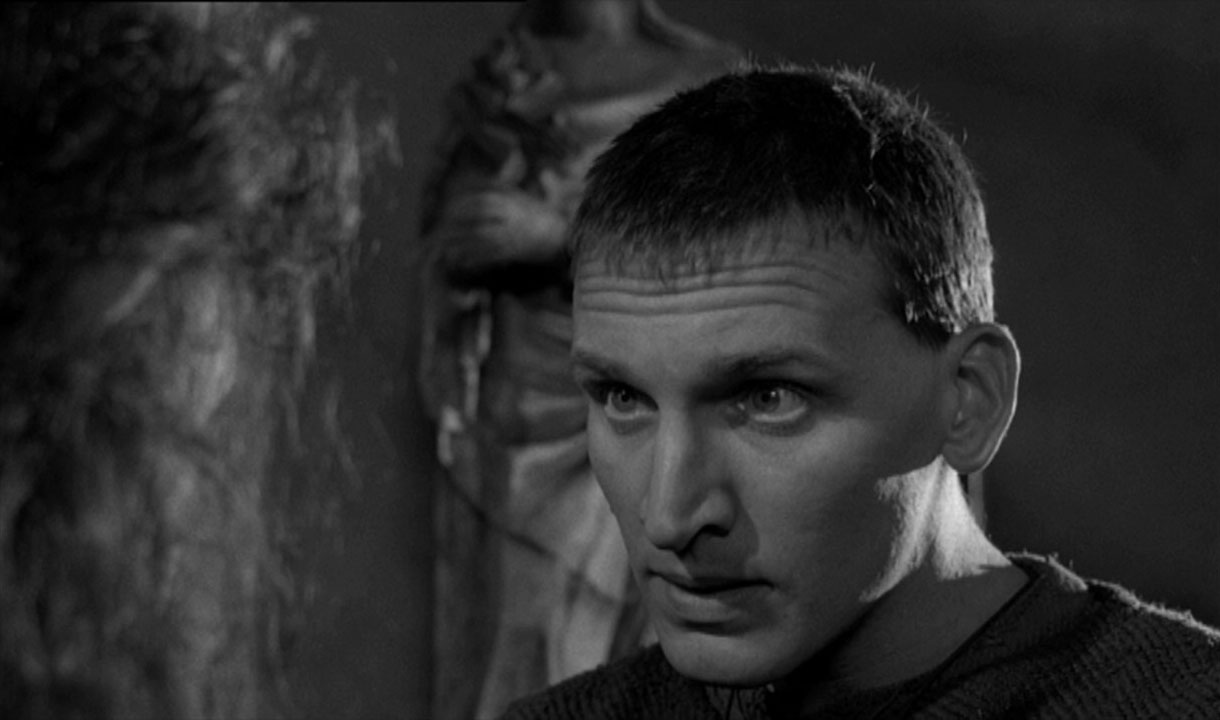
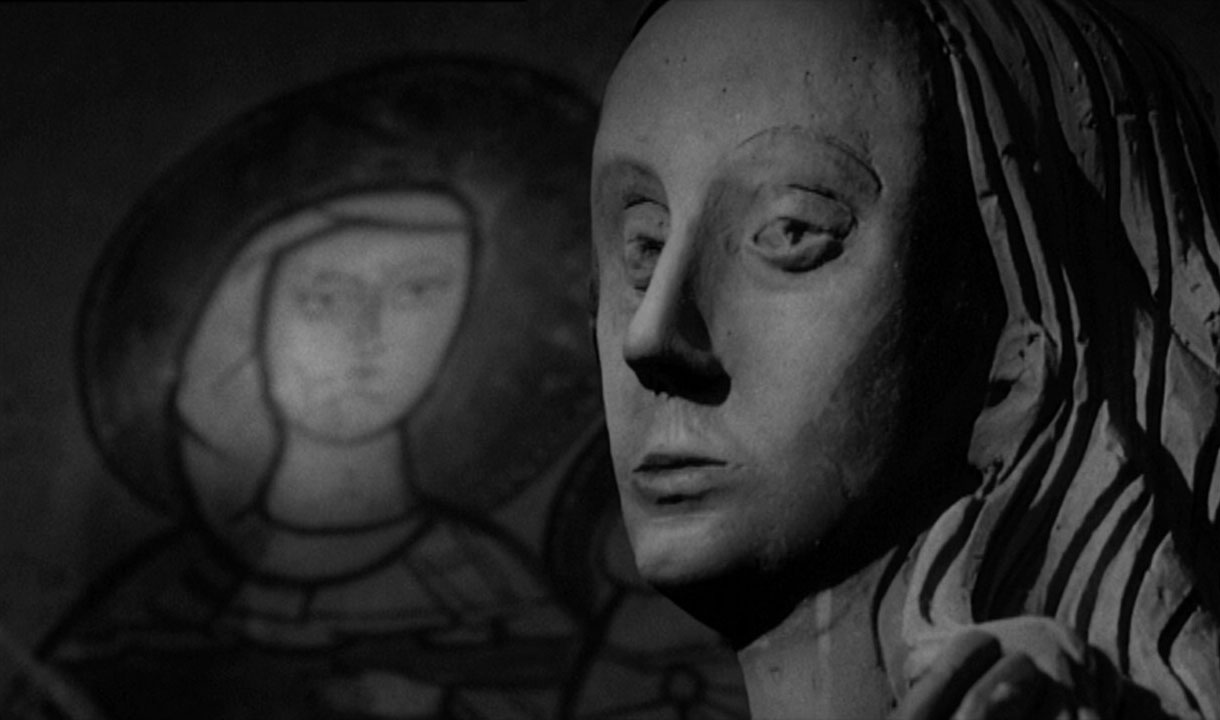
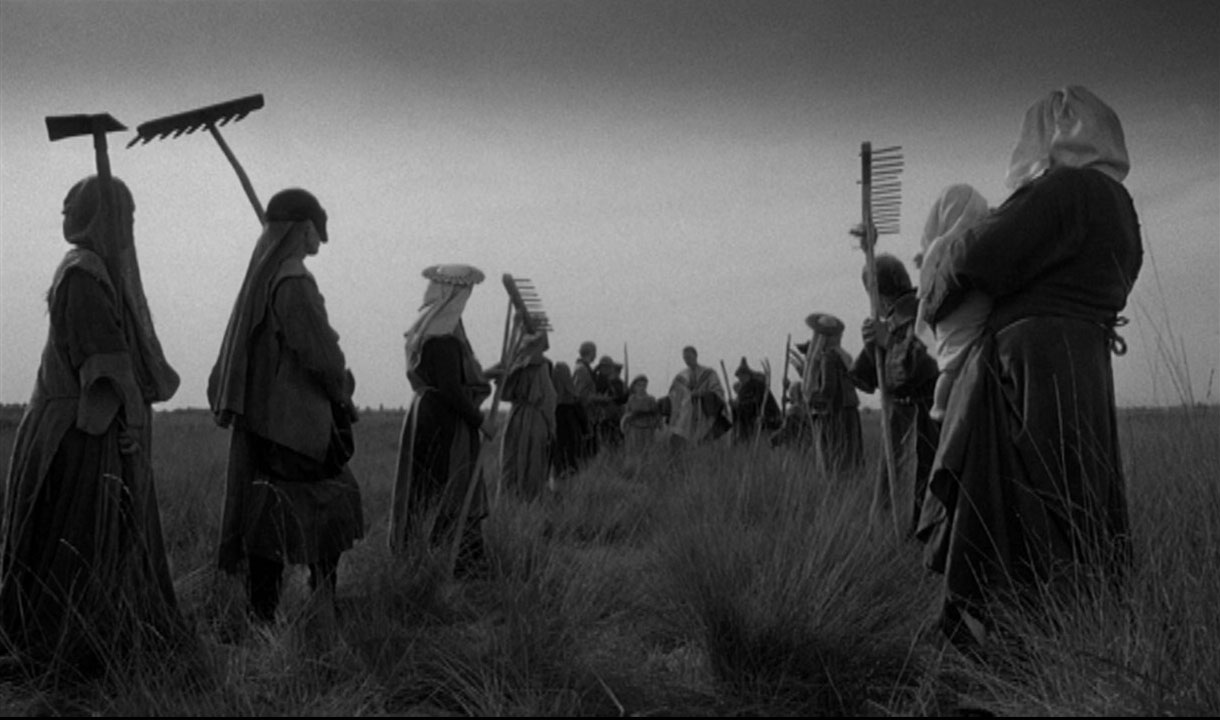
ANCHORESS: Vanguard (DVD)
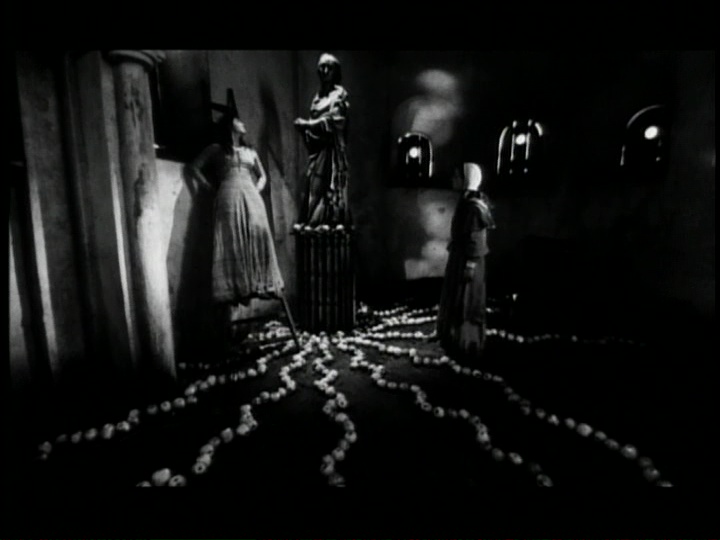
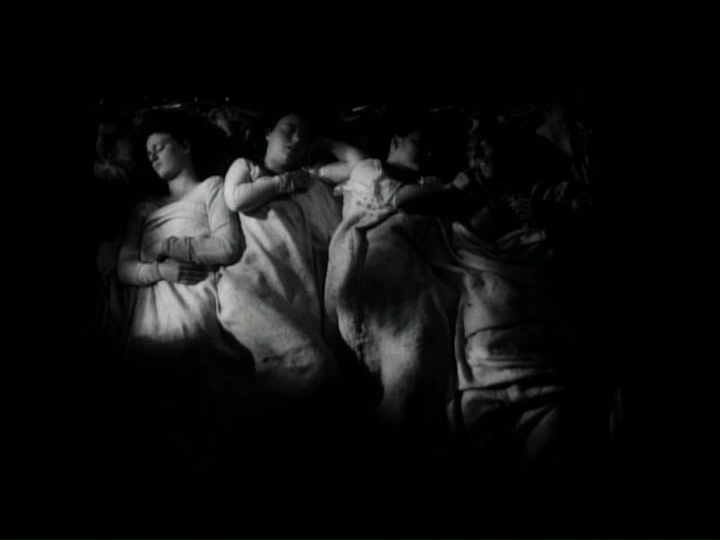
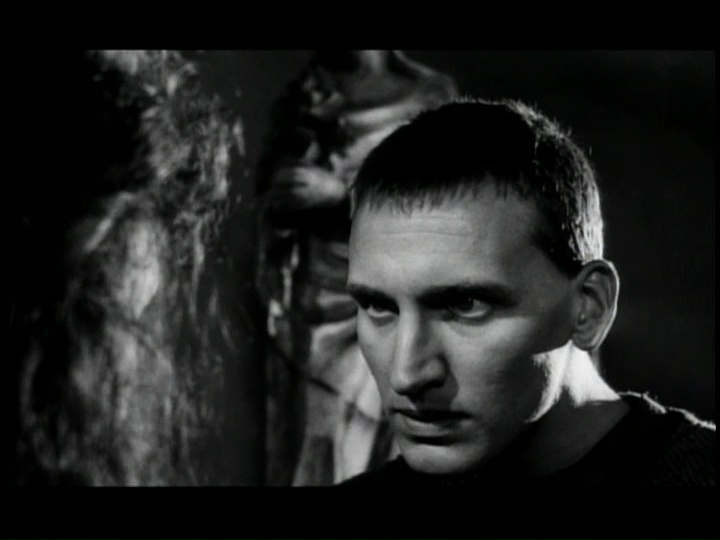
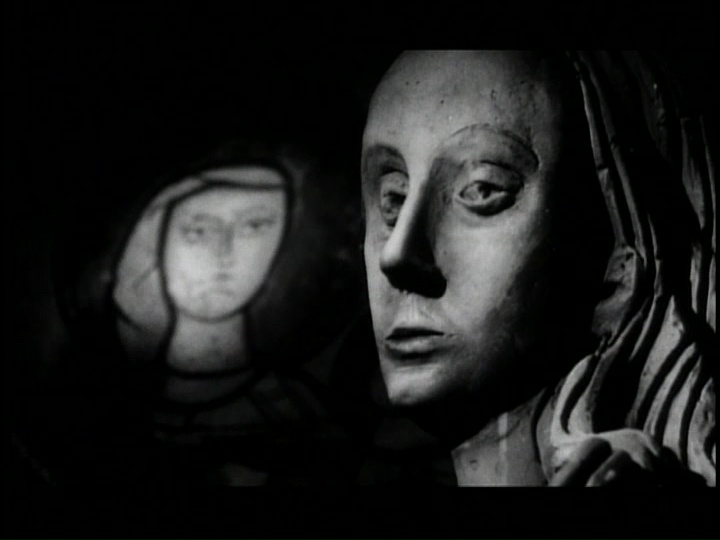
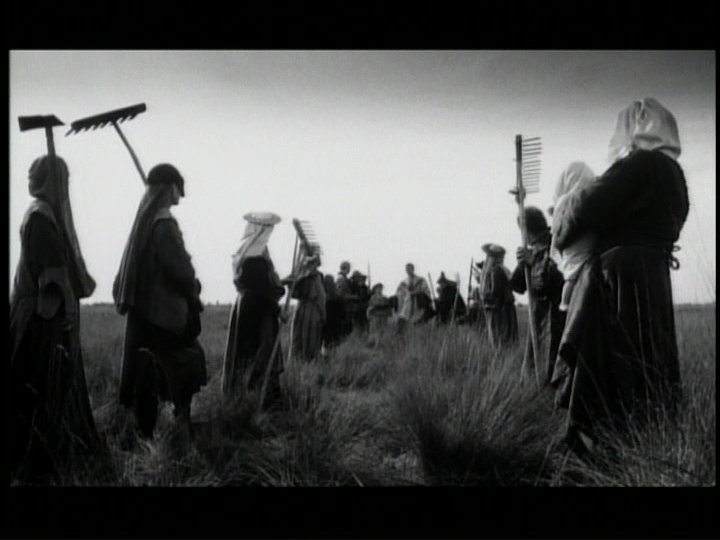
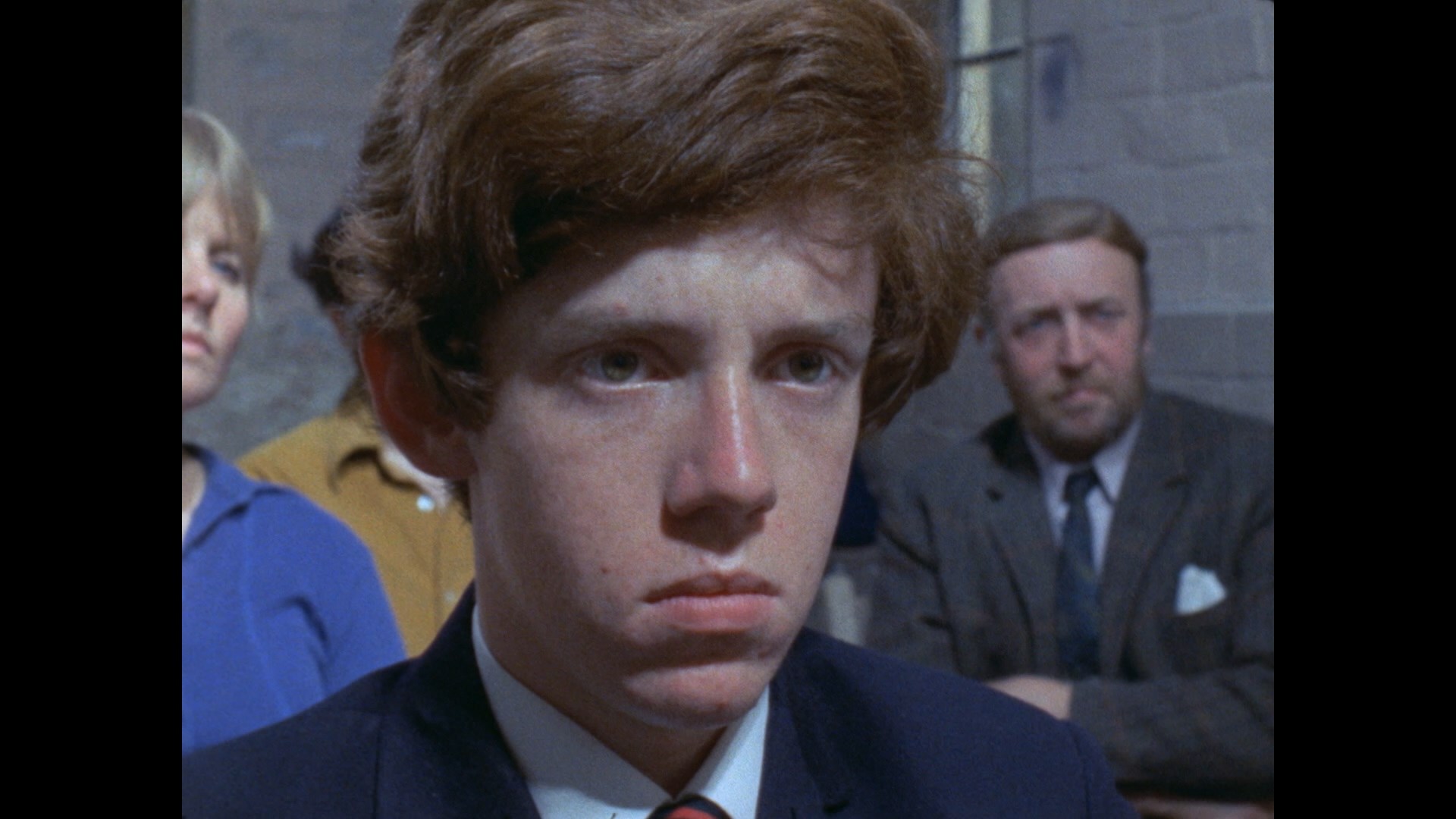
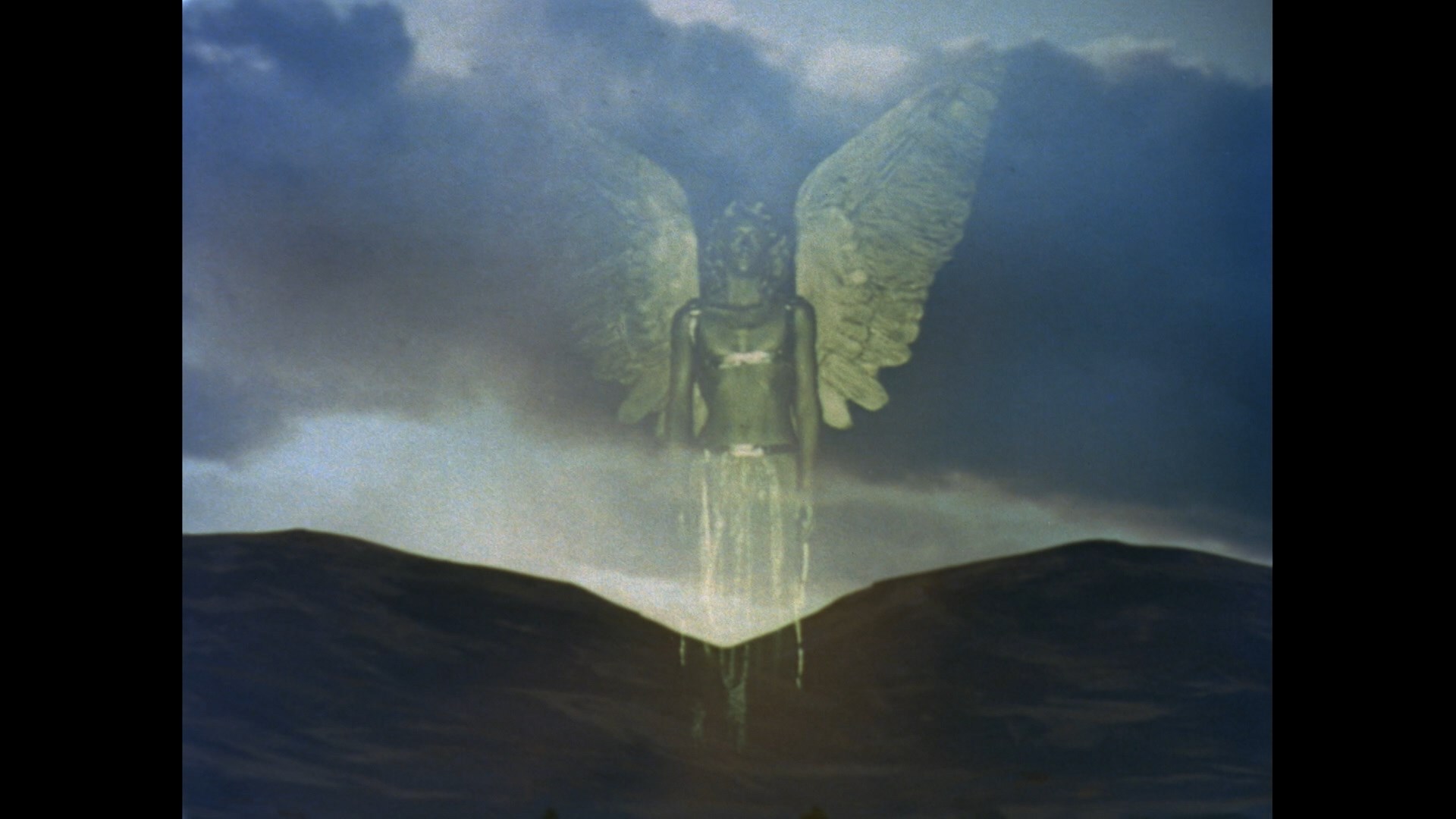 Finally on disc twelve we get a pair of major British TV folk horror entires starting with 1974's Penda’s Fen, which makes its U.S. debut in any format and only got a U.K. release in 2016 on Blu-ray and DVD from the BFI (in standalone Blu-ray and DVD editions and as part of the massive Dissent & Disruption: Alan Clarke at the BBC box). A startling, intense fantasia originally shown as an episode of Play for Today and written by playwright David Rudkin, the enigmatic story revolves around adolescent Stephen (Spencer Banks), a lad who's fixated on the music of Edward Elgar (which he plays full blast in his bedroom) and becomes besieged by intense visions of pre-Christian English paganism including the ancient King Penda, with various angels and jet-black demons thrown into the mix. His vicar father offers some unorthodox viewpoints of his own as the boy struggles to determine his own identity, both spiritually and sexually.
Finally on disc twelve we get a pair of major British TV folk horror entires starting with 1974's Penda’s Fen, which makes its U.S. debut in any format and only got a U.K. release in 2016 on Blu-ray and DVD from the BFI (in standalone Blu-ray and DVD editions and as part of the massive Dissent & Disruption: Alan Clarke at the BBC box). A startling, intense fantasia originally shown as an episode of Play for Today and written by playwright David Rudkin, the enigmatic story revolves around adolescent Stephen (Spencer Banks), a lad who's fixated on the music of Edward Elgar (which he plays full blast in his bedroom) and becomes besieged by intense visions of pre-Christian English paganism including the ancient King Penda, with various angels and jet-black demons thrown into the mix. His vicar father offers some unorthodox viewpoints of his own as the boy struggles to determine his own identity, both spiritually and sexually.
Definitely an unusual undertaking for Clarke, this strays closer to Ken Russell territory than anything else he directed and still packs a visceral punch even when you aren't entirely sure what it all means. It's a real joy seeing this filmed production in immaculate quality, looking absolutely pristine and far better than anyone has ever seen it before. The shots of the English countryside are especially striking, with magic hour lighting in particular making this a real visual showcase. It also makes it clearer how this operates as a sort of spiritual relative to Malpertuis and Dario Argento's Inferno with 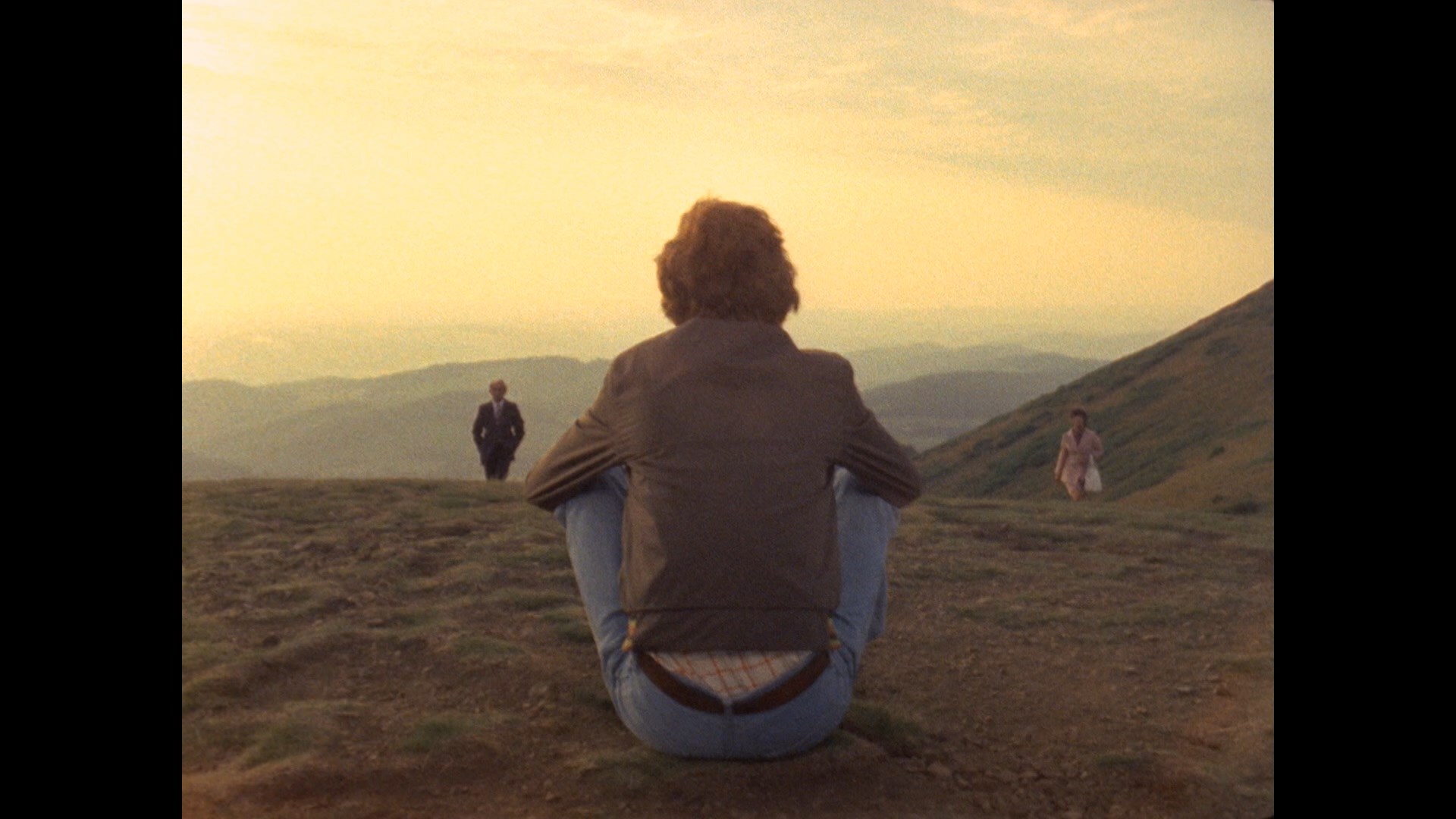 its
its 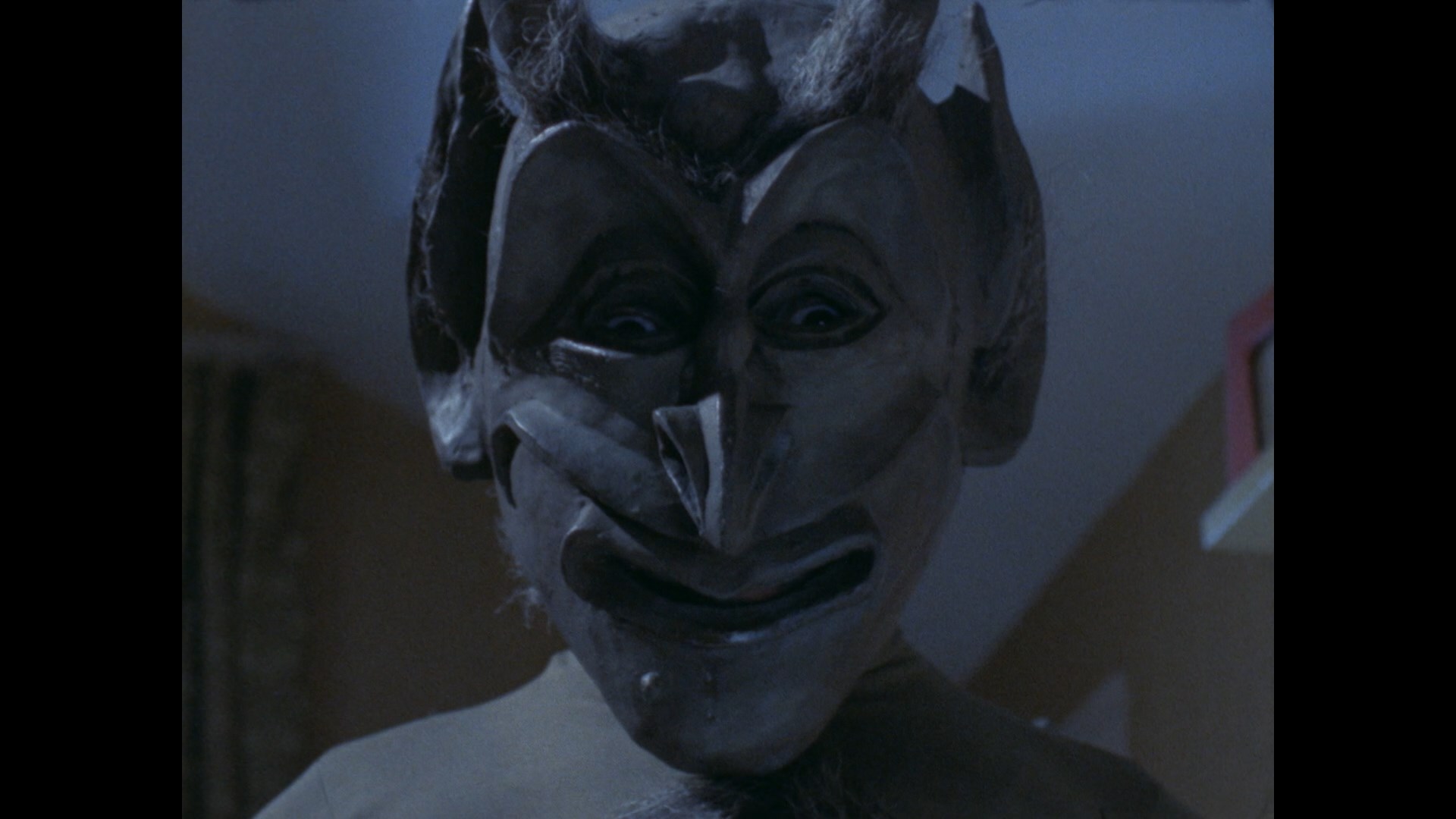 ideas of ancient, potentially sinister religions and cultures lurking inside the skin of the current one.
ideas of ancient, potentially sinister religions and cultures lurking inside the skin of the current one.
The BFI release paired Penda's Fen up with 1973's The Love-Girl and the Innocent with a relevant segment of the multi-part featurette series "Alan Clarke: Out of His Own Light as the sole extra. The Severin release instead features an audio commentary by James Machin and Matthew Harle, editors of the book Of Mud & Flame: The Penda’s Fen Sourcebook. As you'd expect they're exactly the ideal ones to do this track as they cover all the details you'd expect from an opening dissertation on Elgar through the dramatic tactics of Rudkin and their own favorite little moments scattered throughout. Andy Kelleher's featurette "The Landscape of Feelings: The Road to Penda’s Fen" (16m30s) features Rudkin, producer David Rose, writer David Yallop, actor Sean Chapman, and playwright David Leland discussing the film's fortuitous creation from an encounter between Clarke and Rudkin's wife through the process of scripting, casting, and the impactful broadcast. Also included is the excellent 1981 short film The Pledge (21m42s) by Digby Rumsey, previously seen on the U.K. Blu-ray of Schalken the Painter. Featuring a marvelous score by Michael Nyman (and reportedly co-edited by Peter Greenaway without credit), it's a strong piece of work about the fallout when some robbers decide whether they should cut down the body of their brutish hanged colleague to save his soul. This is taken from the same solid master created by the BFI and makes for a welcome addition here.
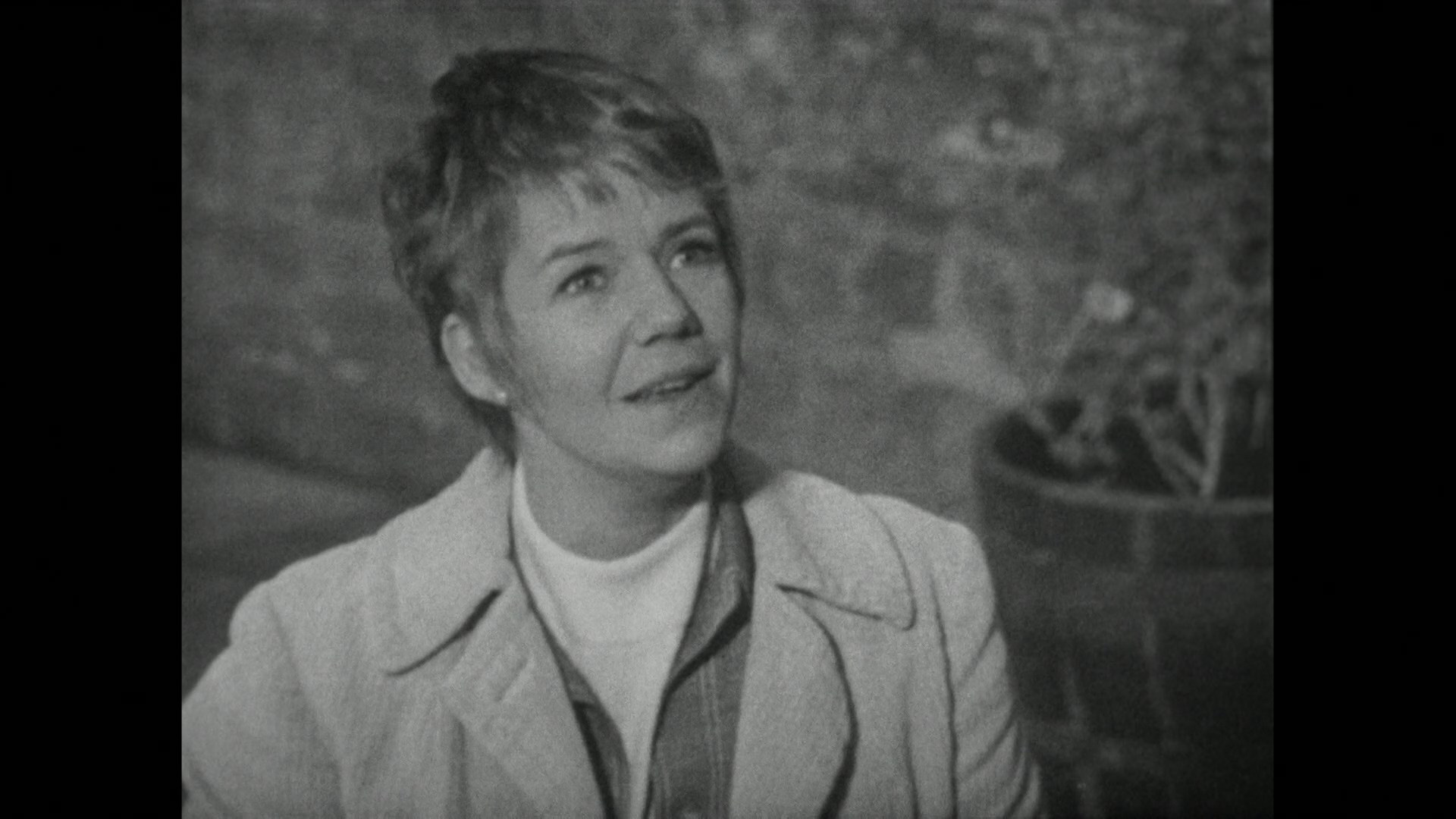 Originally broadcast just
Originally broadcast just 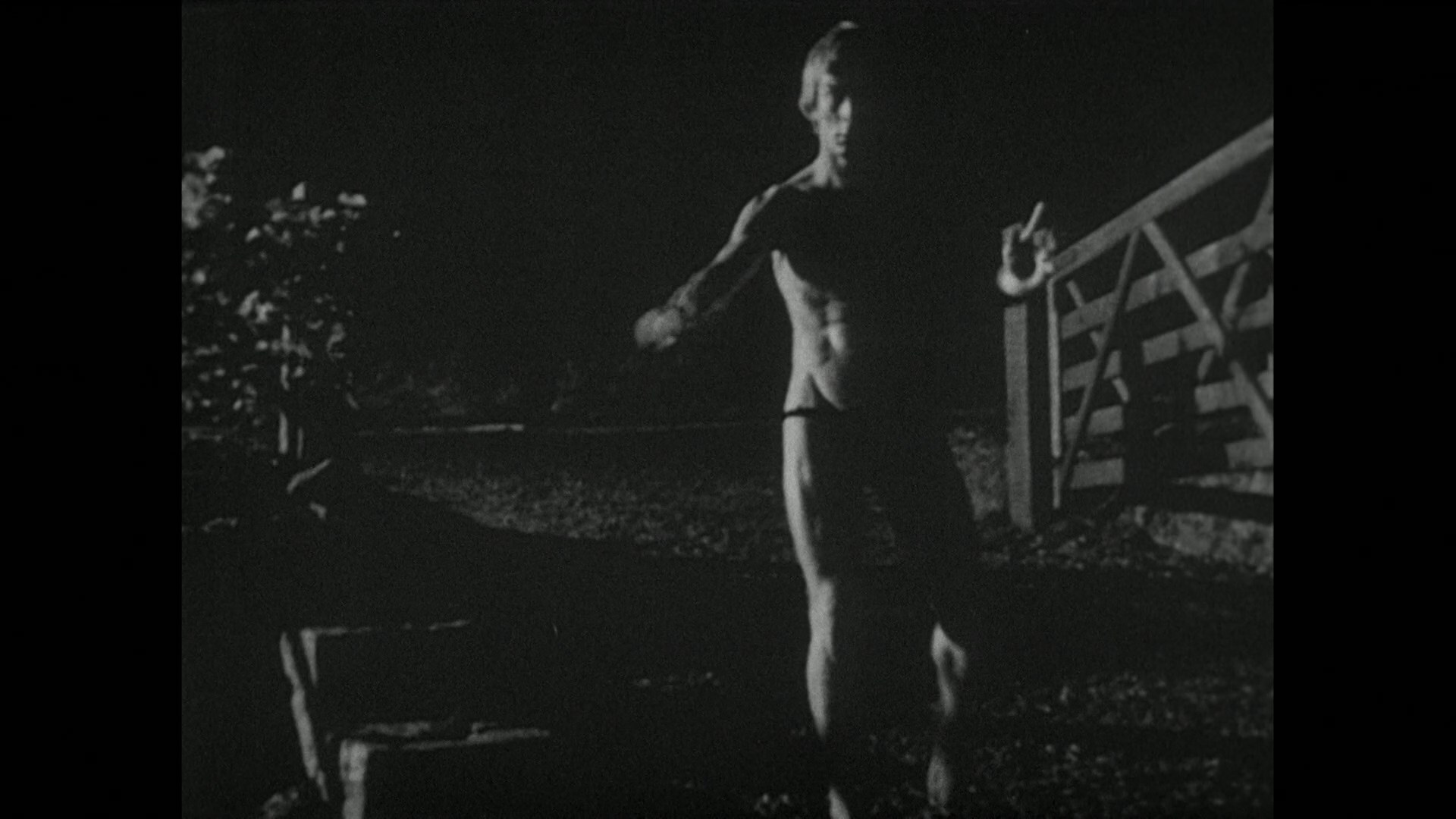 before Christmas in 1970 as part of the BBC series Play for Today (and rebroadcast due a signal drop in some areas), the chilly Robin Redbreast on the same disc is a folk-laced tale of paganism and terror in the countryside made three years before The Wicker Man, with which it shares a number of striking similarities. Still getting over the collapse of an eight-year unwed relationship, TV script editor Norah Palmer (Cropper) decides to get her head together out in the country. She isn't all that interested in marrying or having kids at the age of 35, and during her idyll at a cottage with only the nocturnal invasions of field mice to keep her company, she starts to feel some physical attraction to a local games keeper, Rob (Bradford), whom she spies in the woods practicing martial arts in a speedo. Rob attempts to bed her during one visit at night and finally succeeds when she's frightened by an intrusion of birds through her chimney. However, she has no intention of continuing a relationship even when she winds up pregnant (thanks to the mysterious disappearance of her diaphragm). After a brief return to the city, she comes back to the cottage but, suddenly without a car, finds herself trapped in the village with no means of escape.
before Christmas in 1970 as part of the BBC series Play for Today (and rebroadcast due a signal drop in some areas), the chilly Robin Redbreast on the same disc is a folk-laced tale of paganism and terror in the countryside made three years before The Wicker Man, with which it shares a number of striking similarities. Still getting over the collapse of an eight-year unwed relationship, TV script editor Norah Palmer (Cropper) decides to get her head together out in the country. She isn't all that interested in marrying or having kids at the age of 35, and during her idyll at a cottage with only the nocturnal invasions of field mice to keep her company, she starts to feel some physical attraction to a local games keeper, Rob (Bradford), whom she spies in the woods practicing martial arts in a speedo. Rob attempts to bed her during one visit at night and finally succeeds when she's frightened by an intrusion of birds through her chimney. However, she has no intention of continuing a relationship even when she winds up pregnant (thanks to the mysterious disappearance of her diaphragm). After a brief return to the city, she comes back to the cottage but, suddenly without a car, finds herself trapped in the village with no means of escape.
If the comparison above (and on the disc packaging) to The Wicker Man leads you to think you know exactly where this is heading, well, you're going to be a bit surprised by the final outcome. There's a third act monologue that's a dead ringer for Christopher Lee's in that more famous film, but the story itself swerves in a highly disturbing direction that could fuel a dozen gender studies term papers. 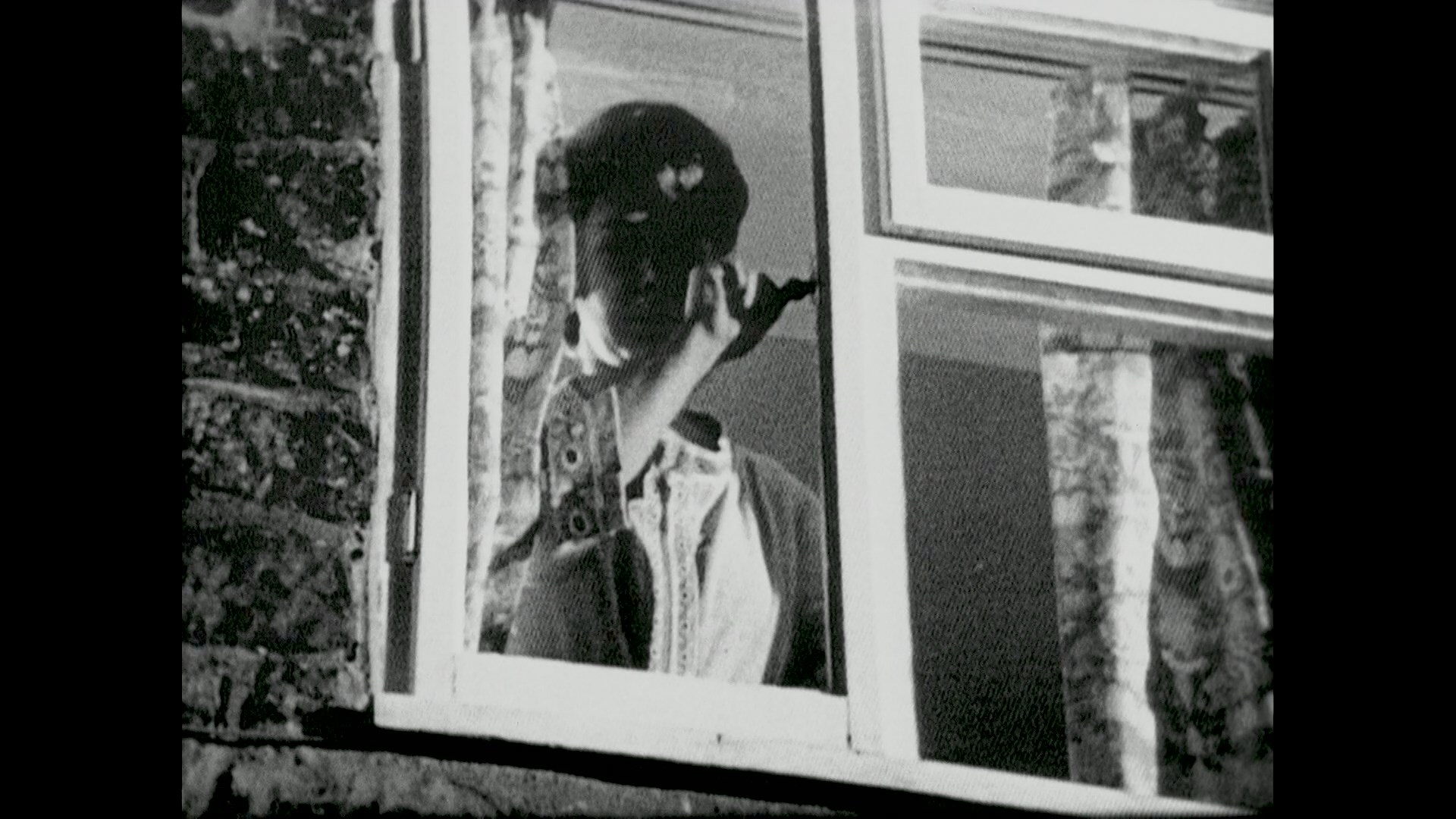 The
The 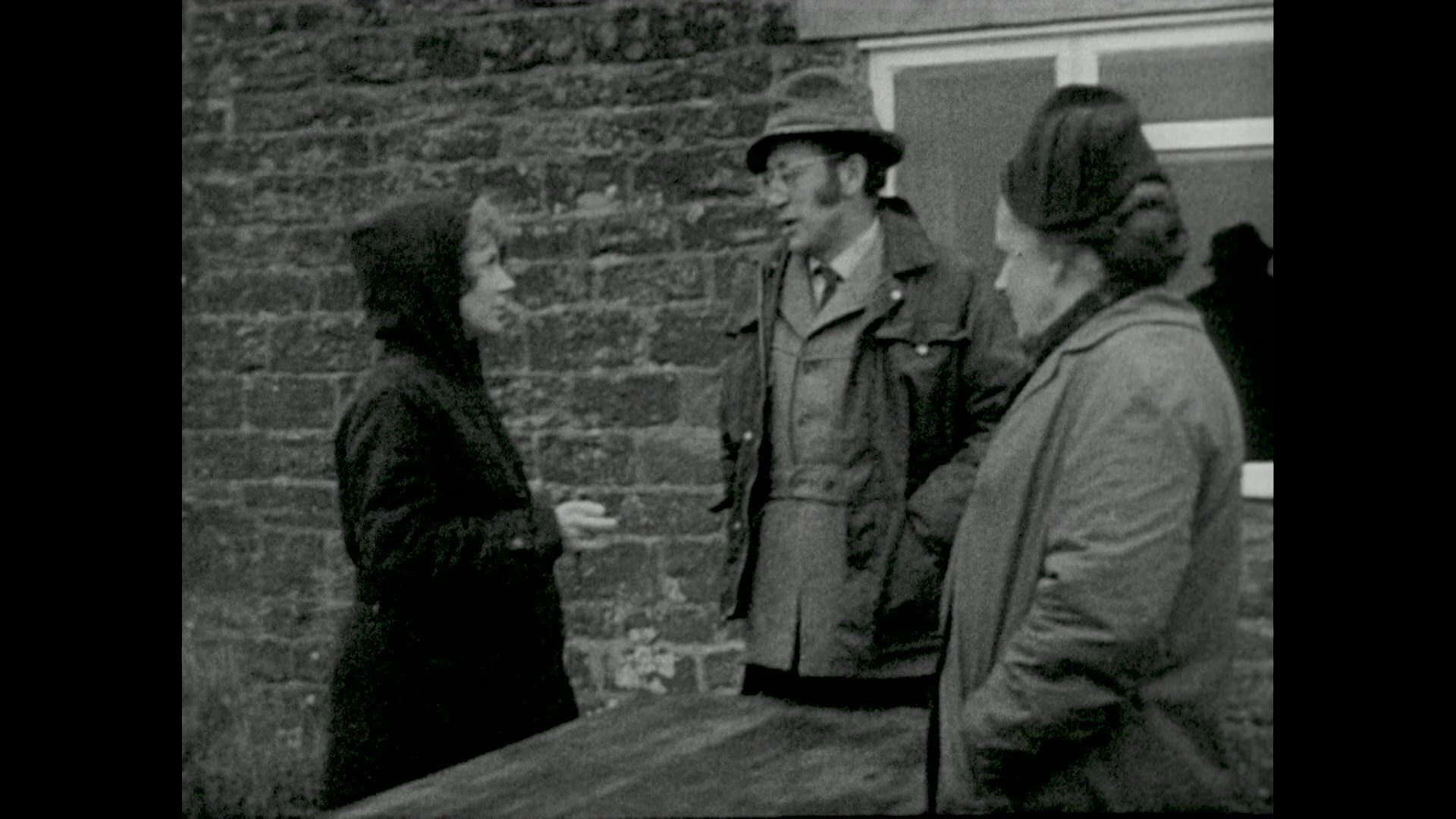 horrific screws don't actually get tightened until the last few minutes, but it's an impressive feat of the macabre complete with a truly unnerving gag involving Norah's chimney that would've been ripped off by a lot of filmmakers had this been easier to see. The dialogue by writer John Bowen (who also penned The Ice House and The Treasure of Abbot Thomas) goes a long way towards selling a concept that might have proven extremely offensive to some at the time, including a surprising discussion of abortion by Cropper that feels incredibly candid even by feature film standards. In fact, her entire character is an unusual one for a horror story; her insistence at keeping sex and love separate and her refusal to bow to social pressures also make her more than a little unsympathetic (and even downright cruel at times), but this pays off in spades at the end when the story manages to upend the entire concept of religious and social morality for the audience.
horrific screws don't actually get tightened until the last few minutes, but it's an impressive feat of the macabre complete with a truly unnerving gag involving Norah's chimney that would've been ripped off by a lot of filmmakers had this been easier to see. The dialogue by writer John Bowen (who also penned The Ice House and The Treasure of Abbot Thomas) goes a long way towards selling a concept that might have proven extremely offensive to some at the time, including a surprising discussion of abortion by Cropper that feels incredibly candid even by feature film standards. In fact, her entire character is an unusual one for a horror story; her insistence at keeping sex and love separate and her refusal to bow to social pressures also make her more than a little unsympathetic (and even downright cruel at times), but this pays off in spades at the end when the story manages to upend the entire concept of religious and social morality for the audience.
The archiving of television programs in the 1970s was notoriously hit and miss with many valuable productions lost forever thanks to the mass erasing of tapes and other cost-saving measures, so the fact that Robin Redbreast still exists at all is a minor miracle. In a situation common for too many British and American broadcasts (perhaps most famously the Julie Andrews production of Cinderella), this was originally shown in color but preserved in black and white on 16mm film. In this case the monochrome actually isn't a damaging factor; in fact, some of the spookier moments even gain a bit because of it. The 2013 BFI DVD, the first ever home video release in any format, presents Robin Redbreast (whose title becomes really eerie when you learn its true meaning at the end) in as fine a presentation as the original materials could allow, with most of it in surprisingly crisp condition. The quality takes a bit of a dive at the one hour mark with an increasingly gritty texture that looks like mild broadcast noise, but it's still highly watchable and welcome in whatever state still exists. Optional English subtitles are also included. On the extras side, writer Bowen 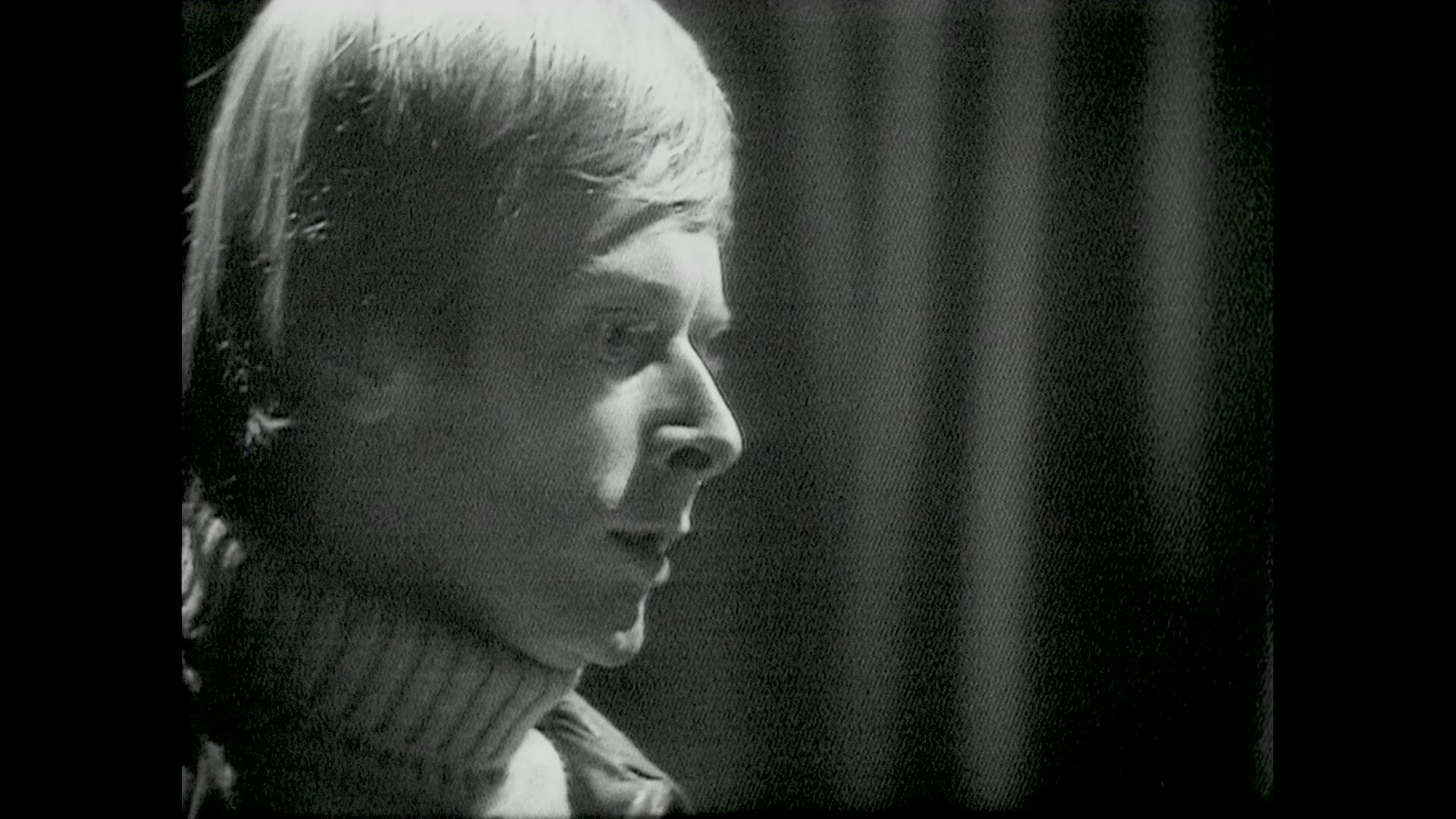 appears for a fascinating new 11-minute video interview in which he talks about how much of
appears for a fascinating new 11-minute video interview in which he talks about how much of 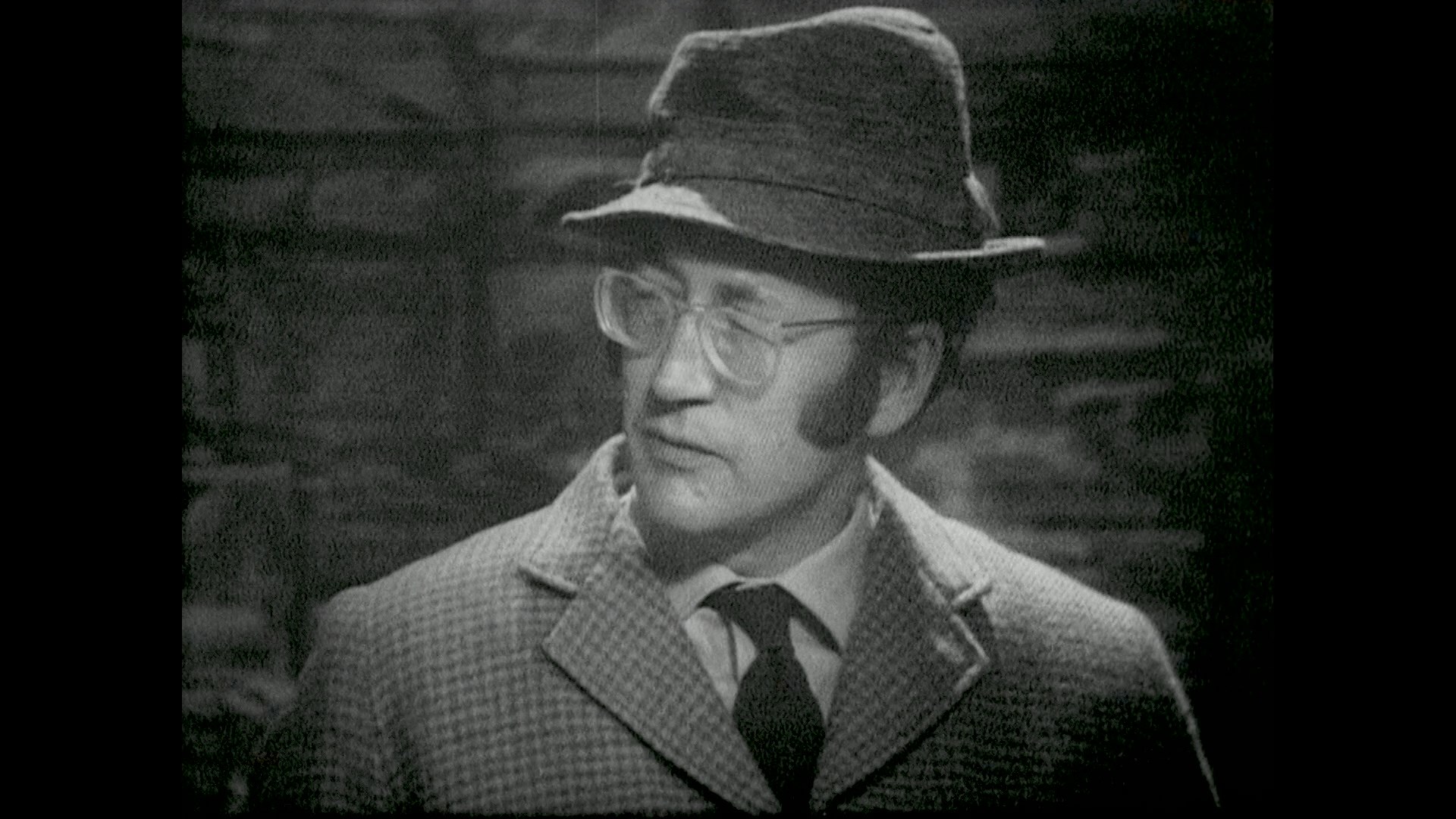 his own life influenced the story, right down to the house itself (a studio reconstruction of the one in which he still lives) and plenty of little details that might otherwise seem innocuous, such as the neighbor asking if he dig in Norah's garden for "sherds." In case you're wondering what a sherd is, you'll find out in the liner notes by Vic Pratt, who does an exceptional job of putting the story in context with the times and offers some fine written nuggets like "Casual partners can be as carelessly picked out as rogue croutons floating atop the cheese in the dinner party fondue set." William Fowler contributes another set of notes about Bowen and the film, including its more potentially controversial aspects; bios for Bowen and director James MacTaggart are also provided. Not to be overlooked is another video bonus, the 1937 11-minute short Around the Village Green, a romantic snapshot of the provincial lifestyle
painted in a much more sinister light in the main feature. Also tucked away in the set up menu is "Test Card F," the BBC's original slightly unnerving test tone and graphic created in 1967 to aid in calibrating video and audio settings. The fact that it features a little girl and a slightly creepy toy clown makes it an oddly appropriate addition here, not to mention the fact that it will play forever if you don't hit the stop button.
his own life influenced the story, right down to the house itself (a studio reconstruction of the one in which he still lives) and plenty of little details that might otherwise seem innocuous, such as the neighbor asking if he dig in Norah's garden for "sherds." In case you're wondering what a sherd is, you'll find out in the liner notes by Vic Pratt, who does an exceptional job of putting the story in context with the times and offers some fine written nuggets like "Casual partners can be as carelessly picked out as rogue croutons floating atop the cheese in the dinner party fondue set." William Fowler contributes another set of notes about Bowen and the film, including its more potentially controversial aspects; bios for Bowen and director James MacTaggart are also provided. Not to be overlooked is another video bonus, the 1937 11-minute short Around the Village Green, a romantic snapshot of the provincial lifestyle
painted in a much more sinister light in the main feature. Also tucked away in the set up menu is "Test Card F," the BBC's original slightly unnerving test tone and graphic created in 1967 to aid in calibrating video and audio settings. The fact that it features a little girl and a slightly creepy toy clown makes it an oddly appropriate addition here, not to mention the fact that it will play forever if you don't hit the stop button.
The Severin release is taken from the same black-and-white master, of course, here bumped to 1080 with the best results you can get from the source; again, it's a miracle we have it at all. Here Pratt and William Fowler, who both wrote The Bodies Beneath: The Flipside of British Film & Television, provide a thorough audio commentary covering Play for Today, the state of British television at the time, this production's significance within folk horror, and its path since the broadcast including its revivals before the home video releases. Also included is a BFI-produced interview with writer John Bowen (11m59s) about the elements of himself he worked into the story, the origins back to the house he himself bought, and the mixture of the "horrifying and the ordinary" he incorporates from real life into his work. Another bonus short film, 2018's The Sermon (11m33s) by Dean Puckett, a great little slice of nouveau folk horror about a hate-mongering English country preacher railing against "abominations" whose daughter, now bearing the social brunt for an affair with an older woman, isn't too keen on going along with his latest sermon... to put it mildly.
That's not all though! The set also comes with three bonus CDs, starting with the Jim Williams soundtrack for Woodlands Dark and Days Bewitched; then you get two CDs devoted to Linda Hayden reading Arthur Machen's novel The White People, featuring music by Timothy Fife and Missionary Work. The 126-page book included is a work of art in itself, opening up with a poem by Leslie Marmon Silko as a gateway to a slew of illustrated essays: "Wouldst Thou Like to See the World?" by Andy Paciorek, "The Nature of Folk Horror" by Dawn Keetley, "Strange Colonies" by Mitch Horowitz, "We Aren't Superstitious" by Stephen Vincent Benet, "Wrestling wtih Witches: Sticking Pins in Movie Malevolence" by Stephen Volk, "The Cult of Death Is a Way of Life: Folk Horror and the Feminine in Mexican Identity" by Sarah Chavez, "Tilbury" by Porarinn Eldjarn, "The Serbian Roots of the Vampire Family Tree" by Dejan Ognjanovic, "Genealogy of a Legend: Tracking the Fool-Killer" by Stephen R. Bissette, "Lamkin: The Motivation of Horror" by John DeWitt Niles, the dark fairy tale "The Hobyahs," and notes on all of the films and supplements.
Reviewed on January 4, 2022




 has long been seen as the epicenter of this category thanks
has long been seen as the epicenter of this category thanks  to its history (encompassing landmarks like Stonehenge and its many pre-Christian traditions) as well as its essential trilogy of pastoral cinematic horror with The Wicker Man, Blood on Satan's Claw, and Witchfinder General. British television has long been a breeding ground for folk horror tales as well, ranging from the beloved A Ghost Story for Christmas cycle to countless episodes of anthology series since the 1970s. However, folk horror can really extend all over the globe with Europe as a whole turning out many vital (and sometimes shamefully overlooked) contributions, while the U.S. and other countries have made their contributions as well. Thanks to more recent films like The Witch, Midsommar, The Ritual, and Hereditary, the wave shows no sign of slowing down, so it was inevitable that a documentary would come along to take a look at how it all ties together. What we got was a genuine epic of pop culture dissection, Woodlands Dark and Days Bewitched, an in-depth plunge from writer-director Kier-la Janisse, the founder of the international Miskatonic Institute of Horror Studies and author of the watershed horror analysis meets autobiography, House of Psychotic Women. That documentary (also available as a standalone Blu-ray or DVD) is the centerpiece of the most elaborate set to date from Severin Films, All the Haunts Be Ours: A Compendium of Folk Horror, which also features 19 additional feature films, some making their worldwide Blu-ray debuts and packed with bonus features. Buckle up, folks -- it's a hefty one, and there's a lot to cover!
to its history (encompassing landmarks like Stonehenge and its many pre-Christian traditions) as well as its essential trilogy of pastoral cinematic horror with The Wicker Man, Blood on Satan's Claw, and Witchfinder General. British television has long been a breeding ground for folk horror tales as well, ranging from the beloved A Ghost Story for Christmas cycle to countless episodes of anthology series since the 1970s. However, folk horror can really extend all over the globe with Europe as a whole turning out many vital (and sometimes shamefully overlooked) contributions, while the U.S. and other countries have made their contributions as well. Thanks to more recent films like The Witch, Midsommar, The Ritual, and Hereditary, the wave shows no sign of slowing down, so it was inevitable that a documentary would come along to take a look at how it all ties together. What we got was a genuine epic of pop culture dissection, Woodlands Dark and Days Bewitched, an in-depth plunge from writer-director Kier-la Janisse, the founder of the international Miskatonic Institute of Horror Studies and author of the watershed horror analysis meets autobiography, House of Psychotic Women. That documentary (also available as a standalone Blu-ray or DVD) is the centerpiece of the most elaborate set to date from Severin Films, All the Haunts Be Ours: A Compendium of Folk Horror, which also features 19 additional feature films, some making their worldwide Blu-ray debuts and packed with bonus features. Buckle up, folks -- it's a hefty one, and there's a lot to cover! Clocking in at over three hours, Woodlands is about as comprehensive as you can imagine
Clocking in at over three hours, Woodlands is about as comprehensive as you can imagine  with a thorough overview of the roots of folk horror going all the way back to early works of literature and silent films, with a wealth of participants providing context along the way. Also included are poem readings by Linda Hayden and Ian Ogilvy, paper collage sequences by Guy Maddin, and a slew of new and archival interviews featuring Jonathan Rigby, Anthony Schaffer, Robin Hardy, Robert Eggers, Lawrence Gordon Clark, Amanda Reyes, Richard Blackburn, Sam Dunn, Alice Lowe, Sean Hogan, Piers Haggard, Mark Pilkington, Gail-Nina Anderson, Jeremy Dyson, Geraldine Beskin, Vic Pratt, William Fowler, Samm Deighan, Maisha Wester, Lindsay Hallam, Howard David Ingham, Adam Scovell, John Cussans, Bernice M. Murphy, Kali Simmons, Jesse Wente, Mariano Baino, Mitch Horowitz, Emma Tammi, Teresa Sutherland, Kat Ellinger, Briony Kidd, Chad Crawford Kinkle, John Leman Riley, Alexandra Heller-Nicholas, Mikel Koven, and Janisse herself.
with a thorough overview of the roots of folk horror going all the way back to early works of literature and silent films, with a wealth of participants providing context along the way. Also included are poem readings by Linda Hayden and Ian Ogilvy, paper collage sequences by Guy Maddin, and a slew of new and archival interviews featuring Jonathan Rigby, Anthony Schaffer, Robin Hardy, Robert Eggers, Lawrence Gordon Clark, Amanda Reyes, Richard Blackburn, Sam Dunn, Alice Lowe, Sean Hogan, Piers Haggard, Mark Pilkington, Gail-Nina Anderson, Jeremy Dyson, Geraldine Beskin, Vic Pratt, William Fowler, Samm Deighan, Maisha Wester, Lindsay Hallam, Howard David Ingham, Adam Scovell, John Cussans, Bernice M. Murphy, Kali Simmons, Jesse Wente, Mariano Baino, Mitch Horowitz, Emma Tammi, Teresa Sutherland, Kat Ellinger, Briony Kidd, Chad Crawford Kinkle, John Leman Riley, Alexandra Heller-Nicholas, Mikel Koven, and Janisse herself.  doc will have you scribbling down notes about books and films to explore throughout
doc will have you scribbling down notes about books and films to explore throughout  even if you're quite familiar with the subject matter. It's a phenomenal achievement any way you look at it and one that bears repeated viewings as well.
even if you're quite familiar with the subject matter. It's a phenomenal achievement any way you look at it and one that bears repeated viewings as well. grail of all folk horror films, Eyes of Fire,
grail of all folk horror films, Eyes of Fire,  which hasn't had an official home video release since its Vestron VHS back in the mid-'80s. The first feature by onetime still photographer Avery Crounse, this fascinating slice of macabre Americana during the early settler days has earned a substantial cult following over the years with its very sparse theatrical revivals drawing big crowds. No wonder, as it's extremely adventurous and hallucinatory with a unique atmosphere unlike anything else out there from the '80s or otherwise.
which hasn't had an official home video release since its Vestron VHS back in the mid-'80s. The first feature by onetime still photographer Avery Crounse, this fascinating slice of macabre Americana during the early settler days has earned a substantial cult following over the years with its very sparse theatrical revivals drawing big crowds. No wonder, as it's extremely adventurous and hallucinatory with a unique atmosphere unlike anything else out there from the '80s or otherwise.  of Just Before Dawn and would
of Just Before Dawn and would  go on to Fright Night soon after.
go on to Fright Night soon after. In "The Secret Is In The Trees" (27m39s), Nightmare USA author Stephen Thrower chats via Zoom
In "The Secret Is In The Trees" (27m39s), Nightmare USA author Stephen Thrower chats via Zoom  with Crounse about his career before the film, the reason for his unorthodox choice of subject matter, the story behind the reediting into the theatrical cut, the first theatrical rollout in Alabama, and the flack he got from fans for his unexpected follow-up feature, The Invisible Kid. Also included are three short films starting with 1972's The Legend of Sleepy Hollow (13m12s) from animator Sam Weiss, featuring narration by none other than John Carradine. It's a very faithful adaptation of the Washington Irving perennial done in a Schoolhouse Rock style, and while the horror content here is pretty low (the Headless Horseman segment doesn't even last a minute), it's a fun bit of kid-friendly spookery perfect for Halloween viewing. The transfer here looks pretty solid as well thanks to a new scan from the 16mm material by AV Geeks. The same year's Transformations (8m34s) by Barbara Hirschfeld is a very atmospheric little black-and-white occult piece about a group of women who quietly leave their homes in the dead of night to perform a coven ritual in the woods; this one also looks quite good and comes from the Vermont Archive Movie Project. Finally 2018's Backwoods (15m25s) from Ryan Mackfall is a slick and eerie H.P. Lovecraft adaptation (from "The Picture in the House") set in 1907 Massachusetts about a young student whose exploration of an empty house goes in a very dark direction. Previously available on the H.P. Lovecraft Film Festival Best of 2019 Short Film Collection Blu-ray and DVD, this one's always worth a look.
with Crounse about his career before the film, the reason for his unorthodox choice of subject matter, the story behind the reediting into the theatrical cut, the first theatrical rollout in Alabama, and the flack he got from fans for his unexpected follow-up feature, The Invisible Kid. Also included are three short films starting with 1972's The Legend of Sleepy Hollow (13m12s) from animator Sam Weiss, featuring narration by none other than John Carradine. It's a very faithful adaptation of the Washington Irving perennial done in a Schoolhouse Rock style, and while the horror content here is pretty low (the Headless Horseman segment doesn't even last a minute), it's a fun bit of kid-friendly spookery perfect for Halloween viewing. The transfer here looks pretty solid as well thanks to a new scan from the 16mm material by AV Geeks. The same year's Transformations (8m34s) by Barbara Hirschfeld is a very atmospheric little black-and-white occult piece about a group of women who quietly leave their homes in the dead of night to perform a coven ritual in the woods; this one also looks quite good and comes from the Vermont Archive Movie Project. Finally 2018's Backwoods (15m25s) from Ryan Mackfall is a slick and eerie H.P. Lovecraft adaptation (from "The Picture in the House") set in 1907 Massachusetts about a young student whose exploration of an empty house goes in a very dark direction. Previously available on the H.P. Lovecraft Film Festival Best of 2019 Short Film Collection Blu-ray and DVD, this one's always worth a look.
 the former Yugoslavia delivered one heck of an entry in 1973 with Leptirica, a fascinating variation on vampire conventions. Occupying disc three, the Serbian-shot period supernatural yarn from director Đorđe Kadijević was originally shot for television but has since been revived on the big screen in international horror spotlights over the years. Based on an 1880 Slavic novel, it's a very sinister love story about the impoverished Strahinja (Božović) and his forbidden romance with the beautiful Radojka (Nikolić), whose father forbids their union. Nearby a supposedly cursed mill is the epicenter for slayings at the hands of a fanged beast with long talon-like fingernails, and after he survives an attack himself, Strahinja becomes entangled in a local mystery involving a vampiric creature that may be able to transform into a butterfly.
the former Yugoslavia delivered one heck of an entry in 1973 with Leptirica, a fascinating variation on vampire conventions. Occupying disc three, the Serbian-shot period supernatural yarn from director Đorđe Kadijević was originally shot for television but has since been revived on the big screen in international horror spotlights over the years. Based on an 1880 Slavic novel, it's a very sinister love story about the impoverished Strahinja (Božović) and his forbidden romance with the beautiful Radojka (Nikolić), whose father forbids their union. Nearby a supposedly cursed mill is the epicenter for slayings at the hands of a fanged beast with long talon-like fingernails, and after he survives an attack himself, Strahinja becomes entangled in a local mystery involving a vampiric creature that may be able to transform into a butterfly. of a covert cult favorite, largely passed around for years on the bootleg circuit but now much
of a covert cult favorite, largely passed around for years on the bootleg circuit but now much  easier to find and enjoy in prime condition.
easier to find and enjoy in prime condition. showcase for the filmmaker's skill. Mihailovic also turns up for a new interview, "Diary of an Inmate" (10m10s), about his own status as a student at the time, the lack of
showcase for the filmmaker's skill. Mihailovic also turns up for a new interview, "Diary of an Inmate" (10m10s), about his own status as a student at the time, the lack of  any auditions, the shoot at an old castle in Croatia, and the "true intellectual" nature of his director. The second short from the same year, Devičanska Svirka (59m27s), starts on a similar note with traveler Ivan (Goran Sultanovic) lured by the siren call of eerie music emanating from a castle. Despite warnings from a young boy who's promptly run over by a coach, he accepts an invitation to visit it by the owner, Sibila (Olivera Katarina), which turns into a night of romantic banter and eventually physical passion. More of a traditional Gothic horror tale with a spectacular macabre turn in the last ten minutes, this one is also very effective and serves as a master class in how to use sound editing and mixing for maximum effect with that shuddering music running up and down the spine of almost the entire film. Katarina really owns this one with a terrific performance that becomes more unsettling and hypnotic as the film gradually wraps its protagonist and the viewer up in its weird spell. In "Prisoner of Song" (13m29s), Sultanovic remembers his own experiences on the film as a beginning actor, Katarina's local star status, the scarcity of Serbian genre films at the time, and his other projects around the same time.
any auditions, the shoot at an old castle in Croatia, and the "true intellectual" nature of his director. The second short from the same year, Devičanska Svirka (59m27s), starts on a similar note with traveler Ivan (Goran Sultanovic) lured by the siren call of eerie music emanating from a castle. Despite warnings from a young boy who's promptly run over by a coach, he accepts an invitation to visit it by the owner, Sibila (Olivera Katarina), which turns into a night of romantic banter and eventually physical passion. More of a traditional Gothic horror tale with a spectacular macabre turn in the last ten minutes, this one is also very effective and serves as a master class in how to use sound editing and mixing for maximum effect with that shuddering music running up and down the spine of almost the entire film. Katarina really owns this one with a terrific performance that becomes more unsettling and hypnotic as the film gradually wraps its protagonist and the viewer up in its weird spell. In "Prisoner of Song" (13m29s), Sultanovic remembers his own experiences on the film as a beginning actor, Katarina's local star status, the scarcity of Serbian genre films at the time, and his other projects around the same time. of the more notorious
of the more notorious  Czech films made in the wake of the Prague Spring, disc four's Witchhammer (also known as Witch's Hammer) opened during a spate of European films about witch persecution ranging from the blistering masterpiece Witchfinder General to the exploitation favorite, Mark of the Devil. Anyone expecting more of the same here will be caught off guard to find a dark political allegory more in keeping with the Arthur Miller classic The Crucible, though you do get staples here like thumb torture, piercing of body moles, burnings at the stake, and a surprising amount of nudity. This is no sleaze film, however; it's an artfully made dramatization of inquisition records and would play well as a sobering double feature with Ken Russell's The Devils.
Czech films made in the wake of the Prague Spring, disc four's Witchhammer (also known as Witch's Hammer) opened during a spate of European films about witch persecution ranging from the blistering masterpiece Witchfinder General to the exploitation favorite, Mark of the Devil. Anyone expecting more of the same here will be caught off guard to find a dark political allegory more in keeping with the Arthur Miller classic The Crucible, though you do get staples here like thumb torture, piercing of body moles, burnings at the stake, and a surprising amount of nudity. This is no sleaze film, however; it's an artfully made dramatization of inquisition records and would play well as a sobering double feature with Ken Russell's The Devils.  (or the "Witchhammer"). Local priest Lautner (Romancik) comes to criticize these tactics and finds himself in the cross-hairs of Boblig as the village hysteria continues to
(or the "Witchhammer"). Local priest Lautner (Romancik) comes to criticize these tactics and finds himself in the cross-hairs of Boblig as the village hysteria continues to  escalate against multiple women in the area.
escalate against multiple women in the area.  Czech mono track (with optional English subtitles) also
Czech mono track (with optional English subtitles) also  sounds excellent.
sounds excellent. 
 unique, haunting fusion of provincial fantasy and full-blooded horror of Viy has won over more than a handful admirers in the West-- even without acceptable English language versions available for decades, thanks to its striking special effects sequences engineered by the great Aleksandr Ptushko (The Day the Earth Froze). His famous fairy tale aesthetics come into much darker play here, as he tackles the fantastic fiends of Nikolai Gogol's popular short story, "The Vij" (adapted much more loosely in Mario Bava's Black Sunday).
unique, haunting fusion of provincial fantasy and full-blooded horror of Viy has won over more than a handful admirers in the West-- even without acceptable English language versions available for decades, thanks to its striking special effects sequences engineered by the great Aleksandr Ptushko (The Day the Earth Froze). His famous fairy tale aesthetics come into much darker play here, as he tackles the fantastic fiends of Nikolai Gogol's popular short story, "The Vij" (adapted much more loosely in Mario Bava's Black Sunday). With its compact running time, this film never overstays its welcome and wisely leaves the viewer wanting more.
With its compact running time, this film never overstays its welcome and wisely leaves the viewer wanting more.  The second and third witch attacks are among Ptushko's most effective work as the witch rides her coffin in circles through the air, monsters pour from the walls, giant hands erupt from the floor, and the lumbering Viy himself makes an appearance for the grand finale. The rest of the film is a skillful example of the balance between wonder and dread, with religion playing a prominent role from the opening moments to the final, ironic closing lines.
The second and third witch attacks are among Ptushko's most effective work as the witch rides her coffin in circles through the air, monsters pour from the walls, giant hands erupt from the floor, and the lumbering Viy himself makes an appearance for the grand finale. The rest of the film is a skillful example of the balance between wonder and dread, with religion playing a prominent role from the opening moments to the final, ironic closing lines. The first Blu-ray edition of this film appeared in Japan in 2016, albeit in Russian with optional Japanese
The first Blu-ray edition of this film appeared in Japan in 2016, albeit in Russian with optional Japanese  subtitles and no extras. In 2019, Severin Films brought it to the U.S. as separate Blu-ray and DVD editions. The image quality is excellent and reflects the steely, unearthly color scheme nicely with some startling bursts of primary colors where it counts, along with delicate shades of ashy gray and blue throughout. (Given the fact that the earlier DVD was color timed so almost everything appeared to be happening in broad daylight even for the night scenes, presumably the Blu-ray is more accurate.) The Russian and English tracks are included, this time in a more authentic DTS-HD MA mono presentation, both sounding perfectly fine; optional English subtitles are provided (either translated or, for the dub track, SDH). It's also worth noting that the HD transfer runs 76 minutes versus the 72 of the DVD, which came from an uncorrected PAL source and thus ran a bit faster. The three short films have been ported over here along with the trailer, while the new "Viy the Vampire" (22m57s) featured director Richard Stanley (Hardware) delivering a dissertation on the history of vampirism and the Cossack folklore that informed Gogol's story, though the vampire angle only ties in with this witch and demon-themed film in the loosest sense. He also dissects the title in welcome detail, pointing out its status as a respectful term rather than a proper name in the traditional sense, and mentions his own attempt to make a modern Bosnia-set version of the tale that sounds pretty wild. In "From the Woods to the Cosmos" (34m43s), Soviet film historian John Leman Riley takes a broader look at the history of supernatural tales from page to screen including the works of Gogol and early silent efforts through the impact of technology on filmmaking that could depict more ambitious portrayals of everything from monsters to outer space adventures via directors like Alexander Rou. Soon afterward, Eureka issued the film on U.K. Blu-ray, initially as a limited two-disc set (featuring the aforementioned A Holy Place on the second disc) and then as a standard single disc one with extras including a fine audio commentary by Michael Brooke, a new audio essay (15m5s) on Gogol and the source story by Samuel Goff, an archival "Remembering Gogol" (19m6s) newsreel-style doc, the silent shorts, the trailer, and liner notes by Tim Lucas. For the box set, Severin has ported over all of its own extras apart from the Stanley featurette (for reasons that should be obvious to anyone paying attention in the horror community for the past year or so).
subtitles and no extras. In 2019, Severin Films brought it to the U.S. as separate Blu-ray and DVD editions. The image quality is excellent and reflects the steely, unearthly color scheme nicely with some startling bursts of primary colors where it counts, along with delicate shades of ashy gray and blue throughout. (Given the fact that the earlier DVD was color timed so almost everything appeared to be happening in broad daylight even for the night scenes, presumably the Blu-ray is more accurate.) The Russian and English tracks are included, this time in a more authentic DTS-HD MA mono presentation, both sounding perfectly fine; optional English subtitles are provided (either translated or, for the dub track, SDH). It's also worth noting that the HD transfer runs 76 minutes versus the 72 of the DVD, which came from an uncorrected PAL source and thus ran a bit faster. The three short films have been ported over here along with the trailer, while the new "Viy the Vampire" (22m57s) featured director Richard Stanley (Hardware) delivering a dissertation on the history of vampirism and the Cossack folklore that informed Gogol's story, though the vampire angle only ties in with this witch and demon-themed film in the loosest sense. He also dissects the title in welcome detail, pointing out its status as a respectful term rather than a proper name in the traditional sense, and mentions his own attempt to make a modern Bosnia-set version of the tale that sounds pretty wild. In "From the Woods to the Cosmos" (34m43s), Soviet film historian John Leman Riley takes a broader look at the history of supernatural tales from page to screen including the works of Gogol and early silent efforts through the impact of technology on filmmaking that could depict more ambitious portrayals of everything from monsters to outer space adventures via directors like Alexander Rou. Soon afterward, Eureka issued the film on U.K. Blu-ray, initially as a limited two-disc set (featuring the aforementioned A Holy Place on the second disc) and then as a standard single disc one with extras including a fine audio commentary by Michael Brooke, a new audio essay (15m5s) on Gogol and the source story by Samuel Goff, an archival "Remembering Gogol" (19m6s) newsreel-style doc, the silent shorts, the trailer, and liner notes by Tim Lucas. For the box set, Severin has ported over all of its own extras apart from the Stanley featurette (for reasons that should be obvious to anyone paying attention in the horror community for the past year or so). Anyone
Anyone  who's a sucker for black-and-white scope horror will get a real treat on disc five with one of Norway's finest spooky films, 1958's Lake of the Dead, an eerie treat that marked the country's first significant genre hit despite its relative lack of attention elsewhere. Based on a 1942 novel by André Bjerke (who acts in the film as well), it walks a fine balancing act between murder mystery thriller and supernatural excursion with a fascinating resolution that ends up falling somewhere in between the two. It's also very well shot and makes for perfect viewing late on a chilly evening, especially if you have a body of water nearby.
who's a sucker for black-and-white scope horror will get a real treat on disc five with one of Norway's finest spooky films, 1958's Lake of the Dead, an eerie treat that marked the country's first significant genre hit despite its relative lack of attention elsewhere. Based on a 1942 novel by André Bjerke (who acts in the film as well), it walks a fine balancing act between murder mystery thriller and supernatural excursion with a fascinating resolution that ends up falling somewhere in between the two. It's also very well shot and makes for perfect viewing late on a chilly evening, especially if you have a body of water nearby. Bjørn's sister, Lillian (Moan), who seems to be at the epicenter of an uncanny
Bjørn's sister, Lillian (Moan), who seems to be at the epicenter of an uncanny  puzzle.
puzzle. this is
this is  considerably zoomed in by comparison (especially on the left side), though the compositions don't really appear to be affected one way or the other. Given the fact that the compositions are actually more centered here, presumably this is due to the left side normally reserved for optical audio wasn't meant to be seen anyway. The sole extra is a new audio commentary with the well-informed Jonathan Rigby And Kevin Lyons, who get to have fun chatting about Norwegian cinema, classic horror tropes, murder mysteries, and lots more.
considerably zoomed in by comparison (especially on the left side), though the compositions don't really appear to be affected one way or the other. Given the fact that the compositions are actually more centered here, presumably this is due to the left side normally reserved for optical audio wasn't meant to be seen anyway. The sole extra is a new audio commentary with the well-informed Jonathan Rigby And Kevin Lyons, who get to have fun chatting about Norwegian cinema, classic horror tropes, murder mysteries, and lots more. being conjured up by witches during a dairy shortage to
being conjured up by witches during a dairy shortage to  siphon away milk to create butter. The monsters are created from human ribs wrapped in wool and doused in communion wine between the women's breasts, and they feed off an extra nipple grown on the woman's thigh. How that figures into our main story isn't obvious right away as we're introduced to swimmer Audrun (Magnúss), who goes off to Reykjavík to serve under the British and is asked to check up on his childhood crush, Gudrun (Bernhard). Upon arrival he finds she's involved with a strange British officer, Tilbury (Ulfsson), who has an oversized nose and tends to puke up a bright green substance at night. What ensues is a twisted look at jealousy, xenophobia, and and madness, not to mention a crazed dance sequence involving the monster and a truly surreal finale.
siphon away milk to create butter. The monsters are created from human ribs wrapped in wool and doused in communion wine between the women's breasts, and they feed off an extra nipple grown on the woman's thigh. How that figures into our main story isn't obvious right away as we're introduced to swimmer Audrun (Magnúss), who goes off to Reykjavík to serve under the British and is asked to check up on his childhood crush, Gudrun (Bernhard). Upon arrival he finds she's involved with a strange British officer, Tilbury (Ulfsson), who has an oversized nose and tends to puke up a bright green substance at night. What ensues is a twisted look at jealousy, xenophobia, and and madness, not to mention a crazed dance sequence involving the monster and a truly surreal finale.  skated through on the basis of
skated through on the basis of  its folklore origins.) Director Viðar Víkingsson is all over this release including a new commentary with screenwriter Þórarinn Eldjárn moderated by the appropriately named Gudrun D. Whitehead, his fairly inscrutable French-language 1979 student short White Spot In The Back Of The Head (34m22s), and a video interview, "The Moon Fades, Death Rides" (4m51s), about the short's creation and folklore influences. He's obviously very well-versed in Icelandic history and folk stories, and it's interesting hearing him and his writer in particular talk about how the story of the feature evolved and what they were going for with the decision to set it at the height of World War II during a particularly uneasy moment in Icelandic history. Two of the actors are also on hand for short interviews, with Úlfsson in "With Enough Tilbury Butter, Anything Is Good" (6m6s) chatting about how the project came about and his own upbringing watching Hammer horror films, and Magnúss in "A Boy From The Country" (2m56s) briefly explaining how he got the role and his memories of his director.
its folklore origins.) Director Viðar Víkingsson is all over this release including a new commentary with screenwriter Þórarinn Eldjárn moderated by the appropriately named Gudrun D. Whitehead, his fairly inscrutable French-language 1979 student short White Spot In The Back Of The Head (34m22s), and a video interview, "The Moon Fades, Death Rides" (4m51s), about the short's creation and folklore influences. He's obviously very well-versed in Icelandic history and folk stories, and it's interesting hearing him and his writer in particular talk about how the story of the feature evolved and what they were going for with the decision to set it at the height of World War II during a particularly uneasy moment in Icelandic history. Two of the actors are also on hand for short interviews, with Úlfsson in "With Enough Tilbury Butter, Anything Is Good" (6m6s) chatting about how the project came about and his own upbringing watching Hammer horror films, and Magnúss in "A Boy From The Country" (2m56s) briefly explaining how he got the role and his memories of his director. Disc six opens with 1988's The Dreaming,
Disc six opens with 1988's The Dreaming,  a title previously released on U.S. DVD twice starting with a non-anamorphic transfer from Elite Entertainment in their second Aussie Horror set. Basically it's another sins of the fathers supernatural story about the havoc unleashed when archaeologist Bernard Thornton (Dignam) mounts an expedition that opens up a centuries-old tomb filled with odd Aboriginal artifacts. A young girl is among some locals who try to break in to steal them from the museum a few months later, and when she winds up beaten to the point of death, her emergency doctor turns out to be Cathy (Cook), Thornton's daughter. When the girl dies, Cathy keeps seeing her crying and screaming at night and starts experiencing hallucinatory dreams involving long-dead whalers and the Australian coast where the tomb was first discovered. Even worse, people start turning up death including a guy transfixed by metal poles in the middle of a foggy street. And then there's her dad, who hasn't really been feeling quite himself lately...
a title previously released on U.S. DVD twice starting with a non-anamorphic transfer from Elite Entertainment in their second Aussie Horror set. Basically it's another sins of the fathers supernatural story about the havoc unleashed when archaeologist Bernard Thornton (Dignam) mounts an expedition that opens up a centuries-old tomb filled with odd Aboriginal artifacts. A young girl is among some locals who try to break in to steal them from the museum a few months later, and when she winds up beaten to the point of death, her emergency doctor turns out to be Cathy (Cook), Thornton's daughter. When the girl dies, Cathy keeps seeing her crying and screaming at night and starts experiencing hallucinatory dreams involving long-dead whalers and the Australian coast where the tomb was first discovered. Even worse, people start turning up death including a guy transfixed by metal poles in the middle of a foggy street. And then there's her dad, who hasn't really been feeling quite himself lately... TV icon as Walter Bishop(s) on Fringe. Busy actor Gary Sweet (The Lighthorsemen, Nightmares) has a pretty thankless role as
TV icon as Walter Bishop(s) on Fringe. Busy actor Gary Sweet (The Lighthorsemen, Nightmares) has a pretty thankless role as  Cook's boyfriend, but he does get a great climactic scene at night involving a seemingly abandoned schooner. Though not overly explicit, this one has been slammed by several critics as bloodless, which is hardly true; there's a moderate amount of the red stuff, though nothing that would get this thrown off of mainstream TV.
Cook's boyfriend, but he does get a great climactic scene at night involving a seemingly abandoned schooner. Though not overly explicit, this one has been slammed by several critics as bloodless, which is hardly true; there's a moderate amount of the red stuff, though nothing that would get this thrown off of mainstream TV.  pages involving incest (which would account for
pages involving incest (which would account for  much of the puzzling narrative bits in the finished product), and more.
much of the puzzling narrative bits in the finished product), and more.  Though the social commentary element here sets it apart from the pack a bit, this is otherwise
Though the social commentary element here sets it apart from the pack a bit, this is otherwise  a by-the-numbers late '80s offering that also went straight to VHS back in the day. Umbrella brought it to DVD back in 2017 as a double feature with the fun P.J. Soles slasher film Innocent Prey, with both films' trailers as the only extras. Unfortunately it appears film elements were kept around for this film, so it was presented from a very dated, drab-looking video master. The Severin is listed as being "mastered from the only surviving broadcast quality video master," and it looks... well, quite different from the DVD at least; it's darker and a lot cooler in color temperature, so check out the grabs below to see how they compare. Either way it's too bad there's nothing better left as the film might play more enjoyably if you could see what was going on more clearly. However, this one gets more special features than a lot of its companions in the set starting with an audio commentary with director James Bogle and Fatal Visions writer Michael Helms, with the filmmaker talking about his self-taught path up from working as a camera assistant, the state of late '80s Aussie filmmaking, the very surprising career trajectories of some of the participants after this, and the stories behind the major actors. In "The Final Girl of Kadaicha" (13m8s), Jarret Gahan conducts an audio interview with actress Zoe Carides about her memories of her director at the same time as her sister after meeting him at a party, her role preparation, her faint memories of the rehearsal process, and the allowances for improvisation. "Composing Kadaicha" (17m34s) is another audio interview by Gahan, this time with composer Peter Westheimer explaining how a violin in childhood set him on a musical path and his various journeys in the worlds of film and television. "Behind the Scenes of Kadaicha" (7m5s) offers a fun batch of VHS-shot coverage of the film shoot, with everyone in high spirits as they do a couple of key scenes including the fog-shrouded cave scenes with a very loud on-set didgeridoo. Finally the disc closes out with the original trailer.
a by-the-numbers late '80s offering that also went straight to VHS back in the day. Umbrella brought it to DVD back in 2017 as a double feature with the fun P.J. Soles slasher film Innocent Prey, with both films' trailers as the only extras. Unfortunately it appears film elements were kept around for this film, so it was presented from a very dated, drab-looking video master. The Severin is listed as being "mastered from the only surviving broadcast quality video master," and it looks... well, quite different from the DVD at least; it's darker and a lot cooler in color temperature, so check out the grabs below to see how they compare. Either way it's too bad there's nothing better left as the film might play more enjoyably if you could see what was going on more clearly. However, this one gets more special features than a lot of its companions in the set starting with an audio commentary with director James Bogle and Fatal Visions writer Michael Helms, with the filmmaker talking about his self-taught path up from working as a camera assistant, the state of late '80s Aussie filmmaking, the very surprising career trajectories of some of the participants after this, and the stories behind the major actors. In "The Final Girl of Kadaicha" (13m8s), Jarret Gahan conducts an audio interview with actress Zoe Carides about her memories of her director at the same time as her sister after meeting him at a party, her role preparation, her faint memories of the rehearsal process, and the allowances for improvisation. "Composing Kadaicha" (17m34s) is another audio interview by Gahan, this time with composer Peter Westheimer explaining how a violin in childhood set him on a musical path and his various journeys in the worlds of film and television. "Behind the Scenes of Kadaicha" (7m5s) offers a fun batch of VHS-shot coverage of the film shoot, with everyone in high spirits as they do a couple of key scenes including the fog-shrouded cave scenes with a very loud on-set didgeridoo. Finally the disc closes out with the original trailer. and makes for something
and makes for something  more complex and unsettling than the basic "killer kids" scenario promised by the film's marketing in many countries when it was first released. In American in particular, the extended title of Celia, Child of Terror seemed like an attempt to cash in on something like Children of the Corn, which is rather missing the point. This fits in far more snugly with the fascinating strain of child psychology thrillers running through international cinema from classics like Curse of the Cat People to more modern, subversive fare like Heavenly Creatures, Paperhouse, and the closest point of reference here, The Reflecting Skin. After finding her grandmother dead at home one night, nine-year-old Celia Carmichael (Smart) has a little trouble dealing with the world around her. She wants to fill the void in her life by bring back gran and also getting a pet rabbit, the latter of which her parents manage to appease. Celia starts having disturbing dreams involving her dead grandmother at the window (shades of Salem's Lot) and slimy monsters, but real life proves to be even more disturbing when her family bans her from hanging out with the new neighbors, who apparently have communist sympathies. On top of that, the government is trying to prevent a major rabbit population issue and confiscating all pet rabbits for the local zoo, setting off a tragic series of events
more complex and unsettling than the basic "killer kids" scenario promised by the film's marketing in many countries when it was first released. In American in particular, the extended title of Celia, Child of Terror seemed like an attempt to cash in on something like Children of the Corn, which is rather missing the point. This fits in far more snugly with the fascinating strain of child psychology thrillers running through international cinema from classics like Curse of the Cat People to more modern, subversive fare like Heavenly Creatures, Paperhouse, and the closest point of reference here, The Reflecting Skin. After finding her grandmother dead at home one night, nine-year-old Celia Carmichael (Smart) has a little trouble dealing with the world around her. She wants to fill the void in her life by bring back gran and also getting a pet rabbit, the latter of which her parents manage to appease. Celia starts having disturbing dreams involving her dead grandmother at the window (shades of Salem's Lot) and slimy monsters, but real life proves to be even more disturbing when her family bans her from hanging out with the new neighbors, who apparently have communist sympathies. On top of that, the government is trying to prevent a major rabbit population issue and confiscating all pet rabbits for the local zoo, setting off a tragic series of events  that might send Celia down a very dark rabbit hole of her
that might send Celia down a very dark rabbit hole of her  own.
own. and the Scorpion disc also marks the
and the Scorpion disc also marks the  first time the film has been available in its original film speed running 103 minutes instead of the sped-up 97 minutes of the previous PAL versions. Image quality is fine if limited by the drab and sometimes dark nature of the film; don't expect pristine HD quality here, but it's the equal of the international releases and much, much better than the American VHS version. Not surprisingly, this presented as part of Scorpion's Katarina's Nightmare Theater line, with hostess Katarina Leigh Waters kicking things off by chasing and attacking a stuffed bunny rabbit (cue the Night of the Lepus jokes here) and offering loads of trivia about the participants in the film. The extras from the Aussie release include a 1989 Sunday Show review of the film (7m5s) by Paul Thompson including a chat with the director, plus a 10m58s audio interview between Turner and critic David Stratton covering some of the cultural, political, and psychological undercurrents of the film. The short German-language trailer (probably prepared for the video release) is also included along with bonus trailers for The Monster Club, Grizzly, Day of the Animals, Death Ship, The Unseen, and The Survivor.
first time the film has been available in its original film speed running 103 minutes instead of the sped-up 97 minutes of the previous PAL versions. Image quality is fine if limited by the drab and sometimes dark nature of the film; don't expect pristine HD quality here, but it's the equal of the international releases and much, much better than the American VHS version. Not surprisingly, this presented as part of Scorpion's Katarina's Nightmare Theater line, with hostess Katarina Leigh Waters kicking things off by chasing and attacking a stuffed bunny rabbit (cue the Night of the Lepus jokes here) and offering loads of trivia about the participants in the film. The extras from the Aussie release include a 1989 Sunday Show review of the film (7m5s) by Paul Thompson including a chat with the director, plus a 10m58s audio interview between Turner and critic David Stratton covering some of the cultural, political, and psychological undercurrents of the film. The short German-language trailer (probably prepared for the video release) is also included along with bonus trailers for The Monster Club, Grizzly, Day of the Animals, Death Ship, The Unseen, and The Survivor. earlier UK DVD interview with Turner is ported over here, without PAL speedup and
earlier UK DVD interview with Turner is ported over here, without PAL speedup and  now running 14m16s. However, you also get two substantial new video bonuses starting with "Celia's World" (61m23s), a very interesting documentary by Turner including interviews she conducted with children of 1950s Australian communist sympathizers. She also goes into memories of the real rabbit muster that inspired the story, as well as its reception and various attempts to read it as a feminist or child psychology tract. "There's Something About Celia" (17m39s) is a post-screening Q&A with author Alexandra Heller-Nicholas and Maria Lewis at the Australian Centre for Moving Image in Melbourne, discussing how they first encountered the film and how it stands apart from traditional genre readings while offering insight into a young female psyche. The disc closes out with a very hefty photo gallery including some great candid shots of the monsters in and out of costume, while the insert booklet comes with insightful essays by Michael Brooke and Joy Damousi (including additional bits on the arduous process of bringing the production to fruition) and the eerie folktale incorporated into the script, "The Hobyahs."
now running 14m16s. However, you also get two substantial new video bonuses starting with "Celia's World" (61m23s), a very interesting documentary by Turner including interviews she conducted with children of 1950s Australian communist sympathizers. She also goes into memories of the real rabbit muster that inspired the story, as well as its reception and various attempts to read it as a feminist or child psychology tract. "There's Something About Celia" (17m39s) is a post-screening Q&A with author Alexandra Heller-Nicholas and Maria Lewis at the Australian Centre for Moving Image in Melbourne, discussing how they first encountered the film and how it stands apart from traditional genre readings while offering insight into a young female psyche. The disc closes out with a very hefty photo gallery including some great candid shots of the monsters in and out of costume, while the insert booklet comes with insightful essays by Michael Brooke and Joy Damousi (including additional bits on the arduous process of bringing the production to fruition) and the eerie folktale incorporated into the script, "The Hobyahs." that led to films like Long Weekend, Next of Kin, and this one, whose post-production process was fairly
that led to films like Long Weekend, Next of Kin, and this one, whose post-production process was fairly  straightforward. Finally "The Rabbit In Australia" (23m49s) is a 1979 educational doc from Australia’s national science agency CSIRO about the rabbit population control tactics after the animals were imported from Europe, including footage of shot and poisoned bunnies so consider yourself warned.
straightforward. Finally "The Rabbit In Australia" (23m49s) is a 1979 educational doc from Australia’s national science agency CSIRO about the rabbit population control tactics after the animals were imported from Europe, including footage of shot and poisoned bunnies so consider yourself warned. They want you for murder! Don't let them take you!" That leads to some billowing curtains and overturned furniture
They want you for murder! Don't let them take you!" That leads to some billowing curtains and overturned furniture  that leave Chrissy dead on the floor with an amulet in her hand. Jump forward three years, and it's just about time for Alison to turn 19. Working at a record shop in New South Wales, she's dating Peter (Brown), a local DJ, and reluctantly gets guilt tripped into spending her birthday with Aunt Jenny (Brooke) and Uncle Dean (The Vicar of Dibley's Bluthal) since the latter supposedly has major health issues. Peter agrees to drive her out there, which of course leads to occult nightmares, cemetery shenanigans, lots of chanting of the name "Myrna," suspicious physician visits, a trip to a hippie mystic, and a secret Celtic cult. Yep, it's a fun one, right down to the twist ending and closing folk song.
that leave Chrissy dead on the floor with an amulet in her hand. Jump forward three years, and it's just about time for Alison to turn 19. Working at a record shop in New South Wales, she's dating Peter (Brown), a local DJ, and reluctantly gets guilt tripped into spending her birthday with Aunt Jenny (Brooke) and Uncle Dean (The Vicar of Dibley's Bluthal) since the latter supposedly has major health issues. Peter agrees to drive her out there, which of course leads to occult nightmares, cemetery shenanigans, lots of chanting of the name "Myrna," suspicious physician visits, a trip to a hippie mystic, and a secret Celtic cult. Yep, it's a fun one, right down to the twist ending and closing folk song. expect
expect  (especially the Argento- or maybe Norman J. Warren-inspired climax), with all that lovely heavy 16mm film grain left completely intact. Also included is a batch of extended interviews from the Aussiesploitation doc Not Quite Hollywood (12m1s) with producer David Hannay, Samuel, and actress Belinda Giblin about the very DIY attitude on low-budget films like this, Bluthal's acting technique, and the tactics of pulling off a possession scene. In "The Devil Down Under: Satanic Panic In Australia From Rosaleen Norton To Alison's Birthday" (16m58s), Alexandra Heller-Nicholas talks about the crossover of the Satanic panic movement from the U.S. to Australia in the early '90s stemming from origins involving Sydney-based occultist Norton.
(especially the Argento- or maybe Norman J. Warren-inspired climax), with all that lovely heavy 16mm film grain left completely intact. Also included is a batch of extended interviews from the Aussiesploitation doc Not Quite Hollywood (12m1s) with producer David Hannay, Samuel, and actress Belinda Giblin about the very DIY attitude on low-budget films like this, Bluthal's acting technique, and the tactics of pulling off a possession scene. In "The Devil Down Under: Satanic Panic In Australia From Rosaleen Norton To Alison's Birthday" (16m58s), Alexandra Heller-Nicholas talks about the crossover of the Satanic panic movement from the U.S. to Australia in the early '90s stemming from origins involving Sydney-based occultist Norton.
 Disc eight features a pair of visually captivating Polish creature features, starting off with 1983's Wilczyca (or The She-Wolf). Directed by Marek Piestrak, the tale takes place in the mid-19th century countryside where liberation soldier Kacper (Krzysztof Jasiński) returns home from combat to find his very estranged, unfaithful, and resentful wife, Mary (Iwona Bielska), laying a curse upon him with a wolf's paw while she's in her death throes following a self-administered abortion. Aware of Mary's burgeoning witchcraft skills, Kacper's brother Mateusz (Jerzy Prażmowski) drives a stake through her body's heart for safety. After swearing off returning to the area ever again, Kacper ends up crossing paths with military official Count Ludwik (Stanisław Brejdygant) and becomes convinced his bride, Julia (Bielska again), is possessed by Mary and connected to the supernatural wolf-related activities in the area. With increasing horror, Kacper fears that history could be repeating itself and starts to take drastic steps to stop it.
Disc eight features a pair of visually captivating Polish creature features, starting off with 1983's Wilczyca (or The She-Wolf). Directed by Marek Piestrak, the tale takes place in the mid-19th century countryside where liberation soldier Kacper (Krzysztof Jasiński) returns home from combat to find his very estranged, unfaithful, and resentful wife, Mary (Iwona Bielska), laying a curse upon him with a wolf's paw while she's in her death throes following a self-administered abortion. Aware of Mary's burgeoning witchcraft skills, Kacper's brother Mateusz (Jerzy Prażmowski) drives a stake through her body's heart for safety. After swearing off returning to the area ever again, Kacper ends up crossing paths with military official Count Ludwik (Stanisław Brejdygant) and becomes convinced his bride, Julia (Bielska again), is possessed by Mary and connected to the supernatural wolf-related activities in the area. With increasing horror, Kacper fears that history could be repeating itself and starts to take drastic steps to stop it.  From its opening shot of nature's predators in action, this is a somber and haunting film that
From its opening shot of nature's predators in action, this is a somber and haunting film that  carefully doles out its shocks (including a handful of creepy monster effects and one very gory climactic scene) and gradually works up a nice air of paranoia and dread. The quiet approach and methodical pacing won't be for everyone, but Bielska's unnerving performance(s) and the exquisite, ornate look of the film should be enough to compel anyone interested in Polish horror to find this more than worthwhile. It's also one of the coldest horror films you'll ever see with the soundtrack usually filled with rushing wind, howls, and crackling feet on snowfall, which makes it perfect viewing in wintertime.
carefully doles out its shocks (including a handful of creepy monster effects and one very gory climactic scene) and gradually works up a nice air of paranoia and dread. The quiet approach and methodical pacing won't be for everyone, but Bielska's unnerving performance(s) and the exquisite, ornate look of the film should be enough to compel anyone interested in Polish horror to find this more than worthwhile. It's also one of the coldest horror films you'll ever see with the soundtrack usually filled with rushing wind, howls, and crackling feet on snowfall, which makes it perfect viewing in wintertime. Lokis (see below) and Widziadło (The Phantom). Featuring a new HD restoration from the original negative
Lokis (see below) and Widziadło (The Phantom). Featuring a new HD restoration from the original negative  by WFDIF in Warsaw, the Blu-ray looks immeasurably superior to the DVD (which was pulled from a colorful but somewhat murky print) with excellent detail that really allows you to finally savor the intricate production design and costumes. The Polish DTS-HD MA 2.0 mono audio also sounds excellent and, as usual, features optional yellow English subtitles. The one extra is "Unleashing the She-Wolf" (10m37s) with Piestra explaining how he had to go back and rework the story after his first script was rejected, the mandate to change what were originally Russian officers, the choice of period setting mandated by those pivotal photographs, and other bits of cultural commentary in the film.
by WFDIF in Warsaw, the Blu-ray looks immeasurably superior to the DVD (which was pulled from a colorful but somewhat murky print) with excellent detail that really allows you to finally savor the intricate production design and costumes. The Polish DTS-HD MA 2.0 mono audio also sounds excellent and, as usual, features optional yellow English subtitles. The one extra is "Unleashing the She-Wolf" (10m37s) with Piestra explaining how he had to go back and rework the story after his first script was rejected, the mandate to change what were originally Russian officers, the choice of period setting mandated by those pivotal photographs, and other bits of cultural commentary in the film.  Manuscript of Professor Wittembach from director Janusz
Manuscript of Professor Wittembach from director Janusz  Majewski which, as mentioned above, was previously released on Polish DVD with Wilczyca and makes its U.S. premiere in any format here as well. Here we get another austere tale of animalistic terror adapted from a novella by Prosper Mérimée (Carmen) in which Reverend Wittembach (Edmund Fetting) takes an afternoon train ride to visit Count Michał Szemiot (Michał Durlasz) of Lithuania to perform a Bible translation. There he observes the strict treatment of the seemingly mad matriarch Countess Szemiot (Zofia Mrozowska), about whom the family physician (Gustaw Lutkiewicz) asks questions like "What do you think of euthanasia, reverend?" He also reunites with three of his voyage travel mates -- Catherine, Duchess of Pacow (Zofia Mrozowska), her niece Julia (Malgorzata Braunek), and governess Pamela (Luana Anders lookalike Hanna Stankówna) -- who all mingle in the local nobility where talk swirls about the Countess' attack by a
Majewski which, as mentioned above, was previously released on Polish DVD with Wilczyca and makes its U.S. premiere in any format here as well. Here we get another austere tale of animalistic terror adapted from a novella by Prosper Mérimée (Carmen) in which Reverend Wittembach (Edmund Fetting) takes an afternoon train ride to visit Count Michał Szemiot (Michał Durlasz) of Lithuania to perform a Bible translation. There he observes the strict treatment of the seemingly mad matriarch Countess Szemiot (Zofia Mrozowska), about whom the family physician (Gustaw Lutkiewicz) asks questions like "What do you think of euthanasia, reverend?" He also reunites with three of his voyage travel mates -- Catherine, Duchess of Pacow (Zofia Mrozowska), her niece Julia (Malgorzata Braunek), and governess Pamela (Luana Anders lookalike Hanna Stankówna) -- who all mingle in the local nobility where talk swirls about the Countess' attack by a  bear on her wedding night and the family curse it may have spawned. When it's time for the Count to get
bear on her wedding night and the family curse it may have spawned. When it's time for the Count to get  married to one of the women, needless to say, all does not go well.
married to one of the women, needless to say, all does not go well. The Native
The Native  American angle on folk horror discussed in the documentary doesn't turn up again in the set until disc nine with 1991's Clearcut, a Canadian production offering a solid showcase role for the always reliable Graham Greene. How much you could call this "horror" is up for debate, but it's does have some harrowing violent bits and works very effectively as an expression of cinematic rage.
American angle on folk horror discussed in the documentary doesn't turn up again in the set until disc nine with 1991's Clearcut, a Canadian production offering a solid showcase role for the always reliable Graham Greene. How much you could call this "horror" is up for debate, but it's does have some harrowing violent bits and works very effectively as an expression of cinematic rage. stereotypes about First Nations customs and behavior.
stereotypes about First Nations customs and behavior.  The rather jaded ending is an interesting choice apparently designed to provoke conversation after the film's over, but there's no question where the filmmakers' sympathies lie or what should happen in a just world.
The rather jaded ending is an interesting choice apparently designed to provoke conversation after the film's over, but there's no question where the filmmakers' sympathies lie or what should happen in a just world.  memories of the production including some of the rewrites brought to the table, and "Composing Clearcut" (17m46s) with composer Shane Harvey covering his collaborations with the director and
memories of the production including some of the rewrites brought to the table, and "Composing Clearcut" (17m46s) with composer Shane Harvey covering his collaborations with the director and  the indigenous instrument choices made for the soundtrack. You also get three thematically connected short films starting with Willie Dunn's The Ballad Of Crowfoot (10m30s), essentially an activist music video demonstrating the violence of colonialism in action. It also comes with an audio commentary by Kevin Howes And Lawrence Dunn, producers of Creation Never Sleeps, Creation Never Dies: The Willie Dunn Anthology, about the origins of the piece and the real-life story that inspired it. 1969's You Are On Indian Land (37m2s) by Michael Kanentakeron Mitchell is a fascinating documentary capturing the Kanien’kéhaka (Mohawk) of Akwesasne protest at the Canadian border about the annexation of its land by the government and the unjust fines imposed on them, capturing a particularly combative moment in local history in action. Finally, 2017's Consume (20m7s) is the most folk horror-connected with its impressionistic look at the Wendigo manifested by the conflict within Jacob (Julian Black Antelope) as he tries to provide for his family and copes with his experiences as a survivor of the infamous residential school program that claimed and damaged countless lives.
the indigenous instrument choices made for the soundtrack. You also get three thematically connected short films starting with Willie Dunn's The Ballad Of Crowfoot (10m30s), essentially an activist music video demonstrating the violence of colonialism in action. It also comes with an audio commentary by Kevin Howes And Lawrence Dunn, producers of Creation Never Sleeps, Creation Never Dies: The Willie Dunn Anthology, about the origins of the piece and the real-life story that inspired it. 1969's You Are On Indian Land (37m2s) by Michael Kanentakeron Mitchell is a fascinating documentary capturing the Kanien’kéhaka (Mohawk) of Akwesasne protest at the Canadian border about the annexation of its land by the government and the unjust fines imposed on them, capturing a particularly combative moment in local history in action. Finally, 2017's Consume (20m7s) is the most folk horror-connected with its impressionistic look at the Wendigo manifested by the conflict within Jacob (Julian Black Antelope) as he tries to provide for his family and copes with his experiences as a survivor of the infamous residential school program that claimed and damaged countless lives. Disc ten features
Disc ten features  what will likely be the biggest draw here for Italian cinema fans: Il Demonio (The Demon), a 1963 combination of folk horror, psychological study, and unflinching social commentary with a career-best performance by Daliah Lavi (The Whip and the Body). Never released theatrically in the U.S. and only legally available before on a 2004 Italian DVD without English-friendly options, the film was inspired by a true case of mental pathology known to director and frequent Fellini collaborator Brunello Rondi and holds a great deal of fascination today for its sympathetic portrayal of female witchcraft and its early possession imagery, including a startling spiderwalk scene later reprised for William Friedkin's revised version of The Exorcist.
what will likely be the biggest draw here for Italian cinema fans: Il Demonio (The Demon), a 1963 combination of folk horror, psychological study, and unflinching social commentary with a career-best performance by Daliah Lavi (The Whip and the Body). Never released theatrically in the U.S. and only legally available before on a 2004 Italian DVD without English-friendly options, the film was inspired by a true case of mental pathology known to director and frequent Fellini collaborator Brunello Rondi and holds a great deal of fascination today for its sympathetic portrayal of female witchcraft and its early possession imagery, including a startling spiderwalk scene later reprised for William Friedkin's revised version of The Exorcist. not even remotely equipped to address given how casually sexual assault seems to be committed.
not even remotely equipped to address given how casually sexual assault seems to be committed.  complete version to date compared to the scissored theatrical and DVD Italian editions. The quality here is truly stunning and should help word of mouth about this one to spread like wildfire as it's arguably the most visually impressive presentation in the set as well as one of the very best films. The clarity also helps appreciate what Lavi and Rondi were going for with the many striking landscape shots where her character seems like an aberrant extension of the land itself, making it easier to draw a clear line from this film to the later characters portrayed by Fabienne Dali in Kill, Baby... Kill! and Florinda Bolkan in Don't Torture a Duckling. The Italian mono DTS-HD MA 2.0 audio is also in mint condition and features good English subtitles. Kat Ellinger provides a substantive and very rewarding new audio commentary in which she weaves together Rondi's career and Lavi's performance with concepts involving Italian Gothic, folk horror, female autonomy, possession stories, and historical tidbits like this being the first credit for
complete version to date compared to the scissored theatrical and DVD Italian editions. The quality here is truly stunning and should help word of mouth about this one to spread like wildfire as it's arguably the most visually impressive presentation in the set as well as one of the very best films. The clarity also helps appreciate what Lavi and Rondi were going for with the many striking landscape shots where her character seems like an aberrant extension of the land itself, making it easier to draw a clear line from this film to the later characters portrayed by Fabienne Dali in Kill, Baby... Kill! and Florinda Bolkan in Don't Torture a Duckling. The Italian mono DTS-HD MA 2.0 audio is also in mint condition and features good English subtitles. Kat Ellinger provides a substantive and very rewarding new audio commentary in which she weaves together Rondi's career and Lavi's performance with concepts involving Italian Gothic, folk horror, female autonomy, possession stories, and historical tidbits like this being the first credit for  producer Luciano Martino. Equally worthwhile is "The Kid From A Kibbutz: Daliah Lavi and the
producer Luciano Martino. Equally worthwhile is "The Kid From A Kibbutz: Daliah Lavi and the  Road to Il Demonio" (27m37s), edited by Chris O'Neill, in which Tim Lucas covers her life and career from the perspective of the friendship he forged with her while prepping his Mario Bava biography. It's very informative going well beyond her screen work (this film was cited as her favorite) including her upbringing in Palestine and her later singing career. (On a nitpicky note though, he refers to her as the screen's only female 007 when we've actually had five of 'em.) Finally "Once Upon a Time in Basilicata" (22m52s) features Rondi biographer Alberto Pezzotta exploring this film in the broader perspective of its director's career including his prior film, 1961's Una vita violenta based on Pier Paolo Pasolini's book, and the Italian attitudes being explored in this film.
Road to Il Demonio" (27m37s), edited by Chris O'Neill, in which Tim Lucas covers her life and career from the perspective of the friendship he forged with her while prepping his Mario Bava biography. It's very informative going well beyond her screen work (this film was cited as her favorite) including her upbringing in Palestine and her later singing career. (On a nitpicky note though, he refers to her as the screen's only female 007 when we've actually had five of 'em.) Finally "Once Upon a Time in Basilicata" (22m52s) features Rondi biographer Alberto Pezzotta exploring this film in the broader perspective of its director's career including his prior film, 1961's Una vita violenta based on Pier Paolo Pasolini's book, and the Italian attitudes being explored in this film. Italian film industry was gradually shifting
Italian film industry was gradually shifting  its attention to watered-down "spooky" TV movies, first-time director Baino had already garnered praise for his stylish short film, Caruncula, and was being praised as the Generation X successor to Bava and Argento. The comparison continued to stick, even though Dark Waters is absolutely nothing like previous Italian films; in fact, if you took off the credits, you'd be hard-pressed to peg its nationality at all, thanks to the multinational talent and locales.
its attention to watered-down "spooky" TV movies, first-time director Baino had already garnered praise for his stylish short film, Caruncula, and was being praised as the Generation X successor to Bava and Argento. The comparison continued to stick, even though Dark Waters is absolutely nothing like previous Italian films; in fact, if you took off the credits, you'd be hard-pressed to peg its nationality at all, thanks to the multinational talent and locales.  Name of the Rose and Michael Mann, whose The Keep is aped right down to the droning,
Name of the Rose and Michael Mann, whose The Keep is aped right down to the droning,  Tangerine Dream-inspired synth score. However, the delicate balance goes off-kilter in the midsection as the pace slows to a crawl and the actors seem to lose their way mid-scene with regularity; fortunately it all gets back on track again eventually for the weird, Lovecraftian finale with a little dash of The Sentinel tossed in for good measure. Gore fans will find a few scattered thrills, such as an extended entrail pulling that seems to have wandered in from another film.
Tangerine Dream-inspired synth score. However, the delicate balance goes off-kilter in the midsection as the pace slows to a crawl and the actors seem to lose their way mid-scene with regularity; fortunately it all gets back on track again eventually for the weird, Lovecraftian finale with a little dash of The Sentinel tossed in for good measure. Gore fans will find a few scattered thrills, such as an extended entrail pulling that seems to have wandered in from another film.  cast
cast  details with an emphasis on creating the film's unique visual look (perhaps in turn an inspiration to Stuart Gordon, whose underrated Dagon would play well with this film). The shoot was quite dramatic and almost never reached completion, thanks to thefts and near-fatal disasters at every turn. Also included are some chatty deleted scenes that add a bit of character detail but were wisely cut from the final director's cut (though they were present in some of the early tape versions floating around). Also included on the disc are "Deep into Dark Waters," a 50m28s documentary about the making of the film featuring interviews with Baino, Salter, producer Nigel Dali, cinematographer Steve Brooke Smith, and editor Rick Littler. Though it tends to repeat itself a number of times, the making-of features some interesting details and lots of backstage info (coupled with plenty of on-location photos). Also included is an outtake reel (with more Baino commentary) and a hefty still gallery.
details with an emphasis on creating the film's unique visual look (perhaps in turn an inspiration to Stuart Gordon, whose underrated Dagon would play well with this film). The shoot was quite dramatic and almost never reached completion, thanks to thefts and near-fatal disasters at every turn. Also included are some chatty deleted scenes that add a bit of character detail but were wisely cut from the final director's cut (though they were present in some of the early tape versions floating around). Also included on the disc are "Deep into Dark Waters," a 50m28s documentary about the making of the film featuring interviews with Baino, Salter, producer Nigel Dali, cinematographer Steve Brooke Smith, and editor Rick Littler. Though it tends to repeat itself a number of times, the making-of features some interesting details and lots of backstage info (coupled with plenty of on-location photos). Also included is an outtake reel (with more Baino commentary) and a hefty still gallery.  the Body" (nice, but again crippled by being shot on standard video), another photo gallery for the shorts, and, as if the box didn't weigh enough(!), a
the Body" (nice, but again crippled by being shot on standard video), another photo gallery for the shorts, and, as if the box didn't weigh enough(!), a  huge insert booklet containing liner notes, a Baino bio, production sketches and storyboards.
huge insert booklet containing liner notes, a Baino bio, production sketches and storyboards. 
 Disc eleven begins with the most recent narrative feature in the set: A Field in England, which was picked up by Drafthouse back in 2014 and has been something of an under the radar cult item ever since. A full-throttle folk horror film that anticipated the major resurgence from outfits like A24 a few years later, this was the fourth directorial feature from Ben Wheatley and his second foray into folk horror following his major breakthrough genre film, 2011's Kill List. (His third stab in that arena, 2021's In the Earth, would seem to complete a pretty wild trilogy of sorts.)
Disc eleven begins with the most recent narrative feature in the set: A Field in England, which was picked up by Drafthouse back in 2014 and has been something of an under the radar cult item ever since. A full-throttle folk horror film that anticipated the major resurgence from outfits like A24 a few years later, this was the fourth directorial feature from Ben Wheatley and his second foray into folk horror following his major breakthrough genre film, 2011's Kill List. (His third stab in that arena, 2021's In the Earth, would seem to complete a pretty wild trilogy of sorts.)  a
a  nightmare.
nightmare.  At the time this film was an anomaly for its simultaneous
At the time this film was an anomaly for its simultaneous  theatrical and VOD release in the U.S., something that seemed to backfire a bit as it didn't seem to do a ton of business. Fortunately it's been steadily building an audience ever since, and the always excellent HD master used here looks akin to the past releases (with nicely enveloping 5.1 and 2.0 stereo mixes)-- and you get a mixture of old and new goodies to boot. A commentary with Wheatley, producer Andy Starke, and sound editor Martin Pavey is an entertaining and dense account of the production process starting with the genesis of the idea on a related doc project, while the new "Letterboxd Magic Hour Episode One" (46m40s) features a lively Zoom conversation between Wheatley and Janisse touching on working with Starke, the ties from In the Earth to his earlier folk horror projects. "Please Hear Me" (6m) features Wheatley and composer Jim Williams (who also scored Woodlands) diving into the creation of the soundscape of the film, while a third Wheatley conversation features Pete Tombs (22m41s) - shot in black and white, fittingly - for a more generalized history of how the film began and evolved. Also included are a batch of camera tests (10m28s) and the U.K. and U.S. trailers.
theatrical and VOD release in the U.S., something that seemed to backfire a bit as it didn't seem to do a ton of business. Fortunately it's been steadily building an audience ever since, and the always excellent HD master used here looks akin to the past releases (with nicely enveloping 5.1 and 2.0 stereo mixes)-- and you get a mixture of old and new goodies to boot. A commentary with Wheatley, producer Andy Starke, and sound editor Martin Pavey is an entertaining and dense account of the production process starting with the genesis of the idea on a related doc project, while the new "Letterboxd Magic Hour Episode One" (46m40s) features a lively Zoom conversation between Wheatley and Janisse touching on working with Starke, the ties from In the Earth to his earlier folk horror projects. "Please Hear Me" (6m) features Wheatley and composer Jim Williams (who also scored Woodlands) diving into the creation of the soundscape of the film, while a third Wheatley conversation features Pete Tombs (22m41s) - shot in black and white, fittingly - for a more generalized history of how the film began and evolved. Also included are a batch of camera tests (10m28s) and the U.K. and U.S. trailers.  film Anchoress, included on the same disc, appears to be no exception. "Ecstasy and
film Anchoress, included on the same disc, appears to be no exception. "Ecstasy and  orthodoxy in the 14th Century!" proclaimed the tagline for the film, though the ecstasy is entirely of a spiritual nature. Sort of a modern feminist response to films like The Seventh Seal, this film may prove difficult for the average consumer but rewards patient viewers with stunning imagery and plenty of food for thought.
orthodoxy in the 14th Century!" proclaimed the tagline for the film, though the ecstasy is entirely of a spiritual nature. Sort of a modern feminist response to films like The Seventh Seal, this film may prove difficult for the average consumer but rewards patient viewers with stunning imagery and plenty of food for thought. 
 remain an anchoress after all.
remain an anchoress after all.  have
have  you often glancing over your shoulder. In 2009 the BFI brought the film to U.K. DVD featuring three shorts by director Chris Newby: The Old Man of the Sea (1989), Flicker (2001), and Stromboli (1998). The Severin release marks the film's first appearance in HD from a master provided by the BFI, though curiously it's 720p instead of the usual 1080. It still looks significantly better than its SD predecessors though with the contrast in particular looking much more natural and nuanced here. The DTS-HD MA English 2.0 track is an accurate representation of the original mix, again with some nice separation throughout (especially that windy rainfall). Extras consist of two featurettes by Newby: Lockdown 1329 (14m4s), a reflection on how his existence during the Covid lockdown in some ways parallels the events of the film (which is represented here by some interesting VHS-sourced unused outtakes), and A Short Trip to Shere (2m27s), a video visit to the location of the real Christine Carpenter's cell.
you often glancing over your shoulder. In 2009 the BFI brought the film to U.K. DVD featuring three shorts by director Chris Newby: The Old Man of the Sea (1989), Flicker (2001), and Stromboli (1998). The Severin release marks the film's first appearance in HD from a master provided by the BFI, though curiously it's 720p instead of the usual 1080. It still looks significantly better than its SD predecessors though with the contrast in particular looking much more natural and nuanced here. The DTS-HD MA English 2.0 track is an accurate representation of the original mix, again with some nice separation throughout (especially that windy rainfall). Extras consist of two featurettes by Newby: Lockdown 1329 (14m4s), a reflection on how his existence during the Covid lockdown in some ways parallels the events of the film (which is represented here by some interesting VHS-sourced unused outtakes), and A Short Trip to Shere (2m27s), a video visit to the location of the real Christine Carpenter's cell. 
 Finally on disc twelve we get a pair of major British TV folk horror entires starting with 1974's Penda’s Fen, which makes its U.S. debut in any format and only got a U.K. release in 2016 on Blu-ray and DVD from the BFI (in standalone Blu-ray and DVD editions and as part of the massive Dissent & Disruption: Alan Clarke at the BBC box). A startling, intense fantasia originally shown as an episode of Play for Today and written by playwright David Rudkin, the enigmatic story revolves around adolescent Stephen (Spencer Banks), a lad who's fixated on the music of Edward Elgar (which he plays full blast in his bedroom) and becomes besieged by intense visions of pre-Christian English paganism including the ancient King Penda, with various angels and jet-black demons thrown into the mix. His vicar father offers some unorthodox viewpoints of his own as the boy struggles to determine his own identity, both spiritually and sexually.
Finally on disc twelve we get a pair of major British TV folk horror entires starting with 1974's Penda’s Fen, which makes its U.S. debut in any format and only got a U.K. release in 2016 on Blu-ray and DVD from the BFI (in standalone Blu-ray and DVD editions and as part of the massive Dissent & Disruption: Alan Clarke at the BBC box). A startling, intense fantasia originally shown as an episode of Play for Today and written by playwright David Rudkin, the enigmatic story revolves around adolescent Stephen (Spencer Banks), a lad who's fixated on the music of Edward Elgar (which he plays full blast in his bedroom) and becomes besieged by intense visions of pre-Christian English paganism including the ancient King Penda, with various angels and jet-black demons thrown into the mix. His vicar father offers some unorthodox viewpoints of his own as the boy struggles to determine his own identity, both spiritually and sexually. its
its  ideas of ancient, potentially sinister religions and cultures lurking inside the skin of the current one.
ideas of ancient, potentially sinister religions and cultures lurking inside the skin of the current one.  Originally broadcast just
Originally broadcast just  before Christmas in 1970 as part of the BBC series Play for Today (and rebroadcast due a signal drop in some areas), the chilly Robin Redbreast on the same disc is a folk-laced tale of paganism and terror in the countryside made three years before The Wicker Man, with which it shares a number of striking similarities. Still getting over the collapse of an eight-year unwed relationship, TV script editor Norah Palmer (Cropper) decides to get her head together out in the country. She isn't all that interested in marrying or having kids at the age of 35, and during her idyll at a cottage with only the nocturnal invasions of field mice to keep her company, she starts to feel some physical attraction to a local games keeper, Rob (Bradford), whom she spies in the woods practicing martial arts in a speedo. Rob attempts to bed her during one visit at night and finally succeeds when she's frightened by an intrusion of birds through her chimney. However, she has no intention of continuing a relationship even when she winds up pregnant (thanks to the mysterious disappearance of her diaphragm). After a brief return to the city, she comes back to the cottage but, suddenly without a car, finds herself trapped in the village with no means of escape.
before Christmas in 1970 as part of the BBC series Play for Today (and rebroadcast due a signal drop in some areas), the chilly Robin Redbreast on the same disc is a folk-laced tale of paganism and terror in the countryside made three years before The Wicker Man, with which it shares a number of striking similarities. Still getting over the collapse of an eight-year unwed relationship, TV script editor Norah Palmer (Cropper) decides to get her head together out in the country. She isn't all that interested in marrying or having kids at the age of 35, and during her idyll at a cottage with only the nocturnal invasions of field mice to keep her company, she starts to feel some physical attraction to a local games keeper, Rob (Bradford), whom she spies in the woods practicing martial arts in a speedo. Rob attempts to bed her during one visit at night and finally succeeds when she's frightened by an intrusion of birds through her chimney. However, she has no intention of continuing a relationship even when she winds up pregnant (thanks to the mysterious disappearance of her diaphragm). After a brief return to the city, she comes back to the cottage but, suddenly without a car, finds herself trapped in the village with no means of escape.  The
The  horrific screws don't actually get tightened until the last few minutes, but it's an impressive feat of the macabre complete with a truly unnerving gag involving Norah's chimney that would've been ripped off by a lot of filmmakers had this been easier to see. The dialogue by writer John Bowen (who also penned The Ice House and The Treasure of Abbot Thomas) goes a long way towards selling a concept that might have proven extremely offensive to some at the time, including a surprising discussion of abortion by Cropper that feels incredibly candid even by feature film standards. In fact, her entire character is an unusual one for a horror story; her insistence at keeping sex and love separate and her refusal to bow to social pressures also make her more than a little unsympathetic (and even downright cruel at times), but this pays off in spades at the end when the story manages to upend the entire concept of religious and social morality for the audience.
horrific screws don't actually get tightened until the last few minutes, but it's an impressive feat of the macabre complete with a truly unnerving gag involving Norah's chimney that would've been ripped off by a lot of filmmakers had this been easier to see. The dialogue by writer John Bowen (who also penned The Ice House and The Treasure of Abbot Thomas) goes a long way towards selling a concept that might have proven extremely offensive to some at the time, including a surprising discussion of abortion by Cropper that feels incredibly candid even by feature film standards. In fact, her entire character is an unusual one for a horror story; her insistence at keeping sex and love separate and her refusal to bow to social pressures also make her more than a little unsympathetic (and even downright cruel at times), but this pays off in spades at the end when the story manages to upend the entire concept of religious and social morality for the audience. appears for a fascinating new 11-minute video interview in which he talks about how much of
appears for a fascinating new 11-minute video interview in which he talks about how much of  his own life influenced the story, right down to the house itself (a studio reconstruction of the one in which he still lives) and plenty of little details that might otherwise seem innocuous, such as the neighbor asking if he dig in Norah's garden for "sherds." In case you're wondering what a sherd is, you'll find out in the liner notes by Vic Pratt, who does an exceptional job of putting the story in context with the times and offers some fine written nuggets like "Casual partners can be as carelessly picked out as rogue croutons floating atop the cheese in the dinner party fondue set." William Fowler contributes another set of notes about Bowen and the film, including its more potentially controversial aspects; bios for Bowen and director James MacTaggart are also provided. Not to be overlooked is another video bonus, the 1937 11-minute short Around the Village Green, a romantic snapshot of the provincial lifestyle
painted in a much more sinister light in the main feature. Also tucked away in the set up menu is "Test Card F," the BBC's original slightly unnerving test tone and graphic created in 1967 to aid in calibrating video and audio settings. The fact that it features a little girl and a slightly creepy toy clown makes it an oddly appropriate addition here, not to mention the fact that it will play forever if you don't hit the stop button.
his own life influenced the story, right down to the house itself (a studio reconstruction of the one in which he still lives) and plenty of little details that might otherwise seem innocuous, such as the neighbor asking if he dig in Norah's garden for "sherds." In case you're wondering what a sherd is, you'll find out in the liner notes by Vic Pratt, who does an exceptional job of putting the story in context with the times and offers some fine written nuggets like "Casual partners can be as carelessly picked out as rogue croutons floating atop the cheese in the dinner party fondue set." William Fowler contributes another set of notes about Bowen and the film, including its more potentially controversial aspects; bios for Bowen and director James MacTaggart are also provided. Not to be overlooked is another video bonus, the 1937 11-minute short Around the Village Green, a romantic snapshot of the provincial lifestyle
painted in a much more sinister light in the main feature. Also tucked away in the set up menu is "Test Card F," the BBC's original slightly unnerving test tone and graphic created in 1967 to aid in calibrating video and audio settings. The fact that it features a little girl and a slightly creepy toy clown makes it an oddly appropriate addition here, not to mention the fact that it will play forever if you don't hit the stop button.![]()